

Planning a Trip to Japan: DOs & DON’Ts (2024)
This page contains affiliate links. Please read our disclosure for more info.
This post is based on an amazing guide our friend Amy Dunn-Cham compiled us full of her Japan tips on how to plan a trip to Japan years ago. We have since visited Japan five times and update this post regularly with what we’ve learnt.
Ah Japan, irasshaimase! Welcome to the land where everything just works. The land of convenience, the land of delicious food, paradox, naked strangers, and where respect permeates through every part of society and culture.
In Japan the food can be described as clean and minimalist, but never simple, which probably sums up Japan as a whole. It’s a place that both lives up to, and out does, any expectation you have upon arrival.
Uh-huh, they have the fastest, sleekest, most efficient trains (ever!), but they still have paper posters pegged up on their Tokyo subway. Yeah, they have amazing futuristic architecture, but they also have countless traditional wooden buildings in amongst it all.
Yes, they have the busiest people crossing in the world (Shibuya), but at no point is it ever chaotic, no need for anyone to bang on a cab screaming, “Hey, I’m walking here!”.
Yes, they have scores of scarily trendy, funkily clad young people who like to cosplay on weekends, but they also have evening family outings to sentos (public bathhouses).
In this Japan travel guide, we’ll help you make sense of it all and share our best tips for planning a trip to Japan.

2024 Update: No Japan Travel Restrictions
When to visit japan, how long to spend in japan, video: best japan destinations, before your japan trip, general dos and don’ts in japan, what to book in advance for a japan trip, top japan destinations, more japan tips.
Japan reopened to independent international tourists on 11 October 2022.
Remaining restrictions were dropped on 29 April 2023, so visitors no longer need to show proof of vaccination or a negative Covid test.
The government also dropped the indoor masking recommendation. Many Japanese people still wear masks (on our late 2023 trip, I’d say about 30-40% of people wore them), but you are unlikely to be required to.
With the yen at the lowest it has been for decades, now is a great time to travel to Japan.
Health care is expensive in Japan, so I highly recommend purchasing travel insurance that covers Covid-19 medical expenses. SafetyWing Insurance is an excellent budget option, especially for travellers on longer trips and families (as children under 10 are free). It’s available worldwide.
If you want a more comprehensive policy with cancellation cover, check out Heymondo travel insurance , which we used on our last Japan trip (it came in handy when Simon broke his foot!). It’s also available worldwide and offers 5% off for our readers.

Back to Contents
We’ve visited Japan in all four seasons and don’t think there’s a bad time to go.
In winter , it’s chilly and gardens are a bit bare, but crowds are lower, you’ll find great deals on accommodation, and you’ll really appreciate those onsens (hot springs). You can also go skiing or snowboarding and have the best chance of seeing snow-capped Mount Fuji.
In summer , it is steaming hot and humid (and June is the rainiest month), but there are fewer foreign tourists around and lots of local festivals to enjoy. It’s also the best time to visit the many beaches and the only time you can climb Mount Fuji.
The most popular and best overall times to visit Japan are spring (March-April) and autumn (October – early December). This is when you can enjoy the gorgeous cherry blossoms (sakura) or autumn leaves (koyo). It’s more crowded and expensive, but the weather can be ideal and it is just stunning.
See our guide to visiting the Kyoto cherry blossoms for more information on the popular sakura season.
On our recent autumn trip, we had warm weather (up to 77ºF/25ºC) with very little rain from October until mid-November, when the temperature in Kyoto suddenly plummeted ahead of the leaves turning colour.

Shoulder seasons May and late-September/early October are also good times to visit with warm weather and lower crowds.
Two times of year I would avoid for a vacation to Japan are:
Golden Week in early May – In 2024, Golden Week is from 27 April – 6 May. This is a series of national holidays so many Japanese travel domestically, trains and hotels book up, and popular spots will be extra crowded.
New Year – Late December to early January. This is also a busy time with local travellers and most businesses close for up to four days.
How long do you need in Japan? As long as possible!
There is so much to see—we have spent months in the country and still have a long bucket list.
For first time visitors, I recommend visiting Japan for two weeks. This is enough time to see some highlights—Tokyo, Kyoto, and one or two smaller destinations. See our Japan two week itinerary for suggestions.
A week is the minimum time I recommend for a Japan trip. For a more relaxed Japan vacation, spend the whole week in Tokyo or Kyoto and take day trips. Or if you don’t mind rushing about, visit both major cities with an overnight stop on the way (such as Hakone).
Read our guide on the best places to visit in Japan to decide where interests you most and come up with an itinerary. You’ll find some suggestions at the end of this guide.
Watch this video for Japan trip ideas.
- Check if you need a visa . Visa-free travel is possible for citizens of 68 countries for stays of up to 90 days (including US, UK, Canada, Australia and the EU). Do have a return or onward flight out of the country as they may grill you upon arrival. It was the nicest immigration interrogation we’ve ever had, though.
- Purchase your Japanese Rail Pass exchange order before you travel to Japan (if needed, more on that later).
- Learn some Japanese —numbers are especially useful! While you can get by with Google Translate, it’s much more fun to learn some Japanese (which isn’t as hard as you might think) and locals really appreciate it. We are currently learning with the comprehensive Rocket Japanese online course , which includes audio lessons with natural dialogue, grammar and culture tips, and voice recognition to test your pronunciation. It’s a little pricey but unlike most subscription-based courses, you get lifetime access and discounts are often available.
- Get an International Driving Permit . You’ll need this for go-karting on the real Tokyo roads dressed as your favourite character. Insanity but one of the most fun things we’ve done in Japan.
- Arrange travel insurance. Healthcare is expensive in Japan, so make sure you are covered in case the worst happens. We’ve used and recommend Heymondo and SafetyWing (both available worldwide).

- Apply for a Mastercard credit or debit card – If you don’t already have one. Some Japanese websites don’t work with Visa so it’s good to have a backup. We used a Starling Bank debit card (UK only), which has free international transactions and cash withdrawals.
- Walk as much as possible – You will walk a lot in Japan cities so it helps to get some training in beforehand (and wear in some comfy shoes).
- Practice using chopsticks – You’ll need them to eat in almost every restaurant (curry is the exception as it’s eaten with a spoon). Getting used to sitting on the floor is a good idea for some restaurants and experiences too.

- Buy a pre-paid transport IC card for local trains, metro and buses. You just tap on and off and don’t have to worry about buying a ticket. In Kyoto and Osaka, it’ll be an ICOCA card, and in Tokyo, it’s a Suica or Pasmo, but you can use any of the cards all over the country. Physical cards are currently in short supply (due to a chip shortage), so I recommend adding Suica to Apple Wallet on your phone or watch. Visa doesn’t work as a payment method so use Apple Pay, Mastercard, or American Express to top up. We just tapped on transport with our Apple watch and didn’t even need to open the app. Unfortunately, this doesn’t work for Android phones bought outside Japan.
- Set up an Airalo eSIM – You’ll want affordable data on your phone as having access to maps and Google Translate makes life so much easier. A digital eSIM is simple to set up before you arrive and prices at Airalo start at just US$4.50. We used it on our last Japan trip and it worked great. If your phone doesn’t support eSIMs, you can buy a physical Umobile SIM from a vending machine at Tokyo Narita Airport (make sure your phone is unlocked).
- Sign up to the Timeout Tokyo newsletter – To learn about special events during your stay.

- Buy tickets for Ghibli Museum and Ghibli Park – If you are a Studio Ghibli fan, you might want to visit the museum in Tokyo or new park in Nagoya. It’s essential to book ahead. See below for details.
- Research what else to book in advance – Many attractions and restaurants in Japan require advance booking so decide what’s important to you (ideally at least three months ahead) and set reminders for when bookings are available. At the end of this post you can see the timescale for what we booked for our latest trip.

- Consider a Japan Rail Pass . The luxury of shinkansen (bullet train) hopping is exhilarating. No need to book seats in advance, just choose a train, wave your pass and hop on. These passes are only available to foreigners and you can order online from JRailPass.com . Read our guide to whether a Japan Rail Pass is worth it for everything you need to know after the price increase in October 2023 (it’s still worth it for some trips if you are travelling a lot).

- Bow if you are being bowed to . If you can manage it too, don’t turn your back upon exit. Don’t overdo it though or you’ll be a total gaijin , no need to bow to the supermarket checkout person!
- Pre-book accommodation. Wise anyway as the more affordable accommodation fills up fast, but also in line with the whole respect thing, Japanese people like to be prepared for your arrival. So don’t just randomly rock up at a ryokan for the night! Booking.com is our favourite site for finding hotels and guesthouses, and we also use AirBnb and Vrbo to find apartments in the big cities (which are often cheaper than hotels). See our Japan accommodation guide for recommendations.

- Go onsening! You might want to skip this in summer as hot doesn’t even come close to describing the water temperatures! But soaking in a hot spring is one of the most typical things to do in Japan and is ultra relaxing once you get over your fears of public nudity (yep, no clothes allowed!). Best of all, visit an onsen town where you can onsen-hop dressed in a kimono. See our Kinosaki Onsen travel guide for details on this lovely onsen town as well as hot spring etiquette.

- Stay in a ryokan (traditional inn). Pricey but worth it for at least a night or two for the unique experience and the amazing meals that are often included in the room rates (and many can cater for vegetarians/vegans). Our favourite ryokan is Tsukihitei in Nara, so traditional and with a magical forest setting. We also loved our private bath overlooking the scarlet maple trees at Nanzenji Ryokan Yachiyo in Kyoto (book a suite not a standard room). More budget-friendly options are Hotel Musashiya in Hakone, where our room and onsen had a view of Lake Ashi, and Morizuya Ryokan in Kinosaki Onsen, which is perfect for onsen-hopping.
- Stay in a traditional tatami mat room. If you can’t stay in a ryokan, a much cheaper way to stay in one is a traditional room in K’s House hostels—they have branches in Hakone (with onsen), Kyoto , Izu Peninsula (in a 100-year-old building with onsen), and all over the country. We never had a bad experience with this hostel chain in our budget travel days.

- Appreciate the zen-like calm on all modes of transport – no need for quiet only carriages here! Just remember that it’s rude to speak on your phone on trains in Japan.
- Use Google Translate . Many people don’t speak English, so the Google Translate app is helpful for communicating. Write what you want to say in English then show the Japanese translation to the person. Even more impressive is the feature to translate images—point your camera at a sign, menu, or food label and it translates the text instantly. It’s not perfect but when it works, it’s brilliant.
- Translate websites too – Many Japanese websites (especially restaurants) are only in Japanese so using Chrome or Safari, refresh the page and select the English option at the top. On Safari on my iPhone, I tend to select a block of text and tap translate from the popup.
- See some sumo . If you’re lucky enough to be in the country when one of the sumo tournaments is on, go! The pre/ post game rituals are fascinating to watch. If you aren’t there during a tournament, you can see a practice session at a sumo stable in Tokyo . It was one of our favourite experiences in Japan—it felt like such an honour to see these huge, impressive sumotori training so close.
- Expect bursts of freakery!

- Get your paper fortune at a Japanese Buddhist temple. Okay, we cheated and got an English one at the Golden Pavilion (see our guide on the best things do to in Kyoto ), but what the hell! You can also get one at the gorgeous Sensoji Temple in Tokyo .
- Love the Japanese for their never-ending capacity to help you out , and they won’t stop until they do!
- Read these Japan books before you visit for a greater understanding of this weird and wonderful culture.
- Have some sushi – Sushi is the essence of Japan, plus sushi-train/ sushi stand up bars are so much fun watching the chefs take your order, and all shout in unison, “samon!” or “tamago!” etc. Vegetarian sushi isn’t very common, but we did find some—see our vegetarian Japanese food guide .

- Appreciate the plastic food models as works of art!
- Pack slip-on shoes. You’ll be taking your shoes on and off a lot in temples and restaurants. I wear the comfy ballet flats Allbirds Tree Breezers in warmer weather and Allbirds Wool Runner sneakers (for men and women) in cooler weather—they keep your feet cosy but can be worn without socks and easily slipped off without untying the laces. See my detailed Allbirds review .
- Shop at the 100 Yen shops. Like pound shops BUT BETTER! Daiso is a great one.
- Play in the arcades dotted around cities, the taiko drum game rocks!
- Make use of the many vending machines EVERYWHERE . You will never go thirsty in Japan that’s for sure. You can even get hot coffee…in a can! (Simon’s saviour when we had early morning trains to catch.) In fact, you can get friggin’ anything from vending machines from cheap 100 yen sake (yuk!) to hot chips (not surprisingly we did not try!) and SIM cards. In Tokyo you can use your Suica transport card to pay.
- Press random buttons on the panel next to you on the loo . It will make you giggle ;o)! Also, if it’s cold then appreciate the absolute miracle of heated toilet seats.
- Fall in love with seeing toriis (shrine gates) everywhere , especially small red ones in rows behind each other. Fushimi Inari Shrine in Kyoto is our favourite (but go early as it’s popular).
- Love and appreciate the beautiful presentation of absolutely everything from the amazing architecture to the way bento boxes are wrapped in a napkin tied in a knot just so, to amazing manhole covers!
- Pack light. It will be much easier to hop on and off trains while travelling around Japan if you pack light, and hotels have limited storage space for luggage. Best of all, travel with just carry-on luggage . The Away Bigger Carry-On was perfect for our trip and fit overhead in trains.

- Consider luggage shipping – We haven’t used this yet, but if you have large luggage, it’s common to send it between hotels (it takes a day, so pack essentials in an overnight bag).
- Withdraw cash from 7-11 ATMs. They are the most reliable no-fee option for international cards and can be found everywhere. Make sure you always have cash on hand as many places don’t accept credit cards (although this is improving). Note that some 7-11 ATMs in popular spots (the airport, Gion), do now charge, so try to withdraw in less touristy areas.
- Use Navitime to check train times and prices (and to work out if a Japan Rail Pass is worth it for your itinerary ).
- Visit BIC Camera if you need any kind of electronics. These massive stores have everything you could imagine. Take your passport if you are making a large purchase (over 5000 yen) and get it tax free. I bought a camera here and ended up getting lots of extra discounts and free accessories. It’s also a good place to buy a SIM card if you didn’t pick one up at the airport.
DON’T:
- Rent a car – For most visitors the best way to travel Japan is by train. Elsewhere we love road trips, but renting a car in Japan is just not worth the hassle unless you are travelling far off the beaten track.
- Open the door if taking a taxi. They are either automated or the driver will open it for you. It’s also a good idea to have your destination’s address written down in Japanese to show the driver as most don’t speak English.
- Feel bad if you need to take a break from Japanese food – Japan isn’t always an easy destination and indulging in a comfort meal can be restorative (we’ve had some excellent pizza in Japan).

- Forget to check opening hours – Japanese restaurants aren’t usually open all day and both restaurants and attractions usually have a last order/entry 30 to 60 minutes before closing.
- Go whizzing around the country too much. It can save energy to base yourself in one place and take day trips as we did in Kyoto and Okayama .
- Wear holey socks. You’ll only be embarrassing yourself when you take your shoes on/ off constantly!
- Go into an onsen without washing first , that’s just dirty dude! Also, don’t go into the bathing area with a towel wrapped around you, you’ll just look stupid. Embrace the nudity! Everyone’s naked so no-one cares. My Kinosaki Onsen guide has more etiquette tips for newbies.

Japan is a popular destination and many hotels, restaurants, and attractions book up in advance. While you can still have a wonderful last-minute trip, it’s worth researching what you’d like to do months in advance to see what needs reservations.
On our most recent trip to Japan (in the busy autumn October/November season), this is what we booked ahead:
5 Months Before
- Flights – This is personal preference and earlier or later could also work. Tokyo Narita (NRT), Tokyo Haneda (HND), or Kansai International Airport in Osaka (KIX) are all good options to fly in to.
- Accommodation – Ryokans and hotels in smaller towns are most important to book ahead. Some hotels don’t take bookings more than 3 or 6 months in advance, though. We used Booking.com and almost all had free cancellation.
4 Months Before
- Tokyo DisneySea Hotel MiraCosta – Our favourite place to stay in Japan is right inside the best Disney park in the world. Rooms go on sale 4 months in advance at 11am JST and sell out in minutes, so it’s essential to do some practice runs.
3 Months Before
- Harry Potter Studio Tour, Tokyo – We booked 7 weeks in advance and only got an afternoon slot, so earlier is a good idea. Check Klook and the Warner Bros Studio Tour website as they have different availability.
2 Months Before
- Ghibli Park , Nagoya – Tickets go on sale on the 10th of the month at 2pm JST for 2 months later (it changed recently from 3 months). So May tickets will be on sale on 10 March. These sell out quickly, so be prepared.
- Teamlab Planets , Tokyo – Book early if you want a specific time for this interactive digital art exhibition (we wanted the first slot). We booked on Get Your Guide . The new TeamLab Borderless is also selling out fast (tickets available on Klook or direct ).
- Some Restaurants – We booked Monk in Kyoto exactly 2 months in advance at 12pm JST (after five attempts) and Shigetsu in Kyoto (as we were visiting during peak autumn colour). Creating a Tablecheck account is a good idea as quite a few restaurants use it for bookings.
- Saihoji (Moss Temple) , Kyoto – It’s expensive and might not be a priority with limited time in Kyoto, but it’s our favourite temple. Reservations open 2 months in advance.
- Universal Studios Japan Express Passes – These are essential to skip the lines at this very busy park in Osaka, and they do sell out. We bought the Express Pass 7 – Backdrop and Spiderman on Klook (much easier than the official site which is in Japanese only). We bought our USJ entrance tickets on Klook at the same time. See our Universal Studios Japan guide for more tips.

1 Month Before
- Ghibli Museum , Tokyo – Available at 10am JST on the 10th of each month for the following month.
- Shibuya Sky , Tokyo – Bookings open 4 weeks in advance at midnight Japan time. Book fairly soon after that to get the peak slot (one hour before sunset).
- Tours – I booked a sumo stable visit (highly recommended) and Shinjuku bar hopping tour in Tokyo. Go-karting is another fun option we’ve done before. I used Get Your Guide for most tours. Klook is a good option for tickets and attractions too.
- Tea Ceremony Ju-an , Kyoto – Learn the traditions of tea in a temple. One of the highlights of our trip.
- Sakurai Tea Experience , Tokyo – If you love green tea, don’t miss the tea tasting at this modern tea room.
- More Restaurants – I booked Saido in Tokyo, Uzu Vegan Ramen in Kyoto (reservations essential), and Ristorante di Canaletto at DisneySea (one month in advance at 10am JST exactly).
- Tokyo DisneySea and Disneyland tickets – I booked on Klook. The parks probably won’t sell out, but we didn’t want to take the chance.
- Japan Rail Pass – If you decide to get one, allow plenty of time for your exchange order to arrive by post, just in case (you activate it on arrival).
2 Weeks Before
- Shinkansen Train Seat Reservations – We used the SmartEx website , which can be difficult to set up (use a Mastercard and keep trying to authenticate the payment method) but very handy. When booking a train from Tokyo to Kyoto, choose a seat on the right side of the train for Mt Fuji views (if clear). If you have large suitcases, you’ll also need to make an oversized baggage reservation .
- Airport Taxi Pickup – From Narita Airport we get the Narita Express train, but from Haneda Airport (which is closer to central Tokyo), we prefer a taxi for ease. We booked this Haneda airport pickup on Klook .
- More Tours and Restaurants – Book any more priorities as you finalise your itinerary.

Japan has so much to offer but here are a few places to get you started.
- Tokyo – The best of modern Japan. This huge city has incredible food, diverse neighbourhoods, and some unique experiences. Try these cool things to do in Tokyo and enjoy the best vegetarian restaurants in Tokyo .
- Kyoto – The best of traditional Japan with many stunning temples to explore . Read the best things to do in Kyoto .
- Takayama – A smaller, quieter alternative for traditional Japan with a beautiful historic centre of preserved wooden houses.
- Hakone – For the chance to see Mount Fuji, mountain scenery, lakes, onsens, and fun transport options (cable cars and pirate ships!).
- Kawaguchiko – Even better views of Mount Fuji at Lake Kawaguchiko .
- Nikko – Stunning temples in the forest. Could be visited as a day trip from Tokyo.
- Hiroshima – Visit the moving peace memorial that commemorates the atomic bombing and don’t miss nearby Miyajima Island.
See our Japan 2 Week Itinerary for a detailed guide to visiting many of these places including things to do, transport, and where to stay and eat.
Or our guide to the best places to go in Japan has more ideas.
Japan Tips, Direct to your Inbox!
Thank you for subscribing! You should receive an email from us very soon. Click on the link in the email to confirm your subscription.
- Is a Japan Rail Pass Worth It?
- 54 Best Things to Do in Japan for an Unforgettable Trip
- Where to Stay in Japan: A Guide to Accommodation Options
- 20 Fascinating Books to Read Before Visiting Japan
- 16 Unmissable Places to Visit in Japan
- Vegetarian Survival Guide to Japan
If you enjoyed this post, pin it!

164 Comments
Wow, an amazing blog, Erin. This is helping us so much plan our trip. It is great to see you updating it regularly too. It’s becoming a daily read.
Kind regards,
Reply ↓
Thanks so much for this post! As is often the case I am following you around the world and now I’m going to Japan. Look forward to reading everything you’ve written on it!
Good to hear you are going to Japan, Ruth! I hope you enjoy it as much as we always do!
We are a very active retired couple and love exploring different cultures, sights, and exploring nature. We are planning on going to Japan for the first time for 3 -4 weeks, around the third week or so in Sept to mid October or later. We will travel with just carry on luggage and backpacks. We love touring on our own, or booking individual tours at the different places. We are open to basing in Tokyo, Kyoto, Hiroshima(?) plus other places and doing day trips from these places. What would be a good itinerary for our 21+ day trip? Thanks so much! We love your website! Bunny
Hi, I lost my comment somewhere on your blog 😅 So, me and my partner are going to Japan for 4-6 weeks in sept/october. We want to travel in a slow pace and want to visit Tokyo, Kyoto, hiking around Kiso Valley (and Kumano Kodo?), Nagano, Kanazawa? We also want to explore some nice nature, visit onsen, sleep at a roykan etc. Hokkaido would be cool but i don’t know if we will have time with that. Do you have any tips where we must go? I think our plan is to be at least 7 days each in Kyoto and Tokyo, we want to stay for minimum 2 nights at each place. Would you recommend to start in Tokyo? Is it worth to start a week in a busy town with jetlag? Should we go somewhere else (where?) for a nice start on the vacation?
Thank you! /Johanna
Hi Johanna!
I’m planning a solo trip from ~May 21-June 21, but i’m worried i’ll hit the rainy season and humidity. What to you advise? I’m limited to May 21st as my earliest trip start date due to school!
I think it makes sense to start with Tokyo if that’s where you are flying in to. That way you don’t have to worry about travelling elsewhere and you have enough time there that you can plan for the first few days to be pretty relaxed – wander some neighbourhoods, eat etc.
Sounds like you have plenty of time to do everything you want. You could easily use that time in central Japan, but you could add in Hokkaido if you really wanted (we still haven’t made it there). Enjoy!
Hi Erin, is it advisable to visit Lake Kawaguchiko in November? And, do you think it is possible to do a day trip to Lake Kawaguchiko having Tokyo as the base?
We haven’t been in November but we definitely would. You will likely see the autumn colours too (generally peak around mid-Nov), which would be beautiful.
It will likely be colder than Tokyo, but as long as you are prepared with warm clothes it should be enjoyable.
And yes, it is possible as a day trip from Tokyo – many people go by train or on bus tours. Just be aware that Mt Fuji is often hidden in cloud, so if you stay overnight you increase your chances to see it. But you could also try to choose a clear day for your day trip. Enjoy!
Our Lake Kawaguchiko travel guide has more details.
Thank you for creating this! I’m making my way through reading all of your posts. I will be visiting Japan for 14 days for the first weeks in April with my husband, a 7 year old, 10 year old and my two of my adult siblings. We’ll be a big group but I’m very excited as this is my first time and have always dreamed of going. Wondering if you have any advice for the younger kids or any kid entertainment? Thanks again!
Travelling with kids isn’t our area of expertise so I don’t have any specific recommendations except for Tokyo Disney, which we love. Tokyo DisneySea is our favourite park—it’s the only one in the world and has plenty to offer for kids and adults. Enjoy!
Absolutely love this perspective on travel! It beautifully captures the essence of what it means to explore the world. Travel isn’t just about ticking off destinations; it’s about slowing down, immersing yourself in new cultures, savoring moments, and absorbing the rich tapestry of life that the world has to offer. 🌍✈️🌏
Thank you so much for this! I have started notes and saved the page so that I can come back and check out all the links. :) I am wanting to take my 14 (would be 15 then) daughter alone (we do girl’s trips every year without dad) to Japan. She loves all things Cherry Blossoms! We try and do her spring break time (next year will be the first week of April), but I am concerned about that being too short of time period. Could we do it? If that is all the time you had, would you have a ‘base in Tokyo and then do some excursions from there (which is how we like to travel)? I am also worried about the language barrier and us being able to navigate since sometimes Google translate will not work. Thanks again!
Hi Jennifer, With one week I would focus on Kyoto, which is a better location for cherry blossoms and also has so many beautiful temples and gardens. It’s more traditional Japan (although there is a modern part too). Ideally, you’d fly into Kansai Airport which is closest.
If you have to fly into Tokyo, you could spend a few nights there before taking the shinkansen train to Kyoto (the quickest one is just over 2 hours).
If you really want to see the more modern side of Japan or don’t want to take the train, then Tokyo would be a great base. You can still see plenty of cherry blossoms there.
We don’t speak Japanese (although we are trying to learn this year) and have always managed. The Japanese are very helpful and will always try to help you out, even with a language barrier. And there are an increasing number of signs in English. Just make sure you have data on your phone as Google Translate and Maps are super helpful (you can download Japanese offline in Translate too).
Be sure to book accommodation far in advance for the cherry blossom season (ideally 6 months+).
Enjoy Japan! Erin
Hi Erin, My husband & I are travelling to Japan in August as he is competing in the world masters swimming competition. We have to be in Fukuoka for the competition and then he have 9 days to explore the country ending up in Tokyo for our flight home. Could you advise what we should do at this time of year. Do you think it is sensible to base ourselves in Kyoto and then take daily trips from there using the JR Pass, (do you recommend we get the Green pass). Your advise would be greatly appreciated. Thanking you in advance.Pia
Hi Pia, that’s exciting!
If you don’t want to move around too much then I do think Kyoto is a great base. There’s so much to do (including festivals in August) and lots of possible day trips. You could finish up with a couple of nights in Tokyo.
If you want to add some extra places you could stop in Hiroshima on the way to Kyoto for the peace memorial and nearby Miyajima Island. It’s a quick journey on the bullet train from Fukuoka.
You’ll need to work out your route first to see whether a rail pass is worth it. It probably won’t be worth it for day trips but could work out worthwhile including the shinkansen up from Fukuoka and on to Tokyo.
We’ve never used a green pass but if you want a bit more space you could consider it.
Also bear in mind that around the Obon holiday (13-16 August) the trains will be busier than usual so book your seat in advance.
Enjoy Japan!
Hi Erin – great post, thanks for your comprehensive insight! My partner and I are heading to Tokyo for NYE and planning on heading from there to Kyoto around the 2nd for a couple of nights. I understand that Japan can be very quiet during the first week of January. Do you have any experience travelling at this time? If so, do you have any suggestions about how to make the most of the trip while the country is a bit quieter? Thanks in advance :)
Hi Sarah, We haven’t been to Japan at New Year. The important thing to bear in mind is that many businesses will be closed on some or all days between 29 Dec and 4 Jan. So make sure you look at the hours of any restaurants and attractions you want to visit and work around them.
I think Kyoto will be lovely at a quieter time of year especially as it does get so busy. There are so many temples and shrines to explore and they stay open over NY. Enjoy!
Wonderful website and tips. I know one of your dont´s is rent a car, but we are hoping to visit Shirakawa-go, Gokayama and Takayama, and have found no easy way to get there from Tokyo or Kyoto on train. Do you have any recommendation on how to do that?
Many many thanks¡
Hi Natalia. You can get to Takayama from Kyoto or Tokyo easily by changing trains in Nagoya. The journey from Nagoya to Takayama is beautiful.
The other villages can be reached by bus from Takayama (Shirakawa-go is easiest), but yes, a car would give you more flexibility to explore the countryside around here.
Maybe look into renting a car for a few days in Takayama? Just remember you’ll need an international driving licence, which you’ll need to get in your home country.
While a car could be useful in the countryside, I wouldn’t want to drive in the cities and the train between cities is probably quicker.
I’ve written a bit about Takayama in our 2 week itinerary: https://www.neverendingvoyage.com/japan-2-week-itinerary/
Have a wonderful trip to Japan! Erin
Hello Enrin, your tips makes me very enthousiatic to plan a 4week trip to Japan. Is that a good way to tour? (Will be half september-half oktober).
forgot to say ;-) we plan to travel with a campervan: is that a good way to tour?
That’s a great time to visit and a nice amount of time to explore. I don’t think a campervan or any rental car is the best way to travel though. Driving (and finding parking) in the cities is a challenge and it’s much easier to travel by train.
A campervan would only be advisable if you want to focus on rural areas like Hokkaido.
Remember you’ll need an international driving licence, which you’ll need to get in your home country.
Hello Great Blog. full of advices How do you suggest to travel the “alps” from Kanazawa that one can reach by train to takayama and around ? would that be the place where you rent a car?
You can visit places like Kamikochi by bus from Takayama so a car isn’t essential.
Hi Erin, would like to ask is hiring tour guide better or do it yourself to see all nice place in Japan?
It depends how you prefer to travel. I definitely think it’s possible to travel by yourself. A compromise might be to hire a guide for a day (or join a tour) in Kyoto and/or Tokyo.
Good Day Erin. Just doing beginning research for our yearly trip this year, and we are considering Japan. Your excellent article is the first I started with. We like to spend minimum of 2 weeks, usually longer at our destination. You suggest that using public transportation throughout the country and not to rent a car. My husand and I are seniors. My husband has difficulty (pain) after walking a short distance (100 yards). Would this destination be a wise choice for us? Before going further in my research an answer to this question is most appreciated. Regards
Hi Diane, yes, trains are definitely the best way to visit Japan’s cities. You could hire a private driver for day tours within places like Kyoto, though, which could minimise the need to walk as much when sightseeing.
It would probably be best to minimise the places you visit (such as Tokyo and Kyoto or even just Kyoto) as train stations are quite large and do involve walking. If you fly into Kansai airport you could take a taxi to Kyoto and see a lot based there.
Perhaps renting a wheelchair is worth considering. There is also an overnight luggage delivery service where you can send your bags between hotels to make train travel easier.
As we don’t have any experience of travelling Japan with mobility issues, I would look for advice from those who have. Here’s one post that might be useful: https://www.japan-guide.com/forum/quereadisplay.html?0+132386
Diane: As someone who recently travelled to Japan having had double knee replacement surgery less than 12 months previously, I can offer a little insight! While I agree that travelling by train is a fantastic way to get around Japan (I covered a LOT of miles!) you should be aware that not all train stations have lifts or escalators. Many stations in Tokyo have quite long flights of stairs which can be a challenge to anyone less able or in pain, especially when you have luggage. Even when there is a lift, it’s typically right at the end of the platform (often the “wrong” end for where you want to be), so I would do some research before deciding how much urban train travel you will do; it’s less of an issue when taking the shinkansen to cover a reasonable distance. I much prefer trains to coaches, but I did use buses in places and that was fine. On the topic of car hire, I probably wouldn’t bother myself but I know someone who travels widely across Japan with a couple of kids and she swears by it, not least because they can easily reach locations that would otherwise be a hassle to get to. She doesn’t use one in the cities though. Lastly, I don’t think you should be put off going to Japan – it’s an amazing country and I found everyone to be unfailingly helpful. No problem is insurmountable!
Thank you so much for sharing your experience, Sue.
Hello Erin,
Would you recommend visiting Jaoan with a 1.5 year old? Do the onsens have babysitters?
We don’t have any experience travelling with kids but our friends took their toddler and loved it. The onsens don’t have babysitters as far as I know.
Thank so much for all the amazing info! Heading to Japan in June for two weeks with my daughter. It’s especially wonderful to know there are some great vegan/vegetarian options.
Hi Erin… I stumbled onto your website as I’ve started looking into planning for a trip in 2024 for my daughter’s High school Senior trip. Is Mid June a good time weather wise? Super hot? Also, are there food/restaurants that are gluten free for Celiacs? You mentioned beaches are those places more expensive than the cities? I will check out all your links too. TY for all the info, this will truly help.
It will be hot but if that’s the only time you can go, I wouldn’t let it stop you and it’s cooler than July and August.
I don’t have any experience being gluten free in Japan but our friend has written this guide: https://www.legalnomads.com/gluten-free/japan/
Beaches shouldn’t be more expensive than the cities but it depends where you go. We haven’t spent much time at the beaches.
Have a wonderful trip!
hi Erin, lovely website with a lot of good information. Do you list of places to visit / see – for a 4 week trip. We wanted to do the North part of the country as well. thanks for any tips and help. We are vegetarians as well but saw that you all managed to get delicious looking vegetarian food : ).
We haven’t actually made it very far north as there’s always so much to do in the central part. See our guide to the best places to visit in Japan for our favourite places: https://www.neverendingvoyage.com/best-places-to-visit-in-japan/
And yes, vegetarian food in Japan is great if you plan in advance (use the Happy Cow app).
Thanks for the info Erin. Cultural.differences are amusing at least.
Thank you so much for this guide Erin! It’s really helpful. I’m planning a 2-3 week trip to Japan around September. However, I’ve read and seen a lot of people saying to avoid this time of year due to typhoon season. Would you recommend visiting Japan around this time despite the typhoons that might hit?
We’ve been in September and enjoyed it. We did get some rain but nothing that disrupted our trip. I wouldn’t let it stop you visiting.
Hello Erin! Great information. Thank you! What percentage of small businesses (resturants, clubs, rooms, etc) are open this month (March)? What percentage may be open in May? Should I wait until September to experience Japan? Take care,
Everything should be open now so any month this year is good to visit!
How easy is it to navigate in Tokyo and Kyoto with a group of 8? We’re concerned about everything from attractions to train travel to being able to eat together. This is a trip to celebrate our friends’ 40th birthday and logistics just seem to be overwhelming!
Hi Laurie We’ve only visited Japan as a couple, but I’d say it might be a bit challenging in a big group. Many restaurants are quite small and trains can be crowded (although you can book seats together for the longer trip between Kyoto and Tokyo).
I’m sure it would be possible if you plan in advance (book some restaurants etc) and maybe break into smaller groups for some of the time. Perhaps discuss what everyone definitely wants to do and do those things together, but then have some time doing your own thing.
Good luck with it and enjoy Japan!
I’ll be visiting Japan for 10 days in March! Could you give me a little insight on the paying methods there? How much cash should I bring/have on hand? Do they mostly accept cash or do most places accept credit cards?
Thanks in advance!
Hi Susan When we visited Japan previously we needed cash for most places. We just withdrew from an ATM (the ones at 7-11 were most reliable for foreign cards) when needed so we didn’t exchange any cash in advance. Just make sure you use a card that doesn’t charge international transaction fees (this will depend which country you are from).
But I have heard that since Covid more places accept credit cards and contactless payment methods, so I’m really hoping there’s less of a need for cash now. I would still recommend always having some with you just in case.
Hello . I want to visit Japan with my 13 year old granddaughter in June. I have never been in Japan, but have traveled widely. We plan to visit Kyoto and its environs mostly but want to spend couple days in Tokyo. We do not speak Japanese but will find a way to learn some. We are coming from the US, but my home country is Finland (very Japan friendly :)). We definitely want to get bullet train passes and need to learn about cell phone communication. And we are both into adventure and are looking forward to seeing Japan. Thank you for any advice you can give us.
I plan to visit Japan soon, spiritualy a home I have never been to yet. This is due to my work and my partners need for beach and sun. I’m hoping I can convince her soon to travel with me there. Or it’s over… the Japanese have a way of life with nature that we miss here in the UK….. I have so much respect for the people of Japan. We could learn a thing or two….. I plan to beg konami tsukamoto to mentor me in order I can preserve British trees as she does her native species…… much respect.
Excellent post Erin. You’ve included some great examples of things specific to Japan that it would be great to know in advance for new travellers.
I especially liked your recommendation not to try and cram too much in and whiz around the country. This is a common mistake people make when visiting Japan. Also, not wearing socks with holes in! Once you’ve done this in Japan, you’ll never do it again LOL!
Also, an upvote for your suggestion to visit Takayama – a wonderful place that has a charming historical district that’s like stepping back in time.
Good information given u
I’m doing a project on Japan for school, your posts on Japan were all SUPER helpful- thank you so much!
Glad it helped!
Hello We are looking to travel to Tokyo with out 2 year old in October. We were told that we would need to book travel guides for us to have a visa to enter in Japan. As great as that all sounds, it’s also more then we intend to spend for our trip. How true is needing the visa to enter Japan? Should we do a tour guide for a couple days? If that is allowed.
Hi Vee, As things currently stand, Japan’s borders are still closed to independent travellers. You can only enter the country as part of a package tour that is very restrictive (you can’t do any exploring alone), and, yes, it would be expensive. You would need a guide for the whole trip.
There is a chance borders will reopen by October but really there’s no way of knowing right now. If you decide to go ahead and book in the hope they do reopen, I would make sure everything has free cancellation.
So I’m trying to plan a trip to Japan with my family next year July (4kids) but I keep hearing super expensive, anyways nanny suggestions on where or how to plan n book.? Also my chance do you have any info on Tokyo Disneyland?
yes, japan can be quite expensive but if you plan your stay well and get a rail pass if you’re hopping between cities then you should be able to manage it :)
Should we rent a car or is public transportation the preferred mode of transportation for tourists?
Public transport is easier to deal with. I wouldn’t rent a car unless you are going somewhere remote.
Is it better to custom plan everything? Like book 2-3 week stay and go whichever places we want to visit ourselves or get a package that offer planned trips?
I think it’s best to book everything yourself, but it really depends on how much experience you have travelling and how much time you have to plan it all.
I’m going to Shinjuku. Next year in June this has really helped thank you
This helped so much, im going to Japan in 2 years with my dad (to film a documentary) and this helped so much
Thanks Lillee and have a great trip!
I’d love all the great tips, but should add make sure that you keep eyed out on your train timetable…I’d went to the Takayama Festival and didn’t watch my time. I’d miss my train and got stuck in Nagoya for six half hours trying to get back to Asakusa. (Never again?)…watch your JR Rail or Metro timetable. Japan trains are on point.
Oh no, what a nightmare!
Bravo, your article full of good advice with beautiful pictures. A small precision for foreigners who wish to drive in Japan, they have to translate their driving license at a JAF center.
Now this I call a detailed guide! We are hoping to visit Japan next year so I am gathering all the info I can before I start any serious planning. This post was really helpful!
Thanks Julia! Good luck with your planning!
Hi thanks for sharing this Me & my nephew are planning to visit japan for the 1st time this September can you pls recommend any place to stay or eat and should we do tour or should we go on our own ? We kinda nervous abt the trip .
You should be fine without a tour. The train system is very comfortable and efficient and if you buy a rail pass, you don’t even have to worry about buying tickets for each trip. If you ever get confused, the Japanese are very friendly and will help you out.
Here are a few posts that should give you some ideas on where to go with accommodation and restaurant recommendations: https://www.neverendingvoyage.com/japan-2-week-itinerary/ https://www.neverendingvoyage.com/best-places-to-visit-in-japan/
Good luck and enjoy!
Wonderful and very Insightful Information.
I am a solo traveler from India, planning to travel to Japan for this first time, this summer for about 7-8 nights (June’2020), do you recommend going through some tour company or going on my own. How difficult is managing through Japan, without any knowing any Japaneses. Would you have a recommendation for a tour company.
I think Japan is fairly easy to manage without a tour company. The trains are a great way to travel and with a rail pass you don’t even need to worry about buying a ticket each time.
It helps to buy a local SIM card so you can use Google Translate on your phone. The Japanese are also usually very helpful even if they only speak a little English. We only speak a few words of Japanese are always manage fine.
Hello Erin, this is very useful. Thank you for sharing. Can you suggest us an 8 days itinerary for Japan. We’re visiting Japan for the first time and wish to enjoy the natural beauty and culture.
I would probably just focus on Kyoto and Tokyo in that time, perhaps with some day trips. Enjoy!
Hi! I’ve already been to Japan 2 times in the summer. The first time I visited Tokyo, Kyoto, Nara, Osaka and the Island of Shôdoshima. The second time I browsed a bit more around Tokyo and in the countryside (mainly in the Gunma prefecture – gorgeous landscapes!). I am going back in February. Two places I will visit for sure are Yokohama (first stop) and Sendai (2nd stop). And I and am wondering if there are “musts” I should not miss at that time of year (are snow festivals worth it? Or anything else?) and if it would be worth it to go as far south as Hiroshima? I should have about 12 days for Sendai onwards. I haven’t decided yet if I am going to fly back to Canada out of Tokyo (I could fly out from elsewhere too). Many thanks for your help and for sharing all of this! You’re doing a tremendous job!
Honestly this guide is incredible. I’ve booked marked this as I’m currently planning my things to do for March/April 2020! Any website booking recommendations?
Thanks Alyssa! Spring is such a lovely time in Japan.
Do you mean websites for booking accommodation or tours? We use Booking.com for hotels, Airbnb for apartments (in the big cities like Tokyo), and Voyagin for tours. You might find this post helpful: https://www.neverendingvoyage.com/things-to-do-in-japan/
Good afternoon! I’m planning a 1-month trip to japan in two years and would like to know how much money you think I should save up. I already have the places I wanna visit in mind and would just like some bit of info.
Thank you. :)
That’s a difficult question to answer as it depends so much on your travel style. Do you want to stay in hostels or fancy ryokan or a mix of both? Do you want to do expensive tours and activities or are you happy just wandering? Are you happy with cheap ramen or do you want to try a pricey kaiseki meal?
As a rough idea, on this two week itinerary ( https://www.neverendingvoyage.com/japan-2-week-itinerary/ ) we spent about US$120 per person a day which I’d say is a mid-range budget. There is more info in the itinerary post.
“Well there it is” I shouted as I scrolled through this fantastic information resource. An superb honest, unbiased view and answer to all, yes all, my questions. Except one…. Did you get to visit Okinawa? I desperate to get there… I will have 3-4 weeks….
Thank you so much Brian!
Unfortunately, we haven’t visited Okinawa yet. You’ll have plenty of time to add on a flight down there though. Enjoy Japan!
Awesome post! Thanks for sharing the knowledge and keep up the good work.
Thanks Brian!
Those photos of the dog pulling the mans underpants!?! My child was looking at this with me and now he is scarred for life!
Oh dear! You do find some very strange things in Japan.
I really enjoyed the detail you gave on your trip to Japan! This is 100% helpful as someone planning a trip there for the first time.
Thanks and enjoy Japan!
Hi Erin, thank you for taking the time to put all this great info together. One question I have is in regards to Takayama. Did you like it more than Kanazawa and Shirakawa-go, if you went? We originally planned to stop for a night in each place, however, because of availability in Shirakawa-go, we had to switch up our itinerary a little bit. To adjust, we have considered skipping Takayama and just doing Kanazawa and Shirakawa-go, but this makes me think twice. We also have the option of leaving Tokyo a day early (currently booked for 4 full days there) to keep all 3 places in the line-up. Would love to hear your input! Thank you!
I did like Takayama more than Kanazawa. It’s smaller and cuter and is surrounded by countryside. But then I do prefer small towns to big cities so it depends on your preferences. If you can fit it in I would.
We didn’t visit Shirakawa-go in the end. We were thinking of visiting as a day trip on the way between Takayama and Kanazawa but it would have meant having to use buses rather than take the train which we prefer (and we had a rail pass). If we had had time for a night’s stay there it would have been better I think.
Whatever you choose you’ll have an amazing time though!
Thank you so much for your post! It’s incredibly informative :)
I have one question, I am a woman traveling alone is there anything I need to consider? I have heard that Japan is a safe country, as you have the real-life experience, I’d love to hear what you think!
Thank you for your time, and excellent blog post!
I don’t think you need to worry – Japan is a very safe country. Have a great trip!
Nice list, and pretty accurate- thanks for sharing all the info!
I have to say though- DO try non-Japanese food. Things off the top of my head: bread from the local bakeries, 600¥ cake from fancy department stores, Starbucks (the seasonal things!). Pork buns in Yokohama, Pirozhki in Kamakura… The list is endless. Of course eat all the Japanese food too, because it’s amazing too.
But, I’m also so sorry you had such a bad experience (I’ve been there too)! The size of the nan though? Oh-my-god, right? :)
I do think non-Japanese food has improved a lot in recent years. We had some fantastic Italian food on our last trip (as vegetarians it’s a good backup option for us!).
Which places do you wish you would have stayed longer?
Kyoto (even though we had three weeks there!) and Tokyo.
Great list! It’s made me even more excited to get to Japan now!
I love saying ‘moshi moshi’ – i used to hear it when I worked in an international call centre – it’s so much better than plain old ‘hello’!
Excellent post – interesting, funny and very informative! Currently planning my Japan trip, this was a lot of help :)
Have an amazing trip to Japan!
I am visiting my daughter in Singapore and on the way back to the US my wife and I are visiting Japan (3Jun-8Jun). It is only for 5 days so unfortunately our time there will be very short. Originally I wanted to climb Fuji but the guided trip company I emailed claimed they only had a 1 day guided trips and crampons were required. Although we love to hike this may be too much for such a short trip. If anyone has hiked Fuji in crampons in 1 day I would love to hear about the experience. I still want to see Fuji up close, Kyoto, old family member used to live in Nagoya so would like to stop by there and perhaps Hakone. I just started looking for any special events that take place in the first week of June. Looking forward to this trip and a longer one next time.
Hi there :) Loved your post. I’m from Portugal but I’m a Japan fan. Went to Tokyo las year on March but this time I’m planning on 3 weeks travel around Japan. Can you help me? I already have the places to visti but I need help spliting the time… Oh and if yo see any of the plaes below that arenot woth to visit or less mportant please I’d aprreciate if you tell me: – Chiba – Nikko – Nagano and Matsumoto – Kawagoe – Kanagawa – Mt. Fuji (just planning on going near to have a view – Lake Kawaguchiko) – Magome – Takayama – Nagoya – Kyoto – Nara – Osak – Himeji – Hiroshima – Miyajima – Tokyo (and surroundings)
Thank you so much if you can help me.
Kind regards
Hi guys! I’m planning a trip to Japan in January with mum (I know it’s cold over there, but that’s the only break we’ve got!). We’re planning for a stay for around 8 days, any tips on where to go? I heard that an ideal short trip will consist of arriving at Tokyo and departing at Osaka, is that true? I really don’t know much about Japan so any advice is appreciated!
I would focus on Kyoto and Tokyo and take the train between them. Maybe include a day in Osaka if you can get a flight out from there.
We’ve written lots more about Japan: http://www.neverendingvoyage.com/japan-round-up/
Good advice. I hope to use this on my up come trip.
This is a great post! It is very helpful. I am planning to go to Tokyo this June. I will be staying in Shibuya/Shinjuku area. I don’t know which hotel to stay in and where to go first. Do you have any advice for the first time traveler? Thank you very much! :)
I am planning a trip in March 2015. Reading your website has got me extra excited already
Hi Matthew, I’m planning to travel to Japan at the beginning of March 2015 as well. If you got any great idea, we can discuss. Thanks
I am planning a trip to Kyoto to see where Reiki was started, your insights are great. Thank you
Are you house sitting for a friend or do you use a website to find/sign up for sitting jobs?
We used mindmyhouse.com
Hi guys, great blogs-thank you for sharing it. We’re planning to do a trip in December 2013 14-27/12.
Could you advise which cities we should visit using the shinkansen. We have 14 days to spend with the first 3 days in Tokyo, so it’ll leave us with 11 days in other cities.
I am confused with the the shinkansen map and which one we should take and which cities we can visit that is on the way. We are targetting to return to Tokyo on the last 3 days to do some shopping.
It is basically that 8 days, we need to use to the cities that can be visited using the shinkansen line.
Thank you in advance for your help
Hi Hemmy. I wrote up an itinerary I followed with a one-week JR Pass that might be of some help. It includes other useful tips for planning as well. Find it at:
http://www.lengthytravel.com/saving-on-travel-in-japan-with-a-jr-rail-pass-my-itinerary-tips-and-cost-savings/
Hi Jeff, thank you for your prompt reply. I really appreciate it. You’re really helpful
This site is really helpful about Japan and shows a route map: http://www.japan-guide.com/e/e2018.html
I would definitely recommend Kyoto and probably Hiroshima as well. These are the details of where we visited: http://www.neverendingvoyage.com/japan-round-up/ .
Have a great trip!
Hi I was wondering if you could help. Basically I want to pay my mum and dad back for being such brilliant parents and helping me bring up my little boy. My dad went to Japan about 40 yrs ago he has always wanted to go back. I want to plan a surprise trip next year to Japan. I’m planning about 10 or 14 days away but not too much travelling maybe a few days in 3 places and ending up in Tokyo for 4 days to finish . Can you recommend anywhere that would be a must. I am completely lost as am not familiar with hotels or places etc. Any help would be brilliant Thanks nadya :)
It really depends what you are interested in but I’d definitely recommend Kyoto as well as Tokyo. Have a read through our Japan posts and see what you like the sound of. Good luck with it.
Thanks had a look and they’re into history so definitely Kyoto . Cheers for ur help Nadya
I going to Japan next year and through out my researches I always came across those dos an don’ts and I have to say this is really nice and short one but has a lot of information in it, which is something I really like! Keep up the good work ;D
Thanks and have a great trip.
Hello, i am starting a trip around the world in february. I start in Tokio and end in Canada in december. How many days do i need to see Tokyo and are there some real good hidden secrets? Gr. Bert
That’s a difficult question. There is so much to do in Tokyo you could spend a few days or months. We didn’t spend that much time there so can’t really advise.
Hello, with one of your Dos its not mushy mushy its moshi moshi aka (もしもし). I’ve been leaning japanese for about 9 years now i was wondering id you could correct it please
ありがとうございます (^_^)
Done. Thanks for letting us know.
Your topic is amazing, I learned a lot but can you tell me what money should i required for 1 month to travel in Japan.
It’s hard to say but you can see our budget post for an idea of what we spent: http://www.neverendingvoyage.com/how-much-does-it-cost-to-travel-in-japan/
Very nice and interesting article plus points. Japan is a place I really have wanted to go forever!
I am planning a 10 day trip with my two teenage girls. We really want to see Tokyo well. I keep hearing about Kyoto is it worth seeing, it seems far from Tokyo (8hrs) and expensive to get to?
I don’t think it’s that far if you get the bullet train. You can look up train times and prices on this website: http://www.hyperdia.com/ . You might also want to consider a rail pass if you are planning to visit other places. Compare the prices on that site with the rail pass.
Great Post. I lived in Japan for a few years and loved it. I would suggest going to any matsuri (festival) that are going on during your stay. There is lots of culture to be seen at those events. Plus there is good food. Depending on the location you’re at in Japan, during August or September, there are festivals for Obon.
In the planning stages for 9 days in Japan during June 2012 (flights booked). Can anyone help me with how long to see Hiroshima/Miyajima and whether we should base in Osaka or Kyoto to do the Osaka / Kyoto / Nara and possibly Takayama?
Hi Leonie, Two days would be enough for Hiroshima/Miyajima. I would chose Kyoto as a base as we much preferred it to Osaka and there’s more to see there. You can easily visit Osaka and Nara as day trips. We didn’t go to Takayama but it is quite a bit further away so it’s up to you how much you want to rush around. You could definitely find enough to do in Kyoto with a week.
Very useful! I wish I could go soon!!! Do you recommend any specific time in the year?
We were there in summer which suited us as we like hot weather. It is more scenic in the spring or autumn as you have the cherry blossoms or autumn leaves. The spring is peak season though. My friend went in the winter and loved it as the snow is beautiful, you can ski, and you can warm up in onsens (it was too hot for those when we were there). It really depends what you are looking for but anytime has something to offer.
I think Japan is going to be my next trip abroad, and this list is extremely helpful. I love that it addresses those smaller opportunities and moments and not just the big sites to see. Bookmarking right now!
Glad you found it helpful. Yes, for us travel is always more than just about the big sites. So far we are really enjoying Japan and soaking up the cultural differences.
Oh I forgot one of the highlights of Kyoto (besides the monkey park) is a trip on a little train that takes you outside of Kyoto and up into the mountains to Kurama and Kibune. You can then do a walk up over the hills from one village through to one of the big shrines at the other village. There are onsens at the end to rest in. A really lovely walk out in the countryside and the train trip is so much fun.
Sounds wonderful!
We stayed in Kyoto in 2008 for a week and went back there last year for a quick day during a week long trip to Osaka. The best thing about Kyoto is it’s location to other places for day trips – Osaka, Nara, Kobe, Himiji (although the castle is covered in scaffolding). You can get a cheaper Kansai Japan rail pass for four days (about $80?) to get to all these places.
Make sure you get to the Nishiki Market for fresh food – our post at is a big band width one with loads of pictures and we have more posts on our trip last year. Also, the rice burger at MOS burger is vegetarian and yum.
We will be in Tokyo from Sep 23 for a week of exploring Tokyo and surrounds. Thanks for the onsen tips nearby, will be looking for some there.
Thanks for all your tips Alison. Your post on the Nishiki market is fantastic – we will definitely visit although I’m not sure I’ll know what most of the things are! Looks like we’ll be in Tokyo around the same time as you!
Oh yeah, JTB (Japan Travel Bureau) has an excellent series of booklets on different topics. Unfortunately, they don’t seem to have Kindle versions, but probably worth the price to pick up one or two. For example: http://www.amazon.com/Look-into-Japan-Your-Pocket/dp/4533013813/ref=pd_sim_b_1
I love Kyoto though it has been years since I was in Japan and longer since I was specifically in Kyoto. My recollection is that it was easier to find English speakers there, though I tend to agree the not speaking the local language is harder in Japan than many places. To make up for that though, the people are probably more willing to be helpful than anywhere else I have ever traveled. Anyway, the number of incredible temples in Kyoto is impressive. Also, if you will be there for the fall foliage (Kouyou in Japanese) you will indeed be fortunate as it is incredible in Kyoto.
I would also point out that Japan is definitely one of the safest places in the world to visit.
Also worth mentioning is that Japan is a country where many towns and cities are famous for something very specific (knives, a certain type of food, pottery, etc.) so always try to find out what a place you are visiting is famous for.
I can’t recall how far away it is from Kyoto, but I think not too far is a place called Takayama which is one of my favorites. Especially if you can make it to the Fall festival which is one of the most impressive festivals in all of Japan, though there are many all around the country and throughout the year. Good festival street food is always available too, though I can’t recall if any of it is vegetarian friendly.
Many famous things in Japan come in 3s – 3 famous gardens, 3 famous shrines, etc. One of the 3 famous shrines is Ise Jingu which is a bit south of Nagoya and one of my favorites if you get a chance to see it. Nara is also quite special and not too far from Kyoto.
Speaking of food, you’ll have no trouble satisfying a sweet tooth as there are many good bakeries to be found, especially in the train stations. And, a popular chain of restaurants called Mister Donut is good and ubiquitous. You may also be surprised by how many people get a quick meal at the local convenience store.
If I think of anything else I’ll add it later. Ganbatte ne! (“good luck”)
Thanks so much for the advice Jeff! Unfortunately we are only in Japan until the end of September so I think we’ll miss the foliage. I had been considering Takayama though so glad to hear you like it.
Great post and very informative. The Japan Rail pass is a must if you plan to to a lot of traveling and the 100 yen shops are great for souvenirs.
Japan Australia
Am really hoping to make it to Japan sometime in the next 12 months – bookmarking this!
Hopefully we’ll have lots more posts about Japan when we get there next month.
Hi, it’s Mariko, came to check out your blog. Interesting article but I can’t keep my mouth shut on a few things. Please DO try non-Japanese food in Kyoto… we have such a great selection of Brazilian, Nepalese, Indian, Thai, Chinese, Italian restaurants it would be a shame if you stuck to only Japanese food. Also, Kyoto is probably the vegetarian capital of Japan if there ever was one. There are a lot of veggie and vegan places as well as a special kind of buddhist vegan meal that you have to pre-book, but is very nice.
A lot of people speak English here (not necessarily GOOD English, but…) . Almost everywhere in Japan there are English translations of Japanese signs (subway, trains, buses etc. ).
….I swear I’m not a jerk! I just want your information (and the info for anyone else who reads this) to be up to date. Don’t hate me, Amy!
It sounds like Kyoto is a lot more cosmopolitan than other parts of Japan. We are really looking forward to trying the vegetarian food, especially the Buddhist meals.
Thanks for your comment and of course you’re not being a jerk, :o)! The post is based on our 3 week experiences in Japan so obviously would never be definitive in anyway. I’m sure that other non-japanese food is great (apart from the Indian curry we had in Fukuoka!) but I guess my point for fellow travellers is that Japanese food is so delicious why waste your stomach and yen on other food during your stay!
I’m sure too that many people do speak english, in our encounters this was rare even in Tokyo, but again Japanese is such a beautiful language why not go ahead and dive in and try to speak it!
Lastly too, in our 3 weeks there were indeed occasional english transport signage to be found, but we also had many experiences standing at a bus/ subway terminals not having any clue as to where to go or what to pay. Again though, this isn’t a bad thing, sometimes the best thing about being intrepid travellers is being able to figure things out!
I certainly don’t hate you (!), in fact I apologise if you found anything in the article to be of offence. I certainly did not mean to, and again after only 3 weeks in your amazing country, the list was only ever meant to be a broad guide to anyone else going to visit.
All the best,
Totally agree about the non-Japanese food!! I loved Japanese pizza so much I would go back just for that :D
Awesome Amy my husband and I who have never been overseas before have chosen Japan as our first overseas destination for our honeymoon and soaking up any information we can get ?
Glad everyone likes the post! Love your story too Erin! I remember our friend Noriko said that, after living in Manchester for awhile, she was glad to return to her homeland of convenience!
Oh, how I want to see Kyoto! Bamboo grove, old temples, aaaah…
I know about this website: http://www.vegietokyo.com/info4vegie/articles/article2.html Though it’s for Tokyo mostly. Hope it’s helpful :) Have fun on your trip!
Thanks for that – the article is really useful.
100 Yen shops are soooooo brilliant. Get some tabbi socks too. Shinkansen, though expensive, are so worth it – you can travel vast distances so quickly and it is a breath of fresh air to use any Japanese public transportation after the British version! Gavin and I were due at Tokyo airport one cold wintery day. Woke up at 4.30am to catch our bus to Tokyo (4 hours away) to find snow knee deep. Freaked out, how would we get to Tokyo now? Needn’t have worried – Japanese workers were all out clearing the roads and our bus rolled in right on time.
Really good post, Amy you sure squeezed a lot into your 3 weeks! Erin x
I love that story! I can’t wait to try the bullet trains and enjoy everything being super-efficient and on time.
Really great posts, I have been to Japan several times and you are spot on!
Oh I love Japan so much and I haven’t even been there yet! This is a great list – it solidified everything I was thinking about our upcoming trip to Japan. My 3 years of Japan in college might finally pay off…haha.
I’m excited to hear about your 3 weeks in Kyoto too!
When will you be in Japan Ashley? We can’t wait for our trip too. Kyoto seems like the perfect place to base ourselves.
Won’t be there until January! But super excited cause I’ve wanted to visit fooooorever.
Great tips! Thanks for sharing!
GREAT post – you’ve got a little bit of everything here =) Let me know if you need any ideas on Tokyo – I spent about 10 days in and around that area last year =)
Any highlights of your trip in Japan that you can share would be much appreciated!
Toni, I am going to Japan for 10 days at the end of June. Can you give me the scoop of MUST SEE sites that you really liked?
I DO :) would love some recommendations if still relevant
Leave a Reply Cancel reply
Required fields are marked *. Your email address will not be published. By clicking the Submit button, you give consent for us to store your information for the purposes of displaying your comment and you accept the terms of our Privacy Policy .
This site uses Akismet to reduce spam. Learn how your comment data is processed .

How to Plan a Trip to Japan: a Step By Step Guide
By: Author Kris
Posted on Last updated: December 6, 2023
Wonder how to plan a trip to Japan? If you don’t know where to start, or how to plan a trip to Japan, you have come to the right place.
Planning a trip to Japan, a country with a completely different culture, an unintelligible language, and several stretched-out megacities, can be a little overwhelming.
But let me reassure you immediately, it is very easy to travel independently in this country.
Japanese are welcoming, helpful, and well-organized. You will find yourself at home in this country in no time.
In this Japan travel blog post, we will explain step by step how to get started with your Japan trip planning.
We share a lot of travel tips for Japan, how to get to the country of the rising sun, where to stay, all of the best things to do for first-timers, and everything else you need to know to craft a perfect holiday.
We have some example itineraries to get you started, we will cover what to pack and the best travel time.
We also mapped some things against a timeline so you know how far in advance you should take care of some of the more important things.
This step-by-step guide is also handy if you are only planning a trip to Tokyo, Kyoto, or Osaka.
Ready? Let’s start working on this amazing Japan trip!
There is a really good chance that this post contains affiliate links. If you click one of them, we may receive a small commission (for which we are deeply grateful) at no extra cost to you.
Table of Contents

When to Visit Japan
A good item to start your planning with is to record your travel period. Once you’ve decided on a certain period you can start looking for flights.
Below is an overview of the different seasons in Japan with the pros and cons of each season.
Best Time to Travel to Japan
Japan is a long and narrow, stretched-out country. It has a mountainous region in the North that attracts skiers in winter. The Southern island of Okinawa is a popular beach location and scuba divers are raving about its untouched colorful underwater world.
The most popular tourist hotspots of Tokyo and Kyoto are located between those two regions.
The best time to travel to Japan obviously depends on your interests and the region you want to visit.
The best time to travel to Japan for first-time visitors who want to see the highlights of the country is Spring and Autumn.
We would advise against traveling in summer because the cities are very hot and humid in this season.
The Sakura is a bonus of traveling in Spring, the cherry blossoms are an attraction in and by themselves.
Here are some more details about the different seasons.

Spring is an excellent season to visit Japan. Certainly, if you can arrange your plans to coincide with the so-called Sakura, the famous cherry blossoms.
The cherry trees start blooming in the South of Japan and gradually transform the entire country into a colorful floral display.
The northern peninsula of Hokkaido is the last to showcase its beautiful colors.
It’s difficult to predict exactly when the flowers will bloom.
You can check the predictions and forecasts on the site of the Japanese tourist board and the Japanese Meteorological Corporation. The predictions become more accurate as the date approaches and they’re not really useful at this stage of your travel planning.
The period can vary a few weeks every year. It’s best to plan your trip across the country in a southerly direction. It guarantees that you will see the blossoms at their best in at least one location.
We witnessed this glorious natural phenomenon in Tokyo , Kyoto, and Osaka. The cherry blossoms attract huge numbers of people all over the country, the Japanese even organize Hanami in the parks. (A Hanami is a flower-viewing party)
You can see cherry blossoms all over the world, but the atmosphere in Japan during this time of year is one you won’t find anywhere else.
The Sakura blossoms draw in large crowds, so this is a busy and somewhat more expensive time to travel to Japan.
Right after the Sakura Season is another busy travel week, the “Golden Week”. It is formed by 4 national holidays, the first of which is Emperor day on April 29. The other days are Constitution day on May 3, Greenery day on May 4, and Children’s day on May 5.
Many Japanese take advantage of this period to explore their own country, which makes the popular tourist attractions much busier than usual. This, in turn, causes the hotel rates to increase as well.
Temperatures will range from 15 degrees Celcius to 25 degrees Celcius. In March and April, you may experience an occasional shower, during May it starts raining more often and more heavily.
Insider tip: Did you know that we also have a travel planner that you can download and use for your trip planning? Check out our Japan travel planner ! This document will help you plan your trip smoothly.

Summers in Japan are warm with temperatures that often exceed 30 degrees Celsius. The humidity makes the wind chill even higher and unenjoyable if you’re not used to tropical climates.
The cities are always crowded and the combination of this bustling activity and such a high temperature can make exploring these concrete jungles unpleasant during this season.
June and July statistically know the most rainfall. This applies to most of the country, only the northern peninsula of Hokkaido is mainly spared from the downpours.
The rainy season starts and ends a month earlier in Okinawa where most rainfall is measured in the months of May and June.
It doesn’t rain every day in the rainy season. Some days are dry, while some days have light rain and other days come with massive downpours.
It’s difficult to predict, but as a rule of thumb, one can say that it will rain roughly every other day.
The benefit of traveling through Japan during this time of year is that the popular tourist sites, where otherwise you’d be part of a huge crowd, are much less busy.
Even after the rainy season has come to an end the weather remains hot and humid.
The official typhoon season starts in May, but the typhoons that can disrupt everyday life are most common in the months of August and September.
Only a few severe storms reach the Japanese mainland and the storms are also very predictable. This means that it is not necessary to avoid this period. It’s sufficient to watch the weather forecast to know when you shouldn’t go outside.
That being said, heavy rainfall does have the potential to cripple public transportation, while temples and amusement parks are sometimes closed during strong winds or sudden floods.
Many Natsumatsuri are organized in Summer.
A Natsumatsuri is a summer festival. It’s a cause for Japanese women to get their colorful Yukata out of the closet. Huge crowds gather around the food and drink stalls and watch the fireworks together.
If you’re in Japan during Summer you must definitely join these celebrations.
If you’re not a fan of warm and humid summer weather, you could still always go to Hokkaido. This is the only region with summer temperatures around 20 degrees Celsius (68 degrees Fahrenheit).

Fall is another great time to travel to Japan.
Japan is home to many expansive parks and forests, and the fall colors transform them into a gorgeous and colorful palette.
The fall foliage craze is no match for the popularity of the Sakura but that couldn’t stop the Japanese from giving it a special word: Koyo.
The best period to admire the amazing Koyo colors depends on the weather conditions and the location. Japan is fairly big and the peak period differs significantly between the different regions.
Japan’s official tourism website has an Autumn leaves guide. You can track the Koyo predictions just like you can track the cherry blossoms.
Autumn temperatures start around 26 degrees Celcius. When you visit Japan in October, you’ll normally still be able to enjoy pleasant temperatures that exceed 20 degrees Celsius. During the month of November, the temperature drops below 20 degrees Celcius to 15 degrees Celcius.
Although November is a bit cooler, it still counts plenty of sunny days to enjoy.
This makes both October and November pleasant and comfortable months to travel to Japan.

Winter announces the low season in most parts of Japan. Only Hokkaido, with its many ski resorts, experiences a peak in tourism during this season.
Temperatures in Hokkaido range around 0 degrees Celcius. In central and South Japan it is around 10 degrees Celcius.
Some melting snow may fall in Tokyo during January and February, but the snow typically doesn’t stick around very long.
This is an atypical time to visit Japan, but the country does have some fun things to offer in winter. Great examples are the snow monkeys that you can see bathing in the onsen. You can also visit idyllic villages such as Shirakawa-go that are very enchanting when they’re covered by a layer of fresh snow.
The Japanese brighten up these cold months with various winter festivals featuring ice sculptures and fairytale-like lights. The most famous of those is the Sapporo Snow Festival.
General Do’s and Don’ts in Japan
It is clear that etiquette is still an important element of everyday life to the Japanese. They are some of the most courteous, helpful, and respectful people we’ve come across.
That was one of the aspects that made our trip so unforgettable.
You are certainly not supposed to comply with all their etiquette rules as a tourist, but the least you can do is try to return the favor.
Soaking in an onsen is one thing you absolutely must do while in Japan, but please read a little about basic onsen etiquette before you do.
Also, try your best at learning a little Japanese so you can say thank you and please when the locals help you out when you ever get lost in one of the huge train stations. (it happened to us a few times)
If you’re staying in a Ryokan, something we also recommend, it’s also good to read a little in preparation so that you know what to expect.
A Ryokan stay is an excellent way to experience Japanese tradition but you will enjoy it so much more if you understand the typical customs that come with such a stay.
They will provide you with slippers and a Yukata to wear around the property and Ryokans usually also have an onsen.
Are you afraid to cut a silly figure? Don’t let this stop you from staying a Ryokan and remember that you can always ask the owners about their house rules.
Intrigued by what we write above? Here you can find all our ryokans posts:
- Best Ryokan with private onsen in Kyoto
- Best Ryokans in Osaka
- 20 best Ryokans with private onsen in Hakone
- Best Ryokans in Kanazawa
Different cultures have different eating etiquette and it won’t come as a surprise that Japan also has a number of rules about eating with chopsticks. If there’s one thing you absolutely must remember, it’s that you shouldn’t place your sticks vertically in food, which is associated with death.
Did you come here expecting a list of things absolutely not to miss in Japan? We’ve got that too. Here is our Japan bucket list and famous landmarks you shouldn’t miss !
How Many Days in Japan
There’s no easy answer to this question. As Japan lovers, we recommend that you go as long as possible. 🙂
Japan is a country of contrasts. From the bustling city of Tokyo to the stillness of a Zen garden, from the neon-lit nightlife to the serene beauty of Kyoto. There is enough variation in the various sights so that traveling around Japan isn’t boring or repetitive.
To truly appreciate Japan, and its people, we recommend taking at least two weeks to explore this fascinating country.
We have carefully mapped out 5-day, 7-day, 2-week , and 3-week itineraries specifically aimed at first-time visitors.
If you want to make a city trip, check out Tokyo is the perfect destination for a 4 or 5-day city trip .
And if you have a week you can visit Tokyo and make some side trips to nearby places such as Hakone and Nikko or even Kyoto and Osaka.
Check out this list of example itineraries for various destinations in Japan
Japan Trip Cost
Japan is not the cheapest country to explore but some good planning can save you a lot of money. Hotels will take the largest chunk out of your travel budget. You can save a lot of money by booking these several months in advance.
Transportation is the second-largest cost item. Oftentimes you can save on this by using local discount passes or special tourist passes. The most well-known is the Japan Rail Pass but we also cover other passes on our site such as the Tokyo Metro Pass (Tokyo Subway Ticket) and the Hakone Free Pass .
Food is relatively cheap in Japan. We spent an average of €12 per day per person on food. (That is excluding breakfast which was usually included in our hotel rate)
We go into much more detail about the cost of these 3 items in our Japan Travel Guide .
Your Japan Trip Planning
Once you know when you will be traveling you can start working on your Japan itinerary.
Here we share a complete timeline.
The Timeline for Your Japan Trip Planning
6 months in advance
Book international flights
Get travel insurance Plan your itinerary Check if you need a Visa
About 3 months in advance
Book your Japan Rail Pass Book domestic flights
1 month in advance
Internet in Japan Book Tours and other Fun Experiences
1 week in advance
What to pack
6 Months in Advance
Join our japan facebook group.
Be sure to become a member of our Japan Travel Planning and Tips Facebook group.
The purpose of this group is to help you plan an amazing vacation to Japan.
You can ask questions and exchange tips with fellow travelers.
Cheap Flights to Japan
We recommend that you start looking for flights as soon as your travel dates are fixed. Prices for flights fluctuate continuously and it’s hard to predict when is the best time to buy.
Tickets can be booked one year out until the very last day and over the course of this period, the price follows a stretched-out U curve.
Prices start high to drop gradually to a low point, and from there on they start rising again.
Everybody knows it’s expensive to wait until the very last minute but nobody knows the exact low point.
Usually, this is 4 to 6 months out for intercontinental flights. We recommend tracking the price of your flights before you book.
These days such tracking functionalities are available on all major booking sites (some sites call them price alerts).
You can also use the insights provided by websites such as Momondo to get a clue about what the price will do.

Here are some tips to find cheap flights to Japan
- Use travel comparison sites such as Momondo , Skyscanner , and Kayak to instantly compare the prices on hundreds of sites. Direct flights are almost always more expensive.
- Japan has 2 excellent airlines. Japan Airlines (JAL) and All Nippon Airways (ANA). Both are recognized by Skytrax as 5-star airlines for their outstanding service. You will notice that, because of this award, their flights are often more expensive.
- Chinese carriers often offer rock-bottom prices to Japan with a stop in Shanghai or another Chinese hub. We flew with China Eastern and thought the service was equally good as what we have experienced on many other European carriers.
- Japan counts several airports. Make sure to compare prices to all these airports when you’re looking for flights: Narita and Haneda in Tokyo, Kansai and Itami Airport in Osaka, and Chubu Airport in Nagoya.
- Twice yearly we compare several travel booking sites to see which one offers the best flights. You can check the results here .
Travel Insurance
Flights to Japan are no longer as expensive as a few years ago but they still take a big chunk out of your budget.
That’s why we recommend taking out travel insurance as soon as these are booked.
Insurances only cover accidents that occur after taking out and you don’t want to lose this money in case things suddenly turn awry.
Such accidents happen when you least expect them.
We once couldn’t leave on vacation because one of us slipped on an icy terrace and severely bruised an ankle.
Our travel insurance saved us a lot of money back then because it was a complete family trip that needed to be canceled.
Travel Insurance is something that can be overlooked when you prepare for your vacation.
We were glad we had it back then because, in all honesty, we didn’t always think about it before then.
Since then we always make sure that our travel expenses are covered.
Travel Insurance for Japan
Japan is a safe and civilized country. The country has an excellent healthcare system that is free for most residents but the costs of medical treatments can be extremely high for foreigners.
Drawing up a travel insurance policy may seem expensive at first but it can potentially save you a significant sum, significantly more than the small insurance fee.
We explain what to look for in your travel insurance policy here . Don’t just go with the cheapest option, make sure to look at what’s covered and to what amount. Cheaper policies usually come with low limits which can result in high out-of-the-pocket expenses for you.
Most travel insurance policies are usually aimed at residents of a specific country.
Have a look at what’s available in your country and compare this with what’s offered by SafetyWing and HeyMondo travel insurance.
Both are good and trusted insurance companies and offer really good protection for a very affordable rate!

Passports and Visas
Most people won’t need a visa when traveling to Japan, at the time of writing residents of 68 countries were exempt from a visa for short-term stays .
If you’re a resident of another country, such as China, the Philippines, or Vietnam amongst others, you will need to apply for a Visa before traveling to Japan.
Your passport needs to be valid for the duration of your stay and not longer. It needs to contain one empty page for the entry stamp.
Health Declaration
Currently, everybody who enters Japan needs to have a health declaration. This declaration can be completed online on the Visit Japan Web site. You need to create an account, enter your passport and flight details, and add proof of vaccination (or a recent test certificate).
At the time of writing Japan requires visitors to have at least 3 vaccinations or a test certificate from a test taken a maximum of 72 hours before boarding the flight. (Check the links for the full official guidelines. We always recommend checking the official website as this information can change anytime.)
In the next step, you can add the customs declaration.
This will result in 2 QR codes, one for the health officer and another one to show at customs. the codes will appear at the latest 6 hours after entering the data.
The Japanese government highly recommends using the online application but it is not mandatory. Just having proof of your vaccination or test results is also OK to be allowed in the country.
We recommend using the application as there have been reports of airlines denying boarding passengers without the QR codes. This is overzealous and incorrect on the part of these airlines, but it can give you serious problems.
Plan your travel itinerary
This may be the hardest part of your Japan trip planning but it’s also the most fun and rewarding part.
A good place to start your travel planning is our Japan Guide . This guide contains a mix of inspirational posts about the country complemented by very practical travel information to help you explore the land of the rising sun.
Our articles will keep you busy for several hours. if you still think you miss something have a look at the wide range of books that Lonely Planet has about Japan .
Below is our advice on the things you shouldn’t miss if this is your first trip to Japan.
We have wrapped them up in short here. More on these highlights can be found here .

Japan Highlights – Top Japan Destinations
Tokyo : Japan’s bustling capital is an amazingly fascinating city of which you will never grow tired. You will need 4 to 5 days to get an impression of the various districts. Each district has its own appearance and charm.

9 Best Ryokans in Tokyo With Private Onsen (2024 edition)

Samurai Restaurant, the new Robot Restaurant

Mt. Fuji tour from Tokyo: 9 best tours and tips (2024 guide)

How to use Tokyo’s public transport

10 Best Ryokans in Tokyo You Need To Stay At

10 Best Airbnbs in Tokyo: 2024 Guide

17 Best Onsen Hotels in Tokyo You Need To Stay At

A thrilling Tokyo itinerary for 4 days

Where to stay in Tokyo for the first time?

The Hakone day trip guide that covers everything (2024 edition)

Best Private Mt Fuji Tour: 7 Flexible and Customizable Tours

Planning a Tokyo to Mount Fuji day trip: All you need to know

BEST Tokyo itinerary 7 days suggestions for Tokyo + surroundings

12 best Airbnbs in Tokyo for families in 2024

EPIC Tokyo Itinerary: 5 Days of Unforgettable Adventures

Where to find cheap Robot Restaurant Tickets

The best places to visit in Tokyo

Best sakura spots in Tokyo you don’t want to miss
Kyoto : Kyoto is most tourists’ favorite. Prepare for temples galore, the city counts no less than 1600 temples. 2 days won’t be enough to visit them all but it should be sufficient to see the highlights of Japan’s cultural capital.
You may want to add a third day if you don’t want to feel rushed.

19 Amazing Ryokans in Kyoto in The Best Areas (2024 Guide)

How to find the best Airbnb in Kyoto

15 Best Kyoto Onsen Hotels You Need To Stay At

16 BEST Ryokan with Private Onsen in Kyoto (2024 Edition)

Where to stay in Kyoto: Best areas and hotels for 2024

The BEST Kyoto 2-day itinerary for first-timers (2024 edition)

25 Amazing Things to Do in Kyoto at Night

15 of the coolest hotels in Kyoto

Things to do in Gion at night
Osaka : Osaka is Kyoto’s neighbor. Both cities are just 30 minutes away by train. Despite it being so close many tourists skip Osaka and only visit Kyoto.
We absolutely loved Osaka, it’s also called Japan’s Kitchen, so we strongly recommend reserving 2 days to explore this city.

10 Best Osaka Capsule Hotels You Should Stay At

18 Osaka Hotels With Onsen For A Perfect Stay

Best Osaka Ryokans with Private Onsen (2024 Guide)

How To Find the Best Airbnb in Osaka (2024 Guide)

10 Best Osaka Food Tours For 2024

16 Best Ryokans In Osaka You Need to Stay At (2024 guide)

EPIC Osaka 2-day itinerary: Perfect for first-timers (2024 edition)

Where to stay in Osaka: our best recommendations (2024 guide)
EPIC 1-day Osaka itinerary: Lots of highlights in 1 day

16 BEST things to do in Osaka at night

12 of the coolest hotels in Osaka you have to see
Hiroshima : A city with a dramatic past. We were touched by the stories in the peace museum and also loved nearby Miyajima with its picturesque floating Torii gate and the free-roaming deer.
You can find more info on what to see and what to do in Hiroshima here.
Mt. Fuji : Japan’s iconic volcano is a sight for sore eyes. On clear days the mountain can be seen from the capital but you better not count on that to happen.
In the following articles we explain the best ways to see the mountain with a tour or independently .

Is The Hakone Freepass Worth It in 2024? The Ultimate Guide

14 Amazing Mt Fuji Hotels with Private Onsen

Best Ryokans in Mount Fuji You Need To Stay At

16 Best Hakone Ryokans You Need To Stay At

Hakone 2-Day Itinerary: Epic Hakone Itinerary+ Tips (2024 Guide)

12 Wonderful Airbnbs in Hakone (2024 Guide)

20 Best Ryokan in Hakone with Private Onsen (2024 edition)

The snow monkeys : Being animal lovers this was a true highlight of our trip. The best time to see these cute monkeys is in Winter or early Spring when they’re bathing in the onsen. but it’s also fun to see them in Summer or Autumn. You can visit on your own or join a guided tour from Nagano Station.
Check prices and availability:
Snow monkeys tour GetYourGuide
Snow monkeys tour Viator
Visit an onsen : Living in Japan can be stressful. They have long working hours, a high work ethic, and also something known as Tatemae which means you must be an upstanding, ideal citizen to everyone except maybe your close family. Japanese like to visit an Onsen to find relief after a stressful day. We also enjoyed the warm water after a full day of walking around in the immense cities.

Samurai restaurant : The Samurai restaurant is the new name of the robot restaurant. The robot restaurant was infamous because it was the epitome of Japanese kitsch, you either hated it or you loved it. That is still the case today. Attending this crazy neo-Japanese cabaret show might be one of the highlights of your trip.
Check prices and availability: Samurai Restaurant tickets
Or read our full post about the restaurant here.
Kaiseki dinner : The Japanese kitchen is well-balanced and widely known to provide numerous health benefits. A Kaiseki dinner is Japan’s gastronomy at its best. It’s a multi-course meal made of local fresh ingredients presented in a beautiful pleasing way. It’s a real culinary treat.
Kyoto is a great place to enjoy a Kaiseki dinner. The below-mentioned tour combines a guided walk through Gion with a Kaiseiki diner.
Check prices and availability: Kyoto Evening Gion food tour
A traditional tea ceremony : This is another enjoyable Japanese tradition. It originated in Zen Buddhism and it is bound to strict rules. A lot of places offer tea ceremonies, we suggest doing some homework and not entering the first tea house you pass. Not all ceremonies are equally good.
This is a well-appreciated tea ceremony in Kyoto .
Check prices and availability: Kyoto tea ceremony
Stay in a Ryokan : A Ryokan is a traditional Japanese family hotel. Staying in one can be a real treat as the hosts are usually very accommodating and breakfast and dinner are mouth-watering.
Opt for a small ryokan for the best experience.
The success of Ryokans has attracted larger properties with dozens of rooms but these are nowhere as charming as the small traditional Ryokans where it feels like you’re really a guest staying with the family.
Rent a Kimono : Ideal if you want some great pictures of your trip. Don’t worry that you will stick out, the Japanese put on these traditional clothes for all kinds of festive occasions. We counted loads of Japanese that were taking pictures of the cherry blossoms in their colorful Kimonos.
Here is one address in Kyoto where you can rent a kimono for a day .
Check prices and availability: Kimono rental
Example Japan itineraries
Here are some example itineraries. You can copy them exactly or you can use them as a basis to start with.

Sapporo Winter Itinerary: Enjoy Sapporo in Winter in 2 or 3 Days

What to Do in Hiroshima? Best Activities in 2024

The Perfect 14-Day Japan Travel Itinerary for First Timers

4 Best Japan 7-Day Itinerary Suggestions For First Timers (2024 Guide)

A wonderful Kanazawa itinerary for 2 days

EPIC 3-week itinerary for Japan (perfect for first-timers)

The best Japan 5-day itinerary suggestions for first-timers
Hotels in Japan
Accommodation in the larger cities of Japan can be expensive.
Kyoto takes the cake with prices that can reach $800/night and higher for a standard room in a 4-star hotel in the high season.
Prices in Tokyo and Osaka skyrocket as well in peak season, albeit slightly less.
It’s good practice to be prepared and book your rooms as soon as you’ve got your Japan itinerary fixed.
Don’t be put off by the above prices. If you plan in time and compare different hotels, you can also book very good hotels for quite a bit less. We traveled through Japan during the cherry blossom season, an expensive period to be in Japan, and paid on average €105/night for our hotels.
We stayed in a combination of Ryokans and 3 or 4-star hotels. All were well-maintained and very clean.

Best Booking Sites for Japan
It’s easy to book the hotels for your trip online. These are the sites we used:
Booking.com
Who doesn’t know Booking.com ? What else do I need to say?
Less popular but equally trustworthy is Agoda. It is also part of the Booking.com group. Agoda originated in Asia and it will sometimes show better rates for Asian hotels. We also found some Ryokans on Agoda that couldn’t be booked on Booking.com
Apartments and Houses
Hotel rooms in Japan can be on the small side. Certainly in the megacities of Tokyo and Osaka.
If you’re traveling with children or friends it might be better to look for an apartment instead. We recommend renting through VRBO, Booking, and Airbnb.
And don’t worry, Airbnb is completely legal in Japan.
Here is an overview of the best Airbnb’s in Tokyo. If you are traveling to Tokyo with your family, check out this post.
If you are looking for apartments and houses in Kyoto, click here.
Those that are traveling to Osaka can find a selection of apartments and houses here.

Special Accommodations
We already shortly talked about ryokans in this article, here are some other options for an original overnight stay in Japan.
As written above a stay in a Ryokan, a traditional Japanese family hotel can be a real treat. In a Ryokan, you sleep on a futon on the floor, believe me when I say that it is much more comfortable than it sounds.
Ryokans can be booked on both Booking.com and Agoda.
A Minshuku is very similar to a Ryokan. The term Minshuku is not as widely known as many people probably just refer to these hotels as Ryokans. Opinions differ as to what a Minshuku is. Sometimes you will see it described as a low-budget Ryokan. According to us, it is better seen as a small-scale Ryokan.
All Ryokans used to be small family-run properties but these days you can find some large Ryokans with dozens of rooms. These offer luxurious accommodations with top-notch service but don’t have the homely feeling of what a Ryokan used to be about.
To experience this you have to opt for a smallish Ryokan or a Minshuku.
Very few hotels call themselves Minshuku as not many tourists know this term. Usually, they are also listed on booking platforms as Ryokans.

Temple Stay
Here you will stay at a temple.
The room is comparable to that found in a ryokan.
A healthy vegetarian dinner is usually included in your stay and we suggest you retire early as you’re also invited to participate in the morning prayers that start at 6 am sharp.
You can also enrich your stay with meditation classes offered by Buddhist monks.
Temples that offer temple stays can be found in Kanazawa and Kyoto but the most popular place by far for this experience is Koyasan. We left our temple a little disappointed, it all felt too touristy and not authentic but your mileage may vary.
There are special sites that specialize in temple stays but you will also find these temples on Booking.com and Agoda.
Check prices and availabilty: Booking.com
Check prices and availability: Agoda
Capsule Hotels
Capsule hotels, also known as pod hotels, originated in Japan.
They were originally only aiming at busy businessmen that were looking for a place to crash for a few hours.
Many still only cater to men but some now welcome both genders, still strictly separated in separate parts of the hotel.
The capsules in the hotel are usually the size of a bed with just enough space to sit upright. The capsules are stacked side-by-side and are usually two units high. In the capsule is a small TV and power sockets, all other amenities like toilets and showers are communal.
Over the years capsule hotels have become more popular among tourists, on the one hand for the unique experience but backpackers also love them because they’re cheap.
The tourists were the driver for them to start with Woman sections and Kiba hotel in Tokyo now even has pods with a double beds for couples.
Capsule hotels can be booked on Booking.com and Agoda.
Check prices and availability: Booking.com
Staying in a Machiya can be a unique experience. Machiya are vacation rentals and ideal in case you’re traveling with friends or family. The properties almost always have a full kitchen to prepare your own meals.
What distinguishes a Machiya from a regular holiday home is that they are located inside a traditional townhouse. The townhouses have been restored, respecting all elements of Japanese traditions. Some come with some Western comforts but all have a traditional Japanese interior.
Several Machiya can be found in Kyoto .
What you Should Know When Booking Accommodation
- Rooms in Japan tend to be small. Certainly in the major cities. The less you pay the smaller your room will be. In our experience, the price is a good indicator of the size of the room.
- Regardless of whether we stayed in cheap Ibis or Comfort Inn hotels or more expensive Hilton and Marriott properties, our rooms were always spotlessly clean.
- Capsule hotels will require you to check in and check out every day irrespective of the length of your stay. Your bags will also need to be stored in lockers. Make sure you arrive prepared with all you need for the night in a separate small bag. It’s not really practical if you need to start digging in your suitcase right there.

21 Amazing Hokkaido Ryokans with Private Onsen

Ryokan in Kanazawa: 9 BEST Traditional Japanese Inns To Stay At

15 of the coolest hotels in Tokyo you must stay in (2024 edition)

Getting Around Japan
Now that you know what you will be visiting in Japan it’s time to glue all this together. There are 3 means to get around Japan.
Below is a short summary of the 3 options. Click here for more information on getting around Japan .
The train is by far the most convenient way to get around Japan. It’s also the most popular among tourists. Japan’s train network consists of several companies.
The formerly state-run JR is the largest company and also the one to offer the Japan Rail Pass.
This pass is exclusively available to tourists and is often a good way to save on your transportation.
See further in this article for more about the Japan Rail Pass.
Highway buses offer a cheap alternative to the more expensive trains. Buses are a slower and less comfortable means of transportation but can save a few bucks in your travel budget.
There is a dense network of bus routes operated by several different companies.
Not all companies have an English website, to book buses, it’s best to use the website of Japan Bus Online .
Rental Car or Campers
It’s also possible to rent a car or a van.
While this probably won’t be more affordable than getting around by train it may offer you more flexibility.
Avoid large cities though where your car will be more like a liability than an asset.
Organized tours
These tours are great alternatives if you just won’t succeed to plan your trip or if you rather just enjoy your holiday without needing to worry about all the details.
There is a range of group tours, but there are also tours where you still travel independently according to a pre-organized itinerary.
TourRadar is the place to go for an all-encompassing overview of the available tours.
It is an online marketplace for tour operators.
It shows an overview of all available tours and it avoids having to separately search the website of each tour operator.
You will find tours from popular international household names as well as a broad selection of Japanese niche operators.
They have a very user-friendly website. Several filters allow you to limit the selection to your liking and the reviews can give you a good impression of what to expect from the tour.
Below is an overview of some excellent 5 and 7-day tours that can be found on TourRadar.

How to Choose the Best 7 days Japan Tour Package (2024 Edition)

How to choose the best Japan tour package

Best Self-Guided Tours in Japan: 10 Amazing Tours For 2024

How to choose the best 5 days Japan tour package? (+tips and tours)

3 Months in Advance
Japan rail pass.
The train is a super-convenient way to get around Japan.
I’m a big fan of car rentals as these give you a lot of freedom during your trip and even I made an exception in Japan.
When planning our Japan trip I carefully checked the train schedules and prices and compared this with what it would cost to rent a car.
Renting a car is not cheap, Japan counts many toll roads and fuel prices are on the high side. What won me over is how easy it was to get everywhere with the trains.
Trains aren’t particularly cheap in Japan either but they run on time and even the most secluded stations seem to be serviced several times a day.
That brings us to the Japan Rail Pass , is it worth buying one or not? The answer is, it depends.
Those rail passes are not cheap. It would be a shame if you draw conclusions too quickly and buy one if you don’t need it. The rail pass makes it easier to travel by train but it’s too expensive to buy it only for comfort.
It’s only really worth buying one if you will save on your tickets or if the difference is marginal.
We explain how you can calculate if, and how much, you will save on your tickets in this article . I really encourage you to do the math before you buy your Japan Rail Pass.

Is the Japan Rail Pass still worth it in 2024: Tips and Tricks
Domestic Flights
The efficient Shinkansen that traverse the country in all directions make flights almost unnecessary.
Still, there remain a few locations that are more quickly reached by plane than by train.
Most notable is, of course, Okinawa, an island south of Japan’s main island that can only be reached by boat or plane. Another journey, which is also faster by plane, goes to Hokkaido. The island is north of Japan’s main island. It’s possible to ride the Shinkansen to Sapporo but the aircraft on average cuts the travel time in half.
Japan counts a wide range of low-cost carriers. You have Jetstar, Peach Aviation, Vanilla Air, and Fuji Dream Airlines to name just a few. The prices for the flights are usually very good thanks to this fierce competition.
There’s also no need to book these flights long in advance.
Somewhere between 3 months and 3 weeks in advance should be OK unless you are looking for flights in peak travel periods like Golden Week.
Use travel comparison sites such as Momondo , Skyscanner and Kayak to instantly compare the prices of all the low-cost carriers.
Check what’s included with your ticket. Some low-cost carriers have carry-on only fares, others use 15kg as the standard baggage allowance. (For comparison: Regular carriers usually allow 20-23kg for each piece of baggage).

1 Month in Advance
Staying online in japan.
A local SIM card or a Pocket Wifi device is an invaluable asset if you would like to discover Japan independently.
We did use our phones intensively to avoid getting lost, to find local restaurants, and to check the train or subway schedule.
There is a whole range of other Japan apps that can help you to travel deeper.
We cover the advantages of staying online in more detail in the below articles.
You can choose between a pocket WiFi device and a local tourist SIM card. Both have their pros and cons which we also discuss.

The BEST pocket WiFi rental for Japan (2024 guide)

What’s the best tourist SIM card for Japan (2024 guide)

Tours and other Fun Experiences
Tourism has boomed in Japan and popular attractions can fill up several days in advance. Most notable is Teamlab Borderless where tickets are sometimes sold out several weeks in advance.
To avoid missing out on fun experiences like these it is best to book your tickets well in advance.
In many cases, it will not only give you peace of mind but will also save you a few bucks. Often online tickets are cheaper than the price at the door.
Most activities and tours can be booked with either GetYourGuide or Klook.
Booking Sites for Japan Activities
Here is some information about the booking sites we use most for bookings in Japan.
GetYourGuide
Millions have already booked their tours with GetYourGuide.
What we love about GetYourGuide is its outstanding customer service.
They’re just a call or an e-mail away and will respond quickly and professionally.
Most activities booked on GetYourGuide can be canceled for free until 24 hours in advance which leaves you with enough flexibility in case your plans might change.
Check prices and availability: GetYourGuide
Viator is just like GetYourGuide a middleman that brings tourists in contact with local tour companies. Viator was independent until 2014 when it was acquired by TripAdvisor. It is a reputable company with a wide range of tours, even bigger than GetYourGuide.
If you can’t find what you’re looking for on GetYourGuide, maybe you should check out Viator.
Most activities can be canceled for free until 24 hours in advance. This way you can book your activity knowing that your schedule is still flexible in case your plans need a change.
Check prices and availability: Viator
Klook is a major Asian ticket-booking site aimed at independent travelers.
They offer more activities in Japan than any other booking site. In many cases, tickets on Klook are cheaper than the official prices at the door.
This might have you wonder if Klook is legit. It is!
The site is completely trustworthy, it has already been featured in several reputable business magazines (such as Forbes ) and we have used it, as well as thousands of other users , without any problems.
Not all activities offered by Klook can be canceled 24 hours in advance.
Pay attention to this when booking if your plans are not 100% fixed.
Check prices and availability: Klook

Fun Activities
Here’s a list of things you might consider booking in advance:
Robot Restaurant ( renamed the Samurai restaurant): Tickets online are usually cheaper than at the door. Read our review to see what this show is about.
teamLab Borderless : A very popular experience in Tokyo unlike anything else you have seen before.
Tokyo Skytree : Amazing 360-degree views of Japan’s capital. This ticket allows you to skip the line.
Traditional Tea Ceremony in Kyoto : An introduction to the traditional Japanese tea ceremony.
Ghibli Museum : The Ghibli Museum contains a world-famous collection of art pieces
Sumo Tournament or Sumo Practice : Sumo tournaments are only held 3 times per year. If you can attend one we certainly recommend it. If you are not in Japan during the tournaments it is still worthwhile to attend a practice session.

Amusement Parks
Tokyo Disney and DisneySea : Tokyo Disney is very much like Disneyland anywhere else in the world. DisneySea, on the other hand, is a unique and very well-designed theme park with some amazing rides.
Universal Studios : Another amazing theme park in Osaka. Your ticket includes access to the Wizarding World of Harry Potter and Minion park. To spend your time efficiently you can upgrade your pass to skip the line at 4 attractions or 7 attractions .
Fuji-Q : This theme park is located at the base of Mount Fuji, one of Japan’s famous landmarks. It has some record-holding rollercoasters and several anime-themed attractions.
Airport Transportation
Do you already know how you will get from the airport to your hotel? We definitely recommend that you plan this in advance so that you arrive in the country stress-free.
Here’s more info on how to get to Oska from the airport or on how to get to Tokyo from the airport .
Tokyo Tokyo Narita – Skyliner Express Ticket The N’ex train is covered by the JR Pass. If you have no JR pass this train is a good alternative.
You can also book a private or shared transfer .
Osaka Kansai – Nankai Line rapi:t The JR Haruka is covered by the JR Pass. If you have no JR pass this rapit train from the Nankai line is a good alternative.
You can also use the Osaka Limousine bus or a private or shared transfer .

Discount Passes
Hakone Free Pass A good discount pass to explore Hakone and see Mt. Fuji
Tokyo Subway Ticket (Tokyo Metro Pass) The cheapest option to get around Tokyo (unless you plan on using your JR Pass in the capital). If you pre-order your metro pass it will be ready at the airport and you can use it to get to your hotel.
1 Week in Advance
What to pack for your japan trip.
We’re almost there. It’s time to start packing.
The most important things are of course your passport and an open mind.
Once those are taken care of you can have a look at our Japan Packing List , a handy list that covers everything from the official stuff, to travel gear to make your trip more comfortable as well as what to wear in the various seasons.

Great, you reached the end of this post! I hope this means you’re all done and can start counting down to this amazing adventure.
Don’t forget to join our Japan Facebook group if you haven’t already done so. In this group, you can exchange tips with fellow Japan Travelers to fine-tune those last details of your trip.
Let’s wrap it up by wishing you a Japan vacation of a lifetime!
- Work With Us
- Blogging Bootcamp

- Van Conversion Academy
- Campervan Shop
- Campervan Rentals
- Plan a Trip
- Itineraries
- Destinations
- Responsible Travel
- Family Travel
- Budget Travel
- Scuba Diving
- Travel Credit Cards
- Digital Nomad
- Teach English Abroad
- Blogging Resources
- Income Reports
- Travel Shop
- Meet Katie & Ben
- About Two Wandering Soles
- Personal Stuff
- Portfolio & Press
Japan Trip Planner [2024]: How to Plan Your First Trip to Japan
Home » Blog » Japan » Japan Trip Planner [2024]: How to Plan Your First Trip to Japan
This information-packed Japan trip planner has the answers to all your questions. Find out the best places to visit, which Japanese foods to try, and how to ride the bullet trains. All the research is done for you to assist in planning a trip to Japan.
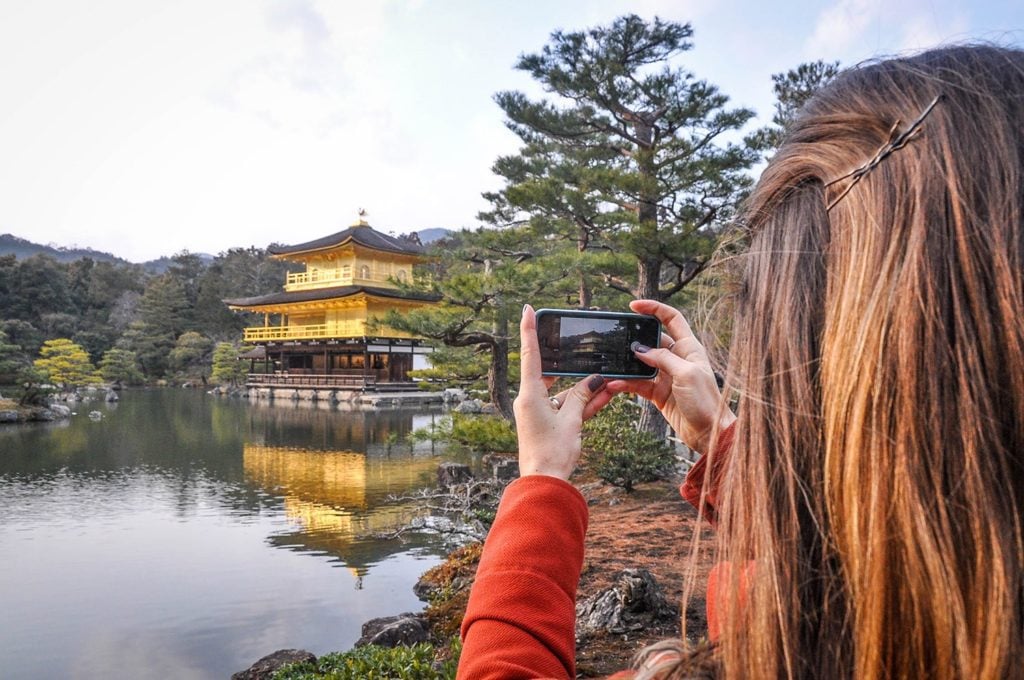
If you have been dreaming of traveling to Japan and want to get serious about planning your vacation, this Japan travel planning guide is packed with all the tips and information that you’ll need to know before your trip to the land of the rising sun.
We’ve traveled to Japan 3 times (and counting!) and have picked up plenty of insider tips. From which foods to try, to how much money to budget, to what travel gear to pack, to the best things to do in Japan .
In this guide, we’re showing you exactly how to plan a trip to Japan by covering everything. And I mean everything!
We’re even answering your embarrassing questions like, “ What are the toilets like in Japan? ”
We’ll also share exactly how much it costs to travel to Japan, plus we’re throwing in some money-saving budget tips! This is the ultimate resource with everything you need to know to get started planning a trip to Japan.

Japan Travel Planning Guide
Wondering how to plan a trip to Japan? You’ve come to the right place!
Important info about Japan
- How long should you spend in Japan
- Best time to visit Japan
Booking timeline: Know what to book when
- Top places to visit in Japan
- Top things to do and see in Japan
- Budget for Japan
Transportation in Japan
- Practical information for visiting
Food in Japan
- Japan trip ideas based on interests
Our experience in Japan
- What to pack for Japan
- Things to buy in Japan
- Japan travel resources

If you’re planning a trip to Japan, we have the ultimate resource for you!
This FREE PDF download includes everything you’re going to want to pack for your Japan trip, including what NOT to bring, plus tons of insider tips!
Sign up for our ultimate Japan packing list now and get a copy sent straight to your inbox.
Why should Japan be on your travel bucket list?
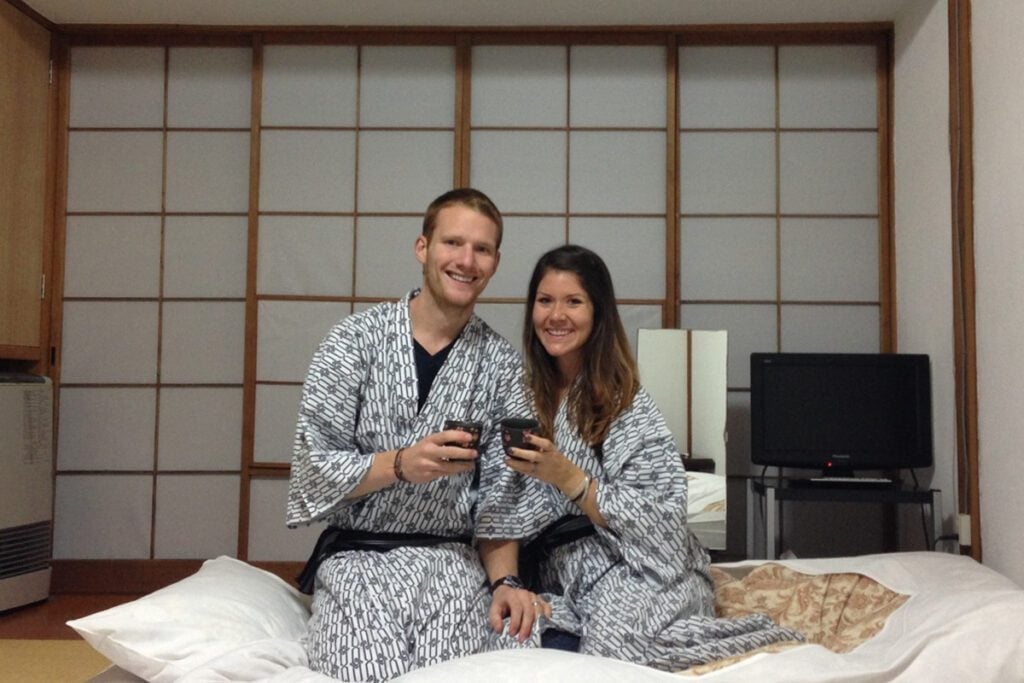
Japan is a country that we wholeheartedly believe has something for every type of traveler. Yes, even you . Whether you’re into history or pop culture, cities or nature, wild nightlife or absolute zen, you’ll find it all in Japan.
While Kyoto, Tokyo, and Osaka make it onto most first timer’s itineraries, you’ll quickly see that there is so much more to this country beyond the main attractions.
Once you travel here, it becomes kind of addicting — you’ll see! — because you’ll realize just how much this country has to offer.
- Incredible foodie experiences
- Epic (and off the beaten path) hikes
- Unique hotel stays you can’t find anywhere else in the world
- Temples and shrines that are shrouded in history
- Beautiful cultural experiences, like tea ceremonies and geisha performances
- Rural villages that few tourists see
- Some of the world’s biggest and safest cities
- Impeccable Japanese zen gardens
I could truly go on and on and on…
We have personally traveled to Japan 3 times and will certainly be back many, many more times.
Read next: We’ve rounded up all the things Japan is most famous for in a guide that’s also packed with practical travel tips. Plus, we’re sharing a few things we personally think Japan should be famous for, but most foreign tourists are surprised to know.
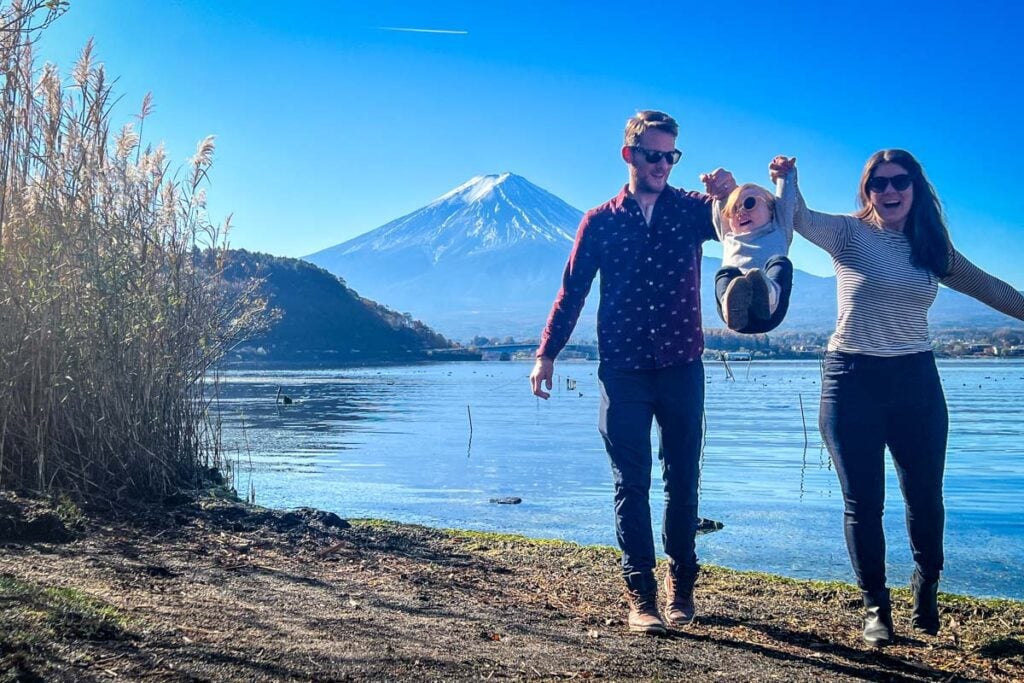
Here is a general overview of some of the high level important info and things to know before traveling in Japan. We’ll go into more detail about specifics in the rest of this article.
- Location: Island nation in Asia, located in the North Pacific ( view on Google Maps )
- Capital city: Tokyo
- Language: Japanese
- Currency: Yen (JP¥ / ¥)
- Japan uses the same plugs as in the U.S. but they have a different voltage (100 vs. 120 in the U.S.)
Visa requirements
There are 66 countries in total whose citizens do not require a visa to enter Japan, but the time you can stay depends on which country you’re from.
- Citizens from many countries (including the U.S.A., the U.K., Canada, and Australia) get a visa exemption (aka FREE) 90-day tourist visa, provided they will not be working in Japan.
- Other countries get a temporary tourist visa for a period of 15 days or less.
To find out the specifics for your country, check out the Japan National Tourism Organization , which explains the requirements for each country.
Language in Japan & useful phrases
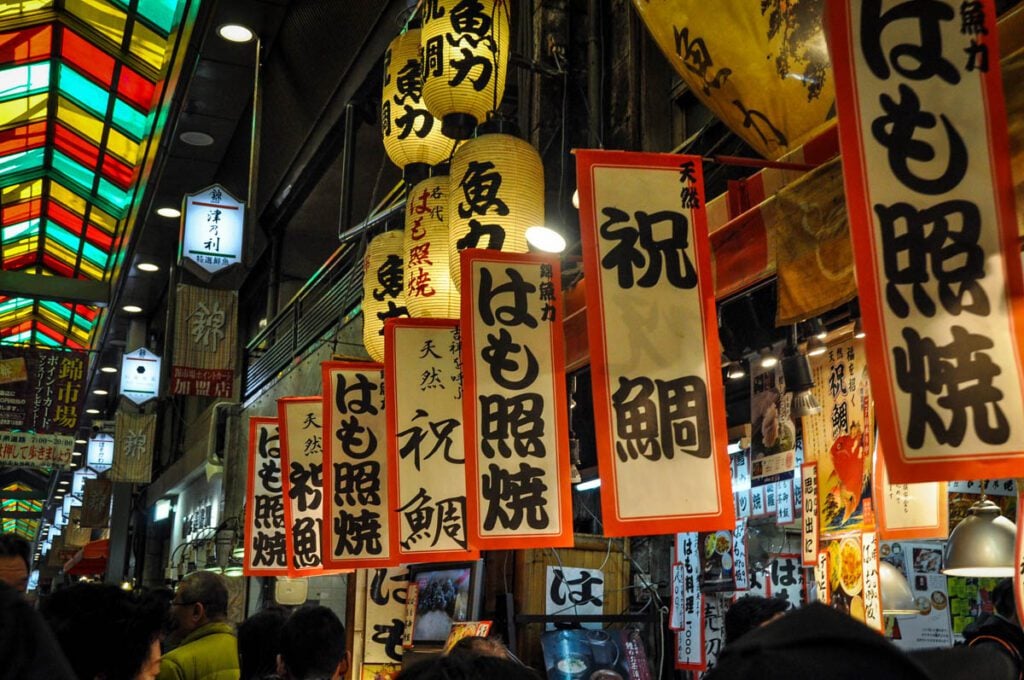
The language in Japan is, quite obviously, Japanese. But many people in big cities, like Tokyo, Kyoto and Osaka also speak English. Signs are written in Japanese characters, and in the cities most have their Roman counterparts.
When traveling, we always try to learn a couple important phrases. It shows locals you are trying to learn about their country and it can be fun too!
These phrases are ones we have found to be the most useful in any location we visit:
- Hello: Kon’nichiwa
- Thank you: Arigato
- Thank you very much: Domo Arigato
- Beer, please: Biru kudasai
- Cheers!: Kanpai
- Bathroom: Basurumu
- How much?: Ikura
- Delicious: Oishi
- Beautiful: Kireina
Interested in learning more? We’ve got a list of Japanese words and phrases that will be useful to know for traveling in Japan.
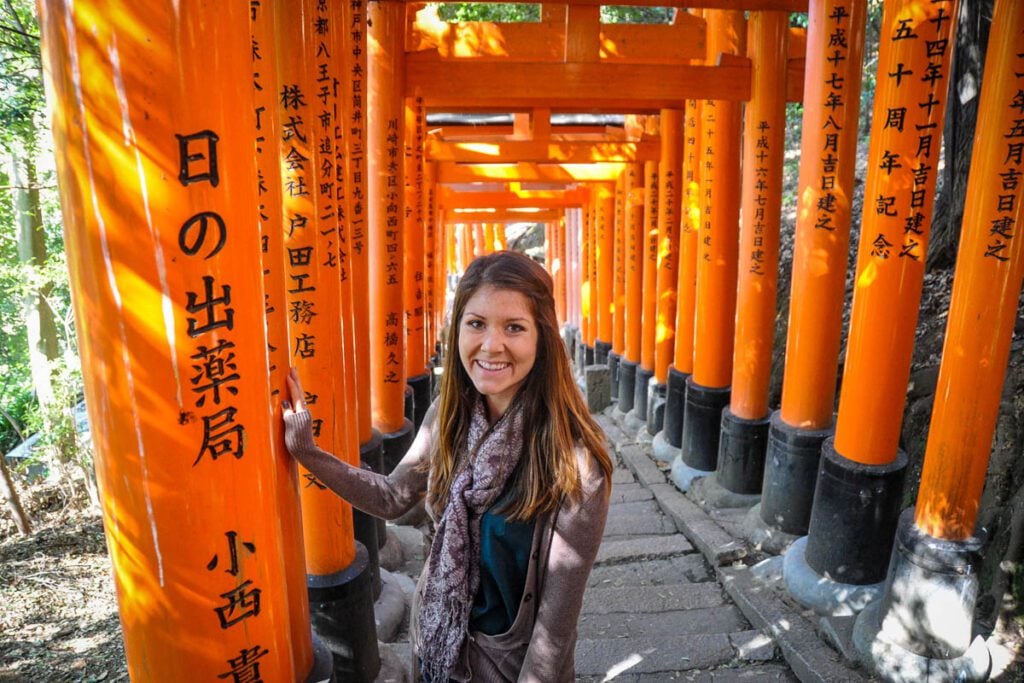
Helpful Japanese Words & Phrases to Know for Traveling in Japan
We’ve rounded up some practical Japanese words and phrases (that you can actually use!).
Manners and customs in Japan
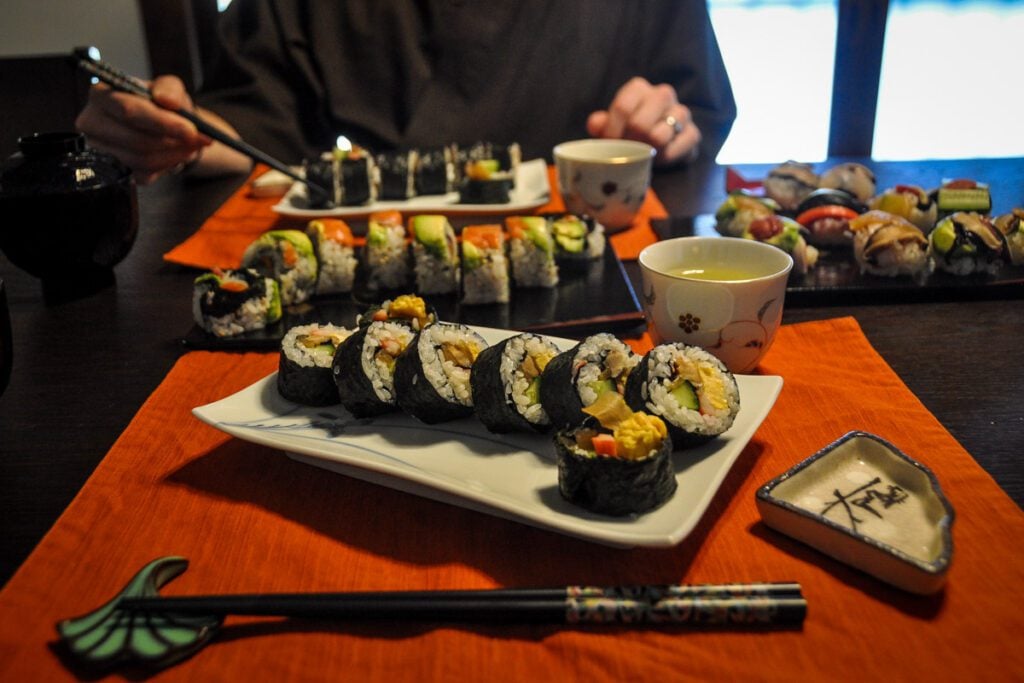
When traveling in a country other than your own, it is always a good idea to do a little research on what is polite so that you don’t accidentally offend people like this.
Here are couple manners to keep in mind when traveling to Japan:
- Eating while you walk is considered sloppy. Instead, find a place to sit and enjoy your snack.
- Pointing is considered rude. Instead, use an open hand to make gestures.
- Blowing your nose in public can be considered rude. Japanese people often go into the bathroom to blow a stuffy nose.
- On a crowded subway or train, it is polite to take off your backpack and hold it in your hands.
- Slurping noodles not only cools them down as you eat, but it indicates that the meal is delicious. So slurp away, it’s the polite thing to do!
- Taking off your shoes is common courtesy before entering many places. If the floor is raised at the doorway, it is an indicator that you should remove your shoes.
If you want a full run-down, check out our article on Japanese etiquette!
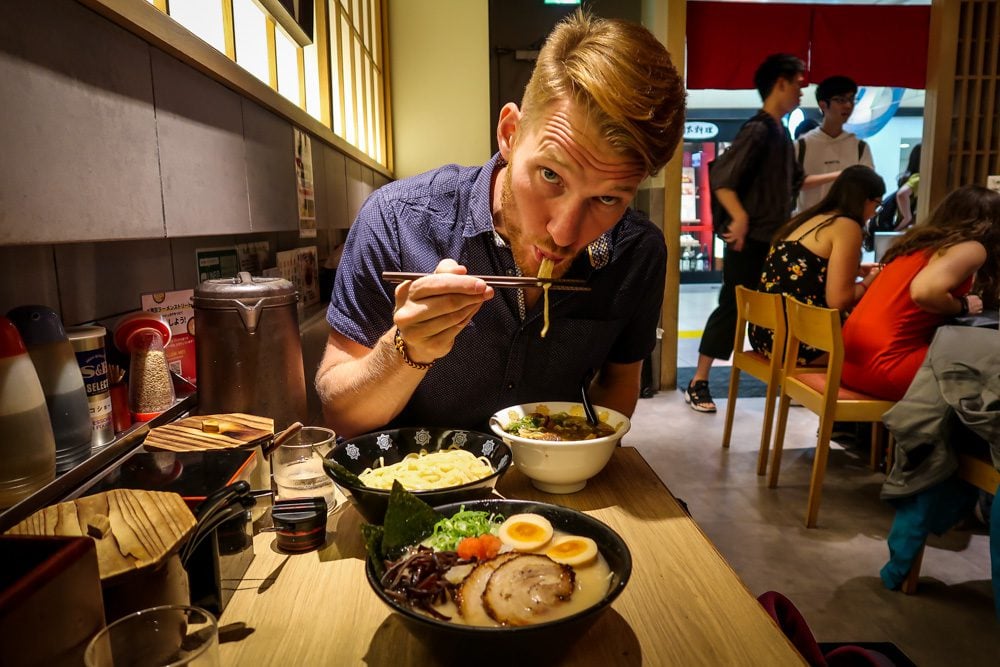
Japanese Etiquette: Dos and Don’ts When Traveling in Japan
Don’t get caught doing something embarrassing in Japan! We’ve compiled some important Japanese etiquette and manners to keep in mind while eating, riding trains and other common activities.
Tipping culture in Japan
Should I tip at restaurants in Japan? This is a question we always ask ourselves once we reach a new country, and it is never fun being caught off guard, unsure of what to do.
In Japan, tips are not expected, and can even be considered rude. And even if the server is not offended, they will likely be confused.
So in other words, NO , you should not tip in Japan.
Religion in Japan
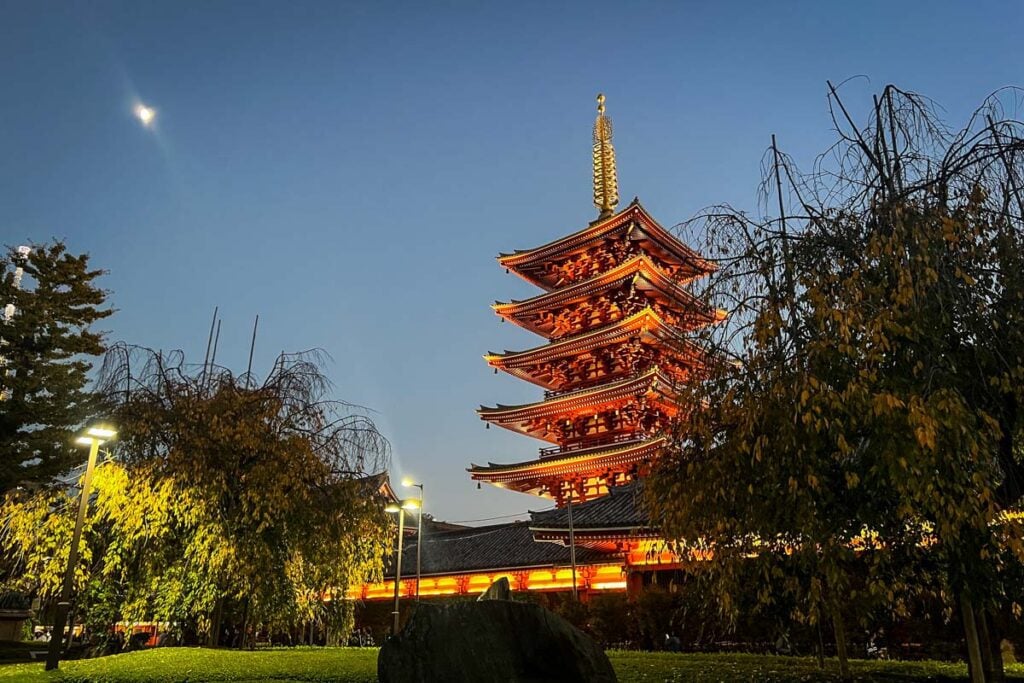
Buddhism and Shinto are the main religions in Japan, though they don’t play a huge role in the lives of many Japanese people today.
All throughout the country, you can visit temples and shrines to get a better understanding of the religions and culture. You can even do a temple stay in order to really delve in and learn about Buddhism.
Read this before visiting a temple or shrine in Japan.
Fun facts about Japan
These facts will be good conversation starters with other travelers or even locals. So break that ice and let them in on some fun facts about Japan!
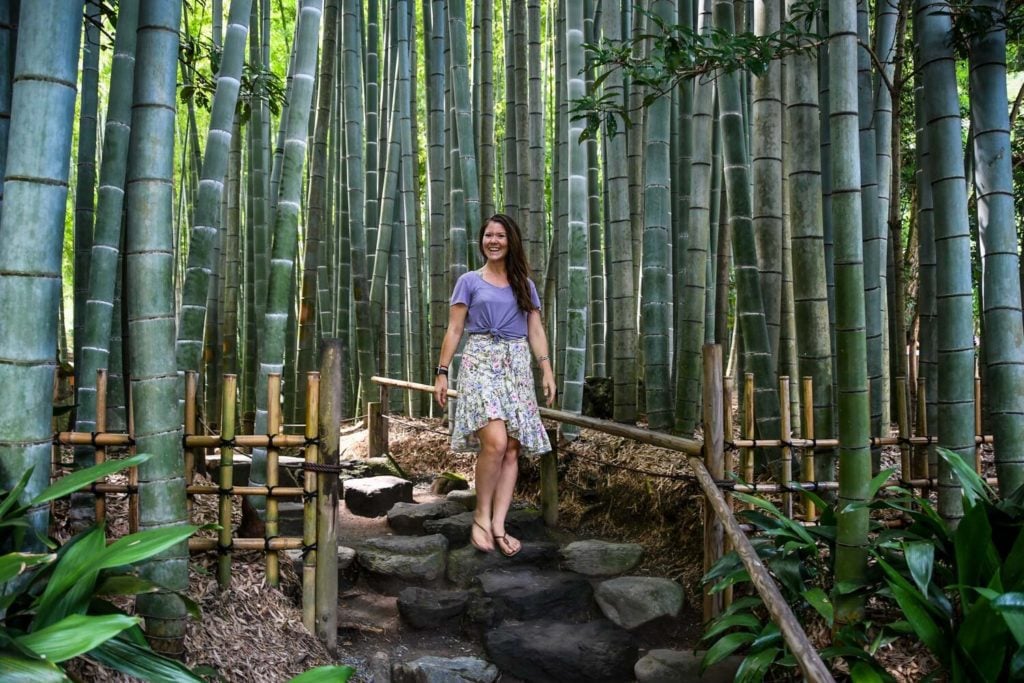
Interesting Facts About Japan (that may surprise you!)
Japan is an exciting country packed with things to do and places to see. In this article, we’re sharing all sorts of interesting facts about Japan. Plus advice and tips that’ll help you appreciate your time there even more!
How many days do you need in Japan?
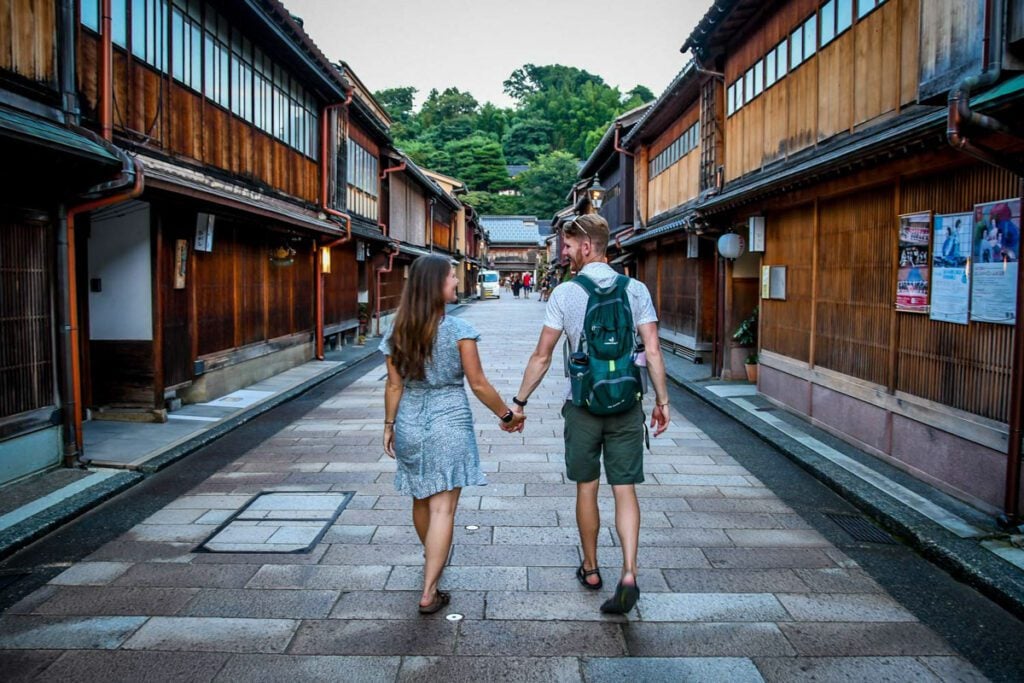
There’s so much to see and do in Japan that it can be overwhelming trying to decide how long your trip should be. Ideally, 2-3 weeks will give you enough time to see iconic and lesser-known sights as well as recover from a long travel day and potentially a big time difference.
But the ideal duration for your trip depends on several factors, including destinations you want to visit and your travel style. Our guide to how many days to spend in Japan will help you figure out how much time you need based on what you want to do.
Best times of year to visit Japan
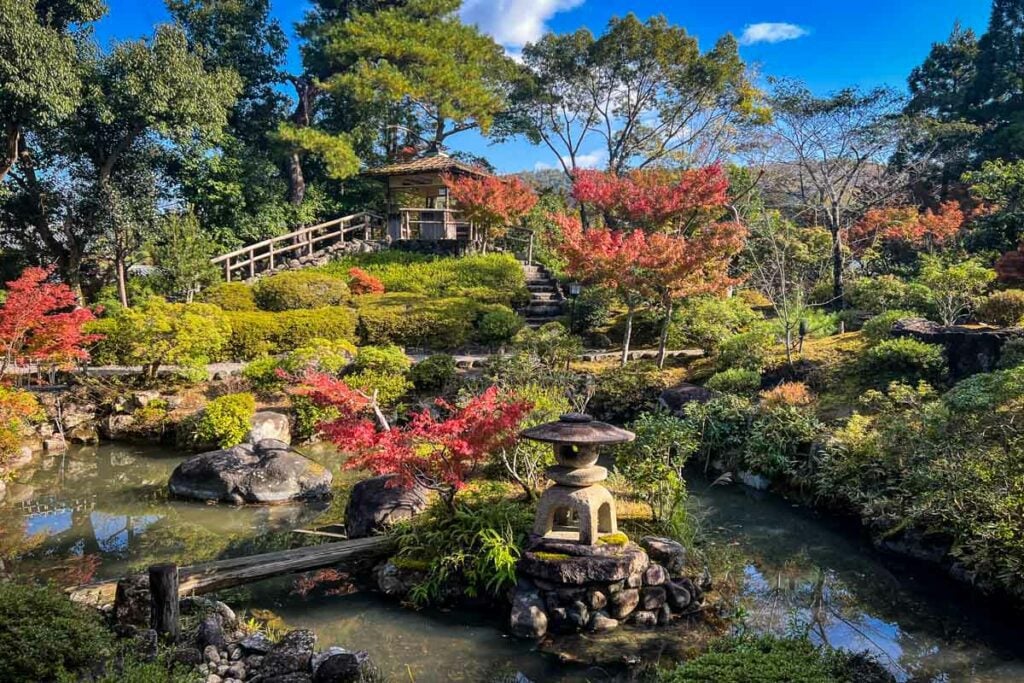
If you’re considering a trip to Japan, you’re probably wondering what time of year is best to visit.
The wonderful thing is every season is a great time to visit Japan , and you will have a completely unique experience.
We’ve laid out what to expect in each season, as well as the pros and cons of visiting during these times in our article: Best Time to Visit Japan: When to Go & When to Avoid! .
Here’s a quick breakdown of the seasons in Japan and why you might want to visit during each.
Summer in Japan
Summer in Japan is the time for festivals and celebrations. The summer spans from June to August, with August being the busiest travel month because school is out and many Japanese people travel over the Obon holiday (August 13-15).
Be prepared for ways to beat the humidity because it can get pretty sticky. Also it’s rainy season and the start of typhoon season, so don’t forget your rain jacket and umbrella!
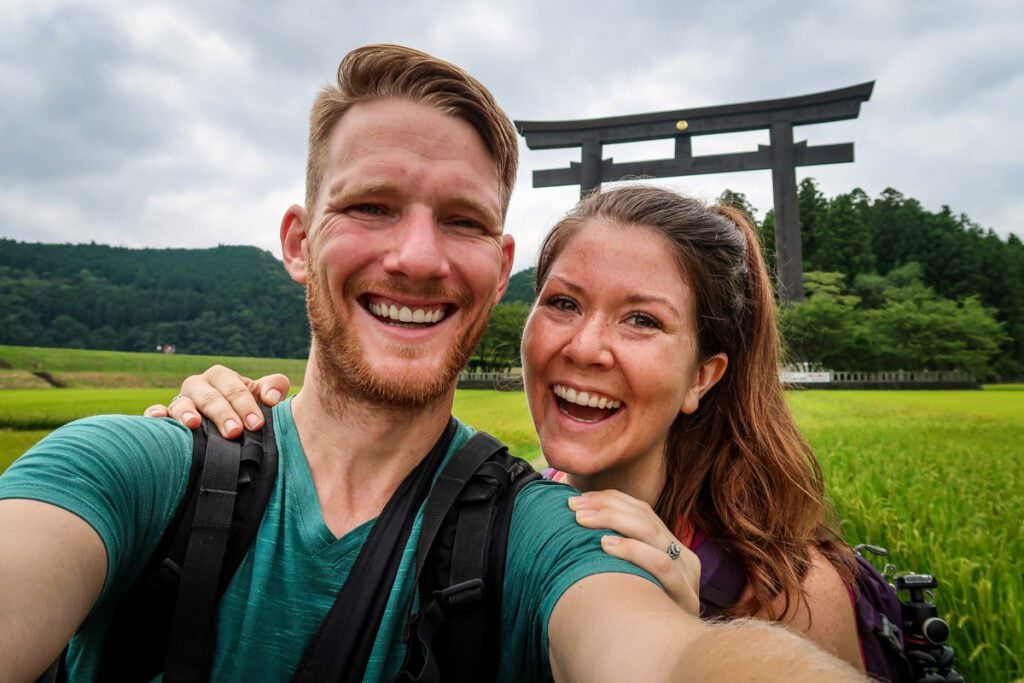
Summer in Japan: Ultimate Seasonal Guide
Summertime in Japan is a great time to hit the beach or cool off in the mountains. We’re sharing the best places to visit and things to do during summer in Japan, as well as lots of insider tips for planning your trip!
Autumn in Japan
With typhoon season peaking at the beginning of September, the start of fall in Japan is typically rainy depending on where you are. However, the weather starts to clear up in October and by November the leaves are changing.
We visited Japan in November 2023 and put together this guide to autumn in Japan that’s full of useful info.
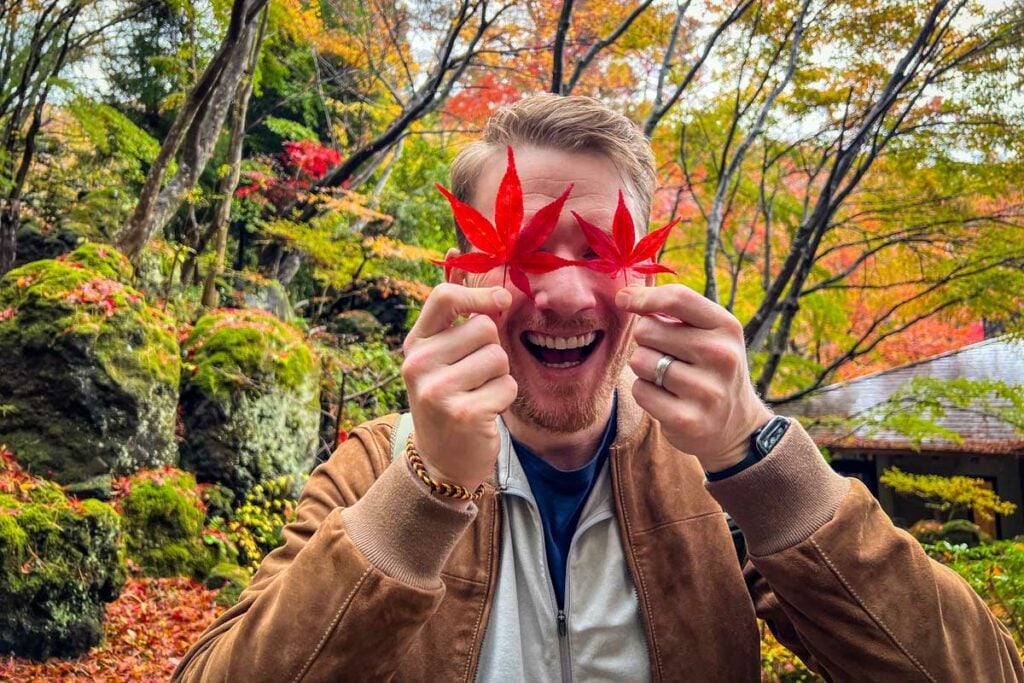
Autumn in Japan: Where & When to see Fall Foliage
With spectacular foliage and nice weather, we think fall is one of the best times to visit Japan. We’re sharing the best places to experience autumn in Japan as well as lots of insider tips for planning your trip!
Winter in Japan
During the winter months, major cities like Tokyo, Osaka and Kyoto tend to enjoy mild temperatures, but you can find snow and colder temps in the mountains and on Hokkaido (the northernmost island in Japan).
While winter may not be the first season you think of traveling, there’s actually a ton to do, and we think it is a great time to visit Japan .
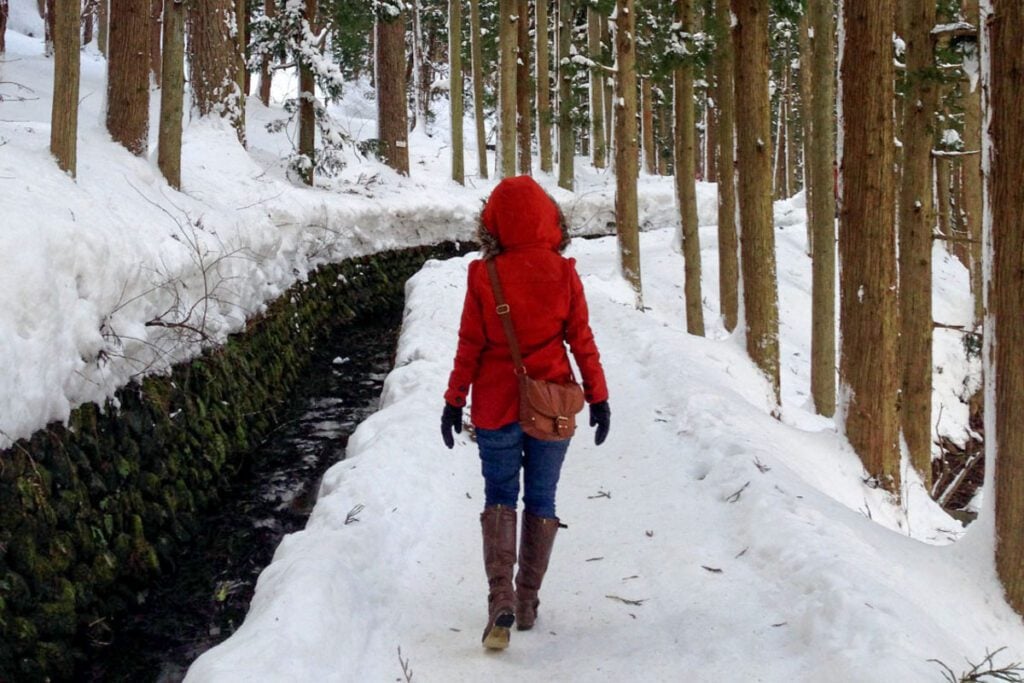
Winter in Japan: Things to Do + Why It’s a Great Time to Visit
There is something truly special about winter in Japan! We think you’ll be surprised by all the exciting things to do in Japan in winter. Plus, we’ll let you in on average winter temperatures around the country, as well as what to pack for the winter months.
Spring in Japan
With stunning sakura (cherry blossoms) popping up all around the country and temperatures warming, it should come as no surprise that spring is a popular time to visit Japan. A very popular time, indeed. If you travel to Japan in the spring , you’ll be rewarded with comfortable temperatures, beautiful blossoms, and lots of crowds.
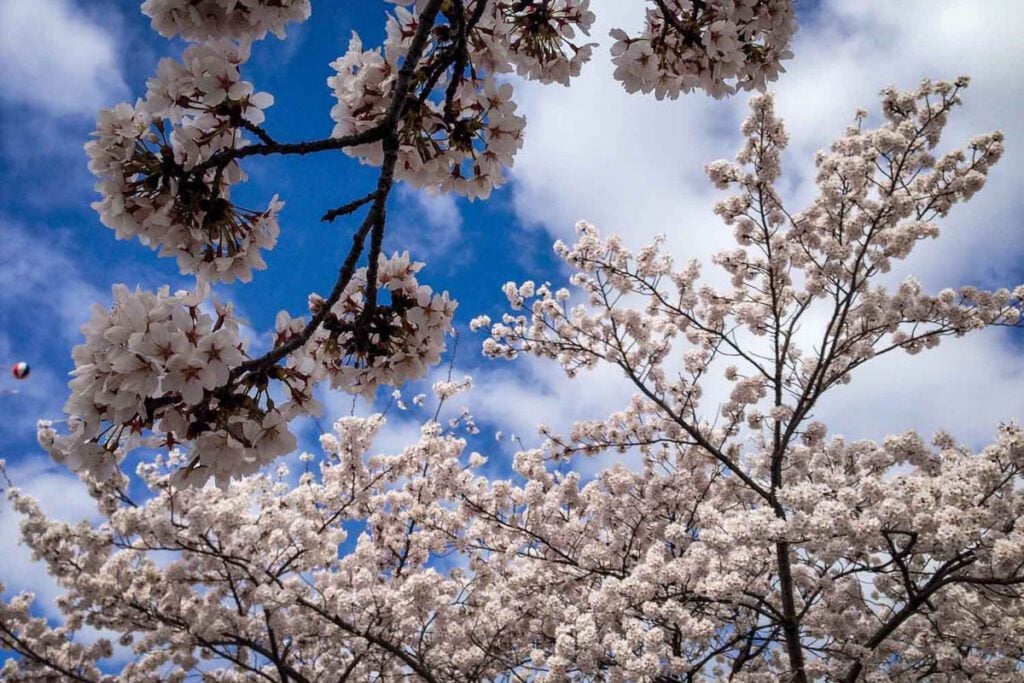
Spring in Japan: When & Where to See Cherry Blossoms
Witnessing the cherry blossoms in Japan is a once-in-a-lifetime travel experience. We’re sharing the best places to experience spring in Japan as well as lots of insider tips for planning your trip!
Before you book your Japan trip in the spring, know this…
Spring is considered by many as a great time to visit Japan for its comfortable temperatures, cherry blossoms and little chance of rain.
One thing you should be aware of is the so-called “Golden Week” which happens in the springtime and is made up of 4 national holidays which fall into a 7-day span. During this week many Japanese people will also be traveling around the country and accommodation and tours are often booked far in advance.
Dates of Golden Week in Japan:
- 2024: April 29 – May 5
- 2025: April 29 – May 5
- 2026: April 29 – May 5
It’s not every year the holidays fall on exact same dates, but for the next 3 years, they just so happen to. This site has more information about Golden Week in Japan .
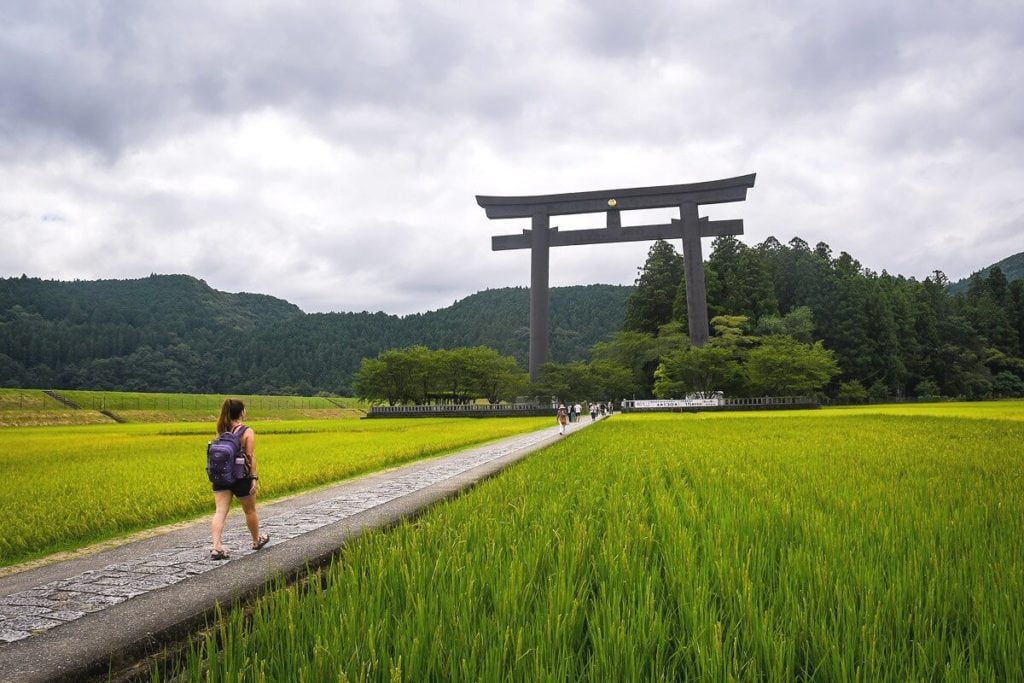
Best Time to Visit Japan: When to Go & When to Avoid!
Choosing the best time of year to visit Japan can be downright overwhelming. Each of Japan’s 4 distinct seasons has its draws and drawbacks. We’re going to break down exactly what to expect during each season so you can choose the best time to visit Japan based on your travel style and interests.
Traveling in Japan is a little different than many other places in the world.
By nature, we tend to be somewhat last-minute travelers, but not when planning a trip to Japan. If possible, we recommend planning your trip to Japan well in advance.
Now, this isn’t to say you can’t plan a trip to Japan at the last minute, but your options for great accommodation (especially in popular areas) will be limited. Plus, you may miss out on some of the most popular attractions because many require advanced booking and tickets go quickly.
We’ve laid out our recommended timeline for planning a trip to Japan so you can ensure you’re able to secure some incredible accommodation and do all the things on your bucket list.
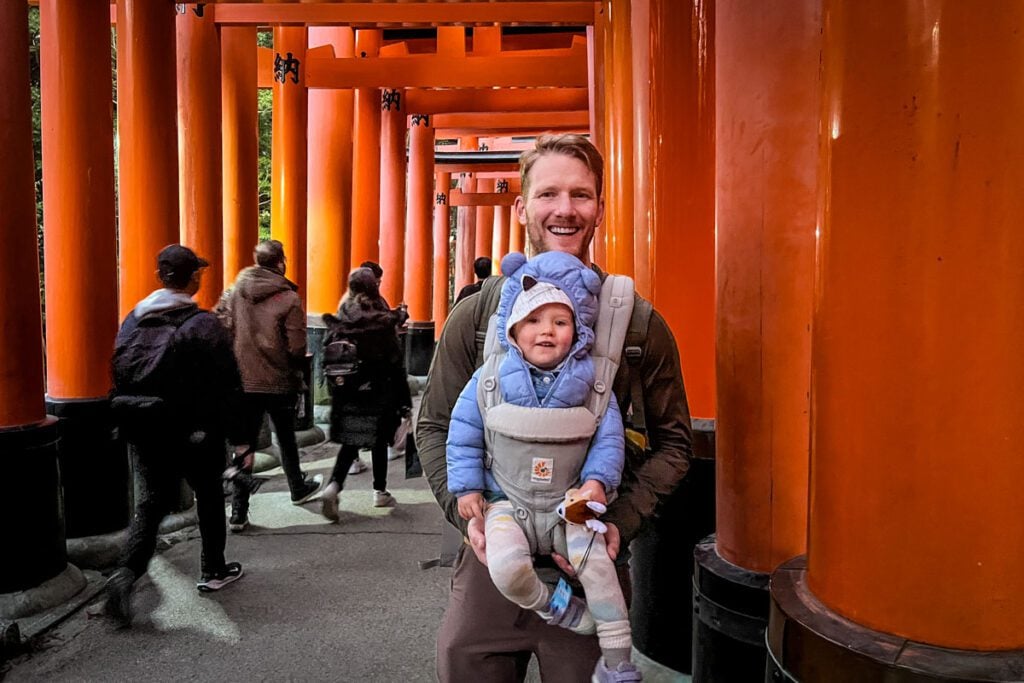
This timeline is a suggestion, but you can certainly adjust dates a bit. Hopefully this gives you a better idea of how far in advance to plan your trip to Japan.
1 year before your trip
- Start researching and draw up your dream itinerary
- Make a note of how far in advance the ryokans you like open up reservations
- Flag any attractions that are “must dos” for you
- Check out our Japan budget article to get started
- Here are our favorite tips for saving money for travel
- Insider Tip: Sign up for a mistake fare newsletter and set Tokyo as an “alert city” so you can get notified of any really good deals departing from your home airport.
The research phase should be fun and you don’t want to feel rushed. We recommend recording all the hotels and attractions you want to prioritize in a Google Doc so you don’t lose any of your research.
Coming up with a budget will help you determine which accommodations you can realistically book and it will help you start saving for this trip.
Want the perfect itinerary planned for you?
If you don’t have a ton of time to spend planning your Japan itinerary (or you just don’t find travel planning fun!), we’re working on something you might be interested in…
We are in the process of creating done-for-you Japan itineraries that are packed full of all sorts of tips we’ve gathered from 3 trips to Japan as well as literally hundreds of hours of research (no exaggeration).
We will have both off-the-beaten path routes as well as a classic itinerary that hits the top attractions.
If you want to be the first to know when our Japan itineraries are on sale, get on the waitlist !
6 months before your trip
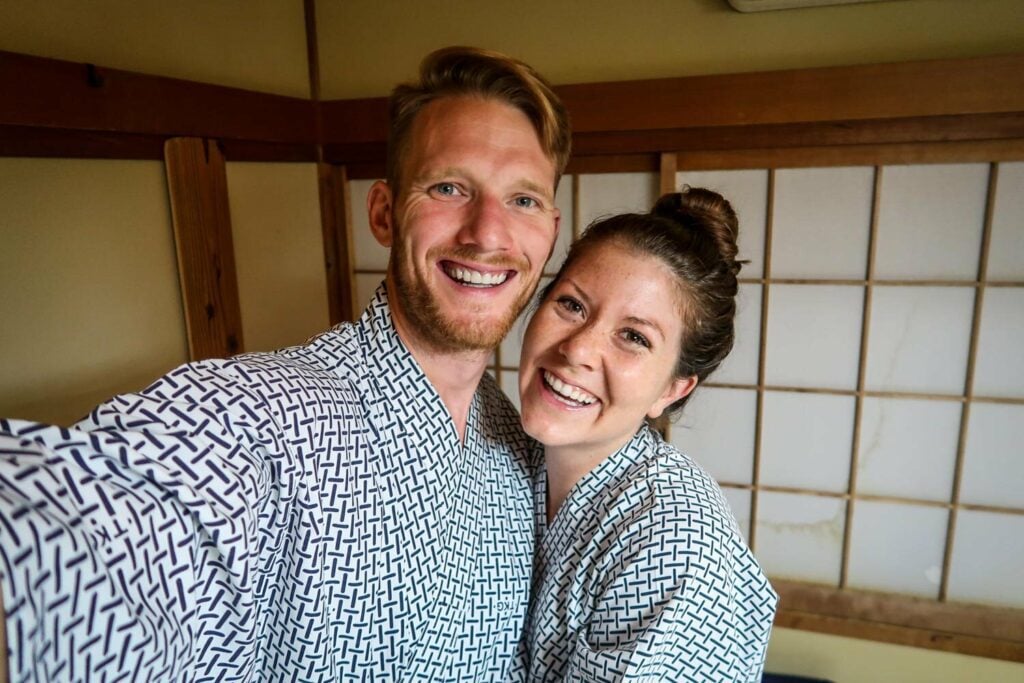
- Flights: If you are flying from afar, aim to book your flights around 6 months prior to your trip. We’d recommend keeping an eye on them for a couple of months (starting 10 months before your trip).
- Ryokans: Many ryokans only release booking dates 3-6 months ahead of time. Really great ryokans fully book up quickly after dates are released.
- Accommodation in small towns (like on the Nakasendo Trail)
- Hotels near any major attraction or popular area (at DisneySea, or near Mount Fuji)
- Special hotels that you really want to stay at (like the Park Hyatt in Tokyo , or a temple stay at Koyasan)
- Accommodations that fall over festival dates or popular tourist seasons, like Golden Week (which falls during Japan’s cherry blossom blooms )
It can feel a little overwhelming to make these big bookings all at once, but it will ensure you are able to stay where you’d like and secure good prices on flights.
Booking tips: When possible, we like to use Booking.com since many hotels offer free cancellation via this platform (often up until just days before your stay). Also, you often don’t have to pay at the moment of booking, which makes the commitment a little less scary. We typically like to compare the price on Booking.com to Agoda , as they sometimes differ. We also stayed at a couple of Airbnbs in Japan , which was a good option in the more rural areas.
2-3 months before your trip
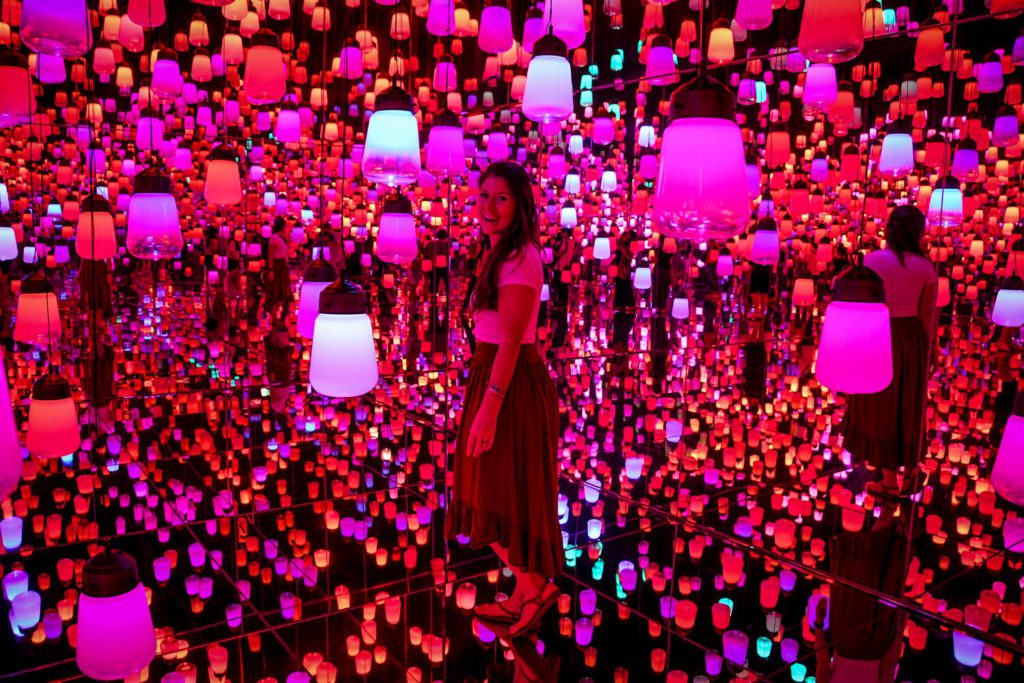
- All accommodation not yet booked: the sooner the better for the best locations and prices
- Japan Rail Pass : You can purchase this pass up to 3 months before the date you’ll use it . We personally got ours 2 months in advance so it wasn’t left until the last minute.
- FYI: we have lots of advice and info about renting a car in Japan
- Tickets go on sale 3 months in advance
- If you want best available times slots (we recommend the first one at 9-9:30 a.m. ), book at least 2 months ahead of time
- Compare availability on the teamLab website (tickets available further in advance) and on GetYourGuide
- Tickets go on sale roughly 5 months in advance. We recommend booking at least 2-3 months in advance for the best availability of time slots.
- Compare availability on the Warner Bros Studio website and on Klook
- This will mean you don’t have to wait in crazy long lines, and we’ve heard it’s very worthwhile at this notoriously crowded theme park. Purchase it here .
1 month before your trip
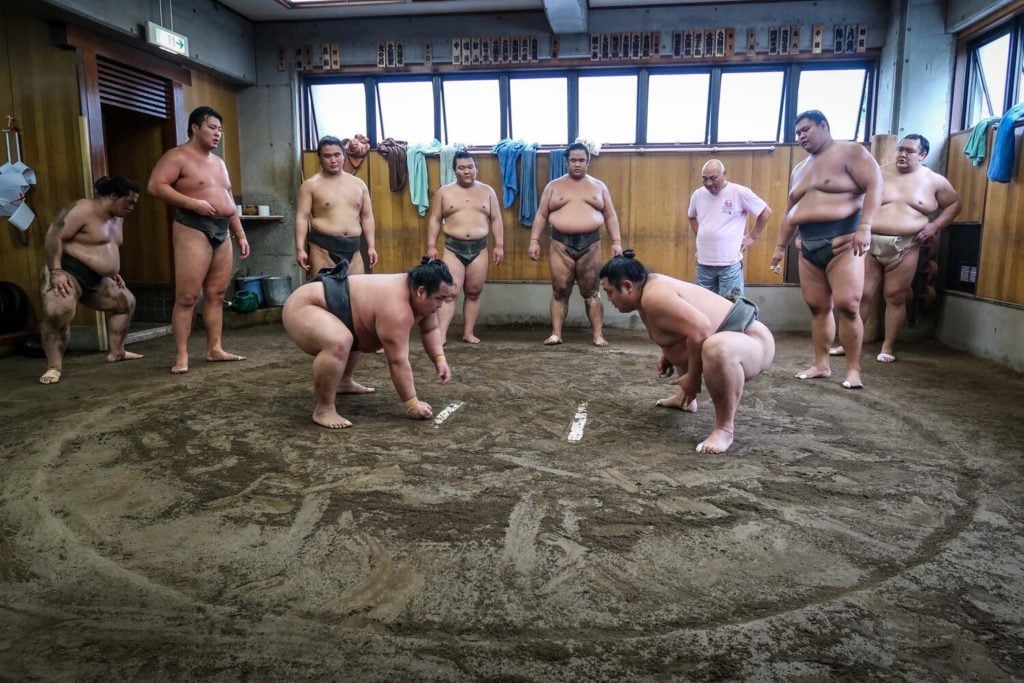
- Tickets go on sale on the 10th of each month for the following month
- We recommend setting an alarm to purchase tickets as they become available on the 10th of the month before your trip so you don’t miss out.
- You cannot purchase tickets onsite (you must have advance reservations)
- Tickets go on sale 1 month in advance
- The most popular time slot is right before sunset and those times go quickly
- Compare availability on the Shibuya Sky website and on Klook
- Popular theme restaurants like Ninja Restaurant (Tokyo) or the Pokémon Café (Tokyo & Osaka)
- Insider tip: For the restaurants on your “must” list, research and write down how far in advance reservations are available (some may even require booking further than 1 month in advance). Set alarms in your calendar so you can be sure to snag a spot right away. Popular places fill up very fast!
- Sumo stables
- Cooking class
- Tokyo dinner cruise
- Photoshoot in Tokyo
- Tokyo Go-Karting
- Tea ceremony
Download the PDF version of our Japan booking timeline so you can print it out at home and keep track of your Japan trip planning process! Enter your email and we’ll immediately send the booking timeline to your inbox (totally FREE).
Japan Booking Timeline
Enter your email below and we’ll immediately send our Japan booking timeline to your inbox (totally FREE).
We’ll also be sending you bonus tips on all things Japan: like how to travel cheaply, where to go and the best places to stay.
We value you, and NEVER spam. (We hate spam too.)
We’ll also be sending you bonus tips on all things Japan, like how to travel cheaply, where to go and the best places to stay.
Top places to visit on your Japan trip
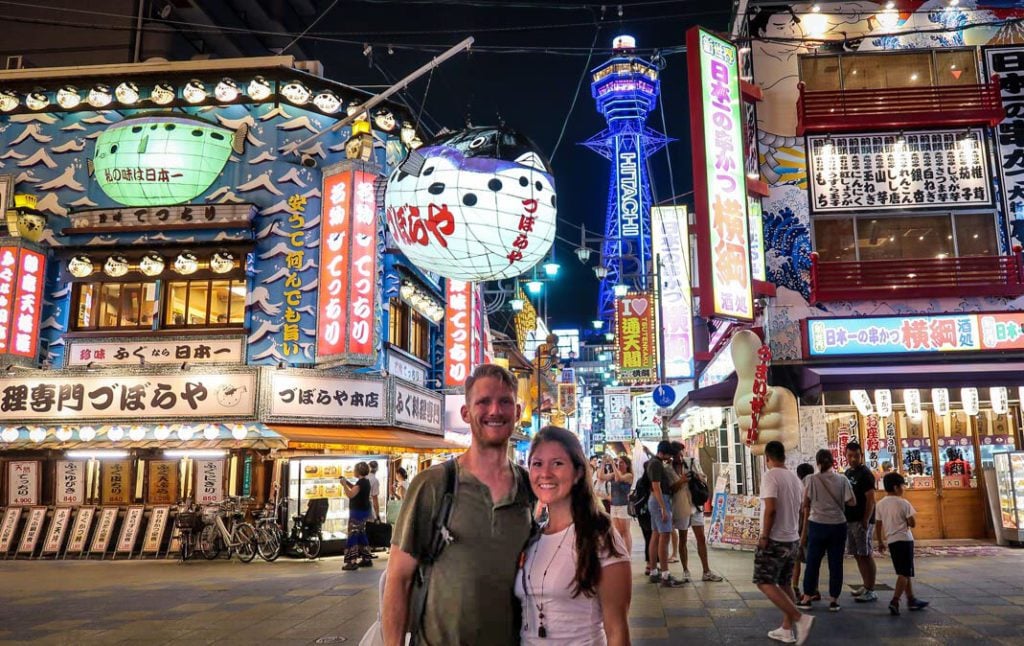
Japan is a huge country, and it would be an extensive list if we went through all the notable cities to visit. But if you are visiting Japan for the first time, these cities are a good place to start as they will give you a good taste of the country’s culture.
Another thing that’s important to keep in mind when planning a trip to Japan is the destinations’ proximity to one another and all of these suggestions are relatively easy to get to and from.
- Tokyo : This huge metropolis is likely where you’re flying in and out of, and it is one of the most interesting cities we’ve visited anywhere in the world. From quirky experiences, to amazing foods, Tokyo is definitely worth some time on your itinerary.
- Kyoto : Considered the “cultural capital of Japan”, Kyoto is packed with history, important temples, gorgeous architecture and a charming atmosphere. If you are traveling with your little ones, there are tons of things to do in Kyoto with kids .
- Osaka : Another major hub to fly in and out of Japan, Osaka is worth a visit . Known for lively nightlife and endless street food, there’s a lot more to discover beyond Osaka’s neon-lit facade.
- Hakone: At the footsteps of Mt. Fuji, Hakone is a peaceful retreat from the big cities of Japan and a chance to relax in an onsen and sleep in a ryokan.
- Hiroshima : This historical significance of this city draws tourism from all over the world, but you can enjoy the lighter side of this beautiful place too.
- The ‘Roof of Japan’ : The Tateyama Kurobe Alpine Route is a single day mountain traverse where you take 8 different modes of transportation over what’s known as the Roof of Japan .
Want more info? We have an entire article with a round up of the most beautiful places in Japan , including some top things to do and see.
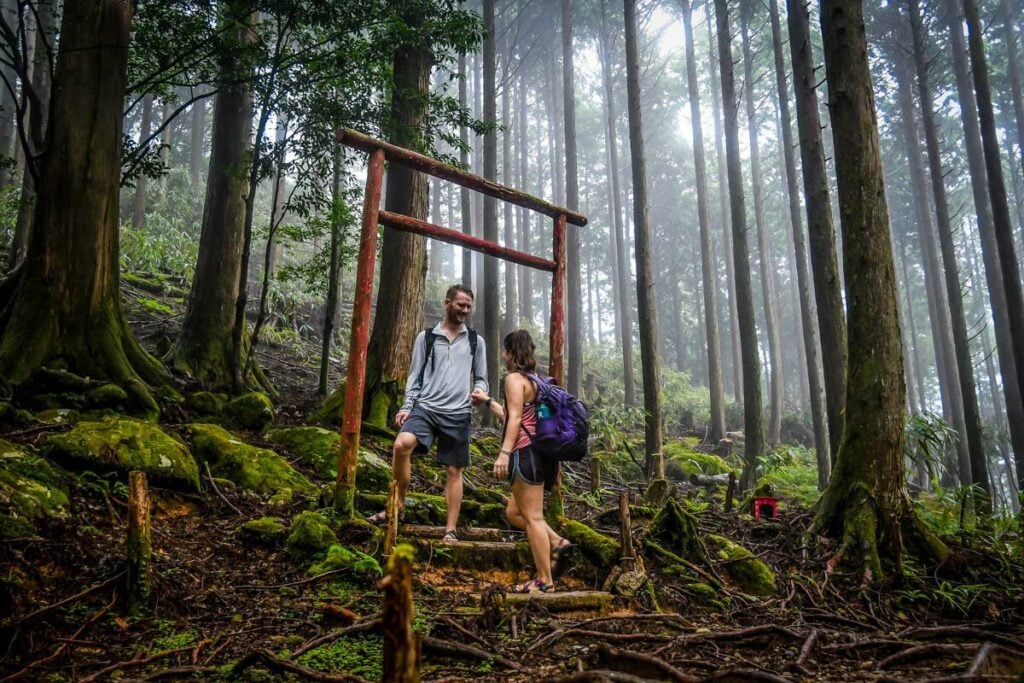
Most Beautiful Places in Japan You Need to See for Yourself
With storybook villages, forested mountain ranges and white sand beaches that rival the tropics, there are some incredibly diverse and beautiful places in Japan. This bucket list is full of places you’ve never heard of, and after reading it, we bet you’ll be ready to book a flight to Japan!
Top things to do in see in Japan
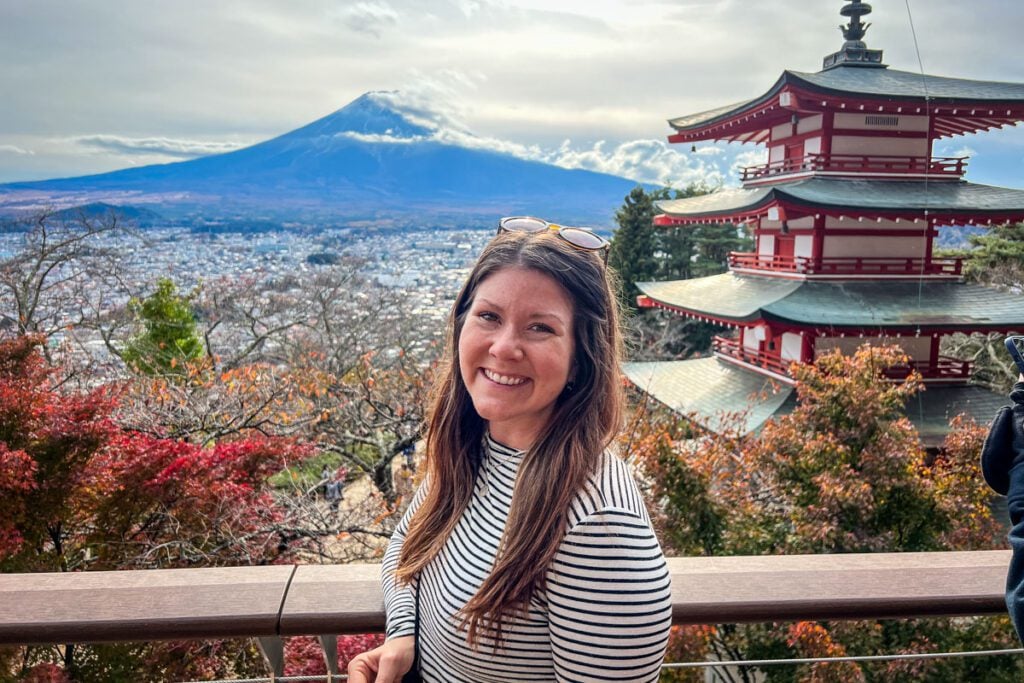
Just as with places to visit, there are seemingly endless sights to see in Japan. Here is a quick list of our top recommendations for your first visit to Japan.
- Mount Fuji : The most famous mountain in Japan, you can get a glimpse of this beauty when traveling in Hakone.
- Fushimi Inari Taisha Shrine : Known to tourists as the “Orange Gates”, there are thousands of majestic orange gates covering a maze of paths leading up to the shrine.
- Arashiyama: Located on the western edge of Kyoto, Arashiyama is an area that is filled with temples and shrines, but the main attraction is the Arashiyama Bamboo Grove.
- Temples in Japan: Of course temples will be on your list of things to see in Japan. The Golden Pavilion in Kyoto is stunning with the garden setting and reflection off the pond.
- Shibuya Intersection: Famously known as the “busiest intersection in the world” crossing the street here is quite an experience.
These places all make for great pictures! If you want to take better travel photos, we wrote up some easy and creative tips to improve your travel photography skills !
Psst! We have a list of must-see landmarks in Japan that’s sure to give you some inspiration for your itinerary!
Unique experiences to have on your Japan trip

One of the many reasons Japan is such a wonderful place to visit is there are so many unique experiences that can only be had in this country. Here are just a few of the things that are quintessentially “Japanese”.
Quintessential cultural experiences
- Soak in an Onsen: Strip down to your birthday suit and soak in a hot tub until you get pruney. Don’t worry, they are gender separated and some are even private. The best one we dipped in was in the Hakone region .
- Stay at a Ryokan: Experience a traditional Japanese-style inn and stay in a ryokan to enjoy Japanese hospitality and relaxation.
- Take a Japanese cooking class: Learn how to make proper sushi or traditional ramen to impress your friends at home. (Read why we LOVE taking cooking classes on our travels !) Or take a food tour, like this Kyoto food tour from Magical Trip.
- Sleep in a Temple: Usually taken as retreats to refresh your body and mind or deepen understanding of religion, temple stays are an unique experience you won’t forget.
- Go Geisha spotting: On the old street of Kyoto, Geisha scurry from one event to the next. Try to get a glimpse of them, or better yet try to get a picture.
- See the fish auction each morning: Show up around 3 a.m. (yep, that early) as the fishermen come into port and sell their fish at the Tsukiji Fish Market . Then find a shop and have the freshest sushi you’ll ever eat.
- Take a Sumo wrestling tour in Ryogoku and learn about Sumo culture.
Get personalized recommendations for where to save and splurge during your trip when you use ViaHero —a trip planning platform that will connect you with a local in Japan.

Quirky Japanese experiences
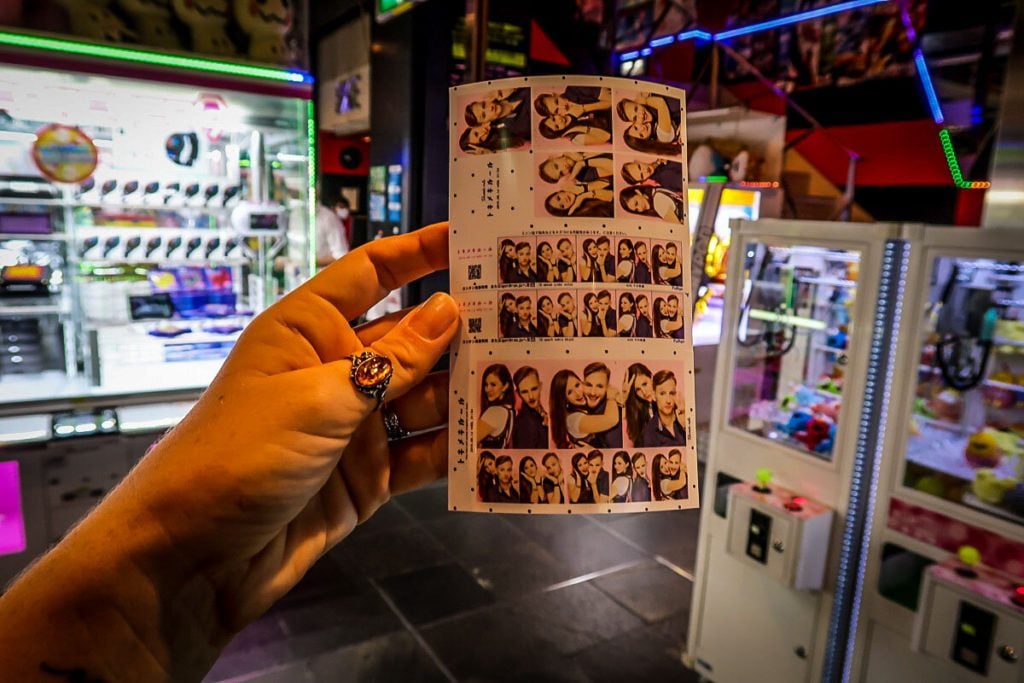
- Take your picture in a photo booth: Pop into one of these with your friends and take a few snaps. Then, edit your photos instantly, enhancing your eyes, adding blush, or slimming your cheeks. It takes the word selfie to a whole new level.
- Responsible Travel Tip: Be cautious about animal tourism. Domesticated animal cafes (like dog or cat cafes) seem to take care of their animals. But for non-domesticated animals cafes, like owl cafes, we would just be a little hesitant to visit.
- Theme restaurants: We went to the Robot Restaurant in Tokyo (unfortunately now closed) and it was one of the craziest dinners we ever attended! For more theme restaurants, check out our guide to the best things to do in Tokyo at night .
Unique experiences in nature
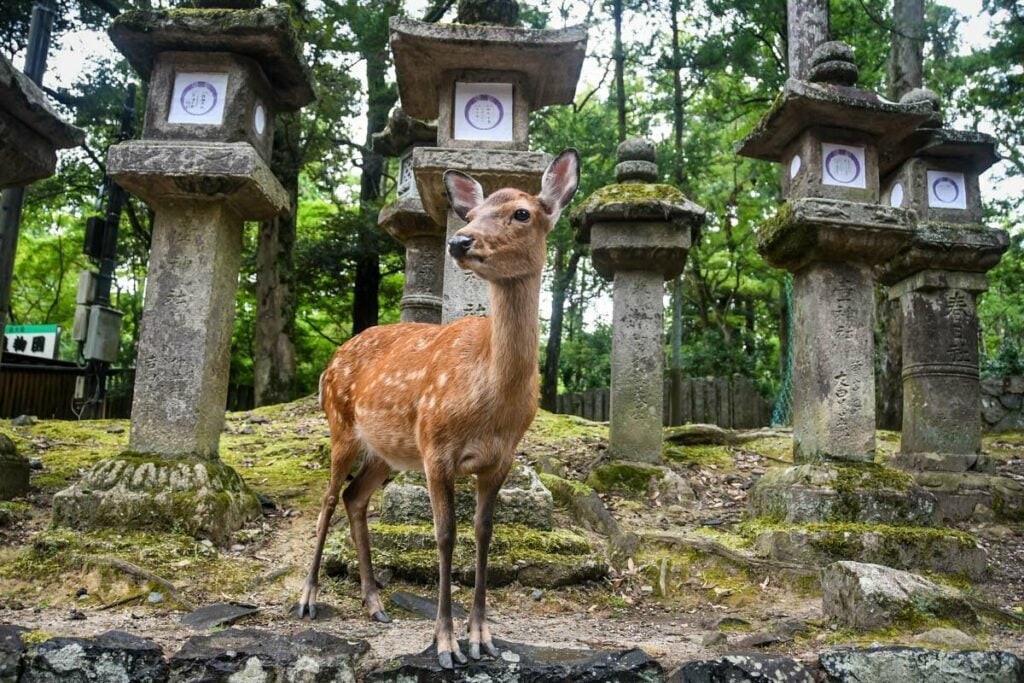
- See the Nara Deer: Just a little ways outside of Osaka in the city of Nara , there is a park (and part of the city) literally flooded with cute spotted deer. They’re used to being around humans, but make sure you read these tips before visiting the Nara deer.
- Jigokudani Snow Monkeys: A few miles away from Nagano, there is a park where the local macaques monkeys soak in a spring-fed hot tub and play around in the snow.
- Hike the Kumano Kodo Trail : If you’re feeling adventurous, this is quite literally, off the beaten path. The Kumano Kodo Trail is a historic pilgrimage through the mountainous Kii Peninsula that has been trekked for thousands of years.
Need more inspiration? We have an entire article with a round up of the best things to do in Japan , including all the info you need to make it happen during your visit!
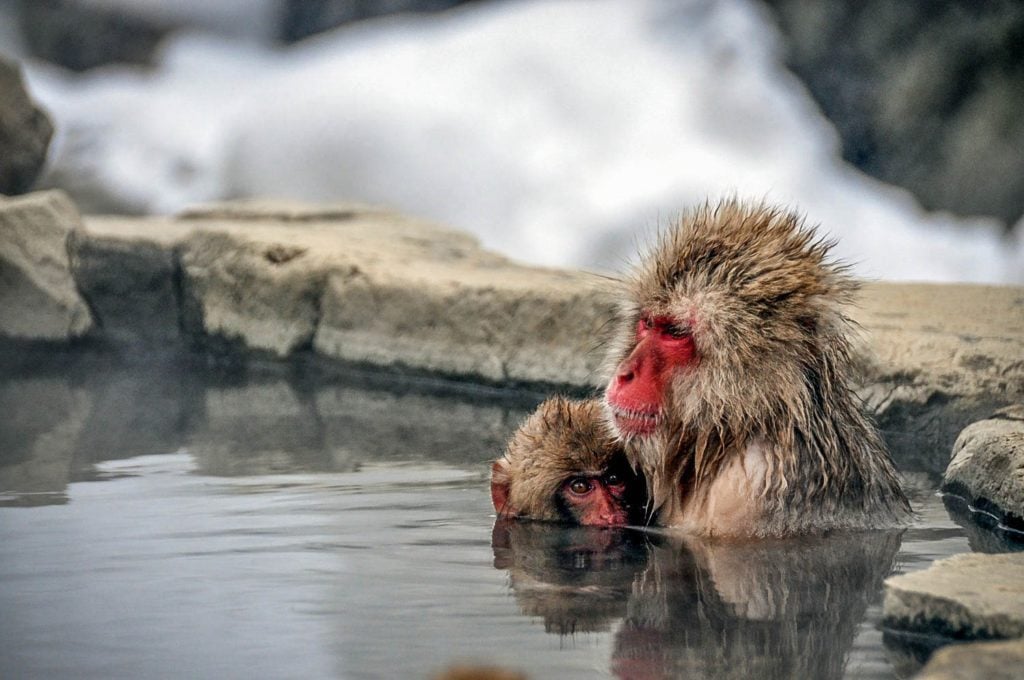
Crazy Fun Things to Do in Japan
If you’re looking for unique things to do on your trip to Japan, you’ve come to the right place! From super quirky, only-in-Japan experiences to must-see sights and the best food to try, we’ve rounded up the top things to do in Japan on your first visit.
Wanna take a tour?
We recommend taking a tour with the highly-rated tour company, Magical Trip . They specialize in small group tours led by local guides all over Japan, from Tokyo to Osaka.
Click through to browse all small group Japan tours they offer.
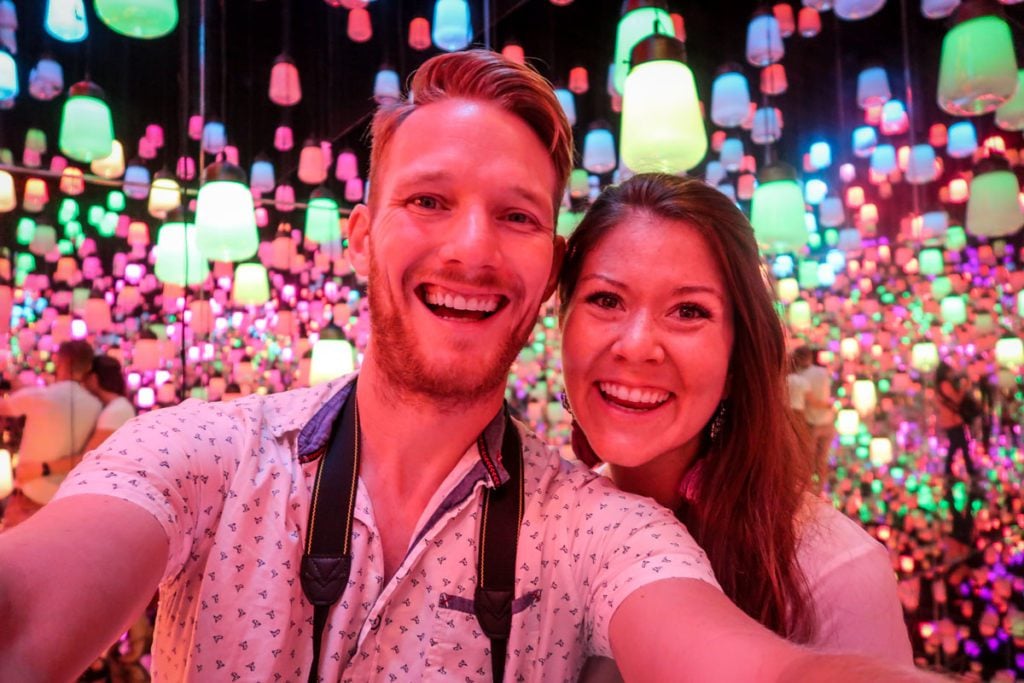
Best Things to Do in Tokyo
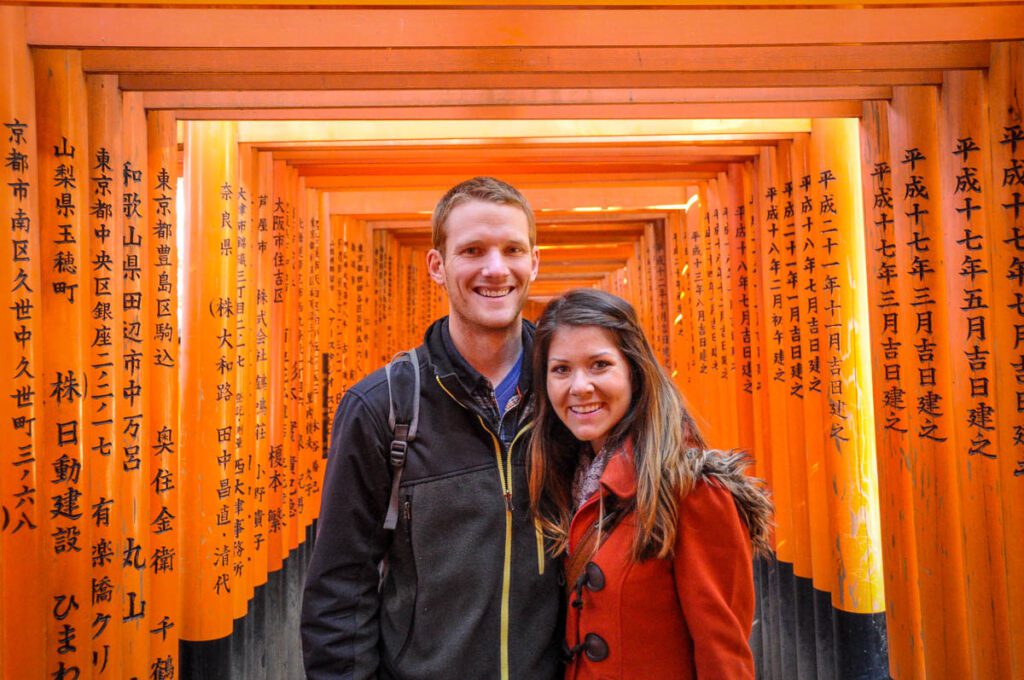
Best Things to Do in Kyoto
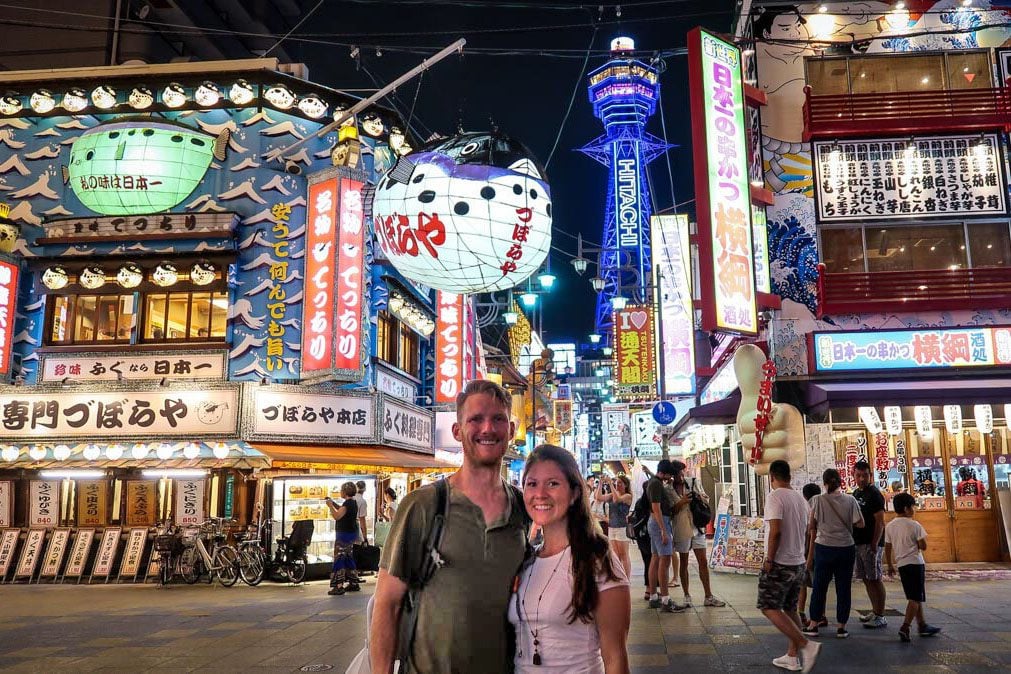
Best Things to Do in Osaka
Budgeting for Japan
I’ll be straight to the point: Japan is not cheap.
Contrary to many other destinations in Asia, like Thailand or the Philippines , Japan is not an ideal location for budget travelers. That said, it is unlike any country in the world and totally worth visiting.
Typical daily budget for Japan
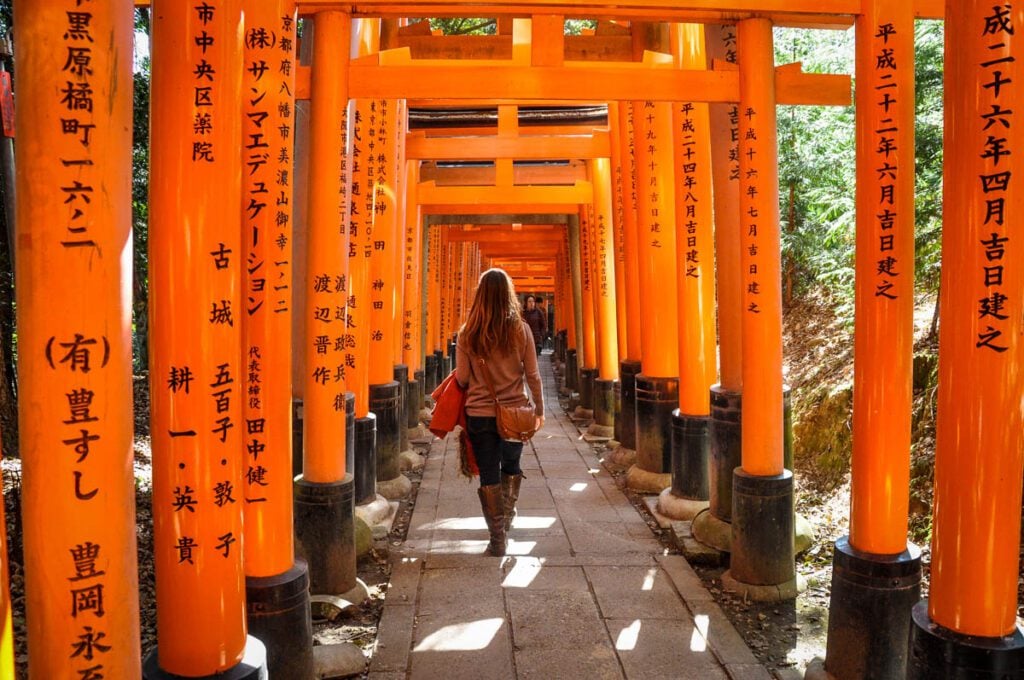
Below is an estimated breakdown of (about) how much money you should plan to budget for a trip to Japan based on your travel style.
*Note: These are estimations for one person and do not include flights.
- You’ll stay in hostel dorm beds, grab breakfast from one of the many 7-Eleven’s or Family Marts, and do as many free activities as possible.
- You’ll be staying in comfortable, though not fancy, hotels or Airbnbs . You’ll want to try lots of Japanese food—both budget meals and a couple nicer ones too. You will use public transportation to get around and you want to see as much as possible, but you’re willing to make some sacrifices to save money.
- Budget isn’t too much of a concern for you. This isn’t necessarily luxury travel, but you are willing to pay more money for convenience and comfort; and splurging on unique, once-in-a-lifetime experiences is not a problem for you.
Japan travel planning tip: This article breaks down the exact cost of a trip to Japan . Based on our own experiences traveling in Japan, we share the costs associated with each portion of our Japan trip — from transportation to food to accommodation to entertainment.
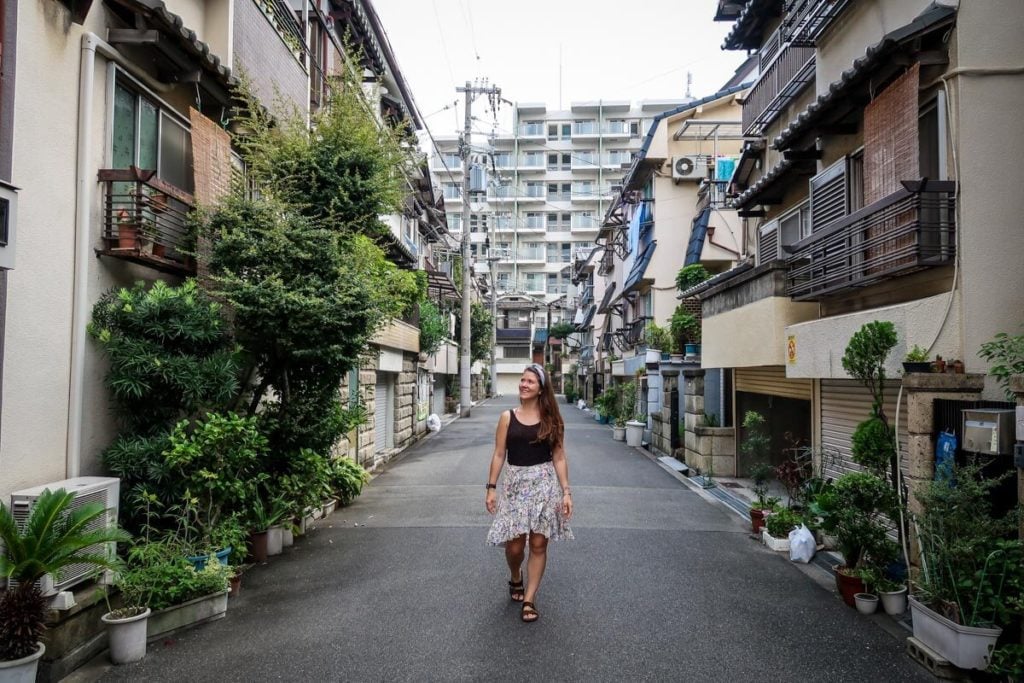
Japan Travel Cost: Exactly How Much is a Trip to Japan?
In this article, we’re breaking down the cost of a trip to Japan — from food and hotels to trains and entertainment. We get super detailed so you can work out your perfect Japan travel budget.
Psst! If you want to know how we afford to travel (& how you can too!) , we think you’ll love this article!
Are credit cards accepted in Japan?
Yes, but hold up…
Major credit cards will typically be accepted at big hotel chains, nice restaurants or shops in large cities, but you’ll want to have cash on hand to use in small restaurants, markets or in more rural towns.
There are still many places where credit cards are not accepted, so it is a good idea not to rely on plastic alone.
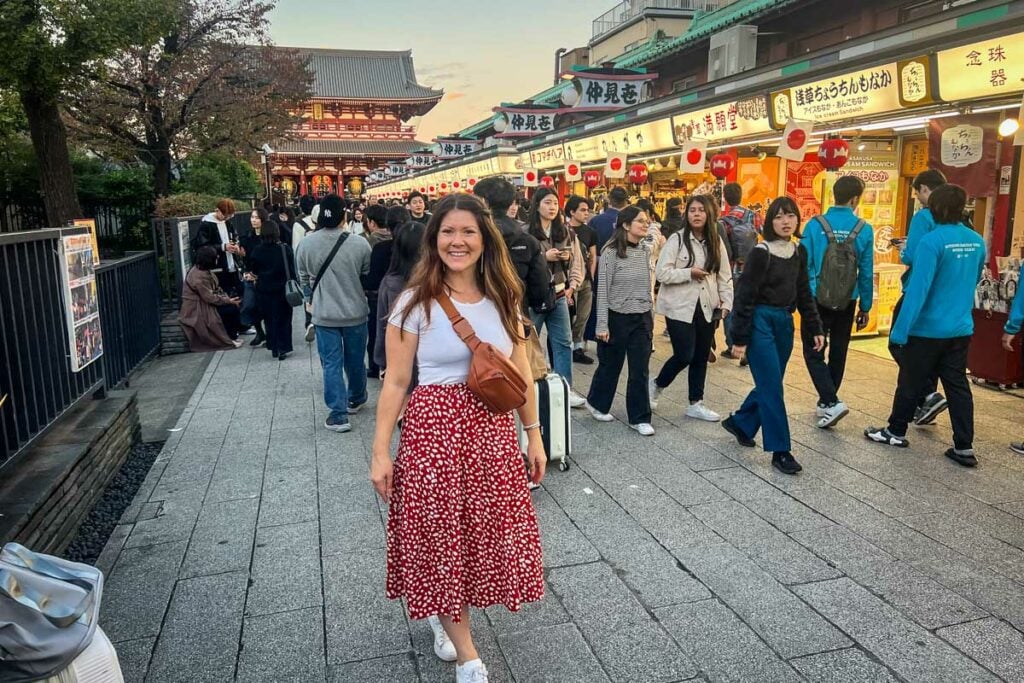
Should I get money from my bank before my trip to Japan?
This is a question we get all the time. The answer really comes down to your personal preference, but we never get money out in advance before international travel.
Whenever we enter a new country, we walk right past the Currency Exchange counters (they are a huge rip off most of the time!) and we go to an ATM to withdraw cash. You will get the best exchange rate by withdrawing foreign currency from an ATM.
If the thought of showing up in a new country without cash on hand makes your hands sweaty, then by all means ignore this advice and grab some yen from your home bank before you leave.
But I will say that airports always have ATMS, and they are easy to find in train stations as well as in 7-Eleven’s and Family Marts in most big Japanese cities.
Before heading to a rural town though, be sure to take out cash just in case you can’t find an ATM.
Credit card travel tips
- Turn on travel notification: Be sure to alert your bank ahead of time that you will be traveling, and where, so they know your transactions aren’t fraud.
- Have a backup card: It’s a good idea to carry more than one card in case you have an issue with one of them. Remember to always pack them in two different places within your luggage — for example, one in your wallet and another in your backpack so if one gets lost or stolen, you still have access to the other.
- Invest in a debit card with no fees: We have a checking account with Charles Schwab , and they reimburse every single ATM fee. This means we never have to take out more money than we feel comfortable with carrying at a time. Try looking into accounts with similar benefits. It will save you so much money on your travels.
- Check out which travel credit cards we personally recommend.
Money-saving tips for Japan
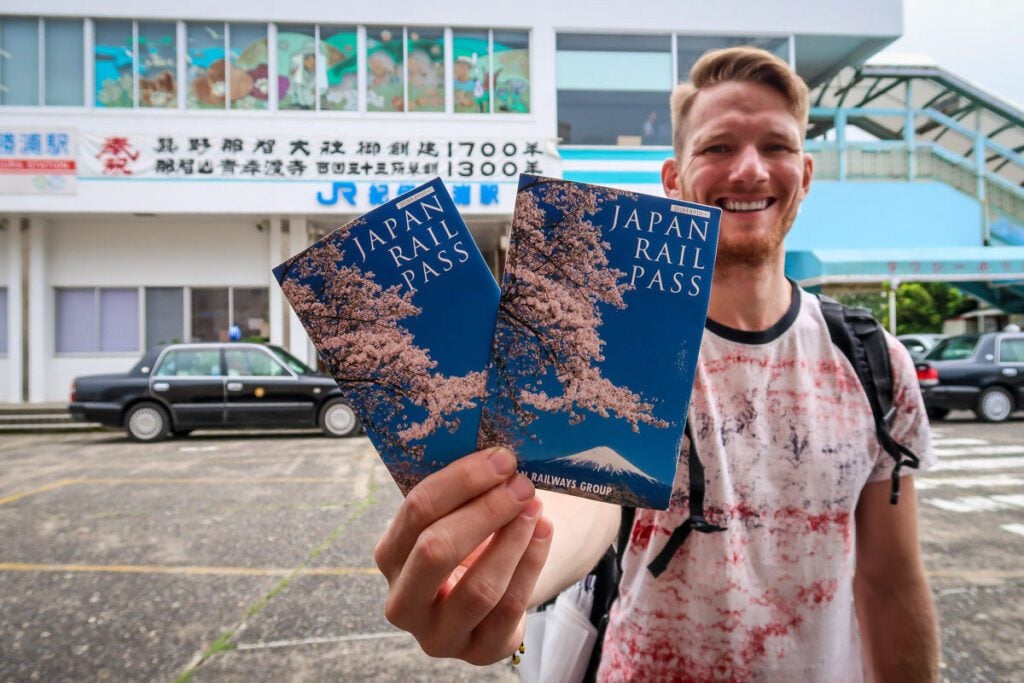
While it’s not a cheap country to visit, there are certainly ways you can save money while traveling in Japan.
- This article breaks down how much the Japan Rail Pass costs and how to purchase it .
- Get your breakfasts and snacks at 7-Eleven or Family Mart (they are everywhere around the country!). While you might never consider eating at a convenience store in your home country, the fresh food options are surprisingly good at these stores in Japan. I’m not joking. You’ll see many locals doing the same.
- Have your biggest meal midday and take advantage of “lunch sets” which often consist of a large meal (sometimes with a dessert) and are typically between $5-7 USD.
- Conveyor belt sushi is a good way to try all the types of sushi your little heart (and stomach!) desire without a huge price tag. Plus, it’s a fun experience in itself!
- Use an app to record your spending and see how well you’re staying on top of your budget! We find it’s much easier to overspend when you don’t know how much it’s all adding up to. We love Trail Wallet for recording our expenses. (We’re not affiliated with them, we just love using it ourselves!)
- Download a converter app on your phone like this one to see the exact exchange rate for your selected currency at the time of your trip, so you always know exactly what you are spending.
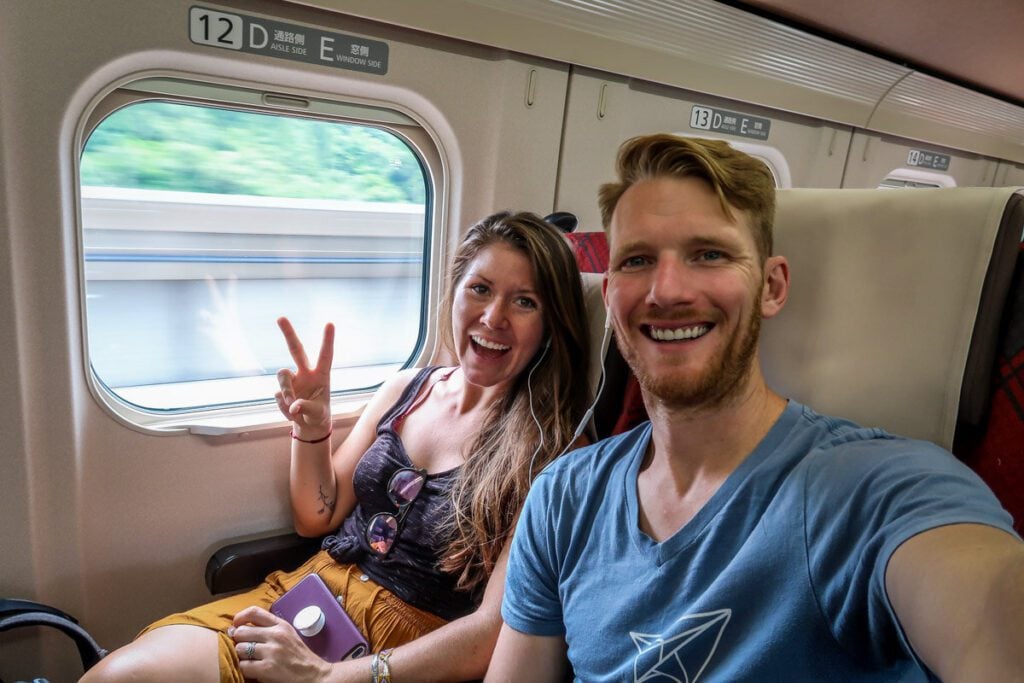
The trains and metros in Japan are some of the cleanest and most efficient in the world , and the rail system covers almost the entire country making it a very efficient way to get around.
However, transportation is one of the biggest expenses to factor into your Japan travel budget .
Travel by train in Japan
We have an entire guide to navigating the Japan Rail system and whether or not getting a J Rail Pass is worthwhile for your trip, depending on your itinerary.
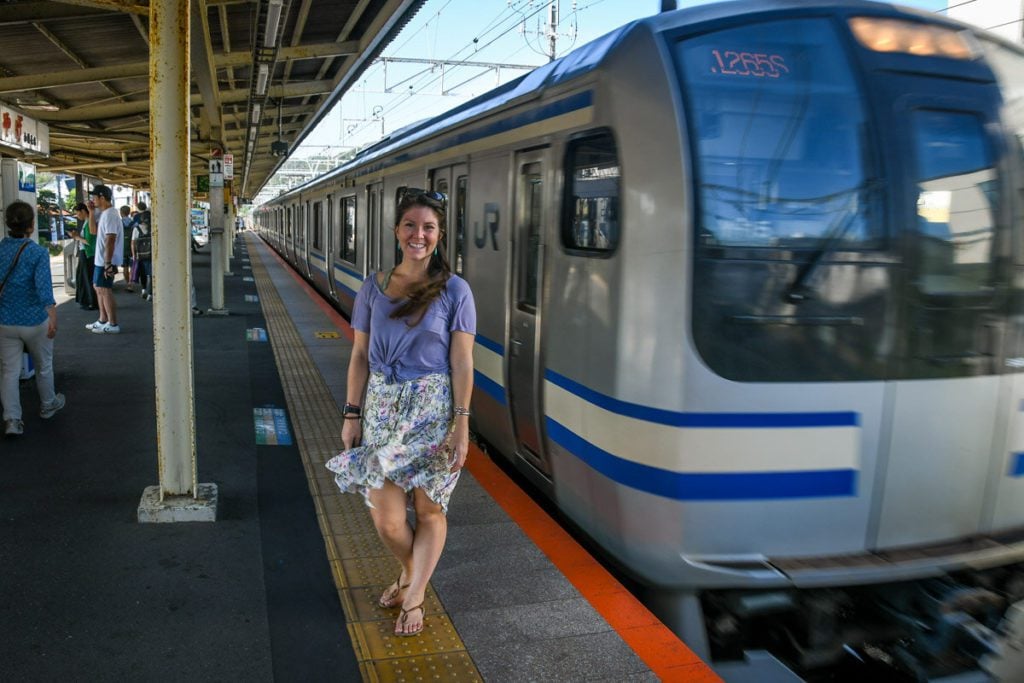
Japan Rail Pass: Where to Buy a JR Pass & Is it Worthwhile?
If you’re traveling to Japan, the Japan Rail Pass can be a huge money saver. We’ll explain exactly when you should purchase the JR Pass and if it is worthwhile for your route. This is everything you need to know including where to buy the rail pass.
Likewise, if you are just planning to spend your time in Tokyo and trying to figure out how to navigate the metro, you can find that info in our Tokyo article .
Renting a car
While we love the ease and efficiency of Japan’s public transportation system, we rented a car during our most recent trip to Japan and we absolutely loved it.
Having our own car was really convenient, especially now that we’re traveling with a toddler . Plus, it gave us the opportunity to get off the beaten path and explore places with very few tourists that would be difficult to visit via public transportation.
I think we will forevermore be renting cars when we visit Japan, even if just for part of our trip. We have a guide to renting a car in Japan (packed with lots of driving tips you won’t want to miss!).
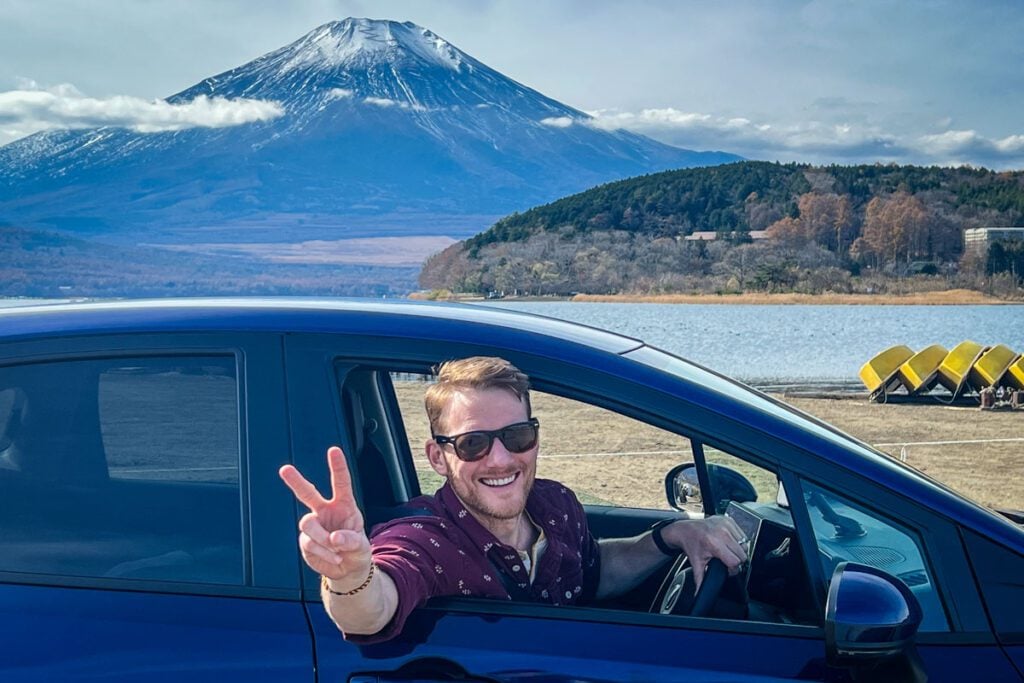
Renting a Car in Japan: Essential Driving Tips You Need to Know!
Renting a car in Japan is the best way to get off the beaten track and see parts of the country most tourists miss. We’re sharing our top tips to help you get a car rental and feel comfortable driving in Japan.
What are the trains like in Japan?
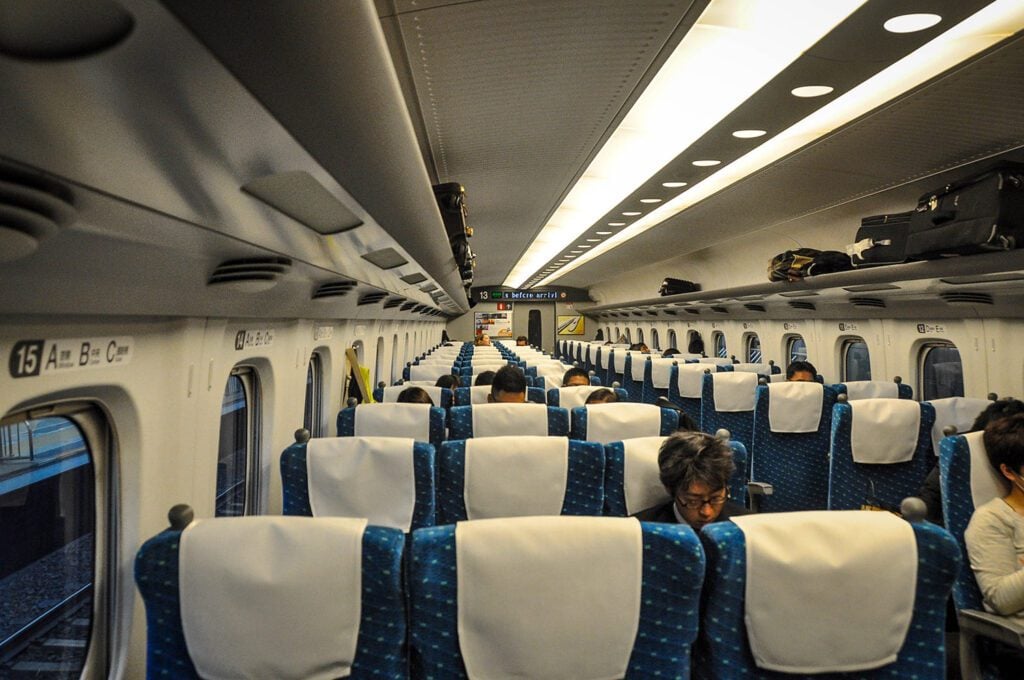
Overall, the trains are clean, comfortable and efficient. The rail system covers almost the entire country, making it a wonderful way to get around. This article goes into detail with everything you’d ever want to know about the Shinkansen Japanese Bullet Trains .
Practical information for visiting Japan
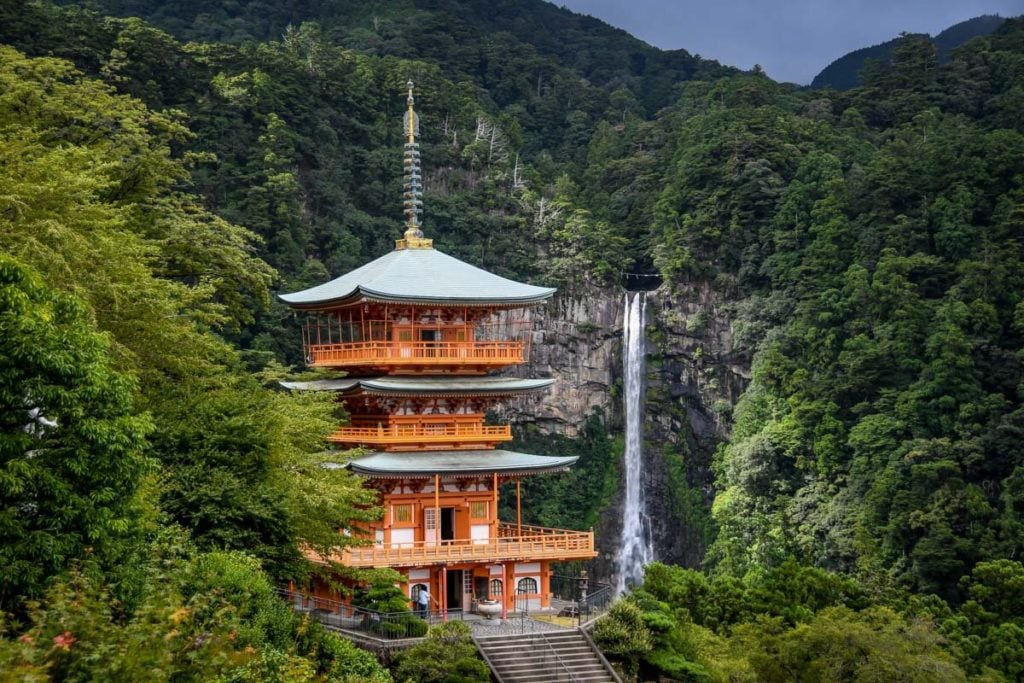
Traveling in Japan for the first time can be overwhelming to plan if you aren’t sure what to expect. A lot of questions can arise that you may not think about with other travel destinations.
We have an article with our top Japan travel tips and advice. This article goes over all the do’s and dont’s for traveling in Japan.
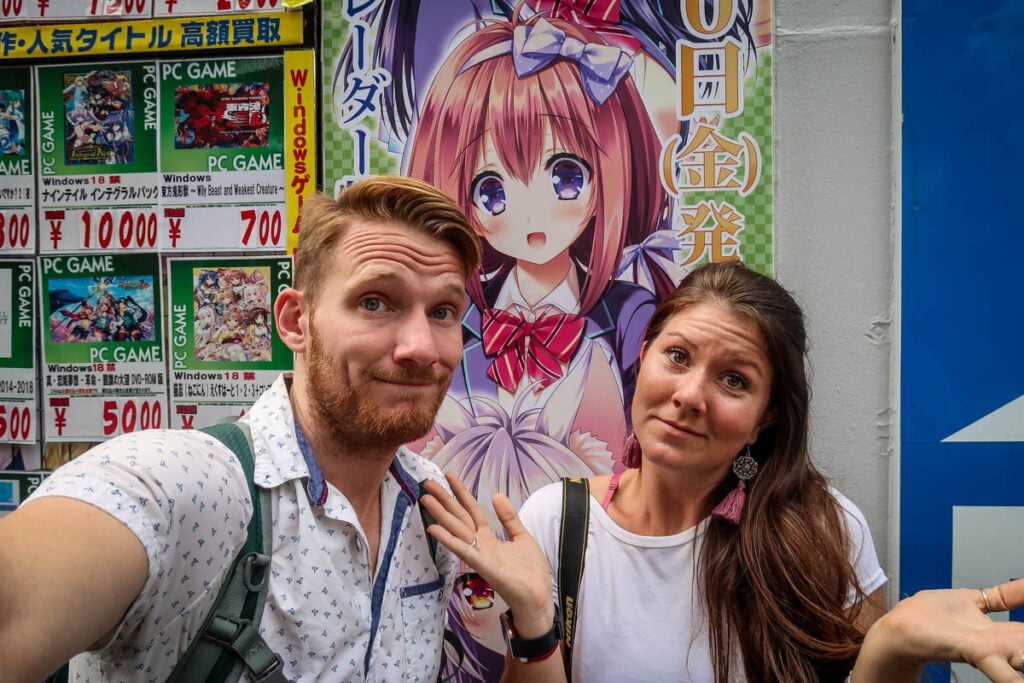
Expert Tips for Visiting Japan (Do’s and Dont’s!)
In this article we’re covering essential tips for visiting Japan, plus helpful advice we learned from personal experience that’ll ensure you enjoy your time in the Land of the Rising Sun even more!
We’ve done our best to narrow down some of the more practical information and answer some specific questions about traveling in Japan.
Do I need travel insurance for Japan?
While it’s not required to enter the country, we always recommend purchasing travel insurance before any trip. It is a small price to pay for the peace of mind you’ll have knowing you will be covered in case of an emergency or if anything is stolen.

For a trip to Japan, we’d recommend getting a plan with Safety Wing insurance . They make it easy to get a quote for the exact duration of your trip and offer the most comprehensive coverage at the best rate.
Check out our travel insurance comparison article for more information on how to pick a policy and what we look for in travel insurance.
How safe is Japan?
Japan is overall very safe and crime is low.
I once met a girl who was an English teacher in Tokyo, and she said she left her wallet in a train station. It sat there, untouched, and the next day when she retraced her steps it was in the same (heavily trafficked) place she had left it.
But even though theft isn’t common in Japanese culture, that doesn’t mean it can’t happen to you. As with any place in the world, always be aware of your surroundings and use common sense.
This is another reason we always recommend getting travel insurance to make sure you’re covered in case anything gets stolen or you run into other emergencies.
Do I need a power converter in Japan?
In Japan the standard voltage is 100 V and the power sockets are type A and B (pictured below). The socket is the same used in North America, but the voltage is lower, so yes you will need a power converter for electronics that don’t already have a converter.
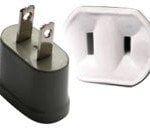
This website is a super helpful resource when it comes to electricity all around the world. Simply select your home country and it will tell you if you need a converter and/or plug adapter for your visit to Japan.
We recommend this all-in-one converter-adapter that works in any country. This means you only need one item no matter where your travels take you!
What are the bathrooms like in Japan?
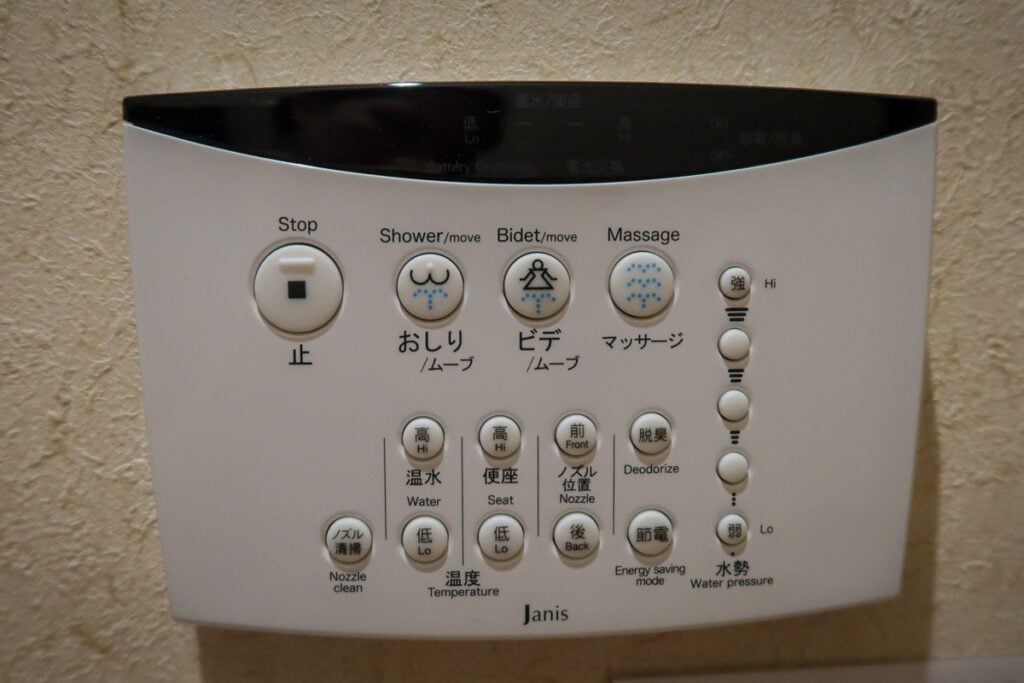
This might be an embarrassing question to ask out loud, but I promise you aren’t the only one thinking it. If it’s your first time visiting Japan, you likely have no idea what to expect when it comes to bathrooms.
The good news is, many bathrooms around the country are very nice and quite… luxurious .
In nicer restrooms, you’ll find toilets equipped with a built-in bidet to spray your bum. And some toilets even have buttons that will play music or rainforest sounds to cover up, well, you know…
Be warned though that in some train stations or in more rural parts of the country, you may find squat toilets similar to ones you’d find in many places around Asia.
How to get cell phone service in Japan
There are two common options for staying connected to data while traveling in Japan: pocket Wifi and local SIM card. This article does a great job of comparing the two and giving our honest opinions about which worked best for us.
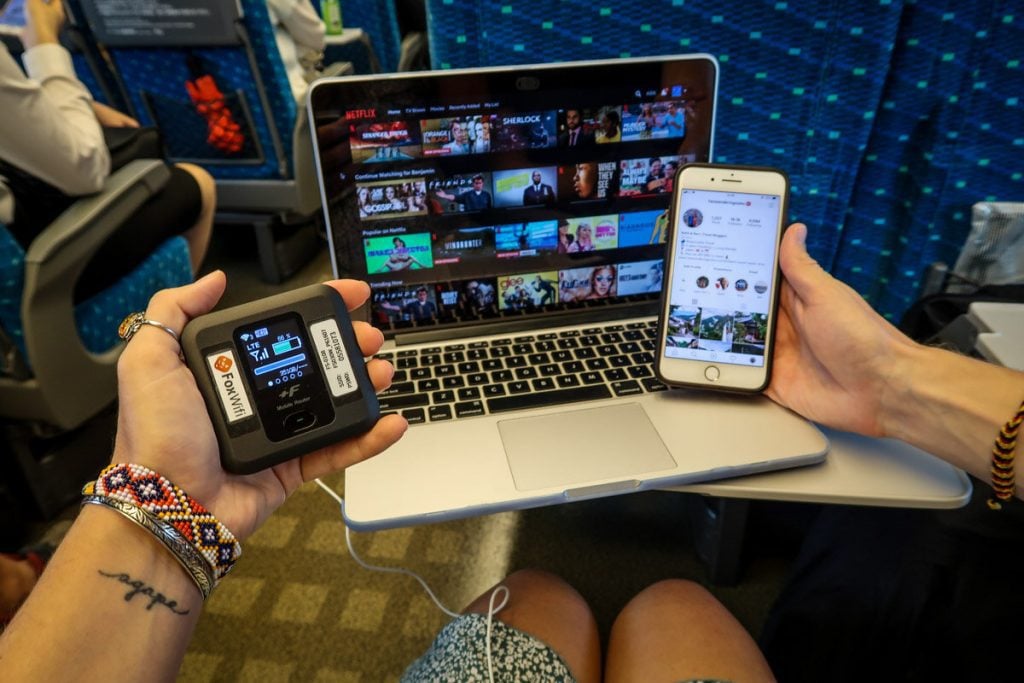
Japan Pocket WiFi vs. Japanese SIM Card: Review & Comparison
Staying connected in Japan is super important for navigating trains and translating menus. But how do you access the Internet in Japan? In this guide, we share our experience using a Japanese SIM card and a Pocket Wifi and tell you which is best for your travels in Japan.
Helpful (& free!) apps for travel in Japan
We have an entire list of the most useful apps for traveling in Japan that you should check out, but here are some of our favorites:
- Google Translate : This is a go-to app for us while traveling in Asia because you can take a photograph of the characters on a menu or label and it will translate for you. Be warned that some things don’t quite translate into English all that well…
- Google Navigation : Can give you the best routes for the metro and trains and even has live updates on delays.
- Hyperdia : The go-to train scheduling app/website in Japan. Plug in a route and it will tell you the times throughout the day and the prices, including each seating class.

Best & Most Useful Japan Travel Apps
Traveling in Japan is made so much easier (and less confusing!) with a few handy apps. Before packing your bags, be sure you have these helpful Japan travel apps downloaded to your phone to make transportation a cinch and the language barrier practically non-existent.
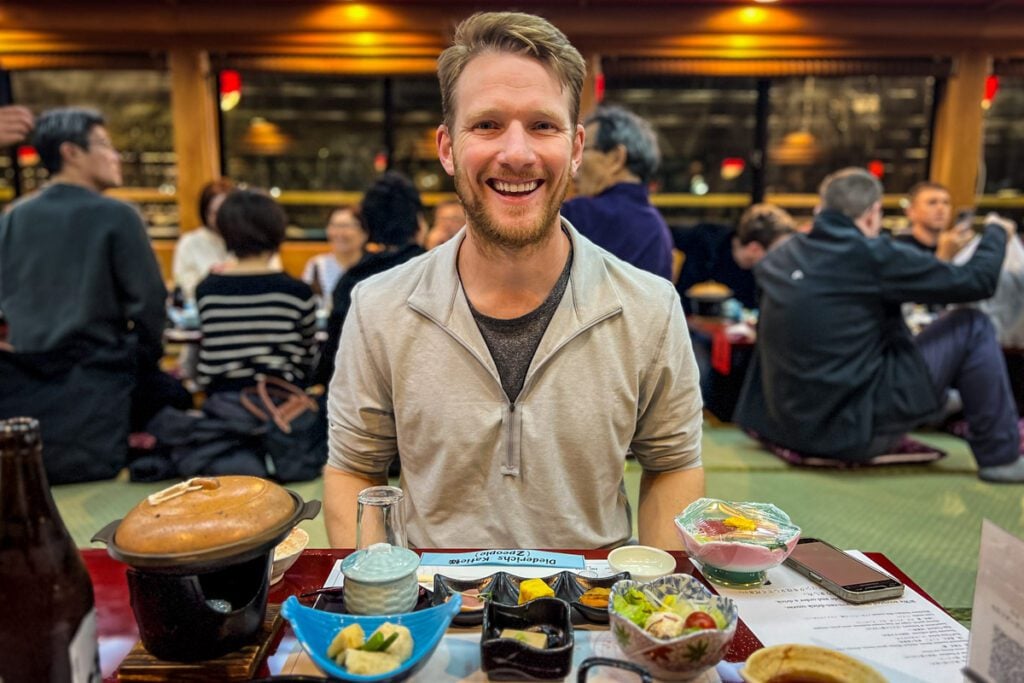
Japanese cuisine stretches far beyond the sushi rolls we’ve come to associate with this country. (Though of course you must try sushi from the source while you’re in Japan!) This article lists the foods you should definitely try in Japan !
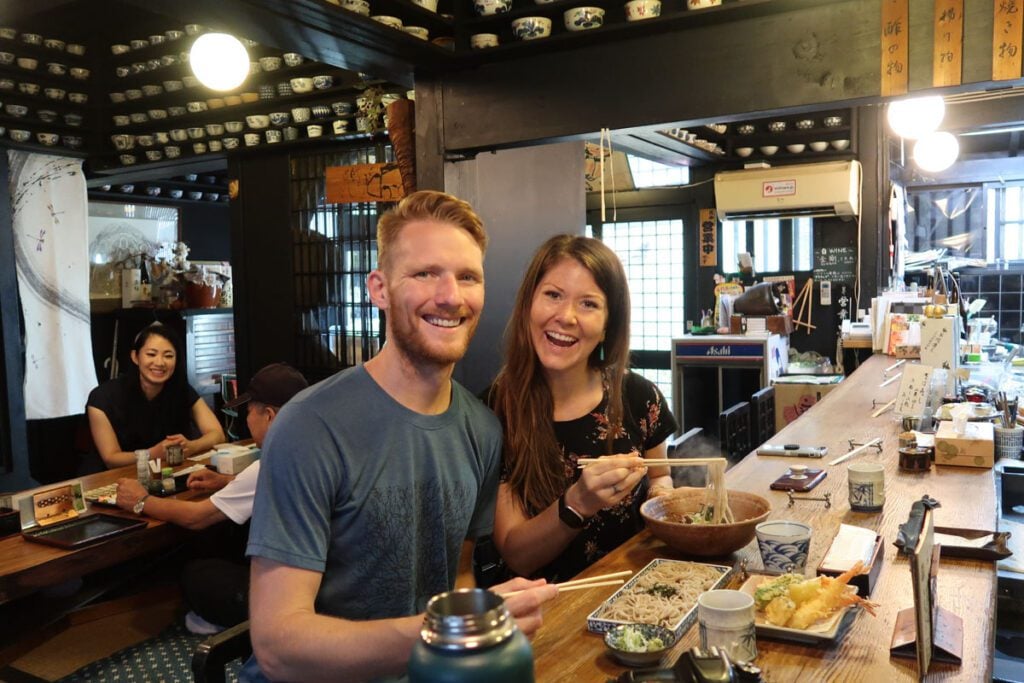
What to Eat in Japan: Foods to Try + Tips for Eating in Japan!
If you’re wondering what to eat in Japan, we’ve got you covered! We’ve put together a list of foods and drinks to try — from famous dishes to those you’ve never heard of. Plus, we’re going over important information everyone should know about eating in Japan.
And if you’re traveling to Japan with food allergies and wondering how that’s going to work. We have a whole section dedicated to dietary restrictions which walks you through what you need to know about Japanese cuisine and how to accommodate your allergies/restrictions in Japan.
Consider doing a food tour
If you want to try as much Japanese food as possible and learn about the cuisine on a deeper level, a food tour is where it’s at!
There are two companies that we trust above the rest for highly-rated food tours throughout Japan:
- We did this Old Town Tokyo Food Tour and really enjoyed it because it was off the beaten path in a neighborhood we would never have explored otherwise.
- Magical Trip is our go-to for unique night time tours like bar and Izakaya hopping. One tour that looks particularly interesting is their Shinjuku food tour in Tokyo.
Japan trip ideas based on your interests
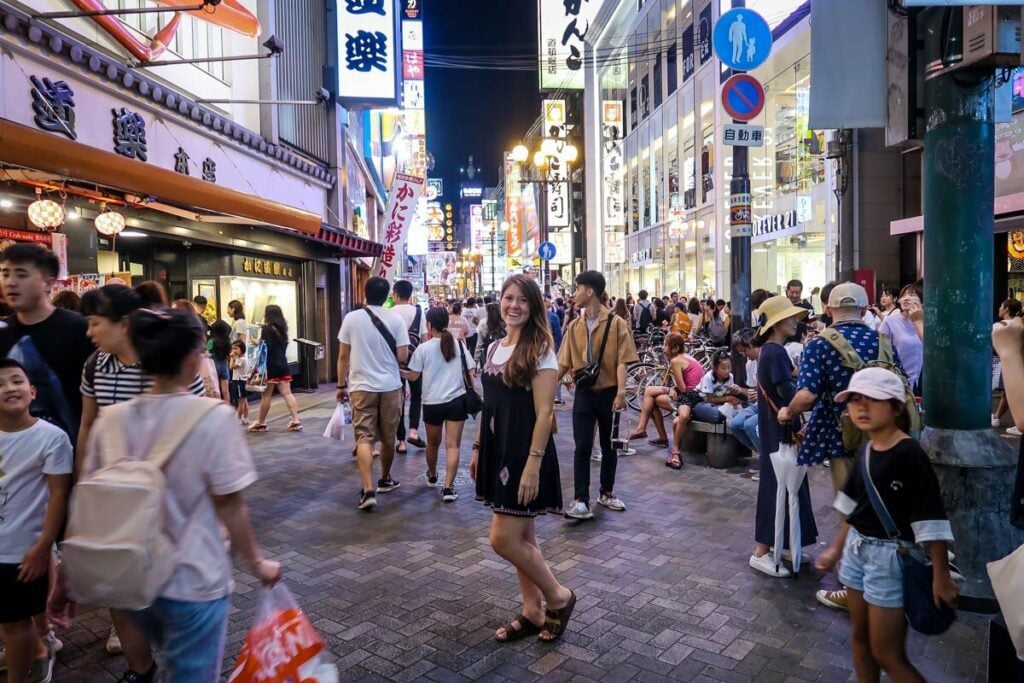
Japan is more than just Tokyo. If it’s your first time traveling to the Land of the Rising Sun , we’d definitely recommend a visit to its capital city as well as some of the other more well-known places like Kyoto and Osaka.
But, if you have been-there-done-that , or you have a lot of time to play with, check out our unique Japan itinerary ideas to get some inspiration.
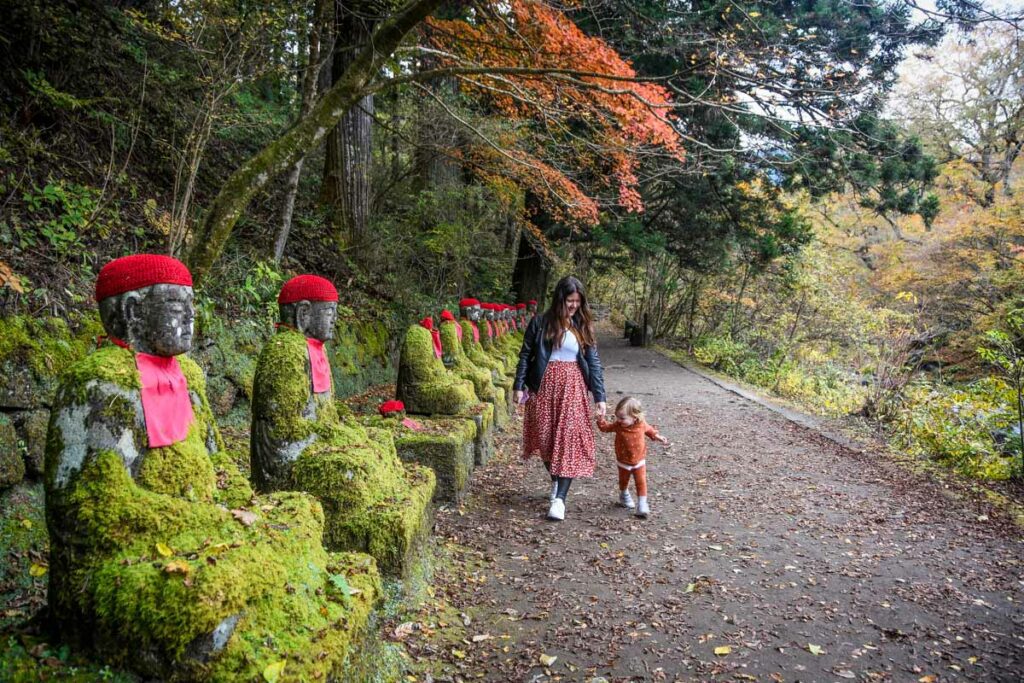
Unique Japan Itinerary Ideas Based on Your Interests
If you’ve been wondering where to start when planning your Japan itinerary, we’ve got some inspiration for you! These unique Japan itinerary ideas are based on your personal travel interests.
We are in the process of creating done-for-you Japan itineraries that are packed full of all sorts of tips we’ve gathered from 3 trips to Japan as well as literally hundreds of hours of research (no exaggeration).
We will have both off-the-beaten path routes as well as a classic itinerary that hits the top attractions. If you want to be the first to know when our Japan itineraries are on sale, get on the waitlist !
If you’re curious to see more about what traveling in Japan is like, we made a video after our first time visiting.
If you cannot see the video, please turn off your AdBlocker. Thanks!
What to pack for your Japan trip
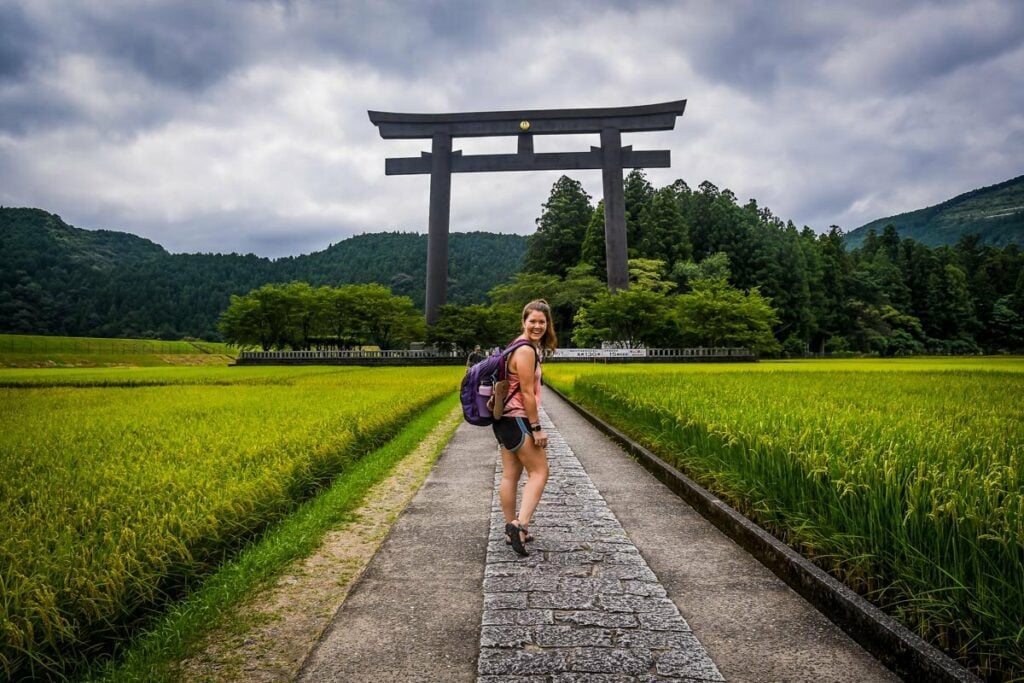
When deciding what to pack for your trip to Japan, a big thing to consider is the time of year you will be visiting. In the wintertime, for instance, you will encounter cold temperatures and will need warm clothing, whereas in summer the temperatures can be quite hot.
We created a whole guide to all the things you need to pack for Japan . Plus, we even have a (totally free!) packing list you can download !
This FREE PDF download includes everything you’re going to want to pack for your Japan trip, including what NOT to bring, plus tons of insider tips! Click the image below and fill out the form to get the packing list PDF sent straight into your inbox:
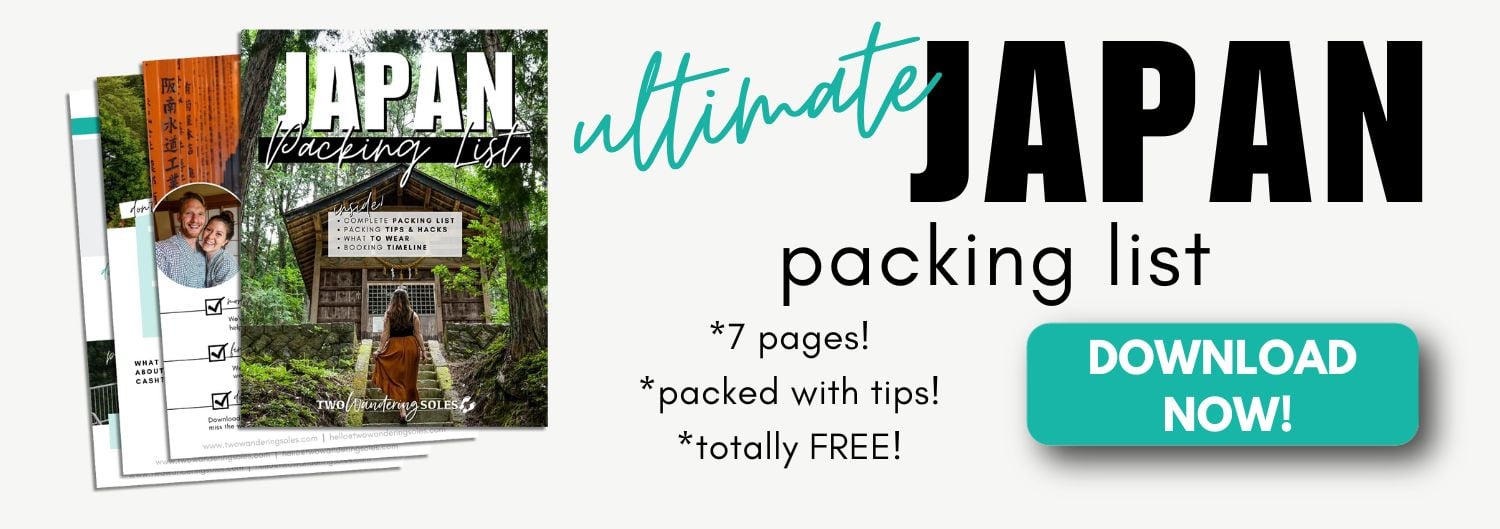
For more tips, check out our packing list for long term travel or the eco-friendly packing list full of travel gear that will minimize your footprint around Japan.
Here are some other items you’ll want to consider packing for your trip to Japan:
- Universal travel adapter : This adapter can plug in to Japanese outlets (and over 150 other countries outlets) safely.
- Away luggage : We recently jumped on the bandwagon and purchased our first Away bags and were not disappointed. These durable hard-sided roller bags come in lots of different sizes and with a lifetime guarantee, they are likely to be the last bags we ever need to purchase!
- Packing cubes : A backpacking staple, these cubes help keep your clothes organized in your bag.
- Power bank : It’s the worst when you arrive in a new city and your phone is dead. Keep it charged with an Anker Battery Pack, this one can charge your phone up to 7 times.
- Travel tripod : If you’re into photography…(if you want some travel photography tips, we’ve got you covered !)
Wondering what to wear in Japan ? We have a guide that goes over exactly what clothing items to pack for each season , including lists for both women and men. We’ll help you build a capsule wardrobe for your trip and let you in on some cultural taboos you should be aware of.
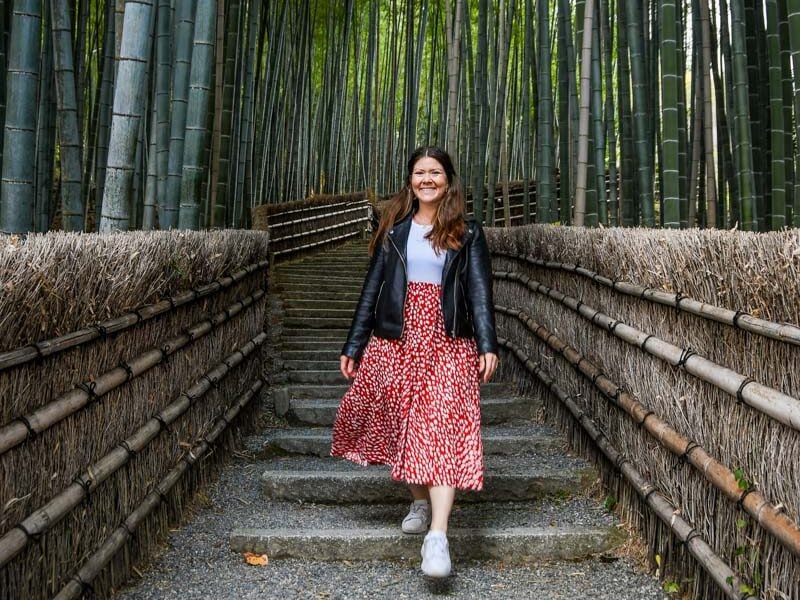
What to Wear in Japan: Packing List + What NOT to Wear!
If you’re wondering what to wear in Japan, this is the guide you need! We’re going over what to wear in each season and how to create a perfect capsule wardrobe. We’re also divulging some items you should not wear in Japan.
What to buy in Japan
If you’re anything like us, you enjoy bringing back mementos from your travels to remind you of the places you’ve been. We have a great round up of things to buy in Japan , including plenty of unique ideas for Japanese souvenirs.
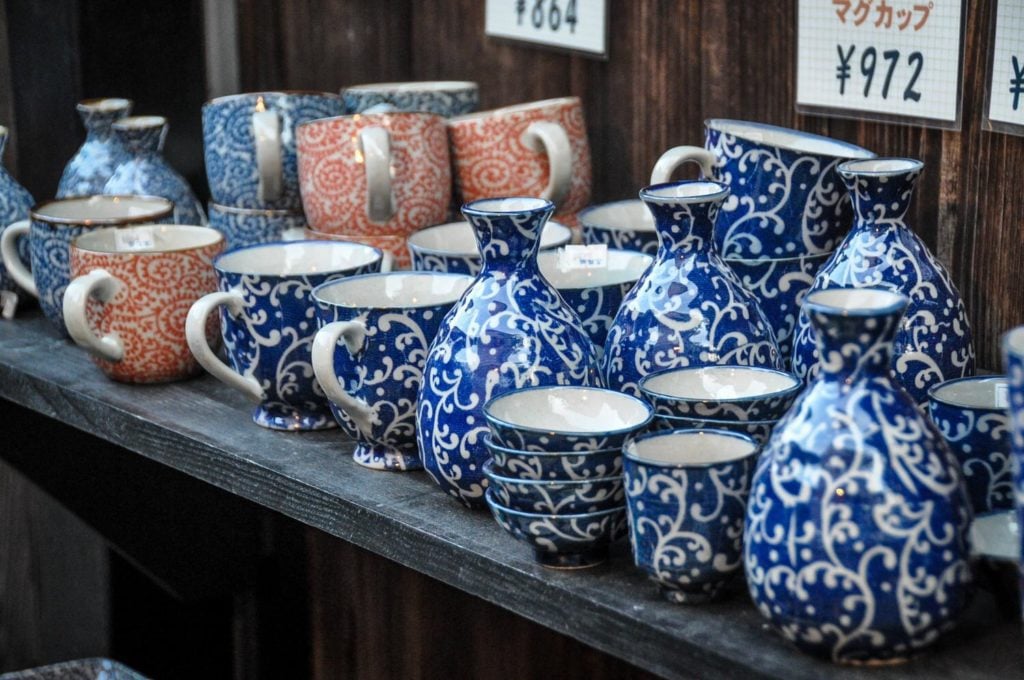
Things to Buy in Japan: Ideas for Unique Japanese Souvenirs
When traveling to Japan, you’ll have no shortage of shopping opportunities. We are going over the best Japanese Souvenirs to buy so you don’t end up filling your suitcase with unnecessary purchases.
More resources for traveling in Japan
We have TONS of resources on travel in Japan and destinations throughout the country. Check out our Ultimate Japan Travel Guide for all the answers to your most burning questions, or read some of our favorite articles below!
- Best Time to Visit Japan
- Is the Japan Rail Pass Worthwhile?
- Best One Week Japan Itinerary for Your First Visit
Save this article on Pinterest for later!
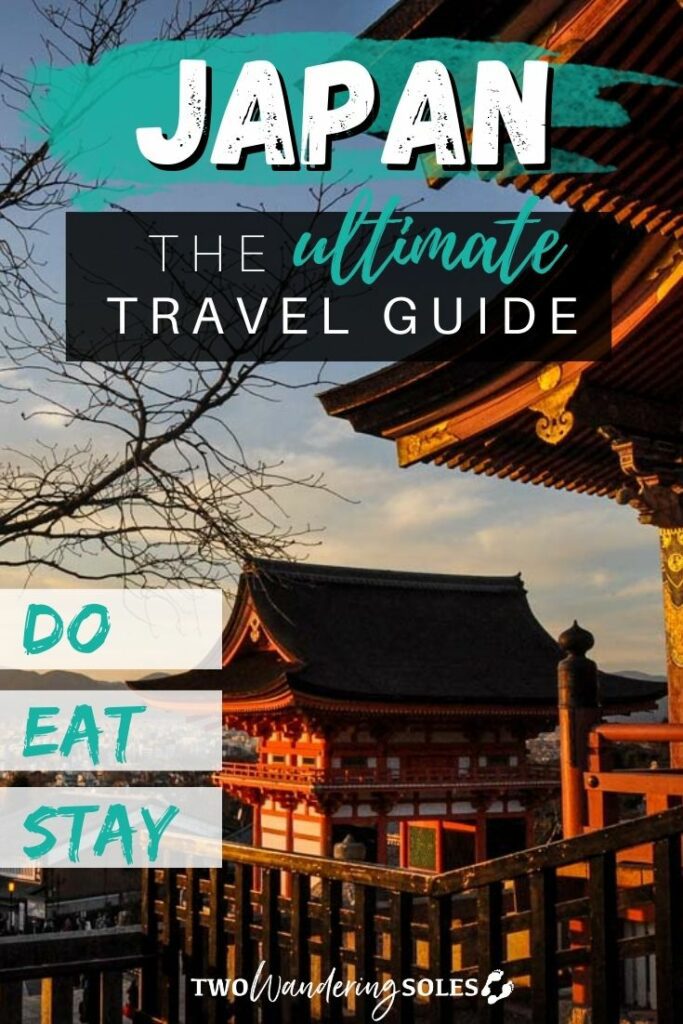
We want to hear from you!
Now that you’ve read through this extensive Japan trip planner, do you feel more prepared for your trip?! Is there anything we didn’t cover that you still have questions about? Comment below and we’ll try our very best to find the answer if we don’t know ourselves!
Comments (158) on “ Japan Trip Planner [2024]: How to Plan Your First Trip to Japan ”
Planning your first Japan trip? Exciting! Research cultural norms, attractions, and accommodation options. Consider exploring Kyoto’s historic temples and Tokyo’s vibrant cityscape for a memorable adventure.
Very informative post.
Best Travel Blog I have Ever Read. Thanks for Sharing this Article.
Helpful information of traveling to Japan and different places for making the memories lasts forever.
Your article is marvelous , It is very interesting topic and loved it , you were defined it very clear and make it informative for us. i am came first time on your blog , It is really good. thanks for valueble writing ..
You have understood clearly about Japan Travel Guide. Still you are looking for India Traveling. Embark on a soul-stirring pilgrimage with our Maharashtra Jyotirlinga Tour Package from Mumbai. Traverse the spiritual landscape of Maharashtra as you visit the sacred shrines of the Jyotirlingas, each steeped in ancient legend and divine energy. From the mystical Trimbakeshwar to the serene Bhimashankar, this journey promises an immersive experience of devotion and tranquility. Don’t miss this opportunity to embark on a spiritual odyssey of a lifetime. View more details or book your tour by visiting our website now.
thanks for sharing such amazing information.
Great Info gave by the Admin.
One of my biggest dream! hope can visit japan soon!
This guide has everything you need to know to plan and book your dream trip to the Land of the Rising Sun. We’ve got you covered from visas and flights to transportation and accommodation. Thanks for sharing this amazing information with us…
Thanks to your travelog and detailed info! I’m planing a trip to Japan and this guide will really help me to arranging and planning.
tempotravellerhire
Thank you for sharing this post with us, I was actually looking for same.
Thanks so much, you guys! Glad you like the article.
Nice Article
Thanks for sharing, I would love to travel.
Superb information for the Japan travel guide.
Very helpful; many thanks.
This Japan Travel Guide is an invaluable resource, seamlessly guiding newcomers through the intricacies of booking their first trip with comprehensive insights and practical tips. The engaging content not only simplifies the process but also sparks excitement for the unparalleled experiences awaiting in the Land of the Rising Sun.
This Japan Travel Guide is a comprehensive gem, providing valuable insights on booking a first-time trip. Clear, concise, and incredibly helpful, it’s a must-read for anyone planning to explore the Land of the Rising Sun.
We provides premium uniforms to corporates and industries. Customized uniform tailoring with branding on-time delivery with best price in UAE.
Get affordable Taxi Service in Kochi Kerala: sedan, SUV, Tempo Traveller Taxi Cab Services. South India tour packages, Sabarimala Taxi, Airport Transfer.
Very informative, thanks.
Very Relevant Post. Thankyou so much for sharing this with us.
I just planning to visit Japan. thanks for your guide.
If you aren’t hitting the ski slopes, March to May and September to November are generally considered the best times to visit the country for pleasant weather.
Yes! We are so excited to visit this coming November!
I found the post to be highly good. The shared information are greatly appreciated
Great Article, Thanks for writing.
Nice Article; thanks for writing the informative content.
Nice Artice, Thanks for writing.
it`s a good and unique tips to travel japan
Thanks Carol! Japan travel is amazing, but sometimes it can be confusing for the first time traveler. We are glad you found it useful!
It is my dream to visit Japan once in my life currently I am a student also preparing for a Job but soon I will definitely visit my dream country Japan once in my life to experience heaven on earth and I bookmarked this article for future Help. I really want to thank to the writer of this post,
Thanks for sharing such an informative article.The article was a delightful read, and I found it to be exceptionally well-crafted and enlightening.I think this is a fantastic article, and I really appreciate you letting me know about it.
online casino The source of modern live casinos, online slots, online lottery, online football and various betting that you can enjoy.
Thanks for sharing, I always want to travel to Japan, a beautiful country.
This is so comprehensive! Must have ben so much effort, thanks so much!!!
Wow! This comprehensive resource covers everything you need for planning a trip to Japan. Discover essential tips and information to make your Japanese adventure unforgettable.
amazing information
nice post, thanks for sharing
The blog post was insightful and well-written, providing valuable information on the topic. The content was well-organized, making it easy to read and understand. The author’s writing style was engaging, keeping me hooked from start to finish. I appreciated the inclusion of relevant examples and practical tips, which added depth to the article. Overall, it was an excellent read, and I look forward to more informative posts in the future.
I love and appreciate it so much. And I would like to recommend my blog to the people who visit your blog.
Thanks For Sharing This incredible information
Regards, Carol Although travelling in Japan is fantastic, it can occasionally be challenging for first-timers. We’re happy it was helpful for you!
The article is written very well. It provides such a great information about Japan trip. The content has full information about Japan , i love travelling, your article is very impressive. I would definitely travel this amazing place. Thank you for this great content please read my blogs too.
Wow, guys. This is the most comprehensive Japan travel post I’ve ever seen! There’s no way I could read through this entire thing right now, but I’ll certainly bookmarking this for our future trip to Japan. I noticed that you’re a VIPKid teacher as well. It’s amazing how this company has made traveling a reality for so many of us! Keep the amazing content coming!
Thanks for the in-depth wonderful article you turned out here Enjoyed reading the article above and thank you for sharing good knowledge and information it’s very helpful. I was searching for a travel blog and found your blog site. I like your high-quality blog site design plus your posting abilities. Keep doing it
Thanks Jamie, glad you found it useful. Let us know if you have any questions about traveling in Japan
Yes i am completely concurred with this article and i simply need say this article is extremely decent and exceptionally useful article.
I just found this good blog and have high hopes for it to continue. Keep up the great work, its hard to find good ones. I have added to my favorites. Thank You.
Thanks for sharing this article it was quite insightful. Hoping to see more articles. Meanwhile, refer
amazing blog thnaks for sharing with us
yes, It is very helpful to take help from japnanies tourist guide. I love your post. thanks keep it good information.
Wow! Great works guys – this is a superb guide. The amount of work you’ve put into this is seriously impressive. Good practical information and tips too.
I’m also an onsen fan, and I completely agree for the truly immersive cultural experience nothing beats staying in a ryokan (traditional Japanese inn).
Travelling with your whole family or a group of friends to Manali? Just book a Tempo Traveller in Manali, and you and your whole group can travel in just one vehicle, that too in comfort and leisure. Chiku Cab helps you book tempo travellers even for the entire Golden Triangle tour of India.
GTS cab service in Dehradun comes with the top-notch facilities of Clean Cars, Well Trained Drivers and 24*7 Customer Support.We provide all type of car including sedan, Dzire, xcent, or an suv, Innova Crysta, We guarantee to provide both on-road and online safety for our customers. For on-road safety Book Online Cab in Dehradun at Low Fare for One-way or Round-Trip, Local Hire affordable full day sightseeing taxi from Delhi to dehradhun Call Now +918191008100.
Nice blog! I really like it. Japan is one of my dream place in my travel list.
Thank your for this plan
Really enjoying all of your Japan blogs – they’re so helpful for planning while waiting for travel to open up again!
I loved your post…
Hi, Nice blog.
I read your blog thanks for sharing.
Thank you for sharing this blog. You have summed up all the beautiful topics of Japan in this blog. Keep up the good work guys!!! If anyone wants to visit India we are here to serve you the best taxi service all over India. For more information visit our website
Excellent site except for the lack of info on Tokyo bus and subway passes/fares. Need info on where to buy, how to buy, cost and what they can be used for.
If I see a good post, you will not go without praising me, because every word written in the post you have written is very thoughtful, your way of writing is very beautiful and your views are also very good. This is a commendable post, as much as this post is praised, it is less, you should keep writing more beautiful posts in your life.
Really the knowledge given by this blog is 100% thanks for making such a knowledgable article on travelling life.
Thanks for this great article! Have got of tons of ideas for my trip! This country is definitely now my bucket list on more priority now!
Thanks a lot for sharing all the details. would really help me plan my trip in a better way!
This is the first time I visit here. I found so many interesting stuff in your blog especially its discussion. From the tons of comments on your articles, I guess I am not the only one having all the enjoyment here keep up the good work.
It made me more crazy for Japan. Soon will plan for it.
how worthy things has been provided in the article thanks for posting
what a great article about japan. its been a my favorite country always
Japan is on my family’s bucket list. I am definitely going to pin this guide for reference when I am planning
Thank you for information about Japan! Does anyone have an itinerary with a trip to Japan on the Worldee?
Amazing Japan guide! Cant wait to go back!!!
Really amazing blog about travelling, I am looking such type of blogs but finally, I got it the way the things described is totally amazing.
Thanks so much, glad you enjoyed it 🙂
Great Info. Thanks!
Glas it’s helpful 🙂
Nara was mind-blowing! The Deer, walking up to you, begging for food, the Mochi pull at the mall and all the beautiful Temples. Unfortunately, it rained during our visit, but I still look at the pictures and think about how lucky I am to have seen this.
Perfect Travel Blog Guide For the Travel to Japan.
The blog is brilliantly written and provides all necessary information I really like this awesome post. Thanks for sharing this useful post.
Hi! Such a wonderful article. Japan is definitely a beautiful place to visit, will be adding this to my travel bucket list
Nice Post. best information about Japan tour, Japan is technology city. The travel experience is great.
Love this article! Thanks for sharing.
Hey, your post is amazing and informative. thanks for sharing this info. If you want to travel anywhere in India, our taxi service is available all over India.
Wonderful content. Really thought provoking and super informative. Keep it up guys.
What an amazing and extensive post. I would like to add something to the foodie part. Japanese food is amazing, and while you can try delicious things in Tokyo, every region and city has its specialties. For real foodies I would suggest visiting the following cities and trying the following foods: Osaka – Osaka style Okonomiyaki and Takoyaki Kobe – Kobe Beef (other regions also have amazing Wagyu) Hiroshima – Hiroshima style Okonomiyaki and Oysters Nagoya – Hitsumabushi and everything with red Miso like Miso Nikomi Udon Fukuoka – Hakata Ramen Of course, there is much much more but these are the foodie highlights of Japan.
wow i have a dream to visit japan
Impressive writing. You have the power to keep the reader occupied with your quality content and style of writing. I encourage you to write more.
very nice info, i will go there soon!
very nice place and recommended to visit
As someone that had lived in Okinawa (Military posting) for two years, I never got to travel around Japan. I’m planning on a trip next year. Should I have one AirBnB that I use as my ‘home’ for my trip (I’ll be in Japan for about 3 or 4 weeks) or should I only book spots for a couple of days while I travel around the country?
Very interesting article, thank you for sharing your travel experience to Japan. By reading this, I want to come to Japan. It’s nice to come there and feel the holiday atmosphere in Japan. landhoteldiever.nl
Wonderful post! Congratulations!
honestly WOW! this website is so useful and helpful and it has really, and I mean REALLY good info on Japan. This has helped me so much to plan my dream trip to Japan and I thank you both! Katie and Ben! for taking the time to share your experience and your knowledge that ultimately helped me in so many ways! THANK YOU!! ♥♥♥♥♥♥♥♥♥♥♥♥
Outstanding vacation point. Great!
Great Post. Thanks for sharing Great information about Japan tour, The travel experience is great.
Thanks so much for your nice comment! Cheers!
Hey Guys, I just have to say "hats off" on this guide… "Ultimate Guides" are so misused and the term gets thrown around so much it’s nice to actually see one that’s this robust!
Thanks so much Sara! Are you planning a trip to Japan soon? Let us know if you have any more questions. Cheers!
You are very welcome Agen! Let us know if you have any questions!
a very extraordinary website ! your discussion is really very helpful. thank you very much for what you convey. Good luck always.
Thank you so much for your nice comment, we really appreciate it. Let us know if you have any questions about traveling in Japan!
Hi Really grate information. you have done your best. I hope one day I can afford it to take a short trip to Japan which is my wonder land. I have been reading Japanese for a while. (Mai asa watash wa nihon go benki shimasu) (domo arigato gozaimasu)
Thanks so much for your nice comment!
Planning to visit Japan in autumn of 2019, found a lot of interesting information and some very good suggestions/tips here, thanks!
You are very welcome Mari! Hope you have a great trip to Japan!
Wow, thanks for sharing Katie and Ben, this is insanely detailed and covers everything a traveller needs!
If we may add just add some safety issues for fellow travellers to watch out for, mainly do be aware of some of the bar scams and bill padding that happen in Roppongi and Shinjuku, as well as donation touts/scammers. May everyone enjoy Japan!
Thanks for the tip David, but from our experience we didn’t see any scams while traveling in Japan.
Will be using this in the future with specific items to get before hand. Traveling to Japan alone and for the first time in a couple months. Extremely excited and nervous ? Thank you!
Hey Cody, Thanks for the comment. Traveling to Japan solo can seem intimidating, but it is totally possible. Let us know if you have any questions, we would be happy to help. Cheers, Ben
what’s your camera and lens? 🙂
We have a Nikon D7500 DSLR camera that we take most of our photos with. If you want more tips on travel photography, you might want to check out our article on it. Let us know if you have any questions. Cheers!
Oh my your post is verrrrrryyyyy informative. I wish I saw this before our trip. Anyhow, will keep this in my bookmarks for my future travels in Japan. Thanks a lot.
Dang, sorry you missed it. Hopefully it will be a good start for your next trip!
Wow! Very informative. I’ll be sure to use these handy hints when we go there next year!
Glad you liked the tips, Melissa. Hope you have fun planning your trip to Japan!
I literally found this post very interesting and it just cast spell on me. I am soon going to visit Japan, thanks for sharing this post.
You are very welcome. Have fun visiting Japan soon!
Hi Good Morning to all of us! How is it like going to live at Japanese are more confidence swept even though they not shy fronts others? What can they most travel like wise Japanese become the standard language, seeing use in most official communications among JAPAN;which later developed in "Kanji" which is a form of writing used to express ideas in the Japanese and Chinese languages.[11] many ordinary Japanese people tend to consider the languages as dialects of Japanese. This is the result of the official language policy of the Japanese government, which has declared these languages to be dialects and prohibited their use in middle high education after graduation even though they will understand unfortunate front of and others?
Thank you Karen for the additional information on Japan.
Hi Katie & Ben…My better half and I visited Japan last week from India and had a wonderful trip…thanks to your travelog and detailed info! We blindly followed your steps at almost every point and did very little customization. Thanks again for these contents. Keep traveling and guide amateurs like us 🙂
Thank you so much for the kind words. It truly makes our day knowing we have helped make someone’s trip better or easier! Thank you for taking the time to let us know! It just brought a smile to our faces 🙂
Great and useful information about travelling through Japan! But are you sure that a two-way trip from Tokyo to Kyoto covers the price of the 1 week JR-Pass? Maybe it depends on your location, but where I am from (NL) it seems cheaper to buy two separate tickets. Especially considering that you cannot take the fastest Shinkansen (Nozomi) when using the JR-Pass.
Hey there JapanYo, the round trip ticket from Kyoto to Tokyo is basically the same price as the one week JRail Pass. And if you are traveling anywhere else in Japan, even intercity, if you have the pass, you can think of all your other train trips are free, since you can ride JRail unlimited times within the week.
And you still can ride the Shinkansen Bullet Trains with the pass, the only one it excludes is Nozomi.
Hope this information helps others choose what’s best for them when traveling to Japan.
The ultimate Japan travel guide helps me a lot in planning my trip. The pictures look beautiful and stunning. I really enjoyed the trip and please let me know what are the other incredible sights to explore in Japan.
Hey there, Glad you liked the article. We have tons of tips and advice in our other Japan articles, so if you don’t find what you’re looking for here, be sure to check out our Japan travel page.
Loved your post.
Thanks so much Japan Tours! Glad you liked it!
I’ve been offered a place in japan to intern so cherry blossoms here we come!
Congratulations D on your internship! Cherry blossom season will be a beautiful time of year to be in Japan.
Great guide! So many helpful tips!
Thanks so much DeJuan for your comment.
Excellent guide! I frequent Japan so I’ll be sure to keep your tips in mind 🙂 This is so comprehensive!
Thanks Lev, glad to hear you like it. Let us know how it comes in handy for your next trip. Cheers!
Wow. This is simple epic. Not sure how long it took you to write this but it’s AMAZING and having been in Japan couldn’t agree more!
Thank you so much Paula! We spent a lot of time on it, so it is wonderful to hear that you find it helpful (especially since you’ve been to Japan!).
Wow what a great resource. You have really covered everything you need to plan a trip to Japan.
Thanks Patti, glad you found it useful!
Wow, I think this is the most thorough guide to Japan ever! Guys, you should create an ebook out of it! It’s not only good for first timers, but for anyone giving Japan a visit!
Aww thanks Bistra. We tried really hard to make it one of the best Japan travel guides out there. Glad you liked it!
Japan is on my family’s bucket list. I am definitely going to pin this guide for reference when I am planning.
Thanks Jamie, glad you found it useful. Let us know if you have any questions about traveling in Japan.
Wow, guys. This is the most comprehensive Japan travel post I’ve ever seen! There’s no way I could read through this entire thing right now, but I’ll certainly bookmarking this for our future trip to Japan. I noticed that you’re a VIPKid teacher as well. It’s amazing how this company has made traveling a reality for so many of us! Keep the amazing content coming!
Thanks so much you guys! Glad you like the article. VIPKID is awesome and has really helped us stay on the road. So nice we can teach from anywhere in the world.
Wow! This IS the ultimate Japan travel guide – complete with what to do during what season, costs, and some Japanese words. Thank you for this!
Seriously it’s a total Japan guide
Leave a Reply Cancel reply
Your email address will not be published. Required fields are marked *
Save my name, email, and website in this browser for the next time I comment.

- 2 Weeks for Couple
- 2 Weeks for Family
- Thailand Lantern Festival
- Indonesia(Bali)
- South Korea
- China (HK, Taiwan)
- Itinerary Ideas
- Asia Highlights Travel Reviews
- Thailand Travel Reviews
- Vietnam Travel Reviews
- Cambodia Travel Reviews
- Japan Travel Reviews
- Myanmar Travel Reviews
- China Travel Reviews

How to Plan Your Trip to Japan 2024/2025 — 7 Easy Steps
Japan, being a bucketlist trip destination for many travelers, especially attracts families with teenagers and couples. Besides nature, history, and modernity, Japan's unique and lively culture of sumo , samurai , anime, and sushi continues to draw curious visitors from all over the world.
In this article, we'll explain everything you need to know for planning a trip to Japan, including how to budget, when you should visit, top places to go, how to get around, and more.
- 1. Do I Need a Visa to Visit Japan?
- 2. Top 7 Places to Visit in Japan
- 3. Best Time to Visit Japan
- 4. How Much Does a Japanese Vacation Cost?
- 5. How Many Days to Stay in Japan?
- 6. Accommodation in Japan - Ryokans
- 7. How to Get to and Around Japan?
Do I Need a Visa to Visit Japan?
Nationals of many countries are exempt from needing a visa to enter Japan, including the United States, Canada, the United Kingdom, and Australia. Most travelers can stay in Japan without a visa for 90 days.
Discover real reviews of Highlights Travel Family 's best-rated service across trusted platforms.
7 Top Places to Visit in Japan
With our experience traveling in Japan, we know it can be difficult to narrow down where you want to visit, in a place that has so many incredible destinations. Below are some of our favorite destinations according to our experience of traveling and planning holidays in Japan.
1) Tokyo: Modernity & Japanese Anime
As the booming and modern capital city, Tokyo has a lot to offer by way of foods, shopping malls, temples, museums, and skybars, as well as the iconic Mount Fuji.
Beyond the representative attractions, we can arrange a variety hand-picked activities for you to enrich your experiences. For example, you can make sushi at a local home and enjoy it as your lunch and learn about the legendary samurai warriors by wearing a samurai costume.
Many people come to Japan because their children, especially teenagers, love it. Tokyo is a great place to meet your children's interests in anime with a variety of theme parks such as J World, the Pokemon Center, and Tokyo Disneyland , sure to captivate their attention.
Check more details about Plan Your First Trip to Tokyo >>>
2) Kyoto: Ancient Temples & Geisha
Kyoto has a lot of prominent ancient and historical sites to explore. This city has some special and authentic experiences you should not miss.
Kyoto is home to the striking Fushimi Inari Shrine , which featured in the film Memoirs of a Geisha and is famous for its countless vermilion torii gates. Stay at a cozy ryokan with old-style tatami bedrooms to experience tradition Japanese accommodation.
Walking around the Gion District with kimonos, along lantern-lined cobblestone streets, will make you feel like you are on a trip back in time.
In Kyoto, you are never too far from the natural side of Japan. Meander through the lush bamboo groves in Arashiyama or admire cherry blossoms in lots of famous places.
Get more ideas about Plan a Trip to Kyoto >>>
3) Hakone: Ryokans & Hot Springs
Known all over the country for its picturesque beauty and natural hot springs , Hakone is one of the most popular destinations in Japan.
The Hakone region has more than a dozen springs that provide natural hot water. These springs are surrounded by ryokans where you can stay, eat delicious kaiseki meals, and bathe in the healing waters .
When not luxuriating in the relaxing hot springs, you can explore this sleepy undeveloped town located on the shores of Lake Ashinoko, with Mount Fuji in the background .
4) Nara: Deer Park
Nara is an ancient Japanese city less than an hour from Kyoto and Osaka . Most travelers come to Nara because of the Nara Park (often referred to by locals as Deer Park ). It is home to over a thousand free-roaming deer which can be seen throughout the park and even fed in some areas.
5) Hiroshima: Learn the value of peace
Hiroshima, a thriving cosmopolitan city in Japan, captivates families with its blend of fascinating history, innovative technology, and natural beauty, making it an ideal destination for teens.
Families can engage in enriching experiences at the Hiroshima Peace Memorial Park and Museum , where impactful stories from World War II are shared. Further, the combination of history and technology engages teens at astonishing places like Mazda Zoom-Zoom Stadium or the Mazda Museum.
6) Takayama and Shirakawa-go: Rural Countryside
Takayama is a city in the mountainous Hida region of the country, a great place for escaping from the country's larger cities and relaxing for a few days in the rural countryside . You can enjoy exploring the well-preserved townhouses, savoring delicious Hida beef, and visiting local sake brewery for a mellow sake.
After exploring Takayama, many visitors like to go to Shirakawa-go to see its near-perfectly preserved Old Town. It is famous for its traditional gassho-zukuri farmhouses , some of which are more than 250 years old. In the winter months from January to February, the farmhouses are illuminated at night, creating a charming and attractive wintry lighting scene that draws in lots of travelers.
7) Kanazawa: Ancient City During the Edo Period
Kanazawa is an ancient Japanese city that during the Edo period used to be home to one of the most powerful clans in the country. Today, Kanazawa is a great place to visit for anyone interested in the ancient culture of the country .
Because Kanazawa wasn't destroyed by air raids during WWII, it's one of the few areas left with so many surviving ancient districts .
Kanazawa is also a good place for a close look into the life of samurais and geishas.
Best Time to Visit Japan
Japan can be visited year-round, though there are benefits and drawbacks of every season.
- For the most comfortable weather , March to May are the best months to travel . Spring is one of the most popular times to visit Japan because of the beautiful, comfortable weather and the arrival of the cherry blossoms .
- For the lowest prices and less crowds, visit Japan from June to August . Many people choose not to visit Japan during these months due to the high heat (average 32℃ (90℉) and humidity, which means that standard prices for accommodation and flights are often lower. Summer is the festival season in Japan , offering you an opportunity to experience multiple holidays and firework-shows in another country. Get more ideas about planning a summer trip to Japan .
- For cool and dry weather and less crowds, September to November is a wise travel season . Visit Japan during this period to enjoy the changing colors of the leaves, turning brilliant orange and red, in the countryside near Kyoto and Tokyo. Autumn is also the best time to visit some of Japan's best national parks, such as Mount Fuji and the Five Lakes.
- For snow scenery and skiing , come to Japan from December to February . Winter in Japan is the best time to stay in a ryokan , with a natural hot spring. Nothing beats bathing in the hot pools surrounded by snow and quiet forests. Christmas/New Year holiday is one of the busiest times. Hotels and flights are easily booked up. Be sure to plan ahead and make reservations in advance. Let us know your interests and requirements , and we'll take care of everything.
How Much Does a Japanese Vacation Cost?
Japan keeps up with Europe both in livelihood and service standards, which means travel in Japan costs more than in China or in southeast Asia countries. US$350-500 per person per day is the typical cost for a private tour with 4 star hotels based on a family of 3-5 people . This includes a private guide, private car, full-day itinerary, tickets for attractions, and a local 4-star hotel.
March to May are the busiest travel months in Japan, which means higher cost for travel and more crowds than the rest of the whole year . Booking flights and hotels in advance are necessary. To reserve a professional tour guide for your dream trip in Japan, you're suggested booking a Japan tour at least 6 months ahead of your departure date.
Some Japan tour packages come with public transport (mainly subway) to save some cost. This is an option for travelers willing to walk 20,000+ steps per day . For a family group or a retired couple, a private tour with a private vehicle is highly recommended for a more hassle-free experience to maximize the enjoyment.
Our Japan expert will customize your trip based on your requirements, and make the most of your money.
How Many Days to Stay in Japan?
We suggest you take at least a week for your first trip to see a spectrum of the highlights in the top two cities.
- 3 days in Tokyo
- 3 days in Kyoto
- 1 day in Osaka
To discover more of Japan and popular destinations, like picturesque Hakone and Takayama , you will need two or three more days.
Suggested itinerary ideas for you:
- 8 Days in Japan
- 10 Days in Japan
- 12 Days in Japan
- One Week in Japan
- 2 Weeks in Japan
- 3 Weeks in Japan
Here are three well-organized Japan itineraries ideal for holidays of three popular lengths (9, 14, and 17 days) , each offering plenty of fun hands-on activities. We could customize the itinerary based on your requests, and we could also reserve some free days for you to rest and relax or do some exploring on your own.
1) 9-Day Classic Route: Major Highlights of Japan and a Ryokan Experience
- Tokyo - Hakone - Kyoto - Osaka
This itinerary covers the main highlights of Japan: experience its old-vibe in Asakusa, visit the samurai museum in Tokyo, try on kimonos for a memorable photo and participate in a classical tea ceremony in Kyoto, relax in a ryokan with onsen in Hakone, and sample street food in Osaka.
- Days 1–3: Tokyo (sushi-making, discover samurai, Meiji Shrine, anime, and Disneyland)
- Days 4–5: Hakone (stay at a ryokan with an onsen)
- Days 6–8: Kyoto (geishas, Fushimi Inari Shrine, sample sake and Kaiseki, and feed deer in Nara)
- Day 9: Osaka (Dotonbori district and Osaka Castle)
2) 14-Day Private Family Route: Learning Through Fun
- Tokyo – Takayama – Hiroshima – Kyoto
With this itinerary, you could visit the major attractions of Japan's cities and breathe in the fresh mountain air . Experience anime elements and have a full view of the city at Tokyo Tower in Tokyo, enter a traditional folk village in Takayama, cherish peace at Hiroshima Peace Memorial Park, stay at a cozy ryokan, stroll through the bamboo groves in Kyoto, and have fun at Universal Studios in Osaka.
- Days 1–3: Tokyo (Meiji Shrine, Tsukiji Market, Pokemon Center, and Akihabara)
- Days 4–5: Takayama (Hida Folk Village, sample sake and Hida beef)
- Days 6–7: Hiroshima and Miyajima (Peace Memorial Park and the 'Floating Torii Gate')
- Days 8–11: Kyoto (geisha, ryokan, Nijo Castle, and feed deer in Nara)
- Days 12–14: Osaka (Cup Noodle Museum, Super Nintendo World, and Universal Studios)
3) 17-Day Japan Itinerary: Hands-on Experiences and Outdoor Activities
- Tokyo – Kawaguchiko – Karuizawa – Nagoya – Kyoto – Osaka
To have an unforgettable Japan journey, you and your family or partner can take a wonderful trip with the following experiences: immerse yourself in a samurai experience in Tokyo, take a light hike close to nature in Karuizawa, and have fun in lovely Ghibli Park or full-of-technology Nagoya City Science Museum in Nagoya, have a geisha dinner andspend a cozy night at a ryokan in Kyoto, and visit outstanding Osaka Castle and have fun in Universal Studios in Osaka.
Here is the itinerary for your inspiration:
- Days 1–4: Tokyo (Meiji Shrine, sushi-making, ninja experience, samurai and Tokyo Tower)
- Days 5–6: Lake Kawaguchi ( Mount Fuji and biking)
- Days 7–8 Karuizawa (national park and light hiking)
- Days 9–11: Nagoya (Ghibli Park and Toyota Commemorative Museum of Industry and Technology)
- Days 12–14: Kyoto (geisha, ryokan, Kinkakuji Temple, Arashiyama, and feed deer in Nara)
- Days 15–17: Osaka (Cup Noodle Museum, Osaka Castle, Universal Studios and Super Nintendo World theme park)
Accommodation in Japan - Ryokan
While there is plenty of accommodation available in Japan, with different standards, our favorite is the ryokan . A ryokan is a traditional Japanese inn that will make you feel simultaneously comfortable and relaxed. Its floors are usually made of rice- or bamboo-straw. You sleep on traditional mattresses on the floor, and eat fresh kaiseki -style dinners.
Ryokans are the essence of comfort. Members of staff are often dressed in kimonos, they provide excellent service, the food is top-tier, and many ryokans are located on natural hot springs that have waters with healing properties.
The ryokans with hot springs in Hakone are particularly famous , with their Japanese western-style rooms and atmosphere of total peace and harmony.
Cannot decide which ryokan to choose? Submit an inquiry for a best suitable choice for your family. You could also get more ideas about How to Plan a First-Time Family Trip to Japan >>>
How to Get to and Around Japan?
Getting to japan.
Most flights from international starting points such as Europe, North America, Australia, and New Zealand, land at Narita International Airport in Tokyo or Kansai International Airport in Osaka . These airports are conveniently close to their corresponding cities and are international hubs for some of Japan's leading airlines.
For the best prices, we advise buying tickets at least 6 weeks in advance. You can contact us for the best suitable travel route recommendation.
Getting Around Japan
The famous Japanese bullet train, or Shinkansen , provides an easy and quick way to travel across the whole country, without the risk of delays or the hassle of getting to an airport. Most cities are conveniently connected by Shinkansen bullet trains , such as the two and a half-hour journey from Tokyo to Kyoto. Each shinkansen line has different types of train, which customers can choose from.
The one downside of traveling by train is that there is often little space for luggage larger than a carry-on suitcase. Many hotels do, however, provide the service of sending your luggage on to your next hotel.
Why Asia Highlights (10,000+ reviews & 98.8% 5-star rating)
- Save Your Time:
- Less research, more enjoyment!
- Real-time 1V1 expert planning
- Maximize Your Flexibility:
- Personal local guide and ride
- Explore at your own pace
- Celebrate Your Journeys:
- Specially-crafted family adventures
- Celebrate milestones with style!
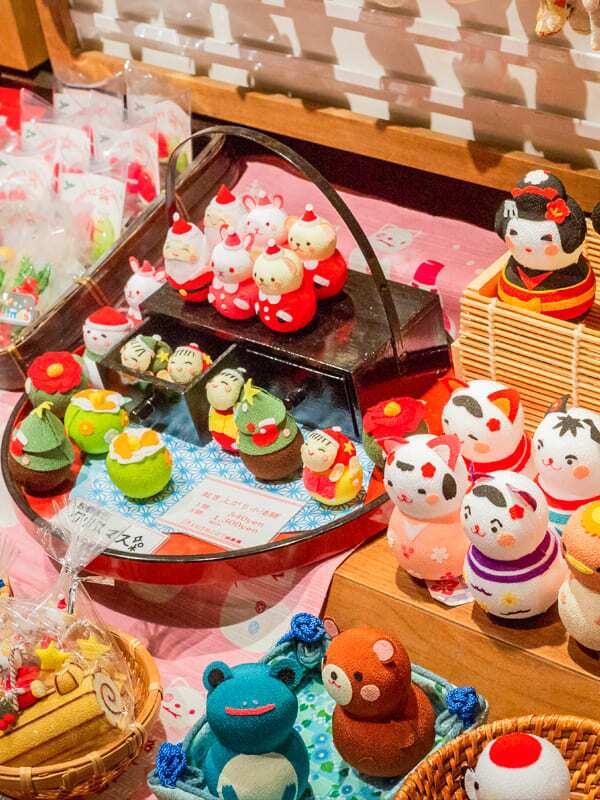
- 7-Day Japan Cherry Blossom Tour 2025: Essential Springtime Mini-Group Tour
- 7-Day Tokyo, Kyoto and Osaka Tour
- 8-Day Tokyo, Hakone, Kyoto, Hiroshima and Osaka Tour
- 9-Day Japan Highlights Tour
- 10-Day Japan Cherry Blossom Spring 2025 Mini-Group Tour
- 10-Day Tokyo, Yokohama, Hakone, Kyoto, Nara and Osaka Tour
- 11-Day Traditional Japan Tour
- 12-Day Classic Japan Tour
- 12-Day Tokyo, Hakone, Kyoto, Osaka and Himeji Tour
- 2-Week Highlights of Japan in the Cherry Blossom Season
- 16-Day South Korea and Japan Cultural Adventure Tour
- 16-Day Japan and China Discovery Tour
- How to Plan a Trip to China and Japan
- Plan a Japan Cherry Blossom Trip 2024/2025, Dates and Avoid Crowds
- Plan a Family Trip to Japan 2024/2025: Experiences and Itineraries
- How to Plan a Luxury Trip to Japan in 2024/2025
- Best (and Worst) Time to Visit Japan 2024, Cherry Blossom Time
- 1 Week in Japan: Top 5 Itineraries for First Visit 2024/2025
- 8 Days in Japan: Top 5 Itineraries for First Visit 2024/2025
- 10 Days in Japan: Top 5 Itineraries for First Visit 2024/2025
- 12 Days in Japan: Top 4 Itineraries for First Visit 2024/2025
- 2 Weeks in Japan:Top 5 Itineraries for First Visit 2024/2025
- 3 Weeks in Japan: Top 3 Itineraries for First Visit 2024/2025
- How to Plan a 2-Week Itinerary in Japan and South Korea
- Japan Weather in January: Travel Tips for First-Timers
- Japan Weather in February 2024: Travel Tips for First-Timers
- Japan Weather in March 2024: Travel Tips for First-Timers
- Japan Weather in April 2024, Travel Tips (for First-Timers)
- Japan Weather in May 2024: Travel Tips for a First Visit
- Japan Weather in June 2024: Coolest Summer Month, Travel Tips for First Visit
- Japan Weather in July 2024: Full of Festivals, Travel Tips for First Visit
- Japan Weather in August 2024: Travel Tips for First Visit
- Japan Weather in September, Travel Tips (for First-Timers)
- Japan Weather in October 2024: Travel Tips for First-Timers
- Japan Weather in November 2024: Best Autumn Month, Travel Tips
- Japan Weather in December 2024: Travel Tips for First-Timers

Jessie was amazing ! Everything from her level of English to her understanding of what we valued .
We had a good time exploring the city with Selinda!
Our guide lele is a wealth of information, Lele is very professional and very attentive to our needs. Lele is amazing. Lele got everything spot on. It probably helps that Guilin is a brilliant place to visit so Lele has great material to work with but that doesn't take anything away from how much Lele helped make it a great trip.
Our guide for Beijing was super knowledgeable and experienced and able to help us to achieve as much as we wanted within the time given. We had a fun time guided by him as he is also super humorous and you can see how he interacts with the vendors and people whom he comes by. Thank you for a very enjoyable time in Beijing and accommodating to all our needs!
Our China Highlight guide. Michael, was attentive, thoughtful and knowledgeable. He narrated many interesting historical events about Chengdu while touring around the city and having afternoon tea with us. He was thoughtful to provide us with snacks during long hikes at Leshan or walks around the city.
She was very flexible and added extra time when we needed it and we felt extremely well taken care of. She also chose the best restaurants for us,
Our tour guide Helen, was excellent, she was very kind, professional and passionate for her work and she also loves Pandas! She will take you to take the best panda photos and to know more about Chengdu city. Our tour was great, she took us to all our destinations always with the best spots: Temples, pagodas, famous streets, theaters, pandas...you name it! Everything was great.
He picked up our pre-booked boat/other excursions tickets so we were able to avoid all the long lines and chaos. He is knowledgeable of the places we visited, courteous, fun to travel with and well-versed in Chinese classics.
Tom is the guide that will take you to where no other guide will. We pushed for the experience and Tom and the team delivered more than what we could have ever asked for. His English speaking ability and his Chinese history knowledge is second to none.
More reviews
Get Inspired with Some Popular Itineraries
At Asia Highlights, we create your kind of journey — your dates, your destinations, at your pace. You can have any trip tailor made for your travel.
More Travel Ideas and Inspiration
Sign up to Our Newsletter
Be the first to receive exciting updates, exclusive promotions, and valuable travel tips from our team of experts.
Why Asia Highlights
Where can we take you today.
- Middle East
- African Safari

- Travel Agents
- Our Differences
- Privacy Policy

Address: Building 6, Chuangyi Business Park, 70 Qilidian Road, Guilin, Guangxi, 541004, China
Nomadic Matt's Travel Site
Travel Better, Cheaper, Longer
The Ultimate Japan Itinerary for First-Timers: From 1 to 3 Weeks

I’ve yet to meet a traveler who didn’t love their time in Japan . It’s just one of those countries that everyone loves. How can you not? The food is carefully crafted and delicious; the history and culture are both rich and long; the landscape breathtaking; and the people super friendly and polite.
Japan remains one of my favorite countries. No matter how long I visit, it’s never enough. I always leave wanting more.
But the country always seems forbidding to many travelers. It definitely still has that “exotic” stereotype that makes people think it’s hard to travel around.
Where should you go? What should you include in your Japan itinerary? Should you buy a JR Pass to help you get around?
To help you out, here are a few suggested itineraries based on my years of visiting that will ensure you see the best sites on your Japan trip — as well as get off the beaten path and get a real sense of Japanese culture!
Table of Contents
Japan Itinerary: Know Before You Go
Japan itinerary: one week, japan itinerary: two weeks, japan itinerary: three weeks.

Just be sure to get one BEFORE you go as you cannot purchase them on arrival. For more information on the pass, including how much they cost and how you can get one, read this blog post . It has everything you need to know!
Mobile Data in Japan In Japan, English isn’t widely spoken (especially outside of the major cities) so having access to the internet is vital for checking addresses, using translation apps, and looking up things to see and do. The easiest way to get data is through an international eSIM for Japan .
An eSIM allows you to access mobile data via a QR code so you can have internet wherever you are, without worrying about physical SIM cards or roaming charges. This will save you a lot of time and hassle when using apps like Google Maps, Google Translate, Instagram, and YouTube. It will also come in handy for checking menus at restaurants (since they are rarely in english).

Day 1 & 2: Tokyo Chances are you’ll be starting your trip in Tokyo , since it’s home to the country’s biggest international airport. If your trip is seven days long, activate your JR Pass right away, so that you can take advantage of the free JR trains that run through the city.
While you could easily spend your entire week in Tokyo and not get bored, here are some of the highlights:
Visit the fish market – Toyosu is the world’s largest fish market. The daily auction here powers much of the world’s sushi supply, and it is truly an absolute must-see! You can go for free, but food and drink tours of the Tsukiji Outer Market are available for around 14,500 JPY.
See Sensoji Temple – Sensoji is beautifully painted and sits in a scenic spot near a five-story pagoda and the famous Kaminari Gate. There’s a huge statue of Kannon, the goddess of mercy, inside the main hall. It’s always busy but is worth seeing with your own eyes. The temple is free to visit.
Drink in Golden Gai – This alleyway of back-street bars is a lively place to drink at night and has a bit of a red-light-district feel to it. It is not to be missed. Even if you don’t drink, be sure to wander about. Arigato Tours offers tours of the area where you’ll learn about the neighborhood while stopping to sample Japanese classics like sushi, yakitori, and ramen. Tours are 23,900 JPY and include a drink and dishes at four food stops.
Visit the Imperial Palace – The home of the emperor of Japan was built in the 15th century, and while you can’t go inside, the palace and its grounds are a peaceful place for a stroll.
Watch a sumo match – If you’re in town at the right time, this is a must-do . Tickets sell out quickly, so book early. Expect to pay around 11,000-13,000 JPY.
If you have more time, consider taking a day trip to Kamakura to see the giant Buddha statue (Daibutsu). It is over 13 meters (42 feet) tall and dates back to the 13th century. The journey is around 90 minutes each way — and free with the JR Pass !
For delicious food, some of my favorite bars and restaurants include: Uogashi Nihon-Ichi (Standing Sushi Bar), Nemuro Hanamaru KITTE Marunouchi, Motodane, Tokyo Whisky Library, Ichiran Shibuya, and Uohama.
WHERE TO STAY IN TOKYO : Hostel Chapter Two – A small, family-run hostel not far from Skytree Station in Asakusa. I really like the shared kitchen and common room, as there’s a real social feel to them.

With its beauty come lots of crowds though, so try to visit outside of the busy summer months. Even with lots of tourists, though, the city is still magnificent and has a lot to offer. Some things to see and do that you shouldn’t miss are the following:
Visit the Golden Pavilion – This famous (and picturesque) temple dates to the 1950s, when a monk burned down the previous temple (from the 14th century) while trying to commit suicide. It’s a UNESCO World Heritage Site and one of the most-visited destinations in the country!
Explore Gion – Gion is the historic geisha district. Stroll along the main street and see ochaya s (teahouses where geishas entertain), the small shops, and the many restaurants that line the district’s streets. You can take a walking tour of Gion for 1,800 JPY.
Wander in the Bamboo Forest – For a relaxing break, head to Arashiyama and let the calm swaying of the forest envelop you. Located near the famous Tenryu-ji temple, it’s one of the most beautiful places in the entire country. Arrive early if you want to enjoy it without the crowds. Kyoto Bike Tours offers an early-bird bike tour for a guided way to do just that.
Admire Ryoan-ji temple – This is my favorite temple in Kyoto. It’s a UNESCO World Heritage Site and home to a mausoleum that houses the remains of seven emperors. The traditional rock and sand garden is considered one of the best in the country.
For a half-day trip, you can also visit Nara. It’s a small city just one hour from Kyoto. Nara was the capital of Japan in the eighth century, so there are lots of buildings and temples here that are upwards of a thousand years old (which is rare in Japan, due to fires, as well as World War II). But the real draw in Nara are the deer.
Since the 17th century, those in and around the city have been considered sacred. You can buy crackers to feed them or just watch them stroll around carefree. A guided half-day walking tour that includes all of Nara’s highlights as well as a traditional lunch is 11,500 JPY.
While you’re here, don’t miss a visit to Todai-ji. It’s the world’s largest wooden building and is home to a 16-meter (52-foot) Buddha statue. It was built in 738 CE and is now a UNESCO World Heritage Site. Admission is 600 JPY.
WHERE TO STAY IN KYOTO : Backpacker Hostel K’s House – A fun, social backpacker hostel in a great central location. The rooftop terrace is a cool spot to hangout and meet other travelers after a day of exploring.

Don’t miss Osaka Castle though. While it’s not the original (this version dates to 1931), it’s nevertheless an impressive sight. It’s home to a small but insightful museum and an observation deck that offers some picturesque city views.
And be sure to stroll down Dotonbori (ideally at night), the main street, which is lined with restaurants, stores, and tons of neon lights and signs. A guided walking tour that includes Dotonbori as well adjacent neighborhoods is 6,500 JPY.

Today, Hiroshima is thriving . Don’t miss the Atomic Bomb Museum, which depicts the history of the city before and after that fateful day. It has photos, artifacts, videos, and information about the effect of radiation on the population. It’s a sobering experience but one that should not be missed.
If you feel like getting out of town afterward, head to Miyajima , an island that offers a place to hike and enjoy nature. You can also take a cable car to the peak of the mountain to take in the view. A one-way ferry ride to the island takes 10 minutes and is free to JR Pass holders.
WHERE TO STAY IN HIROSHIMA : Roku Hostel – A cozy, small hostel with a rustic atmosphere and design. It feels like you’re staying with a friend here, and the beds are super comfy too.

If you like history, don’t miss the Hida Minzoku Mura Folk Village, home to a collection of traditional thatch-roof houses that you can enter to further immerse yourself in the country’s past.
This city (and region, really) is famous for its Hida beef, a high-fat variety that’s even better than any A5 Wagyu you might have. It just melts in your mouth. Be sure to have some while you are here!
The Japanese Alps are not far from here as well, so if you love hiking and want to extend your time in the region, head to Kamikochi for a day hike or overnight trip. It’s just an hour away and has both easy and moderate trails, which are open from April to November. Hiking trails can also be found in Hakusan National Park (also just one hour away by car).

One of the more unique temples in Japan is here too: Ninja (Myoryuji) Temple. While the temple wasn’t home to actual ninjas, Myoryuji was built as a defensive structure (strict laws forbade local lords from building defenses, so they were hidden in the temple to circumvent the rules). These include hidden rooms, secret tunnels, and a maze of staircases and halls to confuse enemies.
If you need a break from exploring cities, Hakusan National Park, home to Mount Haku, one of the three holy mountains, is just an hour south of town.

If you’re here in April, there are incredible cherry blossom displays that are famous in the region. And, just like Takayama, Matsumoto is close to the Japanese Alps, so you’re just a stone’s throw from some of the best hiking in the country.

There are tons of hotels (both modern and traditional) that have their own hot springs (often both indoors and outdoors). It’s the perfect place to wrap up a trip, relax, and take in the views.
In addition to getting a copious amount of R&R, be sure to ride the cable car up the mountain for even more amazing views. The area is surrounded by craters from an inactive volcano that erupted 80,000 years ago (not to be confused with nearby Mount Fuji, which is an active volcano), and you’ll find lots of vendors at the top selling eggs cooked in the sulfurous waters. It’s said the eggs prolong one’s life by seven years, so feel free to give them a try!
If you prefer to hike up instead, the trail is open between July and September, with the trek taking anywhere from 5 to 12 hours, depending on your level of fitness. Typically, hikers leave at night in order to arrive at the summit by dawn. There are little shops along the way that sell food and even beds you can rent in advance if you want to split your journey up. Just make sure you do your research and prepare in advance as it’s a tough hike!
If you really want to play tourist, you can also ride a mock pirate ship around the lake for more views of the mountains, and Mount Fuji in particular.
Full-day tours around Hakone that include all the main sights cost 14,800 JPY.
WHERE TO STAY IN HAKONE : Hotel Green Plaza – With gorgeous views of Mount Fuji, a huge buffet dinner (with both Western and Japanese options), and a private onsen where you can relax and enjoy the view, this is one of the best places to stay in Hakone if you want value but don’t want to break the bank.

Using the suggestions above, here’s how I would organize your itinerary:
- Days 1-3 : Tokyo
- Day 4 : Mount Fuji or Hakone
- Day 5 : Takayama
- Days 6 & 7 : Kanazawa
- Days 8 & 9 : Matsumoto
- Days 10-12 : Kyoto
- Days 13 & 14 : Osaka
- Days 15 & 16 : Hiroshima

If you do want to spend a few hours in Hakodate, don’t miss the Morning Market, where you can find lots of fresh seafood. You can also visit Fort Goryokaku, the first “Western”-style fort in the country.

Be sure to stop in at the local Beer Museum too, owned by Sapporo Breweries (the oldest beer company in the country). It showcases the history of beer in Japan and how the business got its start. If you’re a whiskey fan, stop by The Bow Bar, home to some rare (and expensive) whiskeys and considered one of the best such bars in the world.
What I love about the city is its location. This region has some of the best hiking in the country. There are plenty of hills and mountains, offering options for both day hikes as well as overnight trips. Some highlights include Mount Me-akan, Mount Asahim, Mount Mashu, and Nishibetsu-dake. For the best views of the city, head to Mount Moiwayama. It’s just a 30-60-minute hike to the top, though there is a cable car you can take as well.
And if you’re visiting in the winter, hit the slopes! There are over a hundred ski resorts in Hokkaido. You can rent skis (or a snowboard) for around 10,000-18,000 JPY. Lift prices are usually 4,000-6,000 JPY per day. In the winter, don’t miss the annual Sapporo Snow Festival. It’s held every February and draws over two million visitors. There are ice sculptures, igloos, live music, and delicious local foods on offer.
Additionally, be sure to take a day trip to Otaru, where you’ll find some of the freshest uni in the whole country (this is the main area where the famed Hokkaido uni is caught). Go hungry and visit the markets, stalls, and shops around there.
WHERE TO STAY IN SAPPORO : Waya Hostel – This is a laid-back, colorful hostel with a social atmosphere that makes meeting people a breeze. It has a homey, DIY feel and is perfect for budget travelers looking for a no-frills place to crash.

There is a ton to see and do in Japan , and you could easily spend another month here and still just scratch the surface (we didn’t even get to Okinawa and the islands!). And while these itineraries are a bit fast-paced, Japan isn’t cheap, so budget travelers need to move around the country quickly to avoid breaking the bank.
But no matter how long you visit, you won’t be disappointed. Japan is an amazing, beautiful, and unique destination that I never get tired of visiting. While it’s not as affordable as its neighbors, there are still plenty of ways to save money , and it’s definitely worth spending the time (and money) visiting. You won’t be disappointed!
Just make sure to get your Japan Rail Pass before you go!
Book Your Trip to Japan: Logistical Tips and Tricks
Book Your Flight Find a cheap flight by using Skyscanner . They are my two favorite search engines, because they search websites and airlines around the globe, so you always know no stone is left unturned!
Book Your Accommodation You can book your hostel with Hostelworld as they have the most comprehensive inventory so they are best for booking a hostel. If you want to stay in a hotel or guesthouse in Japan, use Booking.com as it consistently returns the cheapest rates for guesthouses and hotels.
Don’t Forget Travel Insurance Travel insurance will protect you against illness, injury, theft, and cancelations. It’s comprehensive protection in case anything goes wrong. I never go on a trip without it, as I’ve had to use it many times in the past. My favorite companies that offer the best service and value are:
- Safety Wing (best for everyone)
- Insure My Trip (for those over 70)
- Medjet (for additional evacuation coverage)
Looking for the Best Companies to Save Money With? Check out my resource page for the best companies to use when you travel! I list all the ones I use to save money when I travel — and I think they will help you too!
Be sure to check out the Japan Rail Pass if you’ll be traveling around the country. It comes in 7-, 14-, and 21-day passes and can save you a ton of money!
Looking for More Travel Tips for Japan? Check out my in-depth Japan travel guide for more ways to save money; information on costs; tips on what to see and do; suggested itineraries, reading, and packing lists; and much, much more!
Got a comment on this article? Join the conversation on Facebook , Instagram , or Twitter and share your thoughts!
Disclosure: Please note that some of the links above may be affiliate links, and at no additional cost to you, I earn a commission if you make a purchase. I recommend only products and companies I use and the income goes to keeping the site community supported and ad free.
Related Posts

Get my best stuff sent straight to you!
Pin it on pinterest.
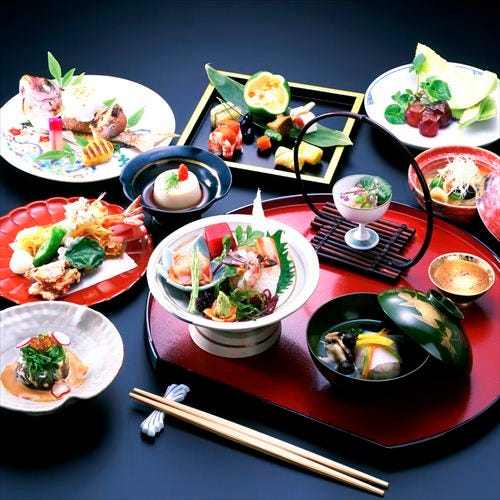
How to Plan a Trip to Japan: Ultimate Guide for First-Time Visitors
From culturally rich history, to cutting-edge technology, to foodie-worthy cuisine; Japan truly has something for everyone. It should come as no surprise then that it is currently rated as one of the most visited countries in the world. Until the pandemic, the number of tourists coming to Japan has grown steadily year after year, with 29 million visitors in 2017. With tourism at an all-time high, how can you prepare in advance to make the most out of your vacation to Japan?
Why You Should Plan Your Itinerary Ahead of Time
How to make an itinerary, finding the best time of year to visit, how to handle finances in japan, what to pack for your trip, eat like a local, useful words and phrases, what apps should i download before traveling to japan check out these 8 free useful apps.
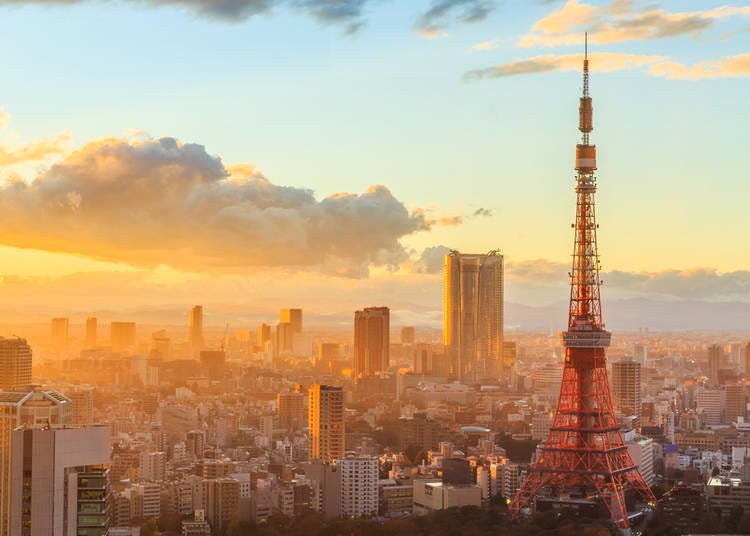
There are many places in the world that you can visit for one to two weeks and feel as though you have a good sense of the culture and way of life by the time you return home. Japan is not one of those places. It’s impossible to “do” Japan in a lifetime; let alone a two-week vacation. With so much to see, it’s easy to become overwhelmed once you find yourself in the middle of it all. Having a well laid-out itinerary - or at least a fairly solid idea of spots you'd like to go and when - will help to ensure that you are able to do what matters most to you during your time here. One of the worst experiences when visiting somewhere while on a limited amount of time is to travel out of your way for something specific; be it a famous tourist attraction or a particular restaurant, only to discover that it is not open. Many attractions in Japan operate on a seasonal basis, and it is not uncommon for restaurants to be closed on certain days of the week. In order to avoid disappointment, research schedules beforehand and make reservations in advance whenever possible. As an added benefit of researching and planning early, you can often find discounts or free admission days for many popular attractions. The money saved on tickets can then be used for other parts of your vacation. After all, who wouldn’t love a little extra money in the sushi budget?
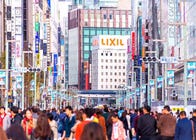
The first step to creating an itinerary begins with one question; “Why did I want to visit Japan in the first place? Maybe you’re a history buff that wants to walk in the footsteps of famous figures like Oda Nobunaga. Perhaps you have a fascination with Japanese architecture and dream of visiting temples dating back over 1,300 years. Or maybe you’re in love with modern Japanese media and culture and want to see where it all began. Whatever the reason, knowing what initially drew you to Japan can make planning your perfect trip much easier. Of course it’s possible to plan a vacation as widely varied as your interests, but having a focus is helpful. ・ Enjoy eating? If you love gourmet, you’ve chosen the perfect destination. Japan is a foodie’s paradise and is home to some of the top chefs in the world - plus its food culture goes back over 400 years. While many tourists tend to immediately think of sushi , Japanese cuisine is so much more diverse. Experience all of the tastes that Japan has to offer; from hole-in-the-wall ramen shops to gourmet fine dining restaurants.
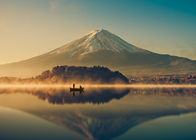
・ Enjoy sightseeing? From gorgeous landscapes , to ancient temples , to futuristic city streets; Japan has it all. Within Japan’s most popular tourist region, Kanto, there is no shortage of incredible places to visit. Below are some of the more popular destinations to help you start planning your sightseeing trip, all within easy reach of Tokyo: -Sensoji Temple As Tokyo’s oldest temple , Sensoji is a must-see for any visitor to Japan. Its towering pagoda and famous red lantern are iconic Tokyo sights that should not be missed. - Tokyo Skytree At 634 meters tall, the Tokyo Skytree provides the best panoramic views of the city. A visit to the top observation deck is the perfect way to take in the truly impressive scale of Tokyo. -Tosho-gu Shrine In Kanto’s northern prefecture of Tochigi, the town of Nikko looks like something straight out of a Studio Ghibli film. Nestled amongst the lush green mountains is a shrine by the name of Toshogu. Adorned with countless wooden carvings, its stunning decoration and serene surroundings make it one of the most beautiful temples to visit in Japan. - Hakone Nature lovers will find solace in Hakone with its abundance of rolling hills, lakes , and scenic Mount Fuji views. The town is also famous for its high quality onsens, making it the perfect spot to relax. -Sankeien Garden Just slightly south of Tokyo, the city of Yokohama is home to many sights that are worth visiting during your time in Japan. One such destination is Sankeien Garden . In addition to the picturesque flowers and bamboo groves, Sankeien is perhaps most famous for its architecture . Historical buildings from around Japan, including a massive three-story pagoda from Kyoto, have been painstakingly relocated from their original location to their new home in the garden . It’s an amazing opportunity to explore classical architecture of many of Japan’s regions all in one area. ・ Enjoy historical places ? Japan is a country filled with rich, historical experiences. In Tokyo, the Imperial Palace is a popular destination among tourists, as is the Edo-Tokyo Museum in Ryogoku , in the eastern part of the city. For travelers who cannot make it to Kyoto, the historical area of Kamakura (and especially the Daibutsu, its Great Buddha) makes for the perfect day trip away from Tokyo. Other historical areas in the nation include the cultural capital of Kyoto, and ancient area of Nara . ・ Love shopping? Shopaholics will find everything they can dream of and more in Japan. Visit the Ginza area in Tokyo to browse some of the best high-end clothing and accessory retailers in the world. In nearby Yokohama , Akarenga is a trendy shopping center right on the water, located in a renovated red brick warehouse. Those looking for a more traditional Japanese market experience in Japan's western region will find it in Kyoto’s Nishiki Market, where you can find everything from fresh fish, to handmade lanterns, and so much more.
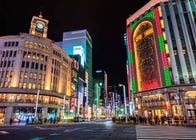
How Long Should You Stay Once you have an idea of what you would like to see, you should next determine how much time to spend in each area. It’s a terrible feeling to leave somewhere feeling as though you missed out on essential experiences. Likewise, staying in one location for too long to the point where you become bored with your surroundings is a waste of time which could have been better spent exploring new areas. Thankfully, the internet is filled with reviews for any place that you are likely to visit; from quiet countryside villages to bustling Tokyo neighborhoods. Make a list of “must-do” activities for each area of Japan to which you intend to travel, and research what fellow travelers have to say about their experiences there. Knowing how long it takes to visit or travel between certain attractions can help you to make the most efficient use of your time. Based on data from the Japan National Tourism Organization, most American tourists spend between 7 to 13 days traveling throughout Japan. During that time, the most visited locations tend to be Tokyo, Kyoto, and Osaka. Of course there is no one-size-fits-all approach to travel, especially in a country as diverse as Japan, so consider this data more of a suggestion rather than a firm guideline.

Planning Your Route The next step in putting together a successful itinerary is figuring out how you will get from place to place. When it comes to Japan; a country famed for its incredibly well-connected railway system, the train will be your most likely means of day to day transportation. However, it’s important to plot a carefully thought-out route. While it’s possible to travel across the country by train, this will often require switching to different railway lines along the way. As you will come to find, these changes can only be done at certain train stations that act as hubs. When deciding in which order you will visit each destination, first consult a railway map to ensure your route doesn’t require you to needlessly double back. When planning a route, you should also take ticket prices into consideration. In Japan, train fare is based on the distance you are travelling. If you intend to spend most of your time in one area, this most likely won’t be an issue for you, but if you are planning to take the train often or travel across the country, purchasing a rail pass may be in your best interest. Within Tokyo, day passes may be purchased which will give you unlimited access to JR Line or Tokyo Metro trains for a 24 hour period at one fixed price. If you intend to do a great deal of sightseeing around the city, purchasing one of these passes might be in your best interest. While these passes cover only the Tokyo area, an additional option for travelers is the Japan Rail Pass, which allows for unlimited travel throughout the country on the Japan Railway network in blocks of 7, 14, or 21 days. These passes are not cheap; starting at around ¥29,110 (about $260 USD), but they do grant you access to shinkansen lines as well; Japan’s ultra-fast bullet trains. If you are planning to travel long distances; from Tokyo, to Kyoto, and beyond for instance, this pass could be well-worth the investment. Be aware however, that these passes can only be purchased from outside of Japan, so be sure to purchase it well in advance of your trip to ensure you receive it in time.
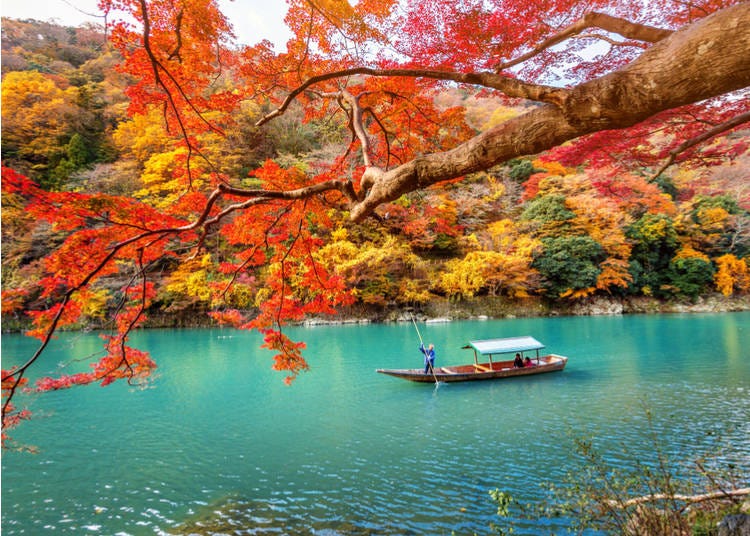
When it comes to choosing what time of year you should visit Japan, there is no one correct answer. Sure, there are more popular seasons when tourism tends to be at its highest, but each season comes with its own positive and negative aspects. Decide what factors are most important when it comes to your vacation before booking your trip. Summer ■ Pros ・Excellent beach weather. Summer in Japan often means sunny days and high heat; the perfect conditions for a day out by the water in locations like Okinawa . ・It is the most active time of year for events and art exhibits. ・ Summer is matsuri (festival) time. There is perhaps no better way to experience Japanese culture than at a traditional matsuri . Enjoy games and delicious street food and watch as the locals carry mikoshi; portable shrines carried like a parade float, through the streets. ・Cities are slightly less crowded this time of year as locals tend to go on vacation to other countries or more remote parts of Japan. ・Many popular attractions will offer summer discounts, helping you to stretch your vacation budget a little further. ■ Cons ・ Summer in Japan is infamous for its heat and oppressive humidity. As it stands, 2018 has seen some of the highest temperatures in Tokyo in recorded history. When the heat is at its peak, outdoor activities can be become unenjoyable to downright impossible. ・Though cities in general tend to be less crowded with locals gone on vacation, tourism is still high this time of year, meaning you can expect larger than average crowd sizes at the most popular tourist attractions. ⇒ Browse seasonal articles on Summer in Japan Fall ■ Pros ・Once the summer heat breaks, the temperatures in fall are very comfortable. ・Areas such as Hokkaido and Tochigi are renowned for their beautiful fall foliage. ・As the seasons change, so does the cuisine, with seasonal favorites like sweet potato and kabocha (Japanese pumpkin) taking center stage. It’s a great time of year to sample dishes that are less widely known outside of Japan. ■ Cons ・The changing temperatures from summer to autumn is the catalyst for typhoon season in Japan. High winds and torrential rain are not uncommon at the start of fall. ・The unpredictable weather can make it difficult to pack for your trip. ⇒ Browse seasonal articles on Autumn in Japan Winter ■ Pros ・Japan is home to some of the best skiing and snowboarding terrain in the world due to its amazing powdery snow quality. ・Japan’s outdoor hot springs , known as onsen , are much more enjoyable in cold weather with the added aesthetic of falling snow. ・As the holiday season approaches, many cities across Japan decorate with spectacular LED light displays known simply as illuminations. No two displays are alike and many decorate with a specific theme each year. ■ Cons ・Though the Kanto region and all areas south rarely see snow, winters in Japan tend to be incredibly dry, which comes with its own series of discomforts like dry skin and chapped lips. ・Daylight hours are much shorter in winter , with the sun typically setting by 4:30 PM. ・Travel tends to get quite congested at the end of the year with many people heading home for the New Year’s holiday. ⇒ Browse seasonal articles on Winter in Japan Spring ■ Pros ・ Spring is the time for cherry and plum blossom viewing; one of the most popular tourist attractions in all of Japan. ・Japan’s gorgeous countryside is at its most lush and full this time of year. ・Much like fall, temperatures tend to be on the comfortably warm side throughout the season . ・Late spring , after cherry blossom season has passed, often sees less tourism, so crowds at shrines and other popular attractions are much smaller on average. ■ Cons ・Due to the high number of visitors who want to see the cherry and plum blossoms, early spring is by far the busiest and therefore most expensive time of year to travel to Japan. Expect the price of flights and accommodations to be much higher than normal. ・With the blossoming flowers comes an overwhelming wave of pollen. If you are an allergy sufferer, prepare to be congested. ・Japan’s rainy season takes place in late spring . During this time, high humidity and unexpected downpours are the norm. ⇒ Browse seasonal articles on Spring in Japan It’s hard to go wrong visiting Japan at any time of year, but by selecting the season that most closely aligns with your interests, it can help to make your vacation as enjoyable as possible.
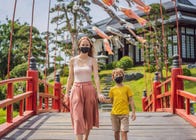
As technologically advanced as Japan is, it has a tendency to cling to certain old-world methodologies, as is evident in their inexplicable love of the fax machine. In the same regard, cash is still king in the Japanese economy. While many restaurants in bigger cities will accept credit cards, it is not uncommon to come across businesses, especially those in more remote areas of the country, which deal only in cash. That being the case, you should never go out without some paper money at the ready. The Best Ways to Handle Your Money When it comes to having access to physical yen, you have a few options at your disposal. You can exchange a certain amount of money with your bank back home before traveling to Japan, use local ATMs to withdraw yen, or use one of the many currency exchange offices located throughout Japan. The latter is by far the least cost effective option of the three, so I recommend not using this method unless absolutely necessary. Instead, let’s examine the first two. Exchange Your Money Before Leaving Many banks offer very competitive currency exchange rates if you are an account holder. This is not a bad route to take, as you will have cash at your disposal from the moment your plane touches down in Japan. The only drawback to this solution however is that you will be travelling with a large amount of physical money. Despite the fact that Japan has been rated as one of the 10 safest countries in the world, it’s never a good idea to carry excessive cash with you while traveling. Unlike debit or credit cards, once it’s lost, it’s lost for good. Withdraw Cash in Japan Rather than bringing your entire vacation budget with you in cash, you could instead opt to withdraw cash while in Japan. Many ATMs in convenience stores and post offices throughout the country accept foreign debit and credit cards for a small fee. Be aware though that your bank will typically charge a global transaction fee (usually 3-5% of the amount withdrawn) on top of this. The fees tend to add up over time, but the added security may be worth the cost. If you decide to use this option, be sure to contact your bank before you leave to inquire about their rates as well as to notify them that you will be using your card overseas. Otherwise, your bank will most likely flag the transaction as fraud and will lock your account, leaving you without access to money.
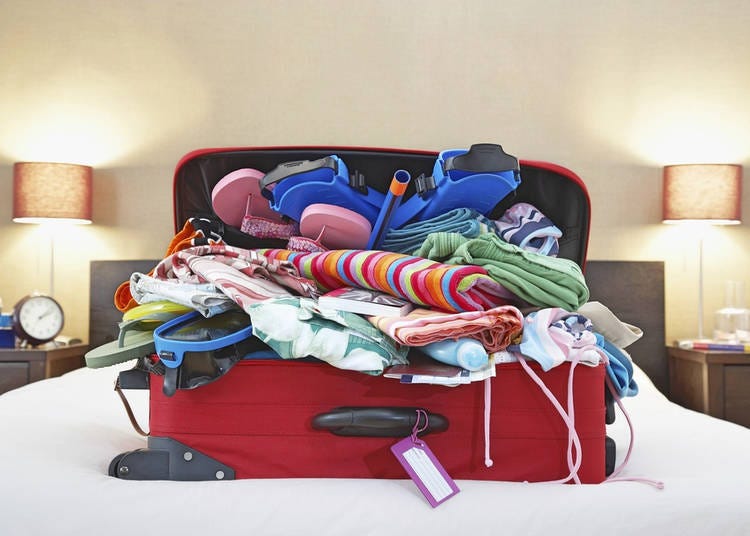
With any vacation, people often struggle with what to pack. With such varied weather and activities, putting together a packing list for Japan can be a daunting task. Thankfully, it doesn’t need to be as complicated as it seems. Clothes After reviewing the pros and cons of each season above, you should have a better idea of what time of year you will be visiting Japan. Other than the extreme heat of summer , temperatures in Japan are mild overall, so you can plan to leave the extreme weather gear behind unless your planned activities call for it. A lightweight jacket or sweatshirt will typically suffice in spring and fall, and a slightly warmer jacket or layers should be fine for winter . As far as style, typical Japanese fashion could be described as casual chic , so don’t feel pressured to dress to impress. Electronics If you are reading this from the United States, you are in luck; outlets in Japan are the same as in the US. Three-pronged outlets are not common however, so you may want to pack a three prong to two prong adapter. While the outlets are the same, the voltage they supply is different, with 100 volts in Japan compared to 120 volts in the United States. However, most modern chargers for cell phones, laptops, and other electronic devices will have a built-in convertor to automatically adjust the power as needed. To be safe, always make sure to check the label on the charger to determine the voltage range it can handle. If the device is not rated for 100 volts, a voltage adapter will be needed. For those travelling from countries with different outlets, inexpensive universal plug adapters can be purchased online or from most electronic stores. Toiletries When it comes to toiletries, there is no need to panic and overpack no matter how long you intend to stay. Japan is home to some of the top beauty and personal care brands in the world, so you are almost certain to find the same brands or suitable alternatives to the ones you use at home. For the sake of convenient packing, always opt for travel-sized versions of your favorite toiletries and replace them as needed while on the go.
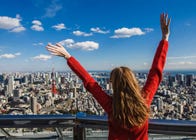
When asked to picture Japanese food , most people will instinctively picture sushi , and understandably so. This iconic and colorful staple of Japanese cuisine is a globally recognizable (albeit often locally modified) dish. Upon visiting Japan however, you will come to find that Japanese cuisine is much more widely varied than is often represented abroad. Signature Dishes In order to get a true taste of the local flavor, the following foods are a great representation of traditional Japanese foods that are still easy on more westernized palettes. Soba / Udon Udon and soba noodles are very common in the Japanese diet and can be found in most restaurants. Udon is the thicker of the two and tends to have a nice chewy texture with a very mild taste. Soba is thinner; similar to a flat spaghetti noodle, and usually has a richer, nutty taste. Both can be served hot in soups, but are more commonly served chilled with a broth for dipping on the side. This is a great summer option to help beat the heat. Okonomiyaki Equally at home at both street festivals and fancy restaurants, okonomiyaki is a traditional Japanese dish that is great for sharing with friends. At its most basic level, okonomiyaki is essentially a large, savory pancake filled with your choice of an assortment of ingredients and topped with a sweet and salty sauce. For the full experience, visit a dedicated okonomiyaki restaurant where you can cook your own on a hibachi grill built into your table. Yakiniku Literally translated as “grilled meat”, the premise of yakiniku is a simple one, but the delivery and atmosphere are what make the experience special. Rather than ordering a meal which is then cooked by the kitchen, in yakiniku restaurants, you order cuts of meat which you then cook for yourself at your table. This may seem like a lot of extra work to many visiting foreigners not familiar with the concept, but the cookout atmosphere it creates makes for a great experience to be shared with friends. In most yakiniku restaurants, items can be ordered à la carte, or tabehoudai style, which is all you can eat for a fixed amount of time. Nabe A favorite amongst sumo wrestlers, nabe is a hearty soup often eaten in the colder winter months. Nabe is a great dish to experiment with, as there is no strictly defined recipe and many restaurants will serve their own signature style. Typically, a variety of meats, fish and vegetables are placed in a broth and cooked in a large clay or porcelain pot. Once heated, the cooked ingredients are picked out and eaten. The remaining broth is then finished with udon noodles or poured over rice to make a rich, flavorful porridge. Food allergies in Japan can be slightly difficult to navigate in a foreign language, so if there are any foods you absolutely must avoid, it’s recommended that you find the Japanese name and have it printed on a card that you can present to your server.

Outside of major cities, finding people who can speak English becomes a major challenge for many visitors. Even in major metropolises like Tokyo, many locals won’t be able to communicate in English beyond a handful of basic phrases. While no one would expect visiting tourists to be fluent in Japanese, having a few commonly used Japanese phrases at the ready will go a long way in helping you to communicate while here. Sumimasen Pronounced sue-me-mah-sen. This is a very common phrase in Japanese vocabulary and translates to “excuse me” or “pardon me”. This is helpful to use when you are trying to get someone’s attention or if you bump into a stranger on the train. Gomen Nasai Pronounced go-men-nuh-sigh. Sometimes used interchangeably with sumimasen, gomen nasai means “I’m sorry”, and should be used for situations where you have accidentally done something rude such as spilling a drink or blocking someone on the sidewalk. Arigatou Gozaimasu Pronounced ah-ree-gah-toe-go-zigh-ee-moss. This is a phrase you will hear often when in shops in restaurants, meaning “thank you very much”. If memorizing the full phrase is proving to be a bit difficult, a simple “arigatou” will suffice, though it is considered much more polite to use the whole phrase. Konnichiwa Pronounced co-knee-chi-wah. This is the most basic greeting used in Japanese. While technically intended to be used during the afternoon hours, it can be said as a basic polite greeting at any time of day. While this is just the tip of the iceberg when it comes to useful words and phrases in Japanese, they will serve as a great starting point for your daily interactions with locals. When in doubt, speak slowly and use a lot of gestures. Charades is a great way to communicate with people from all over the world.

Modern technology has made it easier than ever before to visit locations where you don’t speak the language. By using a local sim card or a data plan that allows for international roaming, the following apps will help to ensure that your trip goes as smoothly as possible. 1. Google Translate By far one of the most helpful apps when it comes to international travel, Google Translate makes reading menus or railway maps a breeze. It’s most useful feature is undoubtedly its ability to translate from a photo or live feed from your smartphone’s camera. With this, making sense of Japanese characters needs not be an overwhelming task. Be sure to download the Japanese language pack before you leave to avoid any sort of service interruption. 2. Google Maps When used in tandem with Google Translate, Google Maps is guaranteed to get you where you need to go. This app works particularly well with trains as well, listing departure and arrival times, as well as platform numbers when available. 3. Currency Converter As the Japanese yen typically deals in much bigger numbers than those who use US dollars or euros are accustomed to seeing, it’s a good idea to download a currency convertor. This way, you can be confident in the amount of money you are spending and can avoid paying too much in certain situations. 4. Line When it comes to digital communication in Japan, Line is the undisputed champion. As the most commonly used VoIP service in the country, Line gives you the ability to message and call other Line users for free. This is immensely helpful in the event that you need to contact a local person (Airbnb host, etc.) or just keep in touch with family and friends back home without paying expensive international roaming fees. 5. Gurunavi It’s almost impossible to be bored in Japan. With so much to see and do, it can often be difficult to sort through it all and find something that appeals directly to your interests. Gurunavi helps to alleviate that stress by finding events, restaurants, attractions and more throughout Japan, and filtering the results to present you the ones you are most likely to enjoy. 6. Japan Official Travel App As the official app of the Japan National Tourism Organization, this app is packed with helpful information from travel articles, to train schedules, to general rules regarding manners and much more. The app is available in English, Chinese, and Korean, and offers assistance both on and off-line. 7. Smart EX With the Smart EX app by JR, you can reserve Shinkansen tickets while you're on the go. And when reserving at least 3 days in advance, you will even receive a discount on certain lines! Check the website below for details. https://smart-ex.jp/en/ 8. Yurekuru Earthquakes are a common part of Japanese life, but for visitors, they are often a jarring experience. Yurekuru is a helpful app that can better prepare you by issuing a warning when an earthquake has been detected. Though the window of time between detection and feeling the effects of the earthquake is relatively small, having any amount of forewarning can make the experience a bit less scary.
With a bit of preparation and planning, you will be well on your way to a fantastic vacation in Japan. Have a schedule you can follow, but be sure to leave yourself open to all the wonderful and unexpected experiences Japan has to offer as well.
Written by:

Matt Vachon
Matt Vachon is a content creator in Tokyo who enjoys exploring off the beaten path locations around Japan. Graduated from the University of Massachusetts before moving to Japan. Since that time, he has created content for numerous tourism focused publications including The Japan National Tourism Organization, Tsunagu Japan, and Tokyo Localized. Holds a bachelor's degree in psychology. He is passionate about filmmaking and has been working on documentaries about Japan. During his downtime, he's often indulging his inner foodie by trying out some of the best hidden gem restaurants in Tokyo. Website: https://mattvachon.com. Instagram: @mattvachonphoto.
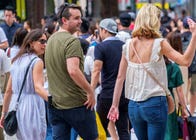
- Category Other Sightseeing
- How To: Sightseeing
Share this article.
Limited time offer: 10% discount coupons available now!
Recommended places for you.
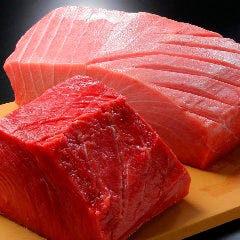
Kamesushi Sohonten
Umeda, Osaka Station, Kitashinchi

Jukuseiniku-to Namamottsuarera Nikubaru Italian Nikutaria Sannomiya
Kobe, Sannomiya, Kitano

The Tokyo Station Marunouchi Building
Tokyo Station
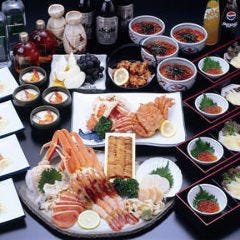
Rukku and Uohei
Sapporo / Chitose

Yoshida Gennojo-Roho Kyoto Buddhist Altars
Nijo Castle, Kyoto Imperial Palace
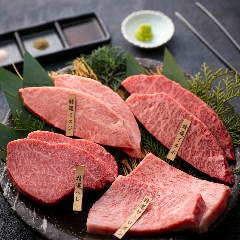
ISHIDAYA Hanare
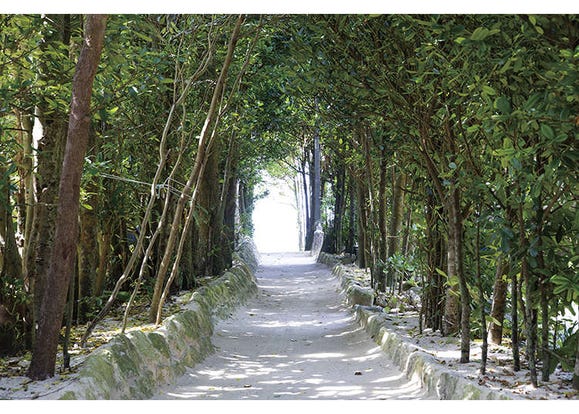
Eco-Friendly Adventure in Okinawa! Discover Motobu Town's Charm with 'Motobu Story Quest'

12 Unique & Fun Tokyo Food Tours to Enjoy in 2024
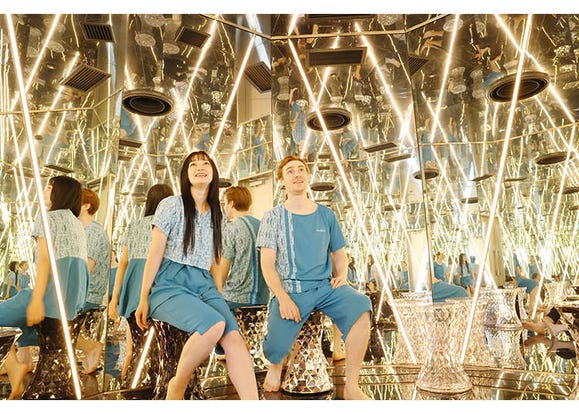
Complete Guide to Tokyo Dome City: A Day-Long Adventure Near Tokyo Station, Akihabara, and Shinjuku!

Discover Osaka Station City: A Journey Through Its Most Fascinating Spots
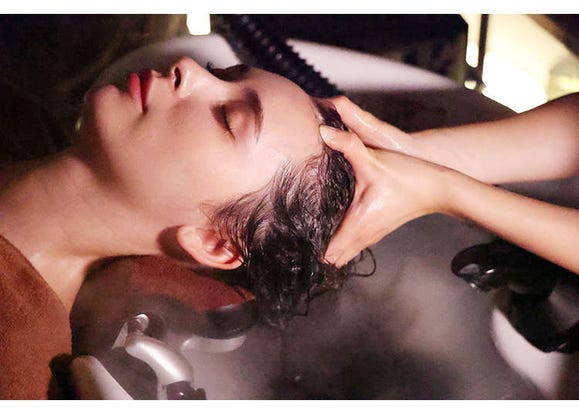
Revealing Look at HEAD SPA Kuu: The Japanese Head Spa With Global Acclaim

Where to Eat in Shibuya: 14 Must-Try Restaurants for Yakiniku, Sushi, Izakayas, Cafes and More
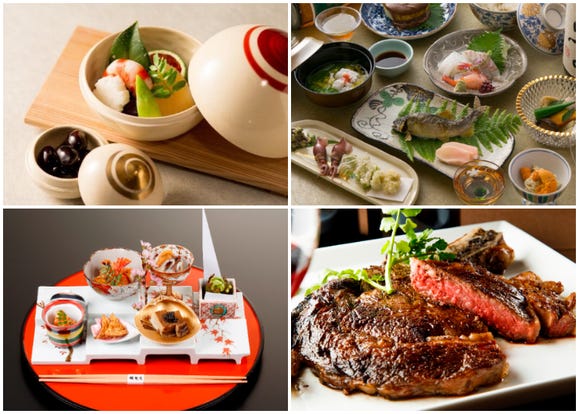
Where to Eat in Kyoto: Best Kyoto Foods to Try & The Tastiest Shops of 2023
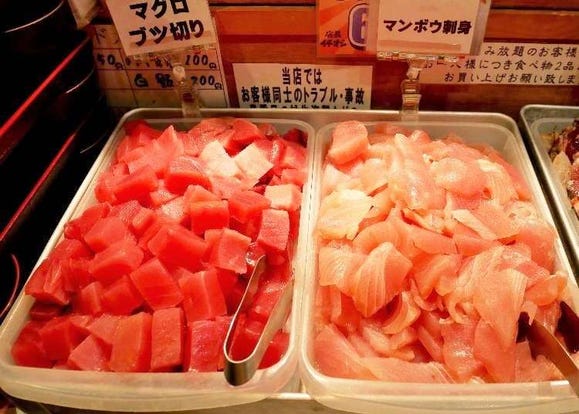
Numazuko Kaisho in Ueno: Good Quality, All-You-Can-Eat Seafood for Just US$12!?
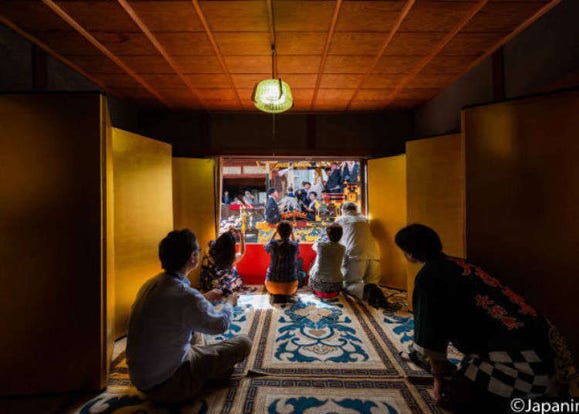
Life in Osaka: We Interviewed International Residents About Their Life in Kansai
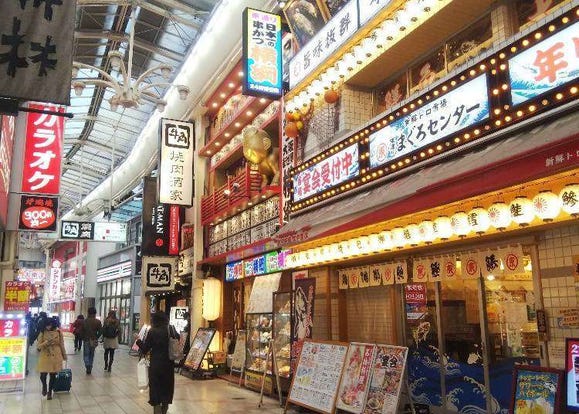
5 Popular Things to do in Umeda - Osaka's Central Area!
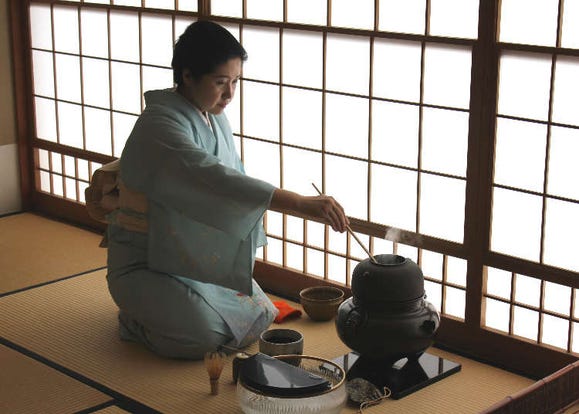
Experiencing Japanese Culture Firsthand: Authentic Tea Ceremony & Taking On Japanese Cooking!
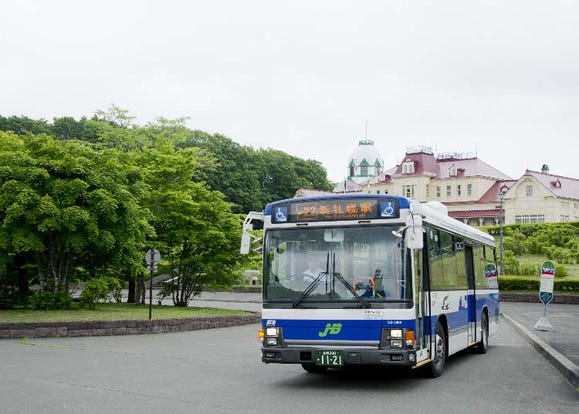
Getting Around Hokkaido: 6 Best Hokkaido Bus & Train Passes
- #best sushi japan
- #what to do in odaiba
- #what to bring to japan
- #new years in tokyo
- #best ramen japan
- #what to buy in ameyoko
- #japanese nail trends
- #things to do japan
- #onsen tattoo friendly tokyo
- #best coffee japan
- #best japanese soft drinks
- #best yakiniku japan
- #japanese fashion culture
- #japanese convenience store snacks
- Work with Me
- Start a Blog
- Yearly Roundups
- 101 in 1001 Goals
- how to start a travel blog
- tips for new bloggers
- write me a guest post!
- Work With Me
A Passion and A Passport
Proving Travel is Possible with a Full-Time 9-5
10 Days in Japan: A First-Timer’s Complete Japan Itinerary
last Updated: March 7, 2024 hiroshima japan kyoto miyajima nara osaka tokyo
FYI: Affiliate links may be sprinkled throughout the awesome, free content you see below. I’ll receive a small commission when you purchase from my links (at no extra cost to you), which I’ll totally blow on adult things like boba tea and avocado toast. As always, thanks for the support.
Looking for the best way to spend 10 days in Japan? You’re in the right place!
Continue reading for tons of first-hand tips, recommendations, and a complete 10 day Japan itinerary, which can easily be turned into two weeks in Japan if you’ve got a few more days. I absolutely LOVED my time in the country, and with some proper planning, I can guarantee you will too.

Japan is over-stimulating and over-whelming in the best way possible. An absolute thrill to the senses.
From the shiny bright lights of Tokyo’s Akihabara District to the serene temples and zen gardens in Kyoto , Japan is a country where the past and the future collide more than you initially realize.
I can promise you that every bite of food will be better than the last, and you’ll be saying oishi (“delicious” in Japanese) during every meal.
If you can visit during cherry blossom season, you’re in for a real treat – the streets will be lined with the most beautiful bunches of white and pale pink flowers you’ve ever imagined, which in turn makes the country smell absolutely phenomenal.
Japan is quite literally the most fascinating country I’ve explored to date. (And I just hit my goal of 30 countries by my 30th birthday a few months ago!) #killingit
I’d love to spend more time in Japan, and am highly encouraging everyone I know to discover this little piece of Asia sooner than later. So today, I am sharing with you my 10 day Japan itinerary, all heavily researched (for hours!) before my trip and followed pretty much to a T.

Overview of this 10 Day Japan Itinerary
When I initially started planning my trip, I was worried that 10 days in Japan wouldn’t be enough. Thankfully, I proved myself wrong and was able to see and do oh so much , as well as stuff myself silly with all those Japanese snacks I had heard so much about. [Spoiler alert: bring stretchy pants.]
The country is filled with so many fascinating areas, but 10 days in Japan will give you enough time to see the highlights. To be completely honest, this Japan itinerary is rather jam packed, yet highly efficient (I promise!), although I suggest slightly modifying it if you’d like a more relaxed trip or are traveling with kids.
While we’re at it, check out all my travel planning tips right over here!

This Japan itinerary starts in Tokyo , makes a day trip to either Kamakura, Nikko, or Hakone, then ventures south to Kyoto , with day trips to Nara, Osaka, Hiroshima, and Miyajima Island. Distances really depend on the mode of transport you use, with bullet trains being the fastest.
- Days 1-3 : Tokyo
- Day 4: day trip from Tokyo
- Days 5-6: Kyoto
- Day 7 : Nara and Osaka
- Day 8 : Miyajima and Hiroshima
- Day 9 : morning in Kyoto → Tokyo
- Day 10: Tokyo in morning/afternoon → airport
Japan is a decently large-sized island country located in Eastern Asia, being slightly smaller than California . Rest assured, the entire country is connected via trains. In my experience, Japan may have the most efficient and well-connected public transportation system in the world (and that’s coming from someone who spent their childhood riding the extensive New York City subway).
Despite holding the title for the 10th most populated country in the world (aka: it’s crowded), you can still find some peace and solitude in the many gardens and temples located just about everywhere.
Pre-Travel Guide to Japan
Where to get the best flight deals to japan:.
I swear by Skyscanner and Google Flights , and always always always use these two sites when looking for airfare. The option to watch prices and get email notifications are top notch and one of my favorite features of the two.
Always check budget airlines that may not be listed, especially if you are coming from other areas in Asia with shorter flight times. A great list of budget airlines can be found here .
For reference, we flew premium economy on China Airlines with a short layover in Taipei for about $1200 round trip from San Francisco – during Easter and cherry blossom season – but I saw deals for under $800 in coach. [I’m not complaining about the upgrade that my husband insisted on buying, but know that cheaper flights are out there.]
If you’re coming from the East Coast USA, flights will be a bit more expensive but shouldn’t be more than $500 more or so.

Where to stay:
In an effort to keep things simple (and avoid changing accommodation every night or two – what a pain!), this itinerary will have you staying in 2 main areas (Tokyo and Kyoto).
I highly advise booking accommodations near centrally located train stations in each as it’ll be easiest for the day trips mentioned in the 10 day Japan Itinerary below.
I opted to stay near Shibuya Station in Tokyo, as it’s centrally located and easy to reach other districts. In Kyoto we stayed near Kyoto Station as we were taking a bunch of day trips and wanted to be able to walk to our accommodation easily after a long, busy day on the road bullet train.
- Luxury: Cerulean Tower Tokyu Hotel
- Mid-Range: Shibuya Excel Hotel Tokyo
- Budget: Shibuya Tokyu Rei Hotel
- Check out other hotels in Tokyo here.
- Luxury: Hotel Granvia Kyoto
- Mid-Range: Kyoto Century Hotel
- Budget: Rihga Royal Hotel Kyoto
- Check out other hotels in Kyoto here.
- Yado Kiramachi
- Kyoto Takasegawa Bettei
- Muromachi Yutone Kyokoyado
Airbnb is also a great option and a good way to save some money if you’re spending a few nights in one spot (always check the cleaning and booking fees, as these can greatly increase the price should you only need a 1-night stay).
New rules regarding Airbnb rentals were implemented in June 2018, and now listings must be registered and display a license number on their booking page. Thankfully all current listings on Airbnb are compliant (the company removed any which failed to register in 2018), so you can be sure your booking is absolutely legit.
While I’d love to recommend the Airbnbs we stayed in during our trip to Japan, they are no longer available. However, there’s tons more to choose from – just check out the Airbnb website .
First time using AirBnB? Sign up with THIS LINK to get $30 off your first stay!
When to visit:
There’s never a horrible time to spend 10 days in Japan, but each season has their pros and cons.
Spring : If you’re hoping to see the ever-so-beautiful cherry blossoms, April is your best bet. That being said, it’s also the month most people visit Japan for that very reason. I visited in early to mid-April, and while yes it was crowded, the beauty of the cherry blossoms found throughout the country was well worth it.

Fall : Autumn is another wonderful time to visit Japan, as you’ll get to experience the vibrant fall colors (bright red leaves) from September to November.
Summer (June to August) is hot, humid, and rainy (although the rain tends to dissipate in early July), while winter (Dec-Feb) is generally cool, sunny, dry and great for snow-sports in the mountains.
Note that weather varies dramatically throughout the country, so be sure to plan accordingly especially if you visit higher altitudes.
Read Next: When to Visit Japan (Weather, Seasons, Festivals, and Crowds)

How to get Japanese Yen:
I highly advise you to NOT exchange your money at a currency exchange kiosk before or after you land as you won’t get the best rates. Instead, take out local currency (Japanese Yen) at the airport via ATM machine.
If you travel quite frequently, consider applying for a Charles Schwab bank account. The company refunds any and all fees associated with foreign transaction ATM withdrawals. You’ll pay no ATM fees anywhere in the world, including your home country. It’s what I’ve been using for years and it’s saved me 100’s in unwanted pesky fees.
Surprisingly, considering it’s crazy-advanced technology and all, Japan is mostly a cash society; yes, we were exceptionally wowed by that! Expect your credit card to get rejected at most places (especially small eateries and of course street-food stands) and be sure to carry enough Yen with you.
If you’re coming from the US, an easy way to figure out USD to JY is to move the decimal point two spots to the right >> 100Y = approximately $1USD. Just for quick reference, 10,000Y = approximately 100USD.

How to Get Around Japan:
If you’re visiting Japan from elsewhere in the world (i.e. you are not a resident of Japan), you are able to purchase a JR train pass for varying amounts of time. The JR pass gives you access to all of the trains, most Shinkansen lines (bullet trains), the ferry to Miyajima, and a few other transportation lines. Options include 7-day, 14-day, and 21-day.
I used a 7-day JR pass during my trip, and I highly advise you to do the same if you’ll be following this 10 day Japan itinerary. The Green Car option, while a bit more expensive, is JR’s version of “first-class” and most definitely worth it in my opinion. Note that it does not cover all bus routes/lines and some local trains, but these only cost about 100-300Y ($1-3USD), so no biggie.
If you plan on using a JR pass, you NEED to purchase it before you enter the country . Once you arrive in Japan, there is no option to buy it. And when I say no option, absolutely NO option at all.
Once you purchase the pass (which must be done outside of Japan) you will receive a voucher in the mail (within a few days) which you will then exchange upon your arrival in Japan at a designated JR ticket booth in major train stations.
Buy your Japan Rail Pass here (it’s the company I used and our voucher arrived promptly in the mail). There was free delivery straight to our home which I greatly appreciated, and once in Japan we saved a ton of money on the Shinkansen (high-speed bullet train), and breezed through the JR rail stations like a boss.
I can’t imagine doing Japan any other way than with a JR Pass. Check out the options (standard and green pass) here.

UPDATE — Buying a JR Pass in Japan : The Japan Rail Pass be will sold at a higher price point and on a trial basis in Japan through October 1, 2023 at major stations and airports. However, if you know you’ll be using one, miiiight as well save a bit of money and purchase it beforehand from a trusted company . There’s really no reason not to.
The public transportation system in Japan is top-notch, and although extremely overwhelming (at first, trust me), it’s by far the best (and most cost effective) option for getting around throughout the country.
Electricity and Power in Japan:
Japan uses the same 2-pronged electrical outlets as found in the USA. If you’re coming from America, note that some electrical devices use a three-pronged plug.
It’s also important to understand that the amount of voltage is different and you’ll need a converter (different than an electrical adapter) to change the amount of electricity pushed to each device if you plan on bringing anything which uses an excessive amount of power (including hair dryers, curling irons, and/or straightening irons).
If you don’t want to worry about this, I suggest you invest in dual-voltage devices made especially for travel like this dual-voltage blow dryer , dual-voltage mini straightener , and this dual-voltage curling iron .
Using a Pocket Wifi Router in Japan :
If you’ve done any research on Japan, you probably came across something called Pocket Wifi . What is it exactly and why should you consider getting it for your trip to Japan?
Pocket Wifi is exactly as it sounds — a small portable device that you can keep in your pocket (or purse/backpack/day bag) that provides wifi to all your devices (cell phone, iPad, computers, etc). And the best part? One Pocket Wifi will power up to 10 devices, so you can share the same Pocket Wifi with your family and friends.
Since wifi is less common in Japan than in other countries (surprising, right?!), this handy little device does wonders! You will be able to find free wifi in your hotel/ryoken, Starbuck locations around the city, and some other restaurants, but I always recommend having your own, especially if you’re visiting any smaller cities. Do note that some ryokans and older hotels might only have LAN cable internet access, instead of wifi, so you’ll definitely want a Pocket Wifi there!
You’ll use wifi on your phone for just about everything in Japan — train schedules, getting around, translating important phrases, making FaceTime calls to family, etc. You don’t wanna be without it when you need it!
And they make it so super easy — the Pocket Wifi will be delivered straight to your hotel in Japan! Once you’re done with your trip, use the convenient prepaid envelop to return your router from any address in Japan. Couldn’t be simpler than that!
Check out the benefits and purchase your Pocket Wifi here. Honestly, a life saver!
Useful Japanese Phrases:
- Hello/Good Afternoon: konnichiwa
- Good bye: sayonara
- Delicious: oishi
- Thank you: arigatō
- Please: kudasai
- Where’s the toilet: benjo wa doko desu ka?
- Does anyone speak English? Eigo no hanaseru hito wa imasen ka

Packing tips for Japan:
Clothing : Seaso ns are kind of temperamental in Japan, and you may be wishing you brought different clothing. Therefore, I highly suggest you pack layers for your trip to Japan. An umbrella (cute ones here , here , and here ) and light raincoat (like this or this one ) are recommended as well.
We encountered much more rain during our 10 days in Japan than we had originally planned for, and I’m glad I brought along a raincoat. If you don’t want to stuff a coat in your luggage, consider bringing along a poncho just in case.
Electricity and Power : As noted above, most of Japan’s electrical outlets are the 2-pronged “Type A” type (100 Volt, 50-60 Hz).
If you have a device with a 3-pronged or European/UK-style plug, you may need a travel adapter (for all devices) and power converter (for high powered devices like a hair straightener or blow dryer).
Pack comfy shoes that are easy to take off. You’ll need to slip off your shoes at various temples, at the airport, at ryokans, and some restaurants. My favorite ones here (on sale), here , and here .
I also suggest bringing along socks if you don’t want to go barefoot… These sushi socks are quite cute and perfect for the occasion… 🙂
Small throwaway bags for garbage. You won’t find many garbage cans around Japan in general, and it’s expected that you keep your trash on you until you can throw them away. Keep a small bag in your purse/backpack for this purpose. A small foldable tote is perfect for this, and can be used for spontaneous shopping trips.
Pack light. Navigating Japan is much easier when you have a small suitcase, especially since Japanese trains (and train stations) do not cater to travelers with a lot of luggage. In addition, there’s not as many elevators or escalators as you might wish, so remember, you may be carrying your luggage up and down a few flights of stairs.
I recommend traveling with a small rolling suitcase (one that fits in the overhead bin on an airplane like this one or this one ) and a backpack (I have this one and love it).
Stay organized with packing cubes , which also help you fit more into smaller suitcases (I’m able to fit about a months worth of summer clothing using packing cubes and packing strategically).
Language : If you’re up for it, you can also consider taking along a small Japanese Phrase Book . The language is quite difficult, and Google Translate (which won’t work without wifi or a cell plan) saved our butts far too many times.
Japanese written language uses characters, which you’ll see all over the place. Thankfully, most signs are written in phonetics using the alphabet we use.
We were also surprised by the low number of people who speak any English. Save yourself some frustration and pack a lightweight phrase book in your bag. Interested in learning some Japanese before your trip?
This book looks like loads of fun, and I’m actually thinking of buying it before my next trip back to the country. (The Japanese language is difficult you guys, just trust me.)
Travel Insurance for Japan
Yes, you need this. I always recommend purchasing travel insurance before your trip. You never know what might happen (flight delays, lost baggage, illness), and travel insurance definitely helps with all of those unfortunate unexpectancies.
I highly recommend the companies World Nomads and SafetyWing . I’ve recently been buying coverage with SafetyWing since they cover pandemic-related costs (which most travel insurance companies do not do).
Whenever we travel, we always buy a short term plan (depending on how many days/weeks we’ll be away) before leaving for any trip! Even if you don’t end up using it, peace of mind is 100% worth it in my opinion.
Find plan options and pricing here (and at only a few bucks a day, there’s no excuse not to!) I always say, if you can’t afford travel insurance, you can’t afford your trip. It’s that easy.
Buy your travel insurance now — don’t wait until it’s too late!
10 Days in Japan: A Complete Japan Itinerary
And now, the fun part! The 10 day itinerary in Japan!
Day 1: Arrive in Tokyo!
You’ll most likely be flying into Narita Airport and will need a little over an hour to get into the city center via the Narita Express. After such a long flight (with lots of time difference), it’s best not to plan much on this first day – hello, jetlag!
I suggest exploring the area you’re staying in (my suggestions: Shibuya or Akihabara) and devouring your first Japanese dinner of either ramen or pork Katsu.

During my stay, I opted for an AirBnB in Shibuya , which has an epic nightlife with tons of stuff going on, restaurants included (even if “partying” isn’t your thing- it sure ain’t mine!). Use this first afternoon/night to relax and rest up, as the rest of this itinerary will be go-go-go!
Day 2: FULL DAY IN TOKYO (West Side)
Today’s all about modern Tokyo ! You’ll be exploring the western districts of the city, including Shibuya, Harajuku, and Shinjuku – just saying these names are fun! You can either walk from district to district as they are fairly close together, or buy single use train tickets to hop between each.
DO NOT USE YOUR JR PASS YET as it will expire before you finish needing it later on during the trip. Train tickets within Tokyo are not very expensive, and you won’t be needing many today anyways!
Stop 1: Shibuya

If you opted to stay in Shibuya, you won’t need to take a train here! Shibuya is Tokyo’s version of Times Square , and with all the bright lights and massive amounts of people, it’s easy to see why. Be sure to check out the world-famous Shibuya Crossing , where 100’s of people scramble across the street at once.
For the best view above, head to Starbucks (you’ll need to order something before going upstairs), or find the Keio Inokashira Line at Shibuya Station for another perfect view.

Also say “Hello” – or Konichiwa — to Hachiko (the most loyal dog in the world statue) at Shibuya Crossing and do some shopping at Tokyu Hands .

Meiji Shrine shouldn’t be missed as well, which is the Shinto shrine that is dedicated to the deified spirits of Emperor Meiji and his wife, Empress Shōken. You’ll be seeing lots of shrines and temples during your time in Japan, and Meiji is a great one to start with!
If you’re lucky, you may even witness a traditional Japanese wedding ceremony! I, however, was not so lucky.
Stop 2: Harajuku
If you want to get a taste for Japanese street style, visit Harajuku. On Sundays, you can see traditional Harajuku Girls dressed in elaborate costumes and anime – so fun! Try and spot the girl in the photo below all decked out in costume. If you can’t make it on a Sunday, you can get a feel for Japanese street style any day of the week.
You can reach Harajuku by taking the Yamanote line to Harajuku Station, although it’s not a far walk from Meiji Shrine.

Walk down the famous shopping street of Takeshita Dori , where you’ll find a whole mess of fun stores and fun cafes. Note that most shops don’t open until 11am, but if you’re following this itinerary, you’ll probably arrive here around 1pmish or so.
Be sure to try a crepe – the unofficial street food of Harajuku, which you’ll find all over Takeshita Dori! We also visited a hedgehog café and played with them for about 45 minutes or so. A super quirky and super weird area, definitely not meant to be missed!
Read Next: Top Things to do in Harajuku

Stop 3: Shinjuku
Shinjuku is the largest neighborhood in Tokyo (dubbed the crazy entertainment district), and you’ll find thousands of restaurants, shops, entertainment, and other attractions that you could easily spend all day here.
With limited time, we spent a decent portion of the afternoon and night here and felt that was sufficient enough to see the highlights.

Many people opt to see the ever-so-popular Robot Restaurant , which I’ve heard is an other-worldly experience, but after reading reviews, we decided against it. Do your own research and decide for yourself whether this show is worthy of your time and money.
Whether you decide to spend part of the evening at the Robot Restaurant, I highly encourage you to make a visit to Omoide Yokocho , commonly known as Piss Alley.
Piss Alley is a small network of alleyways along the tracks northwest of Shinjuku Station filled with dozens of tiny eateries serving ramen, soba, sushi and yakitori. Just pick one with open seats and go in – they’re all worthy of some stomach real-estate.

Consider the free observation deck on the 45th floor of the Tokyo Metropolitan Government Building , visit Shinjuku Gyoen (a large public park near Shinjuku Station being a perfect cherry blossom spot – check on hours, we missed the entrance by about 20 minutes 🙁 ), and find an epic view of the area from the pedestrian overpass near the northwest corner of the Shinjuku station.

Day 3: FULL DAY IN TOKYO (East Side)
Now it’s time to experience the more traditional side of Tokyo , including Sensoji Temple and Ueno Gardens. Another bird’s eye view can be seen today, at nearby Tokyo Skytree.
If you’re staying in Shibuya like I did, you’ll need to take the train from Shibuya Station to Asakusa Station (35-45 min on train) via the JR Yamanote Line to Ginza or Asakusa Line. Make sure to purchase single tickets – do NOT activate your JR pass yet!
Asakusa and Sensoji Temple

Asakusa is the spiritual heart of Tokyo and a good place to start your day! Sensoji Temple is the main attraction here, and you’ll start your morning journey at the Kaminarimon Gate .
As you walk toward the temple buildings, check out the historic Nakamise Dori shopping street, pick out some souvenirs and grab a Japanese snack (or two!) before exploring Sensoji Temple.
Consider drawing Omikuji (written fortunes) while here. If you’re up for it and are interested, check out the surrounding old-fashioned neighborhoods around Asakusa.

Sumida Park and Tokyo SkyTree
If you’re visiting during cherry blossom season, I highly advise you to visit Sumida Park , which is an absolutely wonderful spot to see the flowers in bloom! It was one of the least crowded public parks we went to and FULL of cherry blossoms!
I cannot recommend this spot enough! Bring a snack or two and sit on a blanket for the ultimate experience. We got sakura donuts from Mister Donut (located all around), and ate our flower-themed treats amongst the cherry blossoms.

Next up – Tokyo SkyTree , the tallest tower in not only Japan, but the entire world! At 634m (2,080 feet), the complex has two observation decks with great views over the city. There’s even a glass floor for any of you brave souls! Expect a cue, so plan on spending a bit of time here. The Tokyo Skytree is about a 20 minute walk or a 5 minute train ride from Asakusa.
If you don’t wanna wait in line, I highly encourage you to book your skip-the-line Tokyo SkyTree ticket in advance. You can even upgrade to include the Tembo Galleria.

End the afternoon at Ueno Park , another large public space located in central Tokyo and another lively cherry blossom spot. There are more than 1000 cherry trees of multiple varieties lining its central pathway and lots of temples and shrines here to check out, as well as museums and a zoo if those are of interest to you.
You’ll most likely want to take the JR train from Tokyo SkyTree to Ueno Park.

Akihabara District
Wake up because we’re off to Tokyo’s crazy Akihabara District! Spend the evening perusing the many electronic shops, including Yodobashi Akiba – the world’s largest with nine stories stuffed with hi tech equipment – for geeks with money.
You’ll also find Japan’s diehard fan anime culture here, with stores devoted to anime and manga; just be sure to keep kids away from the adult-only sections (I wondered at first why all the anime was butt naked)!
You could easily fill up a whole afternoon and night in Akihabara, from its maid and Gundam cafes, gaming centers (check out Super Potato Retro Shop if you want to be transported into the 90’s), and just gazing at the bright lights.

Day 4: DAY TRIP from Tokyo — 3 Options
Today you’ll activate your JR pass and start putting it to use! Now that you’ve explored Tokyo, get out of the busy city center and explore another nearby area. There are numerous day trips you can take from Tokyo , and depending on your interests, you may want to visit more than one!
Unfortunately this ten day Japan itinerary only allows for one, but if you have another day or two to spare, you could easily do all three.
I opted for Kamakura because of the rainy and cold weather, but I would have loved Nikko or Hakone had the weather been more cooperative that day. With two weeks in Japan, you can most definitely do all three if you’d like.
Here are my three recommended day trips from Tokyo:
1) Kamakura

Don’t miss the Great Buddha of Kamakura (at Kotokuin Temple), easily the most popular attraction in the area, and literally hard to miss at 44 feet. Here you’ll find the second largest Buddha in all of Japan.
Another site not to miss, and only a few minute walk from the Great Buddha – the Hase Dera Temple , which is a beautiful temple located on a hillside overlooking the ocean.

There’s also a bamboo forest at Hokokuji Temple , similar to that in Kyoto, and it’s possible to see Mt. Fuji on a clear day from Kenchoji Temple.
Once you’ve had your fair share of temples, or are just hungry for some lunch, head on over to Komachi-dori , the busiest commercial street in Kamakura. Try the local specialty of Shirasu-don , (a Whitebait rice bowl), which you’ll easily find in numerous restaurants on the busy street.

Not interested in venturing to Kamakura alone and prefer a group tour? Looking back, I wished I booked a tour. Although it wasn’t too far away, we got a bit confused on the train and wasted a bunch of time trying to navigate our way to Kamakura, and then even more time once we arrived.
Many of the tours include other highlights like a tea ceremony and a view of the Bay, which we missed by going alone. I recommend these (from Tokyo) which cover all the top attractions:
- Full Day Trip to Kamakura, Yokohama, and Tokyo Bay (from Tokyo) : Not only does this day tour from Tokyo take you to all the highlights of Kamakura, but you’ll also get to have lunch in Yokohama’s bustling Chinatown, visit the traditional Japanese-style sunken garden of Sankei-en (including tea rooms!), and admire the modern cable-stay Yokohama Bay Bridge.
- 5 Hour Nature and History Walking Tour: This walking tour follows a hiking route from Kita-Kamakura to Hase-dera Temple, passing many historic temples and shrines. You’ll be able to enjoy some wonderful panoramas from a hiking trail that offers views in all directions. Note that transportation is not included.
Literally sick of the city and need to get some nature into your life? Nikko may just be your answer. Full of ancient moss, stone lanterns, vermillion gates, and towering cedars, there’s a reason why this area is one of Japan’s most visited areas.

Located about two hours north of Tokyo, Nikko is the site of the famous Toshogu Shrine , the mausoleum of Tokugawa Ieyasu (VIP in Japan), and numerous other temples and shrines. Don’t miss the famous Shinkyo bridge , the beautiful Nikko National Park (on a sunny day), Kanman-ga-Fuchi Abyss, and Kegon Falls .
I’m quite bummed we didn’t make it here as all the photos look absolutely spectacular, but now I’ve got another reason to return to Japan!

Trying to fit in a lot during your one day in Nikko? Consider a group tour which gets you around easily to all of the highlights.
Day Trip Options here:
- From Tokyo: Nikko World Heritage Full-Day Tour : Explore the beautiful mountain landscape of Nikko, Japan, experience the majesty of the Tamozawa Imperial Villa, bow to the three golden Buddah’s at the Rinnoji Temple, explore the surrounding landscape with a trip to Kirifuri Falls, and have a relaxed Japanese lunch at a local restaurant.
- Nikko: Autumn Leaves and World Heritage Full–Day Tour : Discover the beautiful autumn leaves and world heritage of Nikko. During your full-day tour by air-conditioned coach, visit Nikko’s natural sights, Senjo-gahara and Kegon waterfalls, and Nikko Toshogu Shrine. Perfect during those autumn months!
If you have more than 10 days in Japan, check out these additional day trips from Tokyo .
If seeing Mt. Fuji is on your bucket list, then I definitely recommend making the day trip to Hakone.
Once arriving, you have a whole slew of options to fill your day, including the Hakone Tozan Cable Car for stunning views, the Hakone Ropeway for even more epic views, Owakudani with views of Mt. Fuji on a clear day, and a small Buddhist alter.
You can also take a Hakone Sightseeing Cruise and spend time at the Hakone Open Air Museum (art gallery). Brave? Try a black egg!

If you’re not up for heading to Hakone alone , there are numerous day trips from Tokyo that leave the transportation and planning up to someone else. You’re on holiday – treat yourself and save yourself the hassle! I recommend the followings tours:
- From Tokyo: Mt. Fuji and Hakone Day Trip by Shinkansen : Spend a day trip traveling to Mt. Fuji, Japan’s most famous symbol and highest mountain. Enjoy the view from the 5th Station before visiting the nearby resort town of Hakone, known for its onsen hot springs. Return to Tokyo by bullet train!
- From Tokyo: Mt. Fuji and Hakone Tour with Bullet Train : Get spectacular views of Mt. Fuji and its surrounding mountains on a day trip from Tokyo. Cruise across Lake Ashi by boat and take the ropeway up Mt. Komagatake. Relax in the hot springs resort of Hakone, and then catch the bullet train back to Tokyo.
However, note that seeing the mountain is never guaranteed and it’s possible you may make the trip only to be disappointed. Some months out of the year have higher chances of visibility, including the winter months. If it looks like a questionable morning with lots of clouds, I highly suggest you alter your plans and opt for either Nikko or Kamakura instead.
Day 5: MORNING BULLET TRAIN TO KYOTO then EXPLORING
First Bullet Train Ride!

*Note that you’ll be required to make a seat reservation if you have opted for the Green JR Pass. Make this reservation when you first exchange your JR voucher for a ticket, or the night before leaving for Kyoto. Don’t wait until the morning of because it’s possible the reservation desk will not be open yet.
Get up nice and early, grab some breakfast in the station/on the way to the station, and take a 7:00/7:30am bullet train from Tokyo Station (you may need to transfer at Shinagawa Station) in route for Kyoto!
If you take this early morning train ride, you’ll arrive in Kyoto around 10:30am or so, which is necessary if you want to see a bunch of Kyoto sites today. Once you arrive in Kyoto, put your luggage/bags into a coin locker (roughly 500-900 Yen for two suitcases for the entire day) and get exploring!
A note about Kyoto’s public transportation: Unlike Tokyo, Kyoto relies on large public buses. We were unaware of this and unfortunately caught off guard when we couldn’t take fast trains to get around. Give yourself some extra time as it’ll take longer to get around. Embrace it – look outside the window on the bus and take in some local Kyoto life.
Arashiyama Area
Catch the bus to the Saga-Arashiyama Station , where you’ll be hanging out for a few hours. First up, Tenyru-Ji Shrine and its accompanying zen garden. So many beautiful plants and flowers (nicely labeled in both English and Japanese) here, such as the Japanese wisteria, which you’ll never see outside of Japan.

Once you exit the garden, you’ll come across the Arashiyama Bamboo Grove/Forest . Walking through the Bamboo Grove is definitely one of the essential experiences to have in Kyoto so don’t pass it up!
The grove is much smaller than I thought, taking roughly 15 minutes to walk through, but is absolutely excellent for photography.
Walk through slowly to take it all in, and don’t forget to look up at the towering bamboo! Bring a wide-angle lens and if possible, a go pro, in order to include as much of the bamboo in your photos!

Before you head to the Monkey Park (coming up next!), you’ll most likely come across a lovely area with small eateries and a beautiful, green emerald lake. A good spot for some photos in my opinion! 🙂 We enjoyed a few vending machine coffees and teas here (you’ll be doing that everywhere in Japan too, you’ll see!).
Read Next: Top Things to do in Kyoto and Attractions

Next up, walk to the Iwatayama Monkey Park ! Yes, it’s about a 15-20 minute walk completely uphill to reach the park, but definitely worth it! Just be aware, the Google Maps directions to this attraction are wrong.
The entrance to the park is simply near the orange shrine gate at the south side of the Togetsu-kyo bridge. Look for a cartoon picture of a monkey and you’re golden!

The park is a nice change from the temples and shrines you’ll be seeing a lot of in Kyoto, and it’s so much fun to feed the monkeys for only 100Y. There’s also a wonderful view of Kyoto from up here.
Before anyone gets mad at those pictures of the monkeys “behind bars”, please know they are free to roam wherever they’d like throughout the park, and us humans are actually put in an enclosed area when feeding them. This is to protect both the animals and us.
We could have easily spent hours watching the monkeys and admiring the view, but off to the Golden Pavilion it was!
Golden Pavilion (Kinkaku-ji)

If you’ve got more time today, take the bus to the Golden Pavilion , which is super impressive and made entirely of gold! Reflected in the lake, it’s no wonder this is one of the top things to do in Kyoto.
Make sure to try some Japanese flavored ice cream here, such as green matcha and/or black sesame, my new favorite! It’s guaranteed to be crowded, but very, very worth it in my opinion.

*Don’t forget to head back to Kyoto Station to collect your bags before heading to your hotel or AirBnb for the night!
Day 6: FULL DAY IN KYOTO
Nishiki Market

Start the day at the Nishiki Market – known for its different food stalls where you can try all kinds of Japanese cuisine and treats.
Stroll for an hour or so up and down the streets of the market, stopping whenever something tickles your fancy. The market is a great place to dive into some of the more unusual dishes – don’t be a chicken, try them!

However, absolutely don’t leave the market without trying tako tamago – the infamous candied baby octopus stuffed with a quail egg. It tastes way better than it sounds – I could have eaten three!
Want a taste of those cutesy animal donuts you’ve possibly seen all over the internet? You can try them here – at Floresta Donuts . I had a hard time eating mine as it was just too cute to bite into! Quite possibly my favorite thing I ate during our 10 days in Japan! SO cute!

After your fix of Japanese delicacies and donuts, walk on over to Gion, Kyotos famous geisha district. If you’re lucky you may spot a real true-life geisha , although they tend to walk fast to their destination and don’t like to show their face.
However, if you do spot one, but courteous and don’t obviously follow them or point your camera directly to their face. Show respect for their culture. I wasn’t so lucky and didn’t spot any on my trip.
Higashiyama District
End the day at the Higashiyama District, the world famous hub of Kyoto’s best-known shrines and temples. And let me tell me, this place is worth checking out. It’s one of my favorite areas in all of Kyoto .

Make sure to walk down Sannenzaka and Ninensaka – the two most beautiful streets in the district, with numerous souvenir shops and eateries. It can get rather crowded during the day (for good reason!), so we chose to come a bit before dusk had encountered a less cramped experience.
Still cramped, but less cramped than I imagine mid-day would be. You’ll find some eats on the walk – make sure to try a sakura cream puff !

Kyomizu-dera Temple , a listed UNESCO site, should be next on your list. Again, it’s quite busy, but the view out over a sea of trees is hard to beat – just imagine this during cherry blossom season (absolutely to die for!) And yea, try an onigiri maki – an emoji in the wild!

Finish off this (long and tiring) day by walking part of the Philosopher’s Path (found on Google Maps as Tetsugaku-no-michi) , a path that runs along a narrow river and is lined with more cherry blossom trees than you can ever imagine!
You’ll end at the Silver Pavilion, although not as fancy and intricate as the Golden Pavilion, and not even lined in silver, but still impressive nonetheless.
Day 7: DAY TRIP TO NARA AND OSAKA
It’s time for some day trips today, and we’ll be crossing off two in one day’s time! Head to Nara from Kyoto Station (via JR Nara Line – roughly 1 hour on the express train), then after seeing some of the top temples, head on over to Osaka and eat everything!
Get ready to interact with some deer in Nara Park , which can be found all throughout the area and are literally impossible to miss! And oh yea, those crackers you see being sold on the street? Those are for the deer, not us hungry humans!

A few temples to see: Todaiji (must visit Unesco World Heritage Site with super tall Buddha), Kasaguga Taisha Shrine (the most important shrine in Nara), Kofukuiji Temple, and Gangou-ji Temple. If you’ve had enough of temples by this time, head over to Osaka and skip a temple or two.
Tip : Get the Nara Kotsu one day pass (it’s more of a wooden plague you can wear around your neck if you please) for 500 Yen. This sightseeing bus brings you around to the top attractions in Central Nara, and is good for most of the buses you see throughout the city.

Off to Osaka for the rest of the day! Many people skip Osaka as they think it’s just another large city like that of Tokyo, but we absolutely loved our few hours here! Don’t skip it!
First up, the ever-so-beautiful Osaka Castle , one of Japan’s most famous landmarks! Get off at Osakajokoen Station.
Note that the castle may very well be closed by the time you reach it depending on how long you spend in Nara (last admission is 4:30pm in April, a bit later in the summer months), but the outside alone is worth the train and short 20 minute walk!
Next up, Dotonbori Street ! It’s an absolute madhouse full of people, shops, and eateries, and an absolute must-do while in Osaka. Be sure to look up and admire the moving animal billboards found on the buildings.

Osaka is the food capitol not just of Japan, but of the entire world. Hence, you’ll want to eat everything in sight (just leave some room for a Kobe beef dinner). Try beloved regional dishes like okonomiyaki, takoyaki (fried octopus balls – tastes way better than it sounds), udon, and hiyashi ame ginger drink.

Rule of thumb: if there’s a long line, the food is out of this world. Wait and you’ll be rewarded.
If you want to get some shopping on, head on over to nearby Shinsaibashi, the city’s premier shopping district. We chose to skip the shopping and focused on stuffing our faces 😉
Great dinner suggestion: Tsurugyu. This place is all about Kobe beef , and is super fresh and decently priced. Expect to pay around 5,000Y per person, drink included. Reservations are highly recommended, although we somehow got extremely lucky and were able to sit at the bar – but don’t count on this!

Day 8: DAY TRIP TO MIYAJIMA AND HIROSHIMA
Get ready for another jam-packed day. Yes, it’ll take a while to get here, but trust me, on a clear, sunny day, it’s 100% worth it and absolutely beautiful.
Take an early morning bullet train to Hiroshima, which takes roughly 2 hours from Kyoto Station, then a local JR train to Miyajimaguchi Station, then finally the JR ferry to Miyajima. All included in your JR Pass .

You can choose to visit either Miyajima or Hiroshima first, but I highly recommend visiting Miyajima during high tide to see the gate “floating” in the water. Check tide schedules online.
If you opt for Miyajima first (again, tide dependent), and take an 8am bullet train out of Kyoto Station, you’ll reach Miyajima by approximately 11am.
Head straight to the tori gate (after some deer interaction of course, yes there’s deer here and they’re SUPER friendly, just watch your food).
You’ll want to snap a million photos because this place is just so damn beautiful it’s hard not to! You can also check out the floating shrine as well, which we loved and was unlike any other shrine/temple we saw in Japan!

Spectacular views your thing? Take the Miyajima Ropeway (~15 minutes, $17 roundtrip) for better-then-great views of the whole area from the top of Mt. Misen . There’s a bus at the base of Miyajima Island which will take you to the ropeway station fo’ free as well if you’re already feeling super tired from your journey.

Before heading back to the ferry, pick up some ice cream (green tea or black sesame, you are in Japan!) – perfect on a hot, sunny day.
Take the ferry back to Miyajimaguchi Station, then the JR train to Hiroshima. Note that you’ll need to either take a tram or buy a Hiroshima Sightseeing Hop-On, Hop-Off Loop Bus “Meipuru-pu” to get around in Hiroshima super easily – which is free of cost for JR pass users .
We took the sightseeing bus to Hiroshima Castle , and then to the area with the A-Bomb Dome , Children’s Peace Monument , and Peace Memorial Museum and Park . The museum was closed by the time we arrived, but we were still able to wander around at the memorials and pay our respects.

End this super long day eating okonomiyaki at Okonomimura , a humungous multi-level eatery with tiny stalls of different shops making varieties of the famous pancake. Just for reference, we made it back on a bullet train around 8:30/9pm, getting back to Kyoto around 11pm. Told you it was a long day. 😉

Day 9: KYOTO THEN BULLET TRAIN BACK TO TOKYO
Today’s your last day in Kyoto, so it’s time to do those last-minute things you missed, including the Fushimi Inari Shrine. Put your bags in coin lockers at Kyoto Station before heading out for the day (just don’t forget to pick up before the bullet train heading back to Tokyo!)
Morning/Afternoon in Kyoto
1. Fushimi Inari Shrine (Taisha): COME EARLY BEFORE THE MASSES ! No matter how tired you are, do not skip Fushimi Inari Shrine! To get here, you’ll need to take the JR Line (Nara or Keihan Main) from Kyoto to Inari Station.
The shrine is comprised of over 10,000 beautiful orange-y red tori gates arching over a scenic, possible 2-hour-long walking trail. You don’t need to do the entire circuit, but definitely make it past the initial arch as this is the most populated one due to its close proximity to the start.
Make sure to notice the numerous fox statues along the shrine grounds, as they are thought to be Inari’s messengers and hold much importance to this area. And get some inari sushi if you’re a bit hungry – look how cute they are! Definitely one of my favorite things we did during our 10 days in Japan.
Read Next: Alllll the best things to do in Kyoto

2. Nijo Castle: One of Kyoto’s most popular and impressive sights, and a wonderful place to walk around on your last official morning in the city. The grounds are large with numerous fortifications, a lovely castle, beautiful moat, and gardens.

Inari Shrine to Nijo Castle: Head back to Kyoto Station, then take the JR Sagano train to Nijo stop
3. To-Ji Garden and Temple: Depending on your groups level of tired-ness, you may choose to skip these gardens (which are a 15 minute walk from Kyoto station). We were too pooped from the week’s festivities to even think about wandering around here, and let’s face it – I saved myself an hour or so of complaints from my husband.
We both get a little grumpy when the tiredness kicks in. If you do decide to go, you’ll find the tallest wooden pagoda in Japan, a lovely garden with a koi fish pond, and some beautiful cherry blossoms. Next time for me!
Bullet Train to Tokyo
Once you’re done with your activities in Kyoto, back on the Shinkansen (bullet train) to Tokyo it is!
The bullet train from Kyoto to Tokyo takes around 3 hours or so, and with our stomachs grumbling already, we opted for a dinner of bento boxes to take on the train with us. You’ll find a handful of stalls in the train station selling a wide variety of food options, with bento boxes being absolutely perfect for the long train ride!
Since you’ll only be in Tokyo for one additional night and will need to take the train from Tokyo station to Narita International Airport the next day, I suggest staying in the Ginza area, 1 or 2 stops on the train depending on which line you take.
It also lets you explore a new area the next morning before heading off to the airport.
Recommended hotels in Ginza:
- Luxury : Millenium Mitsui Garden Hotel (where we stayed and we absolutely loved it! – and less than $150 a night!)
- Mid-Line : Solaria Nishitetsu Hotel Ginza (super chic upscale hotel at affordable rates in a great location)
- Budget : Tokyo Ginza Bay Capsule Hotel (if you don’t know what a capsule hotel is… go check that out!)
Day 10: SUSHI BREAKFAST AND OFF TO THE AIRPORT
Before heading out for the day, it’s a good idea to check out of your hotel to avoid rushing back for the mid-morning check-out time, and be sure to ask your hotel to store your bags (which you’ll pick up later before heading off to the airport).
Sushi Breakfast at Tsukiji Market

On your last official morning after 10 days in Japan (cue the sad face), there’s nothing better than an authentic sushi breakfast! And no better place to get fresh sushi than at the Tsukiji Fish Market – the world’s largest, busiest fish market!
Note that the Tsukiji Fish Market is comprised of two parts – the inner market (the Uogashi wholesaler market) and the outer market. The inner market is where you’ll find the early-morning wholesale tuna auction (think 4am, yes, really that early), while the outer market is for all of us foodies hoping to satisfy our taste buds with some seafood goodness.
While Daiwa Sushi and Sushi Dai are two of the most common sushi shops in Tsukiji Market, the lines are astronomically long. We picked a place at random and had a wonderful experience – the fish was fresh, service was adequate, and prices were competitive.
You won’t find mediocre sushi anywhere in this area, so decide for yourself (and your hungry belly) if waiting in those long lines is worth it.
If you have a little extra time and wanna learn about Japanese food culture and the market in general, consider signing up for a Tsukiji Outer Market Food and Drink Walking Tour . You’ll sample bonito, katsuobushi, dashi stock, sushi, sake, fresh tuna, local omelets (my all-time fave) and so much more. I so wish we did this as we didn’t learn much about the market and honestly didn’t even know where to begin on our own — there’s so many stalls and we didn’t know half of the foods!
Next time we’re in Japan I REALLY wanna take this combined tour of the Tsukiji Outer Fish Market and sushi-making class! I love taking cooking classes when I travel (I’ve made macarons in Paris, egg tarts in Lisbon, and tamales in Mexico so far), so I think sushi in Japan is next for me!
Shopping in Ginza
After filling up on some sushi (and ice cream, because, why not?!), head back to Ginza for some upscale window shopping. This district is home to the most expensive shopping and real estate in Tokyo – kind of like New York’s Fifth Avenue, but with more lights!
Off to the Airport

Depending on your flight time, you may have a bit more time, but it’s always wise to get to the airport extra early for international flights.
Head back to your hotel, collect your bags, head to Tokyo Station, then to Narita Airport (takes approximately 1 hour via Narita Express), have one more Japanese meal at the airport, and say goodbye to this eclectic yet charming country.
If you have any questions on this 10 day Japan itinerary, please ask below in the comments! If you follow this itinerary (exactly what we did), I can promise you not only will you see so much in such a short period of time, but you won’t be stressed out planning either! 🙂
TRAVELING TO JAPAN SOON? Don’t forget travel insurance! I’m a big fan of World Nomads and SafetyWing when traveling abroad.
Recently, I’ve been mostly using SafetyWing since they cover pandemic-related claims (most travel insurance companies do not). Be sure to protect yourself from possible injury, lost baggage, travel delays, and theft before it happens. Learn more and Sign up here.
Did you know that …
When you purchase something through our links, we earn a small fee (but you still pay the same) ! Win-win! If you found this article useful, consider using the links within the article or below. Thanks for your support!
- Book a hotel
- Best place to find tours
- Second favorite place for tours
- Favorite travel insurance
- Book a rental car
- My favorite packing items on Amazon
- Start your very own blog!
Feel free to share this 10 day Japan itinerary with a friend (just copy and paste the link!), and get started planning your trip! Have you been to the country before? What were your favorite things to do in Japan?
Photos via Day 1a | Day 2 and Steam Fire at Asakusa | cherry blossoms | Akihabara | Hakone 1 and 3 | Hakone 2 |
Leave a Reply Cancel reply
Your email address will not be published. Required fields are marked *
Save my name, email, and website in this browser for the next time I comment.
September 23, 2020 at 10:18 pm
Great post! We are planning to visit Japan around cherry blossoms season next year. Your 10-day itinerary seems perfect. We might add 3 to 4 days to it as we love to follow the slow pace when we travel 🙂
September 23, 2020 at 10:47 pm
You’re gonna have the best time ever – I wish I could go back and do my entire itinerary again! An extra few sounds would be perfect; we had to rush around a lot!
April 13, 2021 at 11:26 pm
Very elaborate Japan guide! Hope to visit this wonderful place in the near future!
March 27, 2022 at 5:54 am
Thanks so much, this was very helpful, and fun to read. I’ve been once by myself and hope to return with my wife. If it’s not too personal, what was the total cost of the trip for two?
April 4, 2022 at 6:16 pm
Hi Bill! So glad the post was helpful! Unfortunately it’s really hard to say the total cost, as it greatly varies depending on what hotels you choose, activities you do, and restaurants you eat at! With that being said, the street food is absolutely phenomenal and a great way to save a bit of money! We loved it all!
April 7, 2022 at 1:22 am
such an amazing post and trip, wish i can go there very soon. thankyou for sharing 🙂
July 18, 2022 at 8:44 am
I am so very grateful for your post. I have been researching for months and this is the most helpful post I have found! We will be traveling to Japan April 2023 for my sons graduation present. We will only have 7-8 days there. If you were to take off 1-2 days which would they be. Right now I am thinking one less day in Tokyo but not sure what else to eliminate.
July 20, 2022 at 6:58 pm
So glad you found it helpful! I would cut off the day trip from Tokyo, and eliminate a day in Tokyo like you suggested. You can see the main highlights of Tokyo in 2 long, jam packed days. It’ll be a very hectic and tiring trip, but you’ll see a lot in just a week! I cannot wait to go back to Japan! Enjoy your trip — sounds like it’ll be a special one!
August 29, 2022 at 1:19 pm
I’m planning a trip to Japan and this has been super helpful! One question though, did you mainly find lodging in just Tokyo and Kyoto? And you did day trips out of those cities but would return back?
August 29, 2022 at 8:42 pm
Hi Francesca — yup, did exactly that! I stayed in Tokyo and Kyoto and did day trips! SO much to see! Have such a great trip! I cannot wait to go back to Japan!!!
October 1, 2022 at 10:40 pm
Hey! your post is SUPER helpful for my 10 day trip I want to take in April 2023! But I was curious if you visited any hot springs or passed by any while on your trip? I want to go to one with my boyfriend and have a relaxing dip 🙂 I look forward to the trip and your trip sounds like something we would follow to enjoy our time! thnk you 🙂
October 2, 2022 at 4:33 pm
Hey there! We didn’t have time for any on our first trip, but spent a few days at an onsen in Mt. Muji on our second trip! Highly recommend adding that in if you’re looking for some peace and quiet! It was incredible!
August 9, 2023 at 9:19 am
Hi! Which onsen do you recommend?
November 1, 2022 at 11:18 am
Can u suggest a place to do one day of kintsugi lesson. I love your itinerary and plan to follow it to the T. And will definitely share my experience once I am back… I have about 13 days…one last thing..anything that a vegetarian can eat
November 6, 2022 at 2:26 am
Excellent guide! May I know is the 7-day JR pass one-way only (Tokyo -> Kyoto)? Do we need to buy another ticket/pass for the bullet train from Kyoto back to Tokyo?
November 6, 2022 at 4:32 pm
The JR pass works for all directions! As long as it’s still within the 7 days if you buy the 7 day pass! You can use the pass as many times as you want within the time frame you buy it for. It’s great!
November 27, 2022 at 10:18 pm
love your itinerary! i’m planning to visit japan in december and wondered if the disneyland in tokyo was worth it?
November 28, 2022 at 7:47 pm
Hi Rama! How exciting! I’ve never been to Tokyo Disney so unfortunately cannot comment! Have a great trip! Japan is easily one of my favorite countries!
January 19, 2023 at 12:04 pm
This post is amazing! We are planning a trip to Japan and this has everything. Thank you so much for taking the time to share your experiences!
January 20, 2023 at 5:15 pm
Of course, so glad it’s helpful! Let me know if you have any questions! We loved our trips to Japan and can’t wait to go back!
February 9, 2023 at 2:03 pm
Thank you so much for sharing, this is super helpful! I was wondering, if you were to have stayed at a ryokan during this trip, when / in which city would you recommend staying? I’m currently planning a 10 day try and would like to follow your itinerary but also want to squeeze in a stay in a ryokan!
March 22, 2023 at 6:38 am
I just wanted to thank you. My wife and I returned last night from our first trip to Japan, 11 nights in total. We followed your itinerary almost to the letter, including all three day trips from Tokyo – Kamakura, Nikko and Hakone.
It was an extra special trip for us, celebrating my 50th birthday, and your itinerary made the incredibly intimidating task of knowing how to structure a short trip to Japan, manageable and endlessly rewarding.
I commend you for your excellent research and wanted you to know how valuable of a service you are providing!
March 28, 2023 at 7:06 pm
Just to be clear, you’re recommending just two home bases during the ten days in Japan: Tokyo and Kyoto? We’re going in October and are booking hotels. So – one hotel in Tokyo and one hotel in Kyoto from which we see those cities and take day trips. It’s that simple?
April 5, 2023 at 11:07 am
Yup — makes it so much easier than booking a different hotel for every night! 🙂 The train system is amazing in Japan and you can easily get to so many day trips from both major cities.
April 26, 2023 at 3:42 pm
We are planning a trip to Japan in April 2024 and I came across you blog post. Amazing post and your detailed itinerary is very helpful. I’m wondering if there is any advantage of choosing Narita vs Haneda airport. We will be flying from SFO and have options to both.
April 27, 2023 at 2:05 pm
If you can find a flight to Haneda for a decent price, I’d actually choose that! It’s much closer to Tokyo itself. However, more airlines fly into Narita. I’ll be looking into Haneda for my next trip! 🙂
May 9, 2023 at 4:22 pm
Thank you so much for this very helpful itinerary. My husband and I are planning to visit in early December to celebrate my 60th birthday. Your suggestions and recommendations were very helpful and I will definitely be using them. Thank you again.
May 9, 2023 at 5:54 pm
Glad it was helpful! That’s so exciting — what a special spot for a birthday! Have the best time, and let me know if you have any questions!
May 21, 2023 at 2:06 am
We are booked on a cruise around Japan for 10 days but coming in earlier to do some land tours and hopefully see things we will not be able to do on the cruise. All your information was so informative and will be looking more into it all. We will be leaving Sydney Australia on 23rd March 2024 specifically for Cherry Blossom time.
August 9, 2023 at 9:17 am
Hi! We are flying to HND arriving June 8th at 21:05. We depart from NRT June 20th. I haven’t booked any accommodations yet. I’m trying to follow your itinerary. How many nights would you recommend in Tokyo and Kyoto? Should we stay in another city for a few nights to reduce traveling time? Regarding the JR Pass, we fall in between the 7 day and 14 day pass. I’m thinking the 7 day pass should be enough if we start using it day 4 or 5. Thank you!
November 5, 2023 at 2:56 pm
Hi Jess. Your itinerary was the inspiration for my first visit to Japan last month with my niece. We followed the majority of the 10 days outlined including all of the daytrips except for Hakone. Your suggestions were excellent because each day trip was unique and memorable. Your tips on where to purchase the local currency, the JR train pass as well as the packing tips were incredibly helpful. We also made it a point to try every single one of your foodie recommendations. Black sesame and Sakura were definitely our favorite Japanese flavors for ice cream. Nishiki Market, Golden Pavilion in Kyoto, the floating shrine in Miyajima, the Great Buddha statues at Kotokuin in Kamakura and at Todaji in Nara, Okonomimura in Hiroshima, Fushimi Inari Shrine were absolute highlights. Thank you so much for sharing this well-researched and well-organized itinerary that helped us make the most of our truly breath-taking adventure in Japan.
November 8, 2023 at 12:16 am
So glad it was helpful and that you had an amazing trip to Japan! Every time I go back I’m already planning my next trip! Such a wonderful, diverse country!
December 18, 2023 at 4:02 pm
Hello, I want to make sure I understand your itinerary. At the beginning, does it call for 4 or 5 nights in Tokyo?
January 16, 2024 at 12:46 pm
What would you add to this itinerary if you travel with 12 and 13 year old children?
January 20, 2024 at 10:56 pm
Hi there! I don’t have kids so not sure I’m the best person to ask! There’s tons of things to do in Tokyo for people with all different interests though.
February 20, 2024 at 5:16 am
Fantastic info for a possible first time visitor. Thanks so much! Just querying the following part of your page though:
“If you’re coming from the US, an easy way to figure out USD to JY is to move the decimal point two spots to the right >> 100Y = approximately $1USD. Just for quick reference, 10,000Y = approximately 100USD.”
If I move the decimal place to the right for 100.00Y that equal 10000 USD based on the above. Should that have said “move the decimal place two spots to the left (which would = 1.00)
February 20, 2024 at 5:19 am
Ignore all that.. I now see it from the US point of view – i.e. move the US decimal point two spots to the right to get JPY. Sorry! Great site, really appreciate ethe information.
March 7, 2024 at 3:50 pm
what is the latest the bullet trains operate for example taking a day trip from Kyoto to Osaka at what time do you have to head back? Is there a website were we can see this?
You may also love...

Subscribe To The Newsletter
FOR TRAVEL INSPO and FUN
No spam, only fun!
Favorite Destinations

- About Jessica
- How to Plan a Trip
- Fave Travel Companies
- Shop My Faves
Destinations
- World Travel
- San Francisco
- Northern California
- Southern California
- Central Coast
Itineraries
- Tours and Activities
- Travel Guides
- Best of Japan
JRailPass.com » Japan Travel Blog » Planning a trip to Japan: Travel Guide
Planning a trip to Japan: Travel Guide
August 1, 2023
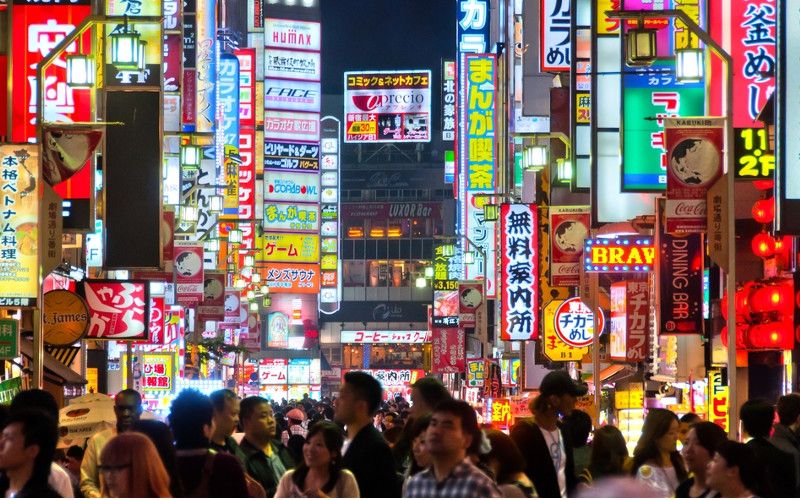
If you’re planning a trip to Japan , you may at first feel overwhelmed by the vast amount of exciting cities, stunning natural landscapes, and unique historical attractions to visit.
Fortunately, we’ve compiled this handy Japan guide to help you make informed decisions about what you want to get out of your trip, how to prepare, and the services and facilities that may be useful to you during your stay.
You can use the following travel guide to help you plan your itinerary in the country, compile your packing list, and learn more about Japanese customs and lifestyle in general.
When you should travel to Japan
The best time to visit Japan is subjective and depends on what you want to get out of your trip. See the following advice for traveling to Japan depending on the season :
- Spring – The stunning colors of the sakura cherry blossom season draw many foreign visitors to Japan in spring. However, this is can result in large crowds at the parks and shines where the cherry trees can be found. Furthermore, Golden Week , one of the main Japanese holidays , takes place from late April to early May, and is considered one of the worst times to visit Japan because public transportation can be incredibly crowded and prices tend to be at their highest.
- Summer – A great time to take part in outdoor activities in Japan and enjoy a number of matsuri festivals . Although summer is the rainy season across much of the country, the rain rarely affects travel plans, and most of Japan experiences hot and humid weather.
- Autumn – One of the least crowded times to visit Japan, although the popular tradition of koyo autumn leaf viewing can also draw large crowds in November. However, early December still allows plenty of opportunities to take part in this pastime.
- Winter – Those who visit Japan in January, February, or March will find it one of the cheapest and less crowded times to travel to the country. Winter sports enthusiasts will want to take advantage of the excellent powder snow for skiing and Snowboarding in Hokkaido.
Things to know before you travel
Some basic facts that travelers should know before traveling to Japan include:
- The phone number for a medical emergency is 119
- Public restrooms in Japan are readily available and easy to find in prominent tourist attractions, train stations, and department stores
- Trash cans in public spaces are not common , and many Japanese people carry their trash with them during the day to later dispose of at home
- It is normally necessary to remove shoes before entering a Japanese home , as well as in some public establishments
- Japanese streets are not named with the exception of major roads, and the address system in Japan is based on areas
- Travelers with tattoos are advised is necessary to cover up if planning to visit a public onsen hot spring .
Do I need a visa to travel to Japan?
Travelers from a number of countries, including The United States, the United Kingdom, Canada, Australia, Mexico, and all European Union countries, do not need a Japan tourist visa to enter the country for short stays.
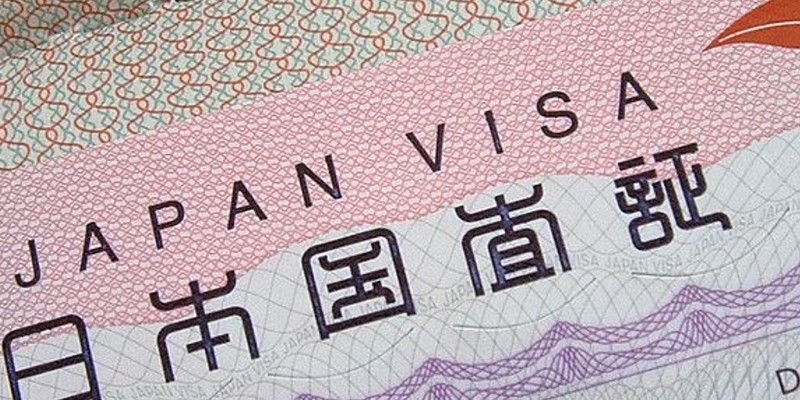
Citizens of these countries receive a temporary visitor stamp in their passport upon arrival in Japan, which guarantees their entry to the country for purposes of tourism. Travelers are required to have this stamp in their passport to be eligible to apply for the JR Pass.
Planning your trip to Japan
When planning a trip to Japan , it’s a good idea to settle on your itinerary and investigate accomodation and travel options for each destination in advance.
Below you’ll find an extensive list of travel tips for the country, including how to access WiFi in Japan, basic Japanese etiquette and common phrases you should learn, and how to travel with a JR Pass.
Accommodation
If you’re traveling to Japan on a budget , an excellent accomodation option is to stay in a sleep pod in a Japanese capsule hotel .
Although the sleeping capsules in the unique ‘ pod hotels ’ are smaller than a regular-sized hotel room, these establishments are usually ultra-modern and very comfortable, and may also offer luxury facilities such as a sauna and a spa.
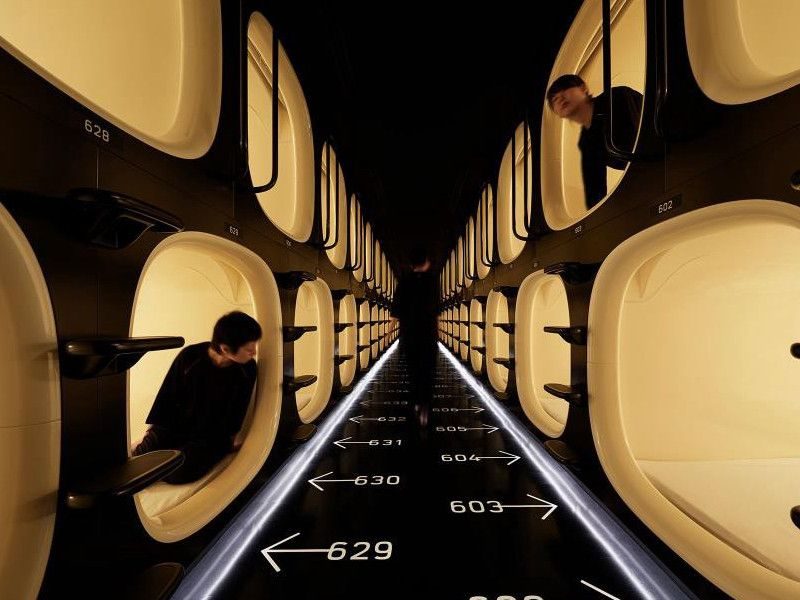
Travelers willing to spend a little more to experience traditional Japanese accommodation should consider staying in a Ryokan (Japanese guest house).
Although a Ryokan may cost a little more than a regular hotel (typically between ¥15,000 and ¥25,000 per person, per night), many visitors feel that it is worth it for the traditional Japanese experience.
The Japan Rail Pass is a must-have for all visitors planning to travel around Japan.
The JR Pass is multi-use, discounted ticket that allows unlimited access to trains operated by Japan Rail National, as well as JR bus services, ferry services, and airport transfers .
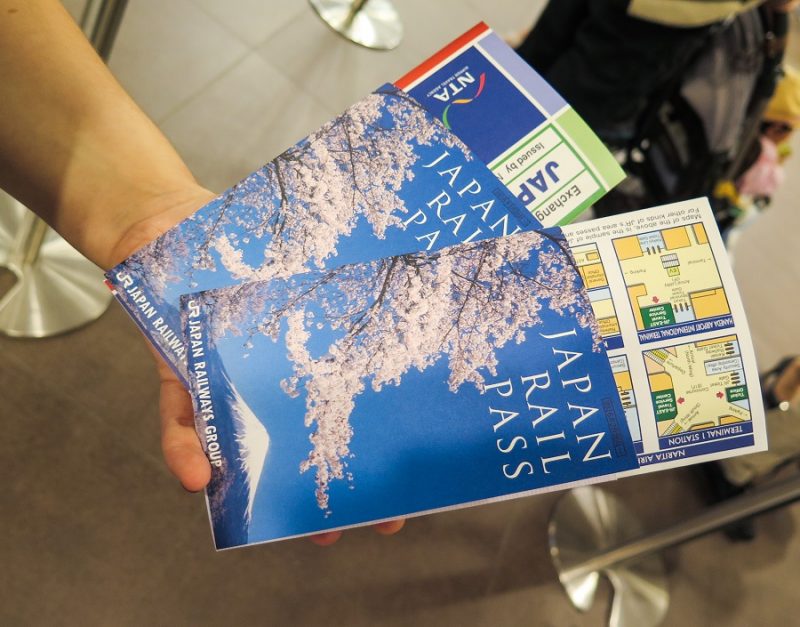
The Japan rail pass is worth obtaining even if you don’t plan on traveling extensively within the country, as this cost-effective travel option for the whole country is around the same price as a single ticket from Tokyo to Kyoto on a Shinkansen bullet train .
Book your Japan Rail Pass now
If you don’t plan on leaving Tokyo during your stay, you may want to consider applying for a Japanese IC card , a prepaid rechargeable travel card which can be used on trains, metros, buses, ferries, and cable cars within the city.
An IC card may also be used at certain restaurants, vending machines, and convenience stores throughout Japan. IC Cards can be purchased from an automated kiosk or ticket counter or at any major train station
Whether you are planning to visit Japan for a week or up to a month , there are a number of comprehensive Japanese routes and itineraries available to help you see everything you want to take in during your trip.
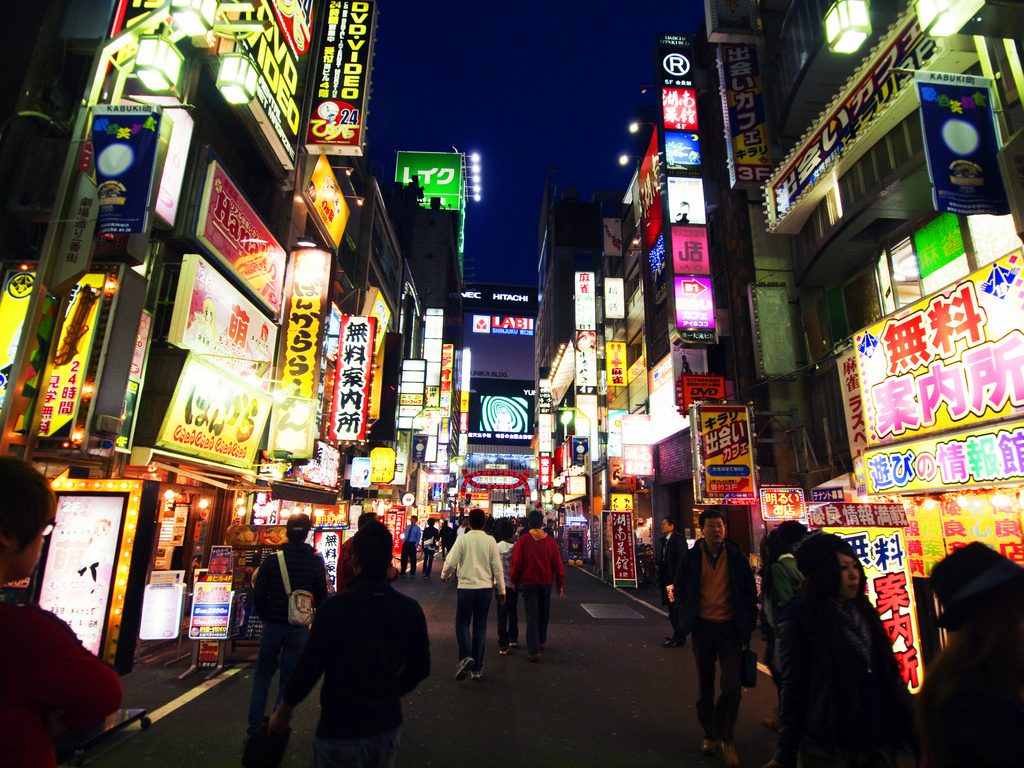
Apart from the itineraries for attractions in individual cities such as Tokyo , Kyoto , and Osaka , the following routes can help you get around come of the most appealing areas of the country in the time you have available:
- 7 days – Tokyo highlights, Kamakura , Kyoto, and the Todaiji Buddha statue in Nara
- 10 days – Tokyo, Takayama , Japanese Alps, Kyoto, Nara, and Osaka
- 14 days – Kyoto, Osaka, Nara, Hiroshima , Miyajima, Fukuoka , and the best attractions to visit in Tokyo
- 21 days – An in-depth itinerary including Tokyo, Kyoto, Takayama, Osaka, Nara, Okayama , and Hiroshima.
Phone and internet access
Travelers to Japan can gain internet access in a variety of ways. Upon arrival in the country, it’s a good idea to download the Japan Connected phone app, which indicates where you can find free WiFi at over 1,500 hotspots in Japan.

If you need to constantly access high-speed internet while on your travels, it is advisable to rent a pocket WiFi router, to which up to 5 devices can be connected. A pocket WiFi can be rented for between 5-30 days and can be picked up on arrival at a Japanese airport or from your hotel.
You also have the option to rent a Data SIM card to access the internet while in Japan, which permits you to use up to 500 MB of high-speed internet per day.
Dos and don’ts
Before visiting the country, you should learn the basic rules of Japanese etiquette to show respect to local customs and traditions .
Some common ‘Do’s include:
- Bowing as a greeting
- Taking shoes off when entering a Japanese home
- Showing appreciation for a home-cooked meal.
While in Japan, visitors should not :
- Point using chopsticks
- Blow their nose in a public place
- Wear inappropriate clothing when visiting temples and shrines.
Learn some Japanese phrases
While you may meet Japanese people who speak English while traveling in the country, it’s still a good idea to learn some basic Japanese phrases to help you get by. Locals will also appreciate the effort .
Some common phrases that are good to know include:
- Konnichiwa – “Hello”
- Ogenki desuka? – “How are you?”
- Sumimasen – “Excuse me”
- Kudasai – “Please”
- Arigato – “Thank you”
Bring some cash and look for 7-11
As not all of ATMs in Japan accept credit or debit cards issued overseas, it’s a good idea to bring some cash currency with you when traveling to the country.
Nevertheless, there are over 30,000 ATM locations across Japan that do cater to international travelers. This includes over 10,000 ATMs at Seven-Eleven convenience stores across Japan, where foreign cards such as Visa, Plus, American Express, Cirrus, and others are accepted.
Familiarize yourself with Hyperdia
Hyperdia is a useful transport planning mobile and web app which allows you to plan your itinerary to travel around Japan by train with precision.
Travelers who download Hyperdia have direct access to up-to-date schedules, journey times, and train information and prices. The app also allows you to access links to useful services in the selected locations, such as car rental companies, hotels, and restaurants.
Useful travel apps
Besides Hyperdia, there are a number of other travel apps for Japan which visitors may find useful during their visit to the country. These include a variety of apps to translate Japanese into English, to navigate the metro systems in the major cities, and restaurant and hotel-finder apps.
Don’t miss while in Japan
If you’re only planning a short stay in Japan, you should make sure you fill your itinerary with the top attractions and most typical traditional experiences. Find below some suggestions.
These small traditional inns are usually run by the same family for generations, and are typically located close to onsen hot springs or public baths in appealing natural surroundings. Most Ryokans in Japanese cities also have dedicated indoor bathing facilities.
The Gora Kadan in the Hakone region, Tamahan Ryokan in Kyoto, and Sadachiyo Ryokan in Tokyo are considered some of the best Ryokan in Japan .
These natural hot springs , fueled by volcanic activity, are perfect for taking a soothing, warming dip in the winter months, and are usually located close to Ryokan guest houses.
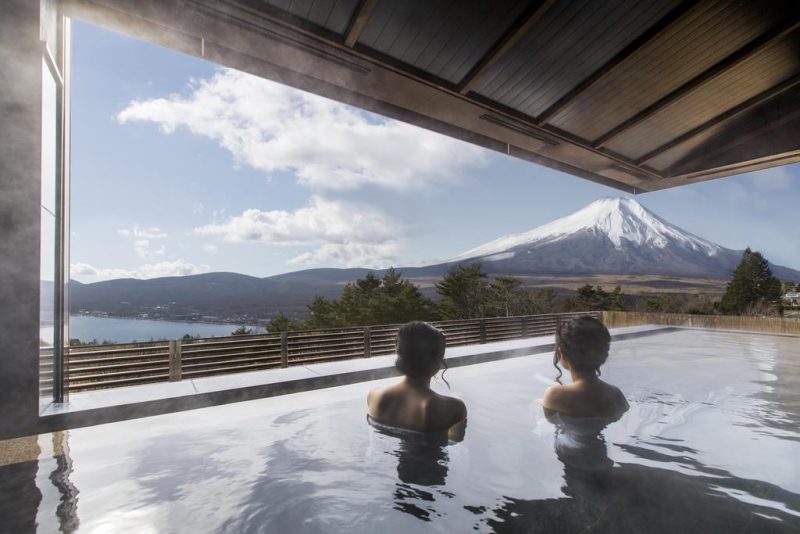
Onsen in Japan you should consider visiting during your stay include Kusatsu Onsen in Gunma Prefecture, any of the luxury onsen in Hakone , and the Noboribetsu Onsen in Hokkaido.
Cherry blossom
The Japanese cherry blossom , known as sakura , is one of the main attractions for travelers to Japan during the spring months, and sees Japanese parks and shrines come to life with the spectacular blooming of pink and white cherry flowers.
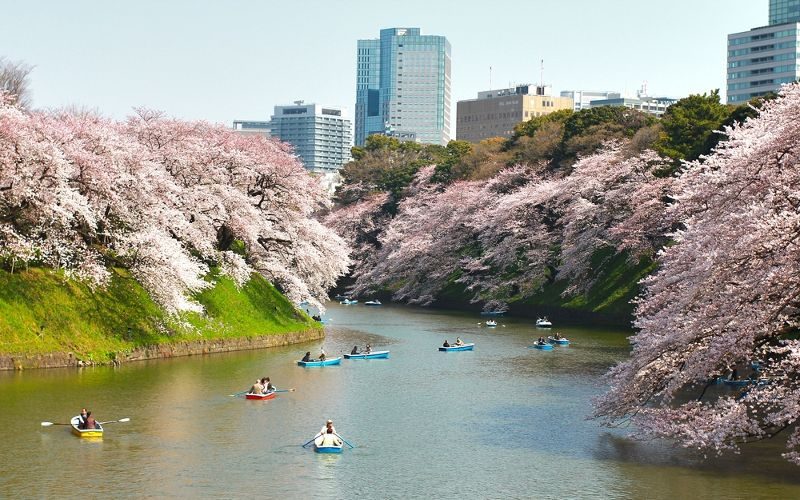
If having a picnic under the blooming cherry trees or taking part in a cherry blossom festival appeals to you, you should check the yearly Cherry blossom forecast before planning your trip to get the timings right.
In Japan, the phenomenon of the autumn leaves changing into vibrant shades of red, yellow, orange, and brown is called momiji , which means ‘ red leaf’, and can be just as stunning as the spring cherry blossom.
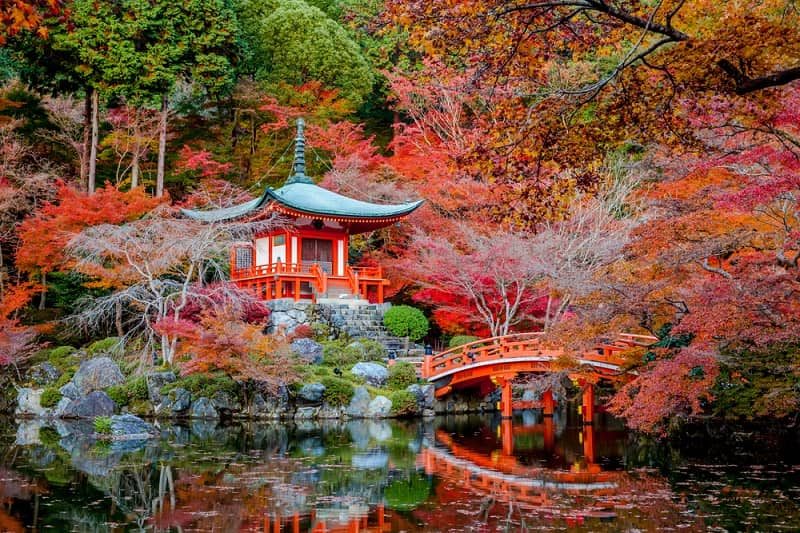
The act of Momijigari (red leaf hunting) reaches its peak in November , but in some regions the leaves can start turning as early as September or much later in the season, in December. Check the yearly Autumn leaves forecast to make sure you don’t miss out on the phenomenon.
Ride the Shinkansen
Using the Shinkansen network is the fastest and most convenient way to get around Japan, with the high-speed trains capable of reaching up to 320 km/h (199mp/h).
The Shinkansen lines are extensive and cover the majority of Japan , from Tokyo to Osaka and the south, to the northern parts of Honshu and the entirety of the island of Hokkaido.
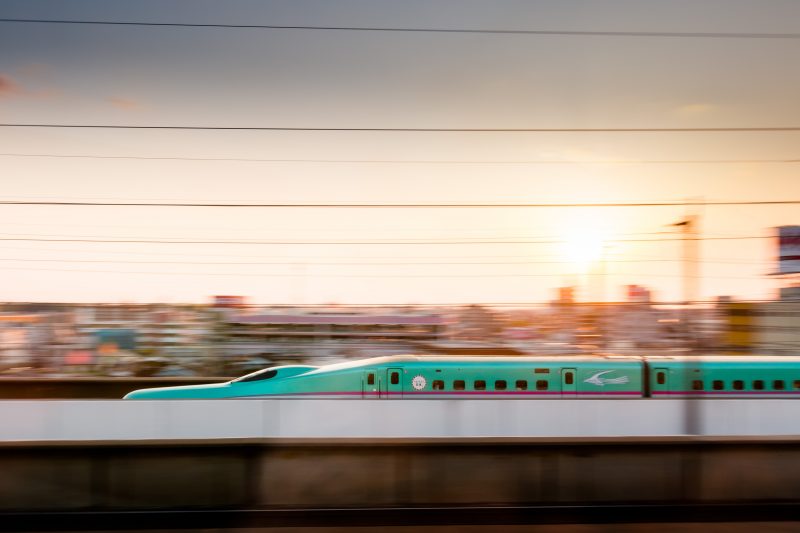
Holders of the JR Pass are granted unlimited access to all of the Shinkansen bullet trains during its validity. From October 2023, you can also ride the Nozomi and Mizuho Shinkansen if you pay a supplement. These run on the Tokaido, Sanyo, and Kyushu Shinkansen lines.
Top destinations in Japan
You may feel as though there are an overwhelming number of places to visit during your stay in Japan. While this may be true, there are certain cities and natural landscapes you really can’t msis during your trip, including:
Japanese top attractions
While there a vast number of enticing historical and cultural attractions in Japan to discover during a visit, if you are only planning a short trip you might want to consider prioritizing some of the following:
- Tokyo Imperial Palace
- The Chureito Pagoda overlooking Mt. Fuji
- The Fushimi Inari Taisha Shrine in Kyoto
- Osaka Castle
- Arashiyama bamboo forest near Kyoto
Of course, this is just a small sample of the many unique attractions in Japan, and if you’re planning a long trip the country, you’ll be able to discover much, much more.
Related posts
Related tours & activities.
How To Plan the Perfect Trip to Japan: A Comprehensive Guide
Japan is one of the most enchanting places in the world to visit, so it’s no surprise you’ve landed on Japan as your next destination. When you plan a trip to Japan, it’s important to consider important factors like location, flights, budget, how long you want to stay, and which places are at the top of your Japan must-sees. From the bustling streets of Tokyo to the serene temples in Kyoto , a diverse range of attractions and experiences await you in Japan. Every traveler has unique needs, so whether you’re traveling solo, with family or friends, have limited time or are looking to plan an extended stay, this guide has everything you need to know about planning your dream trip to Japan.
1) Decide How Long Your Japan Trip Will Be
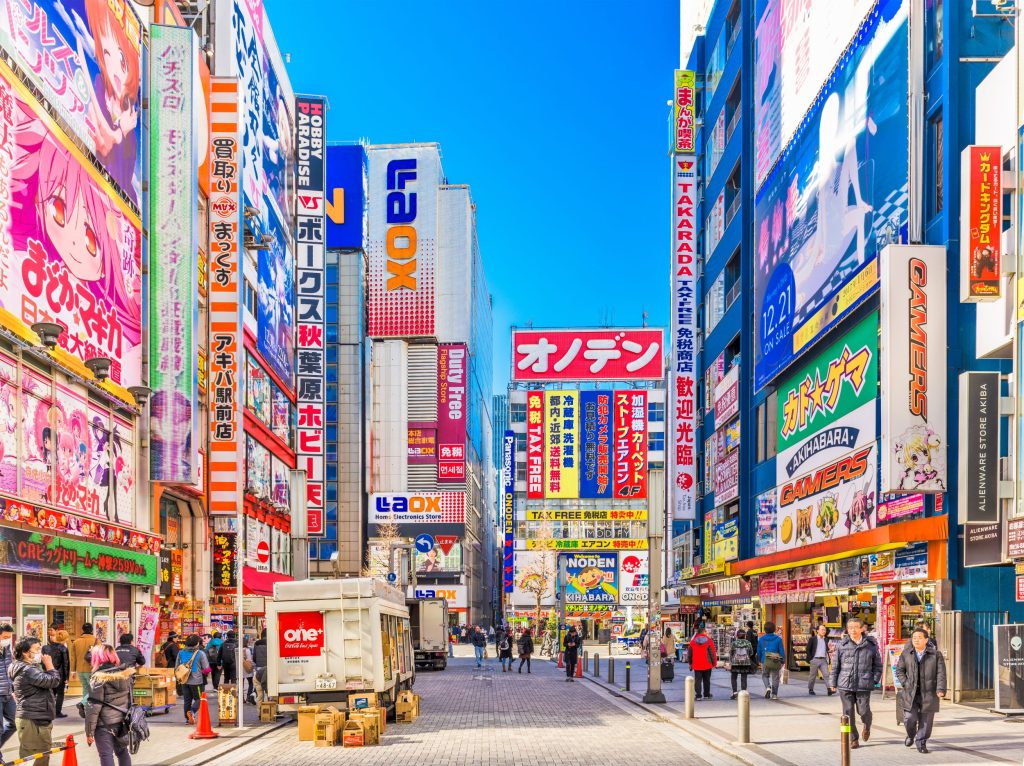
The first step in planning a trip to Japan is deciding how long you’ll be staying. Whether you have a week or a month, Japan has plenty to offer, but it’s crucial to strike a balance between exploring different regions and not rushing through this special experience. The length of your visit can significantly impact your Japan itinerary and budget.
- Short Trip (1-2 weeks): If you have limited time, focus on specific regions or cities to make the most of your stay. Consider exploring the iconic Tokyo and Kyoto for a mix of modern and traditional Japanese experiences. For travelers on a limited timeframe, taking a multi-day package tour is recommended to help you get around and see all the sights, while maximizing your short stay in Japan.
- Medium Trip (2-3 weeks): With a bit more time, you can venture further into the country, adding destinations like Hiroshima , Osaka , and Nara to your itinerary. This is the perfect amount of time to complete the popular Japan Golden Route which starts in Tokyo and ends in Kyoto.
- Extended Trip (3+ weeks): For an extended stay, you can explore Japan more thoroughly, including less-visited but just as stunning areas like Hokkaido , the Japanese Alps and the Chubu region to your trip, on top of all the classic must-sees in Tokyo and Kyoto. This extended option offers a well-rounded experience of Japan’s diverse landscapes and culture.
2) Create a Budget for Your Trip to Japan

Before you dive into planning your trip, it’s crucial to establish a realistic budget. Japan is often perceived as an expensive destination, but with careful planning, you can manage your expenses effectively. In general, you should budget to spend at least $100 per day during your trip in Japan for all your expenses including nice accommodation. For a cheaper trip, you can opt for hostels, capsule hotels, and other budget options. These are all things you should keep in mind while you save for your trip to Japan:
- Flights: Depending on where you’re coming from, Japan can be a long way away and your flight may take up a significant part of your budget. Consider flying off-season, or breaking your flight up into multiple stops if you’re looking to cut costs.
- Food: Japanese cuisine is a highlight of any trip. You can enjoy budget-friendly street food or indulge in Michelin-starred restaurants. Allocate a portion of your budget for dining experiences. If you don’t have much left in your budget for food, you could choose to indulge in one or two authentic food experiences and enjoy delicious and affordable street food for the rest of your stay.
- Accommodation: Determine your accommodation preferences, whether it’s staying in luxurious hotels, budget-friendly hostels, or traditional ryokans . Prices vary significantly, so research and book in advance to secure good deals.
- Transportation: Decide whether you’ll invest in a Japan Rail Pass for extensive train travel or use regional passes and local transportation. Calculate transportation costs between cities in advance.
- Activities: Make a list of activities and attractions you want to visit, and estimate entrance fees, tours, and cultural experiences.
- Miscellaneous Expenses: Don’t forget to include costs for travel insurance, SIM cards or pocket WiFi, and shopping souvenirs.
Pro-Tip for Cost Efficient Travel
To cut costs, consider joining a guided multi-day tour of Japan . This option can take care of transportation, accommodation, some food, and activities with one purchase, and is often more cost effective than booking each thing separately. This 8 day tour of Kyoto, Tokyo, Osaka, and Nara is an excellent and affordable option to see all the unmissable sites in Japan. Alternatively, you can browse all our Japan package tours for a range of lengths and visiting locations.
See all Japan Tour Packages
3) What Time of Year Do You Wish to Travel?
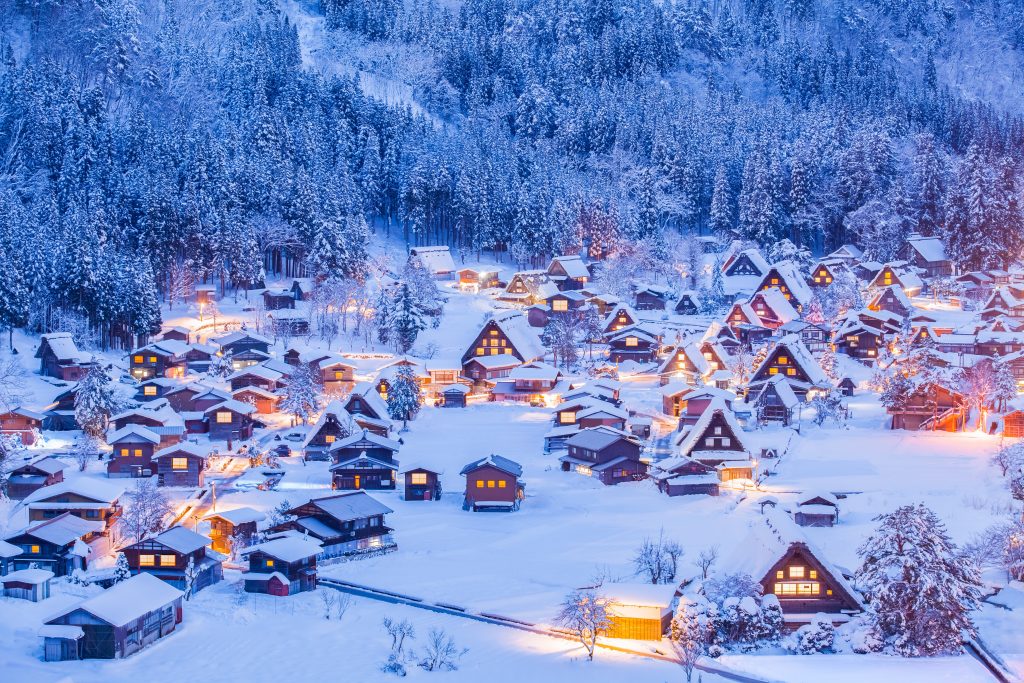
Japan experiences distinct seasons, each with its unique charm. The time of year you choose to visit will determine the climate, festivals, and the availability of certain activities. Keep in mind that cherry blossom season (Sakura) and autumn foliage (Koyo) are especially popular times to visit.
- Spring (March to May): Spring in Japan is famous for cherry blossoms . If you’re interested in witnessing these beautiful flowers in full bloom, plan your trip from late March to early April, and base your trip around the top places to see the Sakura . The weather is mild, making it the perfect time for outdoor activities. For recommendations during this time, check out our guides to Japan in March , April , or May .
- Summer (June to August): Summer can be hot and humid, especially in cities like Tokyo and Osaka. This is a great time for indoor activities like food tours and exploring temples. Hokkaido offers relief from the heat with its cooler temperatures. Browse through our monthly guides for more information about Japan in June , July, or August.
- Autumn (September to November): Autumn brings stunning foliage and pleasant weather. It’s a fantastic time for hiking! Among our favorite autumn activities is enjoying the changing leaves in picture-perfect Takayama in the Japanese alps.
- Winter (December to February): Winter is ideal for skiing and enjoying hot springs (onsen) in places like the Gifu prefecture. There’s nothing like sinking into this natural heated pool in the heart of the Japanese Alps! Of course, Japan’s most popular places, Tokyo and Kyoto, also have their unique winter flavor .
4) Build Your Trip Around Special Experiences
View this post on Instagram A post shared by Tourist Japan (@tourist__japan)
Japan offers a wide range of experiences, from cultural immersion to outdoor adventures. Tailor your itinerary around your interests and the season of your visit. Decide what side of Japan you wish to prioritize during your stay:
- Cultural Experiences: Participate in a tea ceremony , visit traditional temples and shrines , or explore the ancient art of calligraphy. Kyoto is particularly famous for its rich cultural heritage.
See all cultural tours
- Outdoor Adventures: Hike the beautiful trails in the Japanese Alps, visit the breathtaking Mount Fuji , go skiing in Niseko, or relax in an onsen with stunning mountain views.
See all nature tours
- City Exploration: Tokyo, Osaka, and Kyoto offer a mix of modern and historic attractions. Explore Tokyo Disneyland, experience the nightlife of Osaka, and visit Kyoto’s UNESCO World Heritage Sites.
See all city tours
- Foodie Adventures: Savor sushi at Tsukiji Fish Market in Tokyo , try street food in Osaka’s Dotonbori, and sample kaiseki (traditional multi-course) dining in Kyoto. Can’t decide which is best for you? Check out our list of the best food tours in Japan .
See all food tours
5) Book Day Trips from Japan’s Main Cities
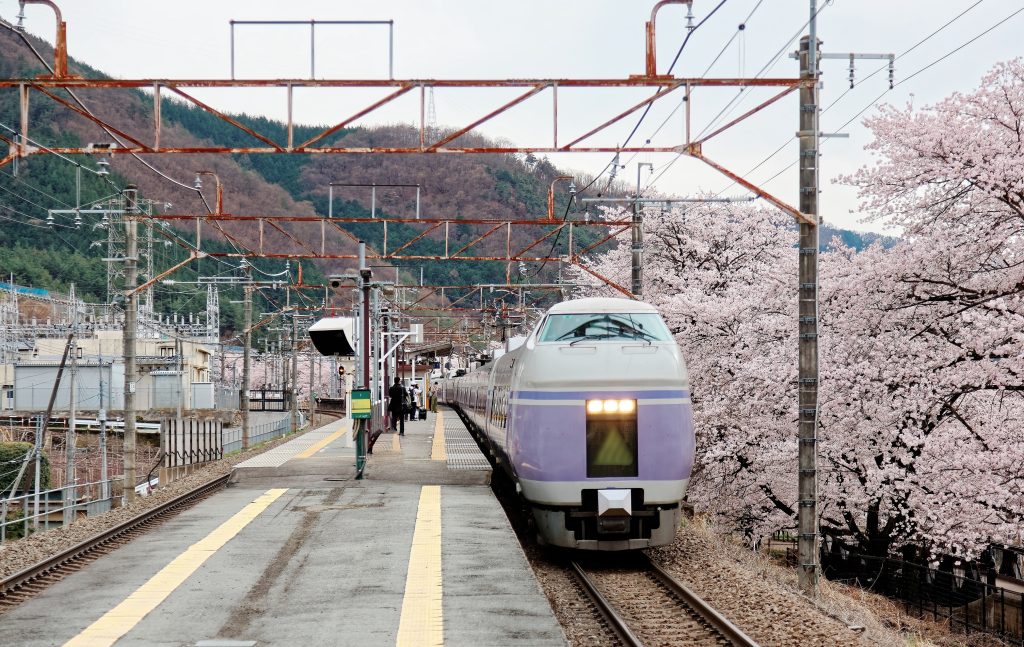
While exploring Japan’s major cities is a must, consider adding day trips to your itinerary for a more well-rounded experience. Here are a few day trip ideas from Tokyo, Kyoto, and Osaka:
- From Tokyo: Visit Nikko to see the Toshogu Shrine, ascend the iconic Mount Fuji , take a trip from Tokyo to Kamakura to see the Great Buddha , or explore the charming streets of Harajuku.
See all tours from Tokyo
- From Kyoto: Explore Nara to see the friendly deer and ancient temples, visit Hiroshima and its Peace Memorial Park, or spend the day temple hopping inside Kyoto.
See all tours from Kyoto
- From Osaka: Visit the iconic Osaka castle or explore the city’s wonderful food markets.
See all tours from Osaka
Have Fun in Japan!
Finally, don’t forget to enjoy your trip to Japan to the fullest. Embrace the culture, try new foods, and immerse yourself in the beauty and traditions of this incredible country. Be open to serendipitous discoveries, make new friends on day trips , and create lasting memories!
In conclusion, planning a trip to Japan can be a rewarding experience when approached with thoughtful consideration. By deciding on the duration, timing, budget, experiences, and logistics of your journey, you’ll be well-prepared to embark on an unforgettable Eastern adventure. So, start planning, pack your bags , book your travel insurance , and get ready for an incredible journey through Japan’s rich history, vibrant culture, and stunning landscapes you won’t find anywhere else.
Subscribe for insider tips to Japan Enter your email address to stay in-the-know of what's new in Japan. We promise to only send you guides to the best experiences. Email Keep Me Updated
Recommended

Related Articles

The Japan Golden Route: Everything To Know

Japan in May 2024

Japan in April 2024

Japan in March 2024

The Three Wise Monkeys of Toshogu Shrine in Nikko

Tips for Climbing Mount Fuji


The Tokyo Bucket List – Top Things To Do in Tokyo

Cultural Guide to Japan

Spa & Wellness in Tokyo

Top Experiences in Japan

Planning for an Unforgettable Trip to Japan: A Step-by-Step Guide
by Venese | Feb 23, 2023 | Japan Travel | 0 comments

Have you been eagerly anticipating your trip to Japan and can’t wait to get your itinerary sorted? Feeling a tad overwhelmed by the plethora of information available online and unsure of where to begin? Planning a trip to Japan can indeed be daunting, particularly considering the vast differences in culture, language, practices, and traditions compared to elsewhere in the world.
Fret not! We’re here to assist you in planning your trip to Japan in the most straightforward and stress-free manner possible. Simply follow the step-by-step guide provided here, and you’ll breeze through the planning process without a worry!
Table of Contents
Planning a trip to Japan
Step 1: figuring out your trip’s ‘why’.
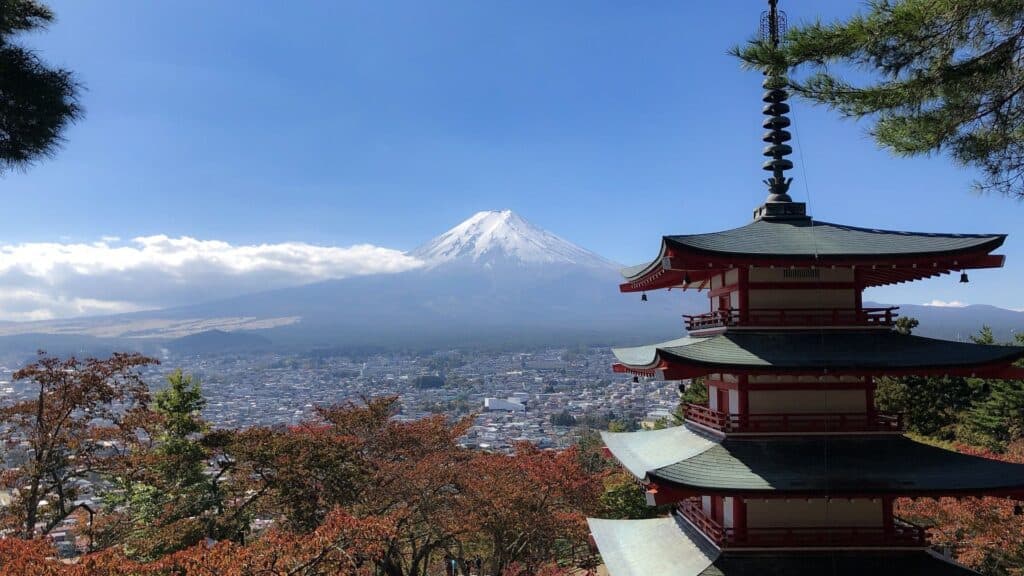
Let’s begin by considering why you’re interested in visiting Japan. With its diverse range of attractions and experiences, planning a trip to Japan can feel a bit overwhelming at first. But understanding your motivations for visiting can make the process much smoother. Here are some common reasons people choose to visit Japan.
Reason: Japanese Food and Drinks
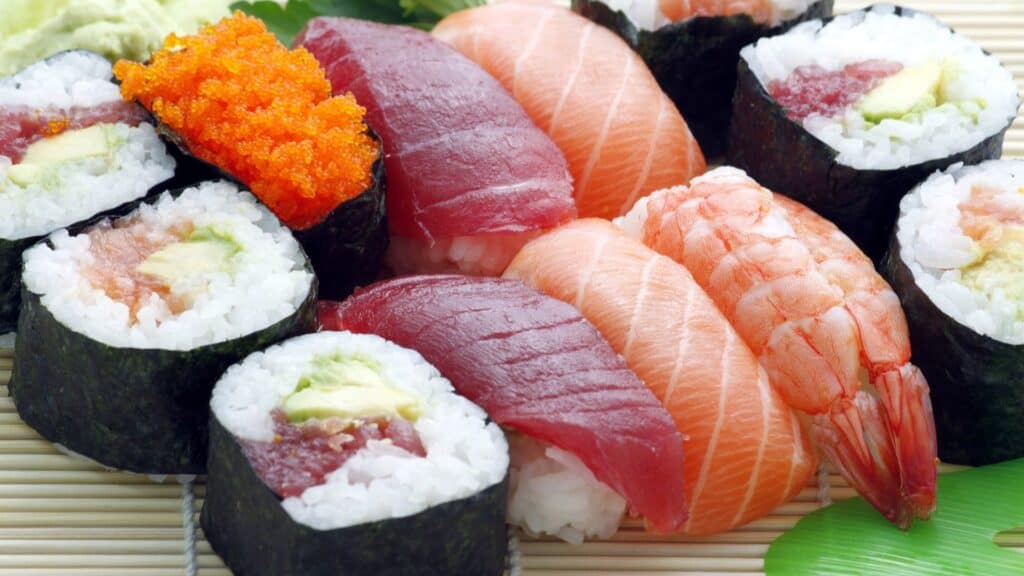
Let’s commence with food and beverages. While Japan is renowned for its classic sushi, ramen, and nihonshu, commonly known as “sake”, let’s delve deeper. A culinary experience in Japan transcends mere sustenance; it’s an immersive journey. Japanese cuisine boasts an array of delights, spanning from sweet to savoury, from noodles to rice, from traditional to fusion.
At every juncture, Japanese food has the potential to surprise. Each region in Japan boasts its own signature dishes, fruits, and vegetables. Additionally, alongside nihonshu, one can explore shochu, umeshu, and more. Breweries and distilleries are scattered across the country, each offering a unique regional variation of the same beverage.
Reason: Japan Nightlife
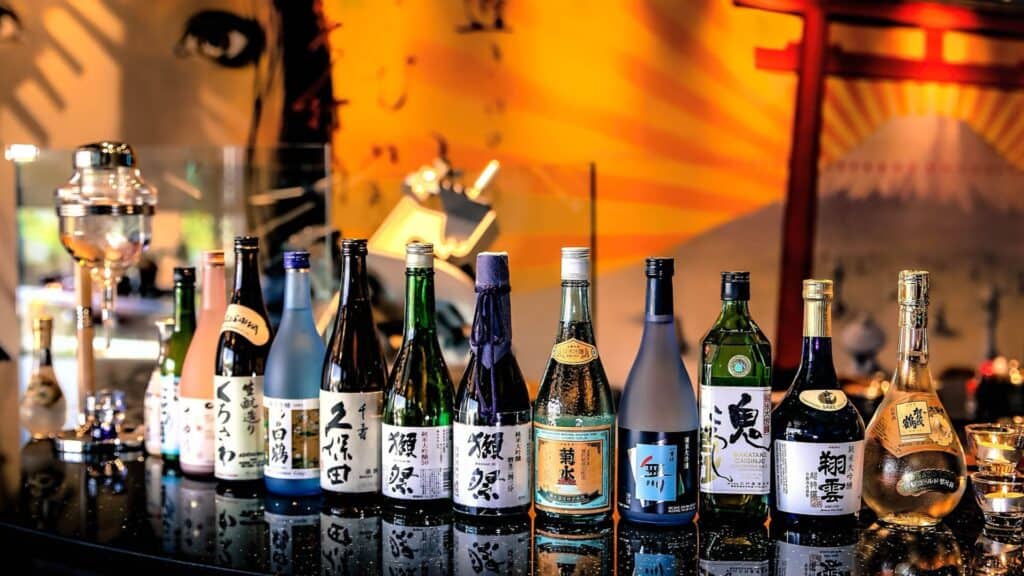
Many entertainment venues, eateries, and even stores in Japan remain open until the early hours, and occasionally operate 24 hours a day. Tokyo’s nightlife is often spontaneous and exhilarating, where one moment you may find yourself in a bar, the next bowling or belting out karaoke with newfound acquaintances, and perhaps, as the sun rises, enjoying drinks in Yoyogi Park, which remains open throughout the night.
In Japan, your evenings can be spent sipping drinks in a local bar, clubbing, crooning in karaoke bars, or browsing convenience stores or Don Quijote, catering to diverse preferences.
Reason: Japanese Traditions and Culture
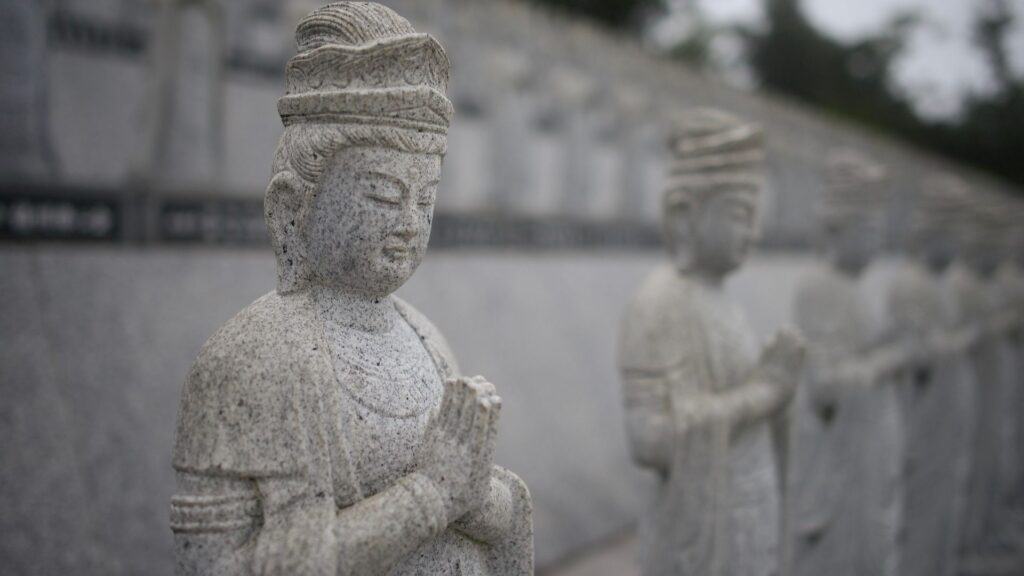
Japanese traditions and culture diverge from those found elsewhere in the world. From the serene temples and shrines to engaging in cultural activities such as tea ceremonies and Ikebana (flower arranging), there is much to discover.
In Japan, one can immerse themselves in traditional practices through visits to temples, shrines, palaces, and castles; stroll through Japanese gardens to connect with nature; explore numerous museums to gain insights into Japanese culture and history; or partake in cultural experiences, delving into realms such as sumo wrestling, geisha culture, ninja traditions, samurai heritage, and more.
Reason: Pop Culture

For many, the allure of Japanese pop culture serves as a primary draw. Anime and manga, video games, arcades, Japanese idols, and kawaii culture offer a plethora of exploration opportunities. Days or weeks can be spent traversing various areas, each offering its own unique pop culture phenomena. Even if initially unfamiliar, delving into Japanese pop culture promises an intriguing and distinctive experience.
Reason: Shopping
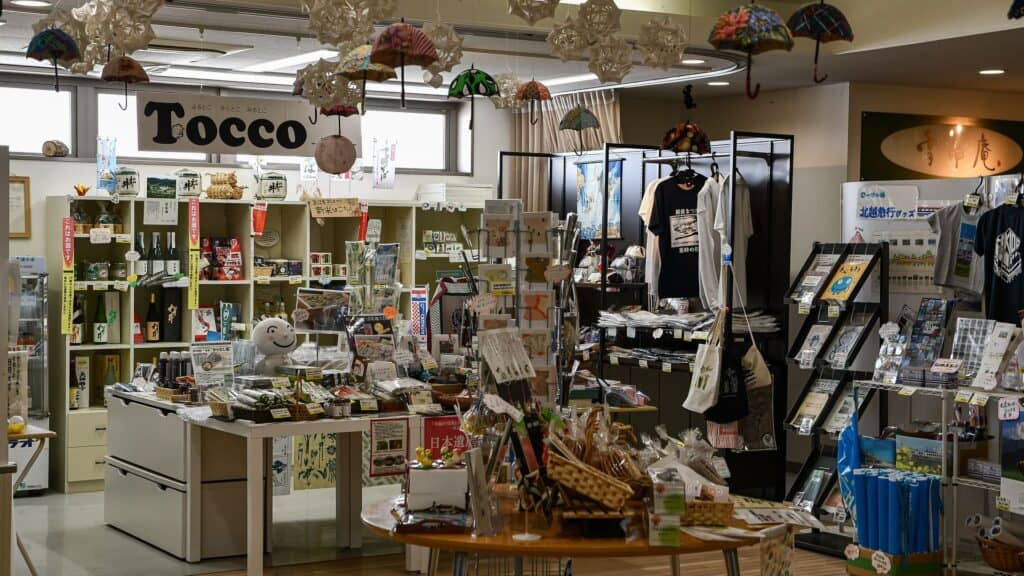
If shopping is your passion, Japan boasts an array of options. Beyond the famed Harajuku fashion and avant-garde trends, you’ll discover fashion brands and boutiques from around the globe. With most stores offering tax-free shopping, there are ample opportunities for fantastic deals.
Thrift stores, shopping malls, and outlet malls abound across Japan . Additionally, beyond clothing, Japan is renowned for its beauty products, which are esteemed for their quality and affordability. Many visitors indulge in bulk purchases of beauty products from Japanese pharmacies to resell back home.
Reason: Weird Things
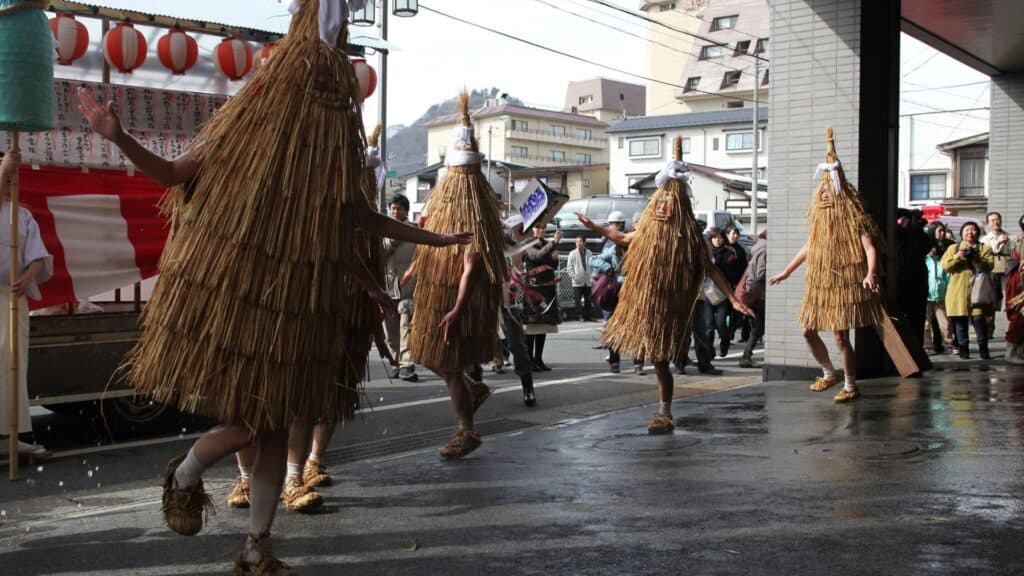
If you’ve encountered memes, gifs, videos, or clickbait articles about Japan, you may have encountered some of the peculiar and intriguing aspects of Japanese culture. Without revealing too much, peculiar advertisements adorn trains and streets, and evenings are punctuated by entertaining TV programmes. Simply wandering through town promises encounters with a plethora of entertainment.
Step 2. Deciding When to Go to Japan

Determining the ideal time for your trip to Japan is essential when kick-starting your planning process. You may have certain constraints, such as school holidays or public holidays, but rest assured, Japan has something to offer year-round. With its distinct and captivating seasons, Japan boasts a plethora of seasonal events and activities for you to enjoy during your trip.
March, April, and May stand out as ideal months to experience springtime in Japan during your trip. June signals the onset of the rainy season, a period many travellers tend to avoid, though accommodation and flight prices typically dip, offering budget-friendly options for your trip to Japan. July through September marks summer in Japan, characterised by sweltering heat and humidity, ideal for those seeking a summer adventure during their trip to Japan.
Towards the end of September and into early October, typhoon season poses a consideration for your trip to Japan. As November approaches, the snow season begins, attracting visitors to ski resorts from November through to March for a memorable trip to Japan.
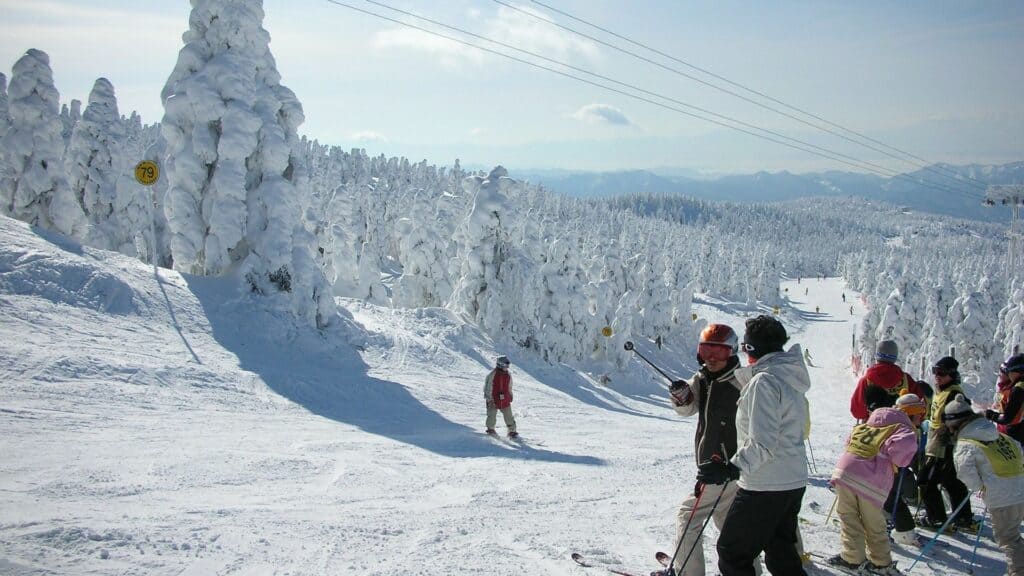
Traditionally, many opt to explore Japan during spring for the renowned cherry blossom season , yet each season holds its own allure for a trip to Japan. During spring, the weather remains cool, providing the perfect backdrop to admire cherry blossoms and indulge in all the seasonal pink delights on offer.
In summer, vibrant matsuri (Japanese festivals) take place almost daily, complemented by splendid beaches and summer pursuits, making it an ideal time for your trip to Japan. Come autumn, you can relish the gentle breezes while immersing yourself in the hues of red leaves and partaking in seasonal fruit picking during your trip to Japan. And in winter, skiing and snowboarding enthusiasts can revel in the powdery snow and seasonal festivities, adding excitement to your trip to Japan.
Step 3. Factoring in the Length of Your Stay in Japan
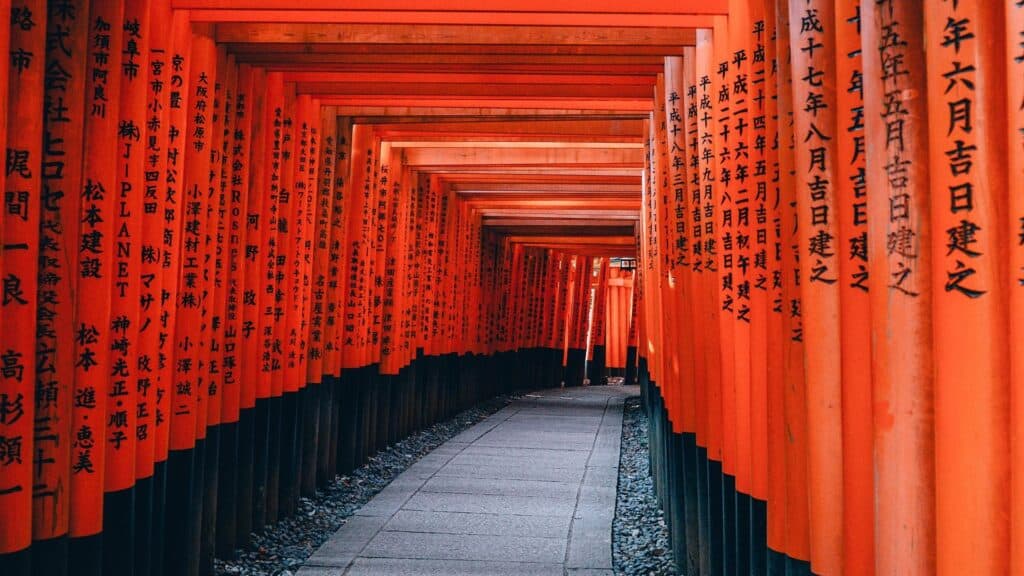
The next aspect to consider is the duration of your trip to Japan. Depending on your departure location, travel time can vary significantly. It’s important to factor in both the flight duration and the additional time required for airport transfers.
If Japan is the sole destination for your vacation, you may have the flexibility to extend your stay and explore more extensively. However, if you plan to visit other countries as well, your available time in Japan may be more limited.
A trip solely to Tokyo can be condensed to just a few days to gain a good overview of the city. However, to fully explore neighbouring cities and other regions within the country, you may require at least a week.
For those with ample time and a desire to delve deeper into Japan, rest assured that there’s no shortage of activities. The country boasts numerous distinct regions, each offering a wealth of local experiences to enrich your trip to Japan.
Step 4. Making Sure You Stick to Your Budget
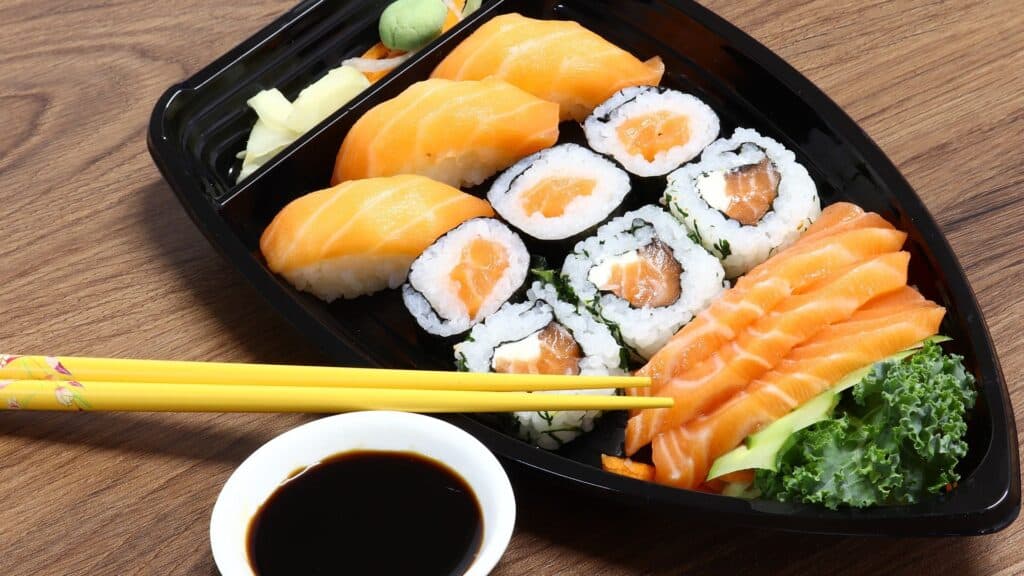
Determining your budget is crucial for planning your trip to Japan, as it will influence various aspects such as accommodation, transportation, and overall expenditure.
Many individuals perceive Japan to be an expensive destination, given its abundance of Michelin-starred restaurants, impressive skyscrapers, and top-notch services. It’s understandable to assume that travelling in Japan could come with a hefty price tag.
However, it’s worth noting that while there are certainly high-cost options available, there are also numerous affordable alternatives. Whether it’s dining, transportation, accommodation, or shopping, there are plenty of ways to economise. For detailed insights on saving money, refer to our resources.
Calculate the budget you anticipate needing for your trip and consider allocating a little extra for unforeseen expenses. Utilising apps like TravelSpend can assist you in managing your budget effectively throughout your travels.
Step 5. Focusing on Areas You Want to Visit
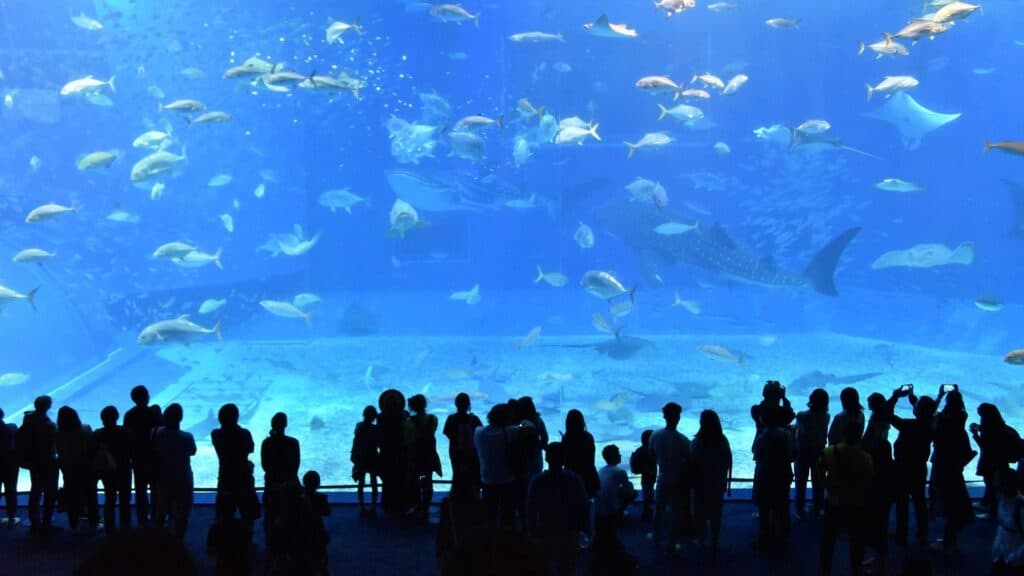
Determining which cities you want to visit in Japan is the next step in planning your trip.
Typically, most travellers fly into Tokyo, landing at either Narita or Haneda airport. As the capital of Japan, Tokyo offers a multitude of attractions. Additionally, Tokyo’s neighbouring areas, such as Yokohama, Izu, and Chiba, are popular spots for day trips.
Apart from Tokyo, other sought-after destinations include Osaka, Nara, Kyoto, and Hiroshima. Kyoto, Nara, and Hiroshima are ideal for those keen to explore Japanese culture, history, and nature. Osaka, another bustling metropolis, boasts abundant entertainment and vibrant nightlife.
Other notable areas in Japan frequently visited by tourists include Hakuba, Hokkaido, Fukuoka, and Okinawa.

Hakuba is renowned for its skiing opportunities, particularly favoured by international visitors. Here, you can indulge in winter sports during the day and vibrant nightlife after sunset.
Hokkaido, located in the northern part of Japan, offers incredible ski resorts and snow festivals in winter, while summer unveils stunning flower fields and seasonal fruit-picking activities.
Fukuoka is famed for its street food, lively nightlife, and rejuvenating hot springs. Meanwhile, Okinawa is celebrated for its picturesque beaches, natural beauty, and diverse water sports and activities.
Step 6. Booking Flights and Accommodations

Let’s delve into the enjoyable aspect of planning: booking your flights and accommodation for your trip to Japan!
At this stage, you should have determined your intended travel dates to Japan and identified the areas you’ll be visiting. If you’re keen on saving money on flights and don’t mind the possibility of a layover, consider exploring various low-budget flight options. Check out our preferred flight booking platform here to secure the best deals for your trip to Japan!
When it comes to accommodation, I recommend utilising platforms like booking.com or Agoda. They offer an extensive selection of properties across Japan at competitive prices. If you’re uncertain about where to stay, take a look at our recommended accommodation options here:
If you’re planning to travel extensively within Japan, I highly recommend acquiring the JR Pass. This pass functions as a rail pass, granting unlimited rides on most JR trains for a specified period upon a one-time fee. Even if you’re only venturing beyond Tokyo to one other city, the JR Pass can yield significant savings in both money and time!
Step 7. Finalizing Reservations and Bookings

Now that you’ve sorted your flights, accommodation, and plans for your trip to Japan, it’s time to finalise your reservations and bookings.
Many popular attractions require advance bookings, and certain sought-after restaurants and bars also insist on reservations. While some places offer tickets on the day, making reservations ahead of time can save you both time and, occasionally, money.
Key attractions that necessitate or benefit from advance reservations include Disneyland and Disneysea, TeamLab Borderless, Ghibli Museum, Yayoi Kusama Museum, and SkyTree observatory.
Ensure you arrange your reservations and bookings well in advance to avoid missing out on these experiences during your travels in Japan.
Additional travel add-ons

When planning your trip to Japan, you’ll find a range of apps and tools available to assist you with your travel needs, including transportation cards and SIM cards. Our FLIP Japan Starter Pack is specially curated to provide everything you need, eliminating the need for hours of research and arrangement. The best part? You can acquire everything upon your arrival at the airport!
Additionally, there are other considerations you may wish to explore, such as travel insurance, luggage transfer services, pickup services, travel gear, VPNs, and more. While not essential, these amenities can significantly enhance the ease and comfort of your travel experience.

Here are some of our preferred tools that may prove beneficial for your travels:
- Welcome Pickups offers a comprehensive luggage transfer service, ensuring seamless assistance throughout your journey, from arrival to departure.
- Wise is our preferred online money transfer service, providing convenient and straightforward money transfers without the complexities of traditional currency exchanges.
- Allianz Travel provides comprehensive travel insurance coverage, safeguarding you, your family, and your belongings throughout your trip abroad.
- World Nomads offers travel insurance tailored to the needs of travellers and families, covering essential aspects of your trip even in unforeseen circumstances.
- NordVPN is a VPN service offering enhanced security for all your devices, including computers, phones, and TVs.
Explore these tools further to determine how they can enhance your travel experience.
Step 8. Arranging Tours and Experiences
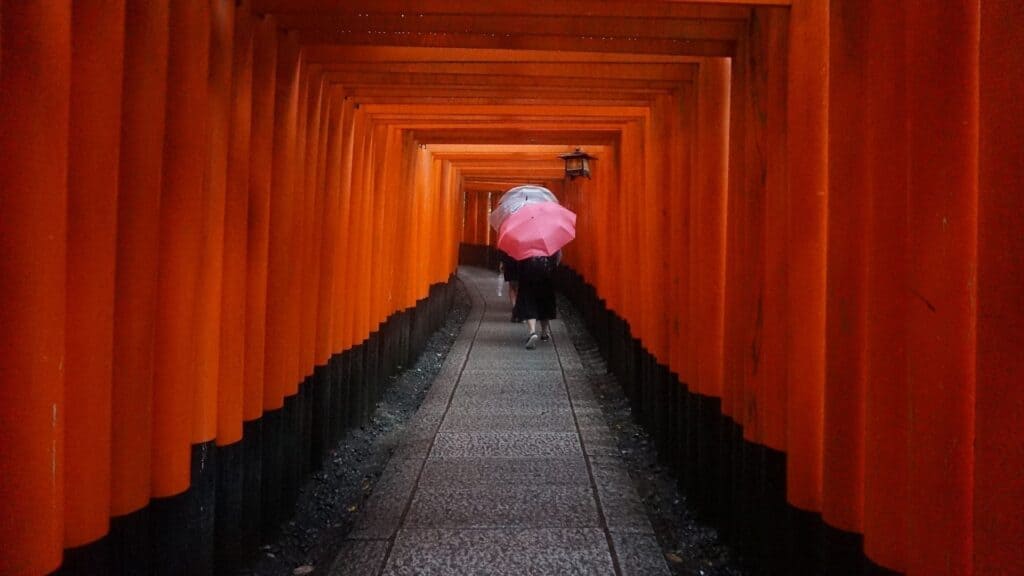
There’s no finer way to delve into Japan than with the guidance of local experts. Japan boasts an array of tours and experiences awaiting exploration during your trip.
Immerse yourself in cultural activities such as tea ceremonies, Japanese cooking classes, kimono dressing, geisha encounters, and sumo wrestler interactions. Alternatively, indulge in walking tours, culinary adventures, pub crawls, and ramen tastings. Many of these experiences can be found on Viator.
We offer a unique bar-hopping adventure that transports you to four underground venues across various Tokyo districts, complete with complimentary shots and discounted drinks. If this piques your interest, you can discover more about it here !
Step 9. Refining Your Itinerary
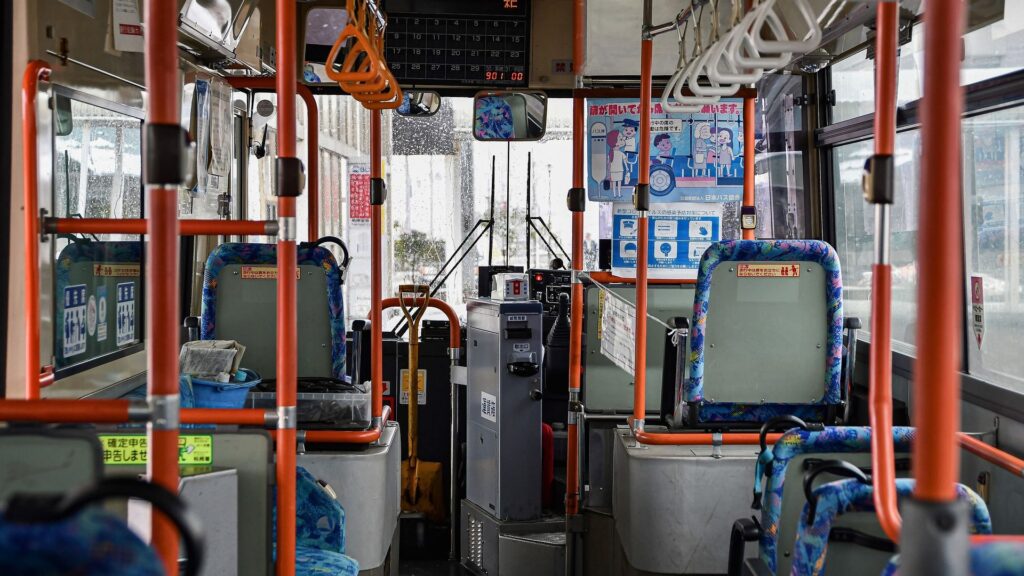
Now that you have arranged all your major travels, reservations, and experiences, it’s time to fill in the gaps and decide where to go during your trip to Japan. Some people prefer detailed itineraries listing everything, while others prefer to go with the flow.
Planning your trip to Japan is an enjoyable process, but it can also be time-consuming. To assist you in planning without stress or worry, and to ensure you can focus all your energy on enjoying your time, here are multiple Flip Japan Guide-crafted itineraries to help you make the most of your time in Japan.
Step 10. Arriving to Japan
If you’re embarking on a trip to Japan, particularly if it’s your first visit to the country, you’ll likely fly into Haneda airport or Narita airport.
At both airports, you have the option of taking a bus. This eliminates the need to lug around heavy luggage while navigating Tokyo’s extensive train lines. The airport limousine bus operates throughout the day and makes stops at hotels all over Tokyo. A ticket typically costs around ¥2,900 ($27).
Alternatively, if you’re seeking a more budget-friendly option and have minimal luggage, regular trains are a viable choice.
Starting Your Trip: Geting to Know Tokyo
Now that you are well-rested, it’s time to explore Tokyo! There’s no better way to start your trip than by visiting all the major sights in Tokyo. We suggest embarking on a comprehensive one-day trip to immerse yourself in the culture and discover places you might want to revisit later during your trip to Japan.

We recommend starting your day by visiting Skytree and Sensoji temple in the Asakusa area. Then, head to Akihabara to explore the anime and manga culture, as well as the electronics in the vicinity. While this might not appeal to everyone, there are plenty of other attractions in the area.
Next, venture to Harajuku to experience Takeshita Street, sample some delicious street food, soak in the kawaii culture, and explore Meiji Jingu Shrine and Yoyogi Park. If you’re feeling adventurous, you can visit the famous Shibuya for its Shibuya crossing, various shopping malls, and viewpoints. Finally, conclude your day by heading to Shinjuku, where you can explore the small bar streets, the red-light district Kabukicho, and indulge in the plethora of food options available.
Getting to Know Tokyo Even Better
Now that you’ve had the chance to visit the major sights of Tokyo, is there a place you’d like to revisit? Depending on whether you fancy trying out some Japanese food, going shopping, visiting museums, or exploring some natural spots, Tokyo offers a plethora of activities during your trip to Japan.
If you’ve been to Tokyo before or seek something more off the beaten path, you might consider exploring some of Tokyo’s local areas or trying out these day trip ideas from Tokyo.
Visiting other cities
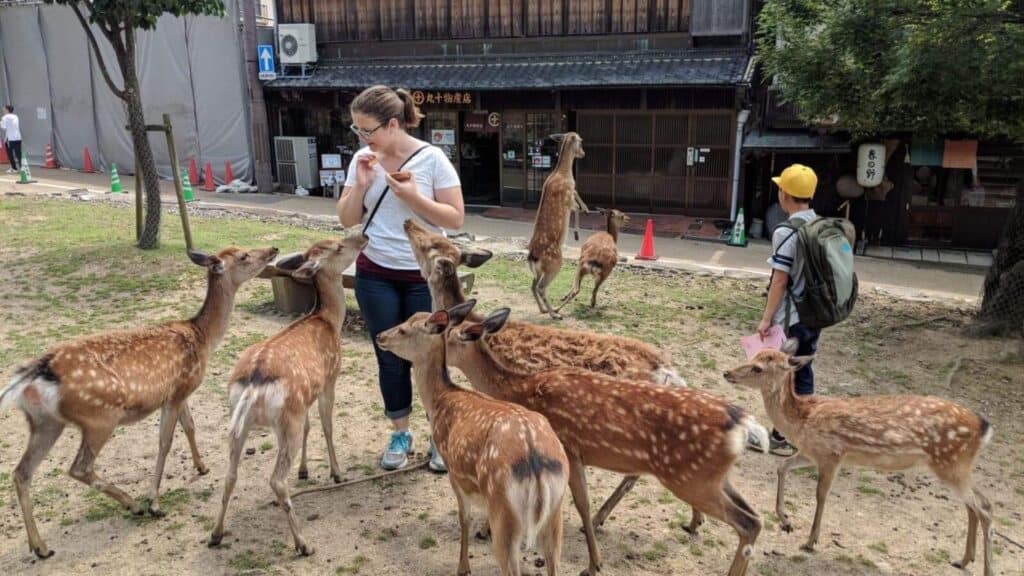
Nara is renowned for Nara Park, where wild deer roam freely. Within Nara Park, you’ll discover numerous temples and museums, including Tōdai-ji and Kōfuku-ji.
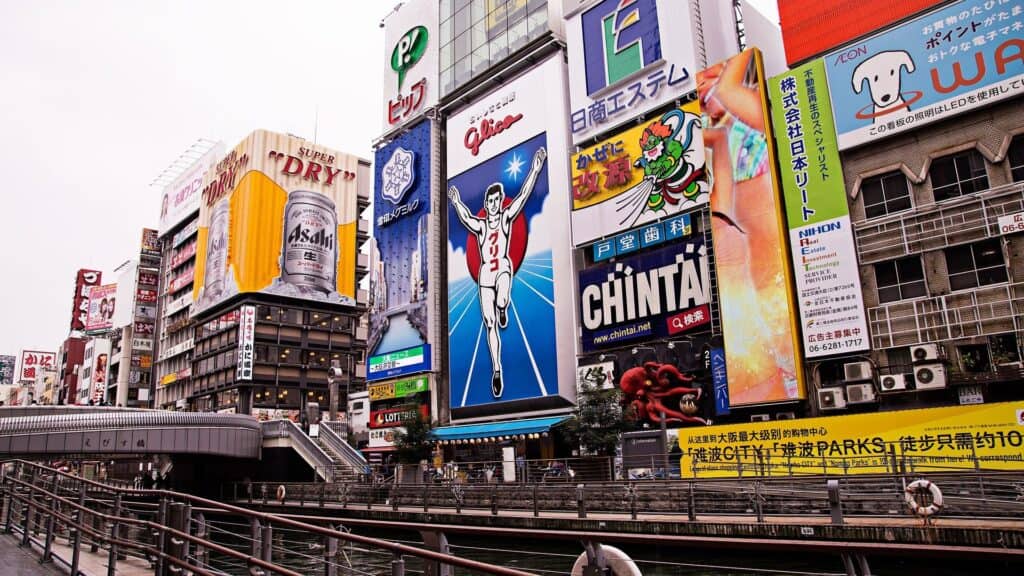
Osaka is a vibrant city boasting countless restaurants, shops, and street food stalls in Dotonbori and Shinsaibashi. Namba, located close to these areas, offers a vibrant nightlife scene. If you’re keen on amusement parks, consider visiting Universal Studios here. Additionally, popular skyscrapers with viewpoints include Abeno Harukas, Tsutenkaku, and Umeda Sky Building.
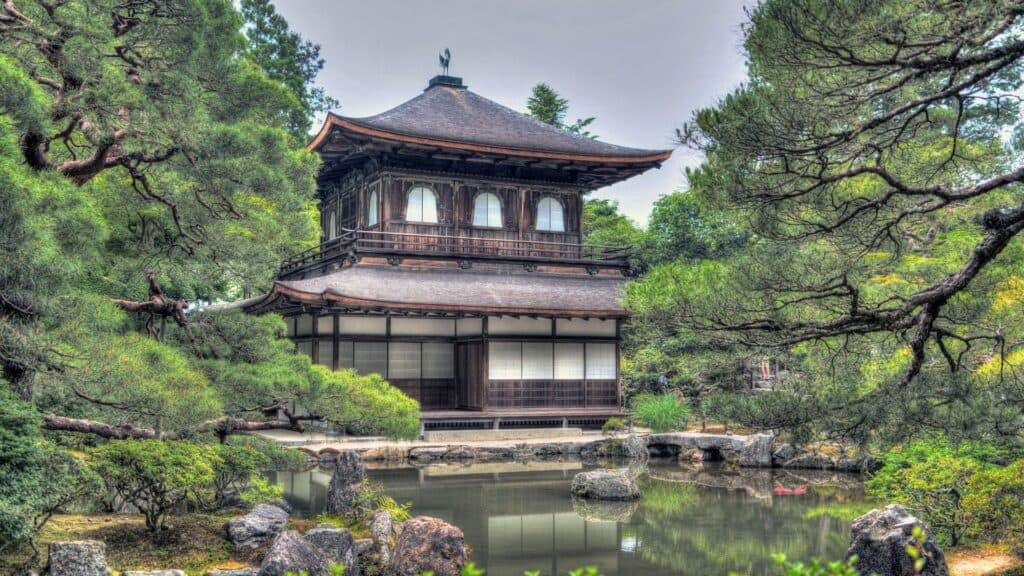
Kyoto boasts an abundance of temples and shrines, offering a genuine cultural experience of Japan. Don’t miss the famous Kinkaku-ji, Kiyomizu-dera, Arashiyama, and Fushimi Inari Taisha, among others. Explore the Gion area and visit other famous spots such as Shōren-in Monzeki, Chion-in, and Yasaka Shrine within Maruyama Park.
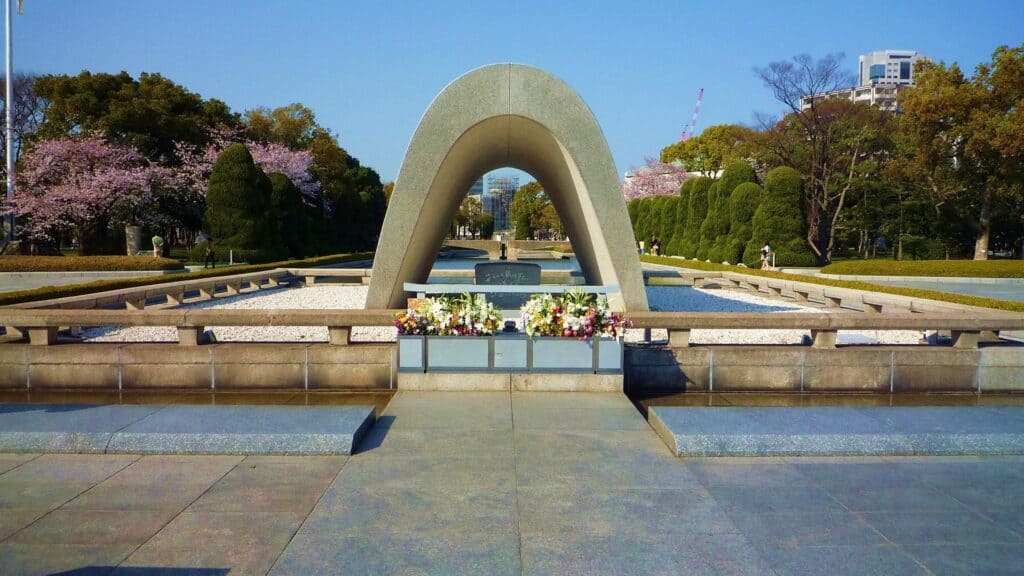
Hiroshima holds significant historical importance, and you can delve deeper into its history at the Hiroshima Peace Memorial Museum, Hiroshima National Peace Memorial Hall, Hiroshima Castle, and Hiroshima Prefectural Museum.
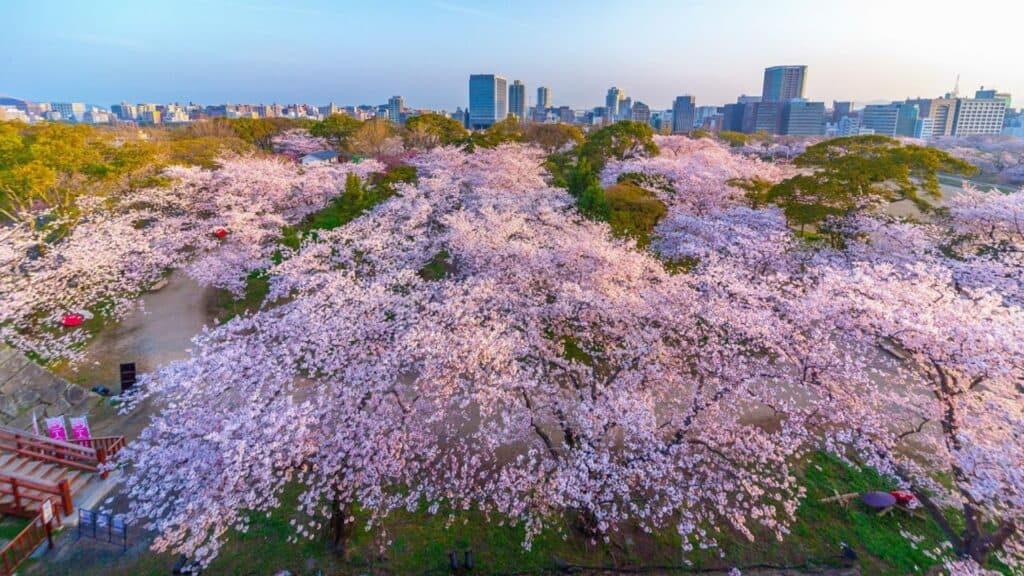
Fukuoka, situated in Kyushu, offers not only a bustling city centre but also neighbouring towns and cities with stunning natural beauty. Sample the delicious Fukuoka cuisine and street food, and explore attractions like Hakozaki Shrine, Waka Hachimangu Shrine, Chikuzen Sumiyoshi, Maizuru Park, and Tochoji Temple.
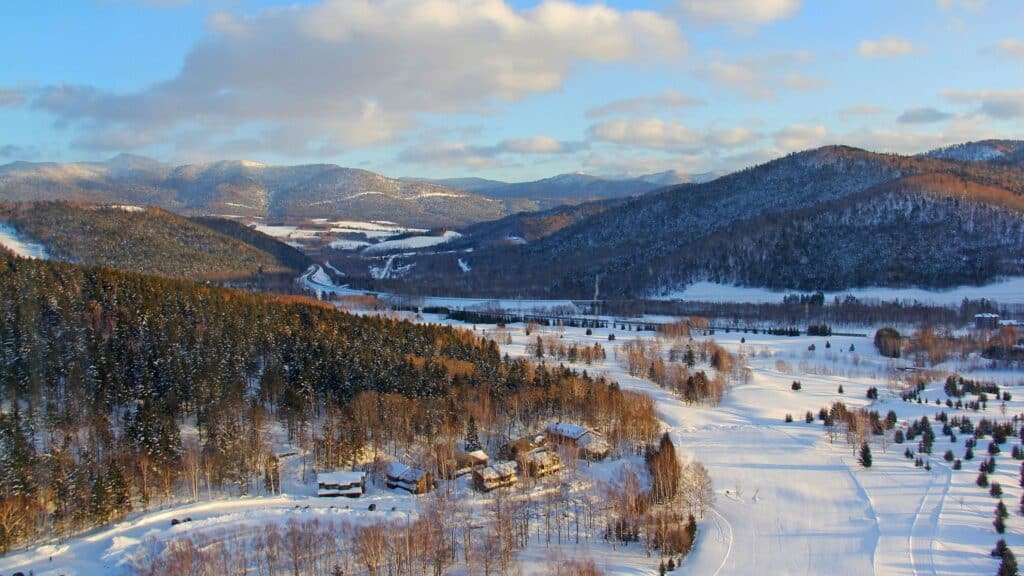
Hokkaido, the northern prefecture of Japan, is a popular destination, particularly in winter for its pristine powder snow. Explore the capital Sapporo, nearby cities Otaru and Hakodate, the renowned ski resort Niseko, and numerous other stunning natural sites.

For those who relish summer and warm weather, Okinawa beckons. Located in the southern prefecture of Japan, Naha serves as the capital of Okinawa, offering a variety of local food and historical structures. Dive into Okinawan culture at the Okinawa Prefectural Museum & Art Museum, and explore the various islands, each with its own unique offerings, ideal for immersing in nature and relaxation.
Read, Set, Travel!
Venturing into Japan for the first time is an exhilarating journey of discovery and cultural immersion. From the vibrant cityscapes of Tokyo to the tranquil temples of Kyoto, Japan offers a rich tapestry of experiences waiting to be unravelled.
Whether you’re indulging in Osaka’s gastronomic delights, exploring Hiroshima’s poignant historical sites, or embracing Hokkaido’s natural wonders, each destination presents a unique facet of Japan’s diverse landscape.
While planning may initially seem daunting, meticulous research and preparation will ensure a tailored itinerary that caters to your interests and preferences. Embrace the spirit of adventure, keep an open mind, and immerse yourself in the warmth of Japanese hospitality and tradition.
So, with bags packed and curiosity ablaze, embark on this transformative voyage through the Land of the Rising Sun. Your inaugural trip to Japan promises to be an unforgettable odyssey, brimming with cherished memories and enriching experiences.
Recent Posts
- Get Exclusive Views of Shibuya Crossing From These 5 Tokyo Observatories
- Sky-High Delights: 12 Tokyo Observatories Worth Visiting
- Top 23 Instagrammable Restaurants and Cafes in Tokyo: Captivating Visual Feasts
- Navigating Japanese Nightlife: 11 Must-Visit Types of Bars and 10 Useful Hacks for Rocking the Bar Scene
- Discover the Top 24 Instagrammable Spots in Tokyo
Recent Comments
- Tere Bellido on Autumn in Japan: 60+ Spots to Enjoy Autumn Leaves (Koyo) from September to December
- Vijay Singh on Ultimate guide to Zamami Island in Okinawa: What to do and hidden gems
- Lori on Overnight & Weekend Trip Ideas from Tokyo
- Robie on How much does it cost to live in Japan? You might be surprised
- Sidney Johnson on How much does it cost to live in Japan? You might be surprised

The Ultimate Itinerary for a Trip to Japan: Unforgettable 7, 10 and 14 Day Journeys (Updated 2024)
Some destinations reward spontaneity – in Europe, cheap flights and rail passes give you the freedom to wake up in the morning and choose your next destination on a whim. Japan, on the other hand, rewards forward planning.
The country’s abundance of both natural and manmade attractions, combined with its high standard of living and general efficiency, make it a fairly pricey destination. The more you plan, the better you can mitigate the damage to your wallet, and get the most out your trip – no matter how long you plan to stay.
These itineraries are designed to inspire you to build your own trip. Based around a few key highlights that represent both modern and ancient, they’re crafted to give you a rich and satisfying experience of Japan in 7, 10 or 14 days. Let’s jump right in!
Psst: want more tips for planning a trip to Japan? Check our rail pass guide and cheap eating tips .
- 1 Getting Around
- 2 7 Day Itinerary: Tokyo and Mt Fuji (Fuji Five Lakes)
- 3 7 Day Itinerary: Osaka, Kyoto and Nara
- 4 10 Day Itinerary: Tokyo, Mt Fuji and Kyoto
- 5 10 Day Itinerary: Osaka, Kyoto, Nara and Hiroshima
- 6 14 Day Itinerary: Tokyo, Mt Fuji, Osaka, Kyoto, Nara, and Hiroshima
Getting Around
Before we get to the itineraries, there's one important piece of planning to keep in mind – whether or not to get a JR pass . A Japan Rail (JR) pass is exclusively available to tourists, and grants you unlimited travel on JR trains within Japan, including the world-famous bullet trains. Depending on your itinerary, this will save you time and money vs buying individual train tickets within Japan. But importantly, you must purchase the pass before you arrive in Japan . We recommend ordering from Klook for their low prices and 10-day global delivery.
We've marked the itineraries that we recommend the JR pass for below, but for a more in-depth guide, be sure to read our full guide The Japan Rail Pass: Is It Worth The Cost?
7 Day Itinerary: Tokyo and Mt Fuji (Fuji Five Lakes)
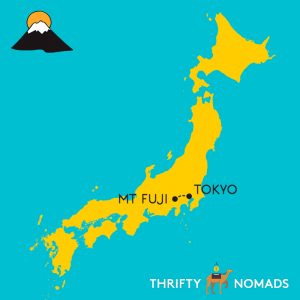
Get the essentials of urban and rural Japan with four days in the unforgettable capital, followed by three days of reflection and recovery under the shadow of Mt Fuji.
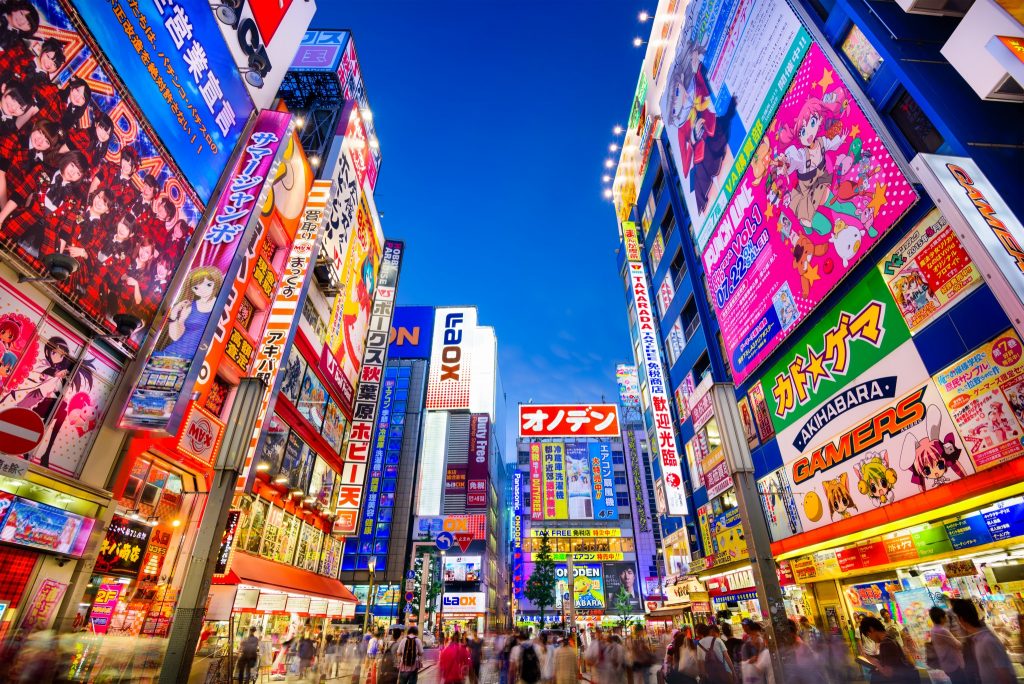
Tokyo: 4 Days
- Highlights: Go crazy in Japan’s frenetic, eclectic and incomparable capital. Live out a manga fantasy in Akihabara , drink shoulder to shoulder with locals in Roppongi , and see the world’s largest metropolis in 360 degrees from the top of the Tokyo Tower . And for an immersive digital art experience, check out the popular teamLab Planets TOKYO Museum .
- Where to stay: Public transport is comprehensive, so search far afield. Roppongi neighborhood if you like nightlife, Shinjuku to be close to the beating heart. Use TripAdvisor to compare hotel and hostel deals across all booking sites along with thousands of reviews.
- What to eat : Chains like Sushiro ($1 / plate train sushi) and the ubiquitous Gyudon houses like Yoshinoya can get you a delicious local meal for a budget price. Check out a Maid Cafe for an authentic (if risque) local experience!
Mt Fuji: 3 Days
Tip: If you don't have 3 days to spend in Fuji, you can book a full day tour from Tokyo .
- Highlights: See why this 3776 meter high mountain has inspired artists, writers and pilgrims for countless centuries. Soak up the volcanic waters in the Five Lakes District , a major tourist destination since the 1920s, it’s still possible to get away from the crowds and immerse yourself in nature.
- Where to stay: The Five Lakes Region contains a wealth of hotels and resorts. If you’re striking out, try a bit further away from (but still in plain view of) the mountain in Hakone district. Compare across booking sites with TripAdvisor's hotel search.
- What to eat: Try the regional speciality: udon noodles, often served cold in a delicate, flavorful sauce.

7 Day Itinerary: Osaka, Kyoto and Nara
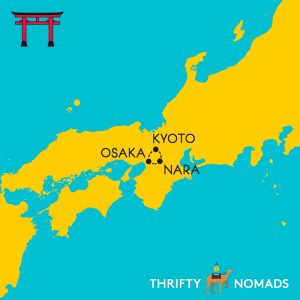
Osaka: 3 Days
- Highlights: Japan’s second biggest city is a microcosm of everything that magnetizes visitors to the country. Gaze in awe at giant plastic sea creatures and effusive street vendors in Dōtonbori , wander among the tuna merchants at the fish market, and connect with history at the 16th century Osaka Castle . Get to know Osaka like a local with a highly-rated walking tour .
- Where to stay: Try AirBNB and trust the train network if you find a good option a little outside of town. For hotels and hostels, compare across booking sites using TripAdvisor .
- What to eat : The same budget chains in Tokyo will serve you well here (I practically moved in to my nearest Sushiro!), but you really must try the street food on Dōtonbori .
Kyoto: 2 days
- Highlights: After the urban grunge of Osaka, it’s time to embrace the Japan’s spiritual side at the ancient seat of empire. It’s still possible to see Geisha in the historic Higashiyama District, which you can even explore by rickshaw , and the subtle beauty of temples like Kinkaku-ji is simply too much to put into words. Make sure you catch everything there is to see with a custom-made walking tour with a local . Go!
- Where to stay: Downtown Kyoto is the most convenient spot for sightseeing and will allow you to cover much of the historic town on foot. Try Airbnb or compare hotels and hostels across booking sites with TripAdvisor .
- What to eat : Restaurant prices can be steep so take a trick from the locals and stock up on tasty (and filling) instant meals at chain stores like the ubiquitous 7/11
Nara: 2 days
- Highlights: Stick with the theme of history but swap the Geisha for sacred deer in Nara , Japan’s capital from AD 710 to 794. In Nara park you can sip green tea in a traditional “Chaya” tea house and watch the deer frolic over 700 year old ground. Hire a local guide to make sure you catch it all!
- Where to stay. While it’s possible to day trip from Osaka, the town is well worth staying overnight – guest houses are abundant and there are even hotels in the historical park! You can compare all your options and find the best price using TripAdvisor .
- What to eat . Vegetarian food and pickled delicacies are the local specialities, due to the surrounding mountains and buddhist communities.

10 Day Itinerary: Tokyo, Mt Fuji and Kyoto
Got 10 days? Let’s do it right. Take a deep dive into the capital, cleanse yourself with nature in Mt Fuji and the surrounding 5 Lake District, and transport yourself back in time in Kyoto – a rich overview that will leave you feeling refreshed, satisfied and exhilarated.
For this itinerary, we recommend a JR pass . It will save you precious travel time on the bullet train, and save you money on train fares between, and within, Tokyo and Kyoto. Remember to order your pass BEFORE you enter Japan (we recommend Klook ). If you're still unsure, be sure to check out our in-depth guide on whether the JR pass is worth it .
- Highlights: Lose yourself among the neon lights of Shibuya and have a drink at the Monster Cafe . Watch locals transform themselves into Manga characters on an anime/gaming tour in Akihabara , drink hot sake with locals in Roppongi, and let digital art completely immerse your senses in Japan’s unforgettable capital.
- Where to stay: Public transport is comprehensive so search far afield. Roppongi neighborhood if you like nightlife, Shinjuku to be close to the beating heart.
- What to eat : Tokyo has unlimited dining options – if you’re on a budget, try Gyudon and brave the budget chains where it’s still possible to order with ancient vending machine located by the kitchen!

- Highlights: Make all your instagram followers jealous as you soak up the steamy volcanic waters under the shadow of Japan’s largest and most famous mountain.
- Where to stay: The Five Lakes Region near the mountain contains a wealth of hotels and resorts. If you’re striking out, try a bit further away from (but still in plain view of) the mountain in Hakone district.
Kyoto: 3 days
- Highlights: The twin temples Kinkaku-ji and Ginkaku-ji (gold pavilion and silver pavilion) have been carrying out an architectural and spiritual debate for centuries. It’s still possible to see Geisha in the historic Higashiyama District, which you can even explore by rickshaw . Make sure you catch everything there is to see with a custom-made walking tour with a local .
- Where to stay: Downtown Kyoto is the most convenient spot for sightseeing and will allow you to cover much of the historic town on foot.
- What to eat : Live out a warrior fantasy at the Samurai Restaurant . It’s a bit kitsch and definitely designed for the tourists, but so what – you’re on holiday!
10 Day Itinerary: Osaka, Kyoto, Nara and Hiroshima
Get the best of Japan today and yesterday in racey Osaka, tranquil Kyoto and serene Nara, before coming face to face with perhaps the darkest period of Japan’s history at Hiroshima.
For this itinerary, we recommend a JR pass . It will save you tons of travel time on the bullet train to Hiroshima, and save money on train fares within the Osaka/Kyoto/Nara area. You need to order your pass BEFORE you enter Japan (we recommend Klook ). If you're still unsure, be sure to check out our in-depth guide on whether the JR pass is worth it .
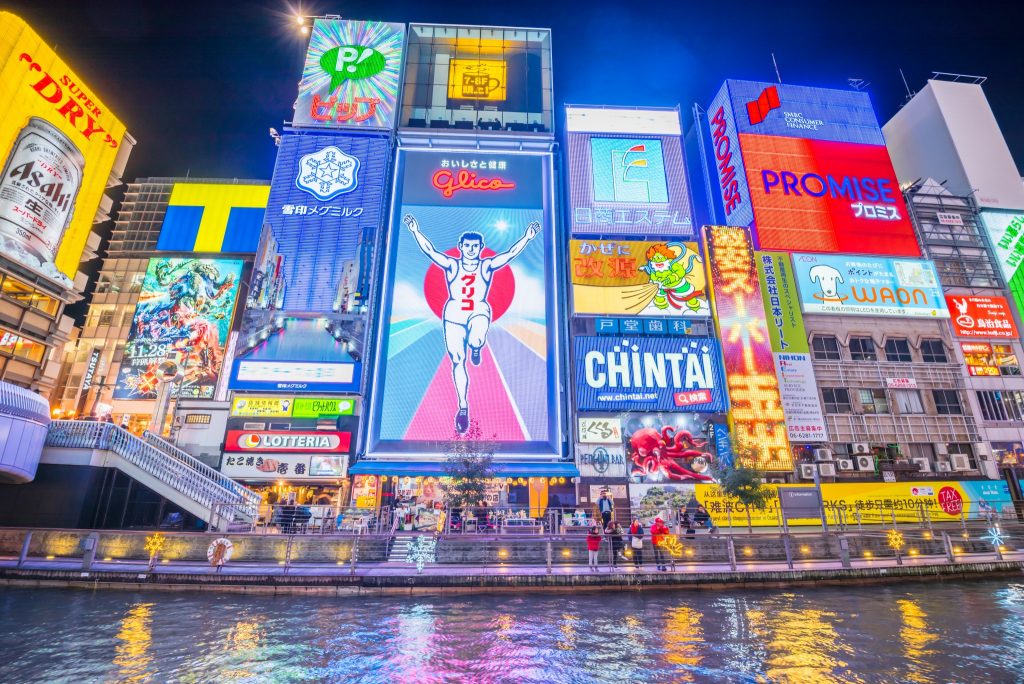
- Highlights: “Forget Tokyo,” I was told when I planned my first trip to Japan, “Go to Osaka!” While the capital is awesome, Japan’s second city more than holds its own. Here you can gaze in awe at giant plastic sea creatures and effusive street vendors in Dōtonbori, wander among the tuna merchants at the fish market, and connect with history at the 16th century Osaka Castle. Get to know Osaka like a local with a highly-rated walking tour .
- Where to stay: Try AirBNB and trust the train network if you find a good option a little outside of town.
- What to eat : Try the street food on Dōtonbori! A nightfood tour will help you find the best spots and eat where the locals eat!
- Highlights: Say goodbye to the furious pace of modern Japanese city life, and embrace the tranquil, spiritual and ancient in Kyoto. Believe it or not, but it's still possible to see Geisha in the historic Higashiyama District, even from a rickshaw . The gentle beauty of temples like Kinkaku-ji is simply too much to put into words. Make sure you catch everything there is to see with a custom-made walking tour with a local . Go!
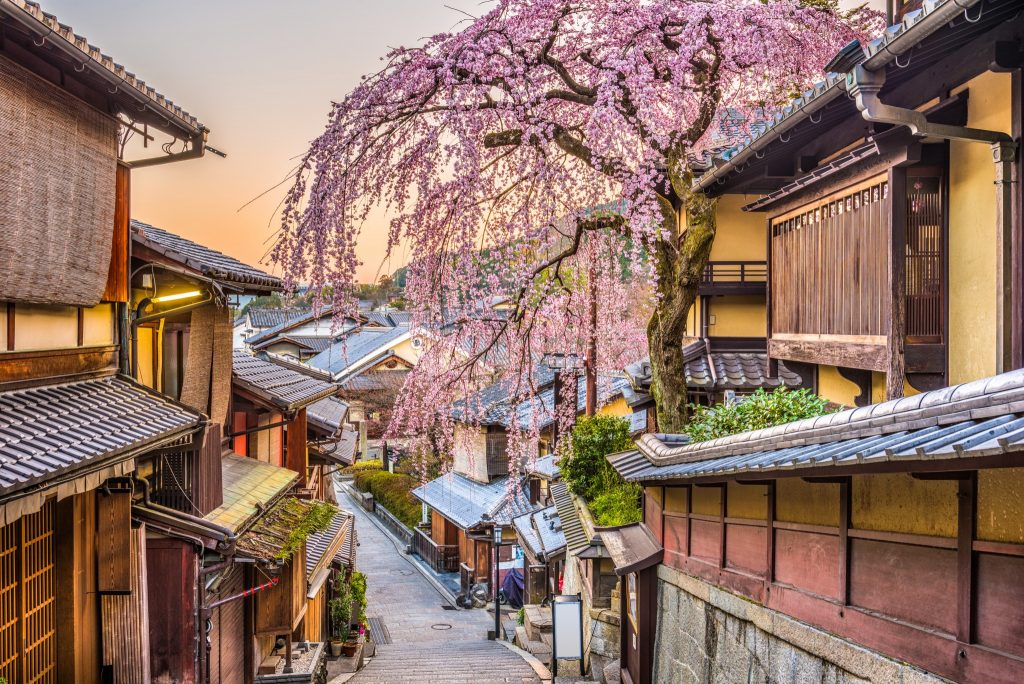
- Highlights: In Nara park you can sip green tea in a traditional “Chaya” tea house and watch the deer frolic over 700 year old ground. Hire a local guide to make sure you catch it all!
- Where to stay. While it’s possible to day trip from Osaka, the town is well worth staying overnight – guest houses are abundant and there are even hotels in the historical park!
- What to eat . Thank the Buddhist communities in the surrounding mountains for the abundance of local vegetarian food.
Hiroshima: 2 days
- Highlights : Infamous for its more recent history (which you can learn from a local on a cycling tour ), the rebirth of Hiroshima from ashes into a vibrant modern city is reason to visit in itself. In addition to haunting museums and poignant relics to the nuclear attacks, Hiroshima is the gateway to rural Chūgoku , a chance to tip your toes into Japan’s unspoiled wilderness.
- Where to stay : Hiroshima is drenched in hotels. Stay near the train station for convenient access to the city center and surrounding attractions.
- What to eat : Try the local okonomiyaki, a delicious, savory grilled pancake smothered in sauces and toppings.

14 Day Itinerary: Tokyo, Mt Fuji, Osaka, Kyoto, Nara, and Hiroshima
This is an itinerary for people who want it all! You’ve got two weeks, you’ve got your rail pass , and you’re going to jolly-well make the most out of your time. Well, if you’ve got the energy, then here’s how it could be done. It’s everything you see above, rolled into one epic itinerary for the bold and brave.
For this itinerary, we definitely recommend a JR pass . With the distance being covered from the east to the west of country, the amount of time and money this will save is a no-brainer. You must order your pass BEFORE you enter Japan (we recommend Klook ). But if you're still unsure, be sure to check out our in-depth guide on whether the JR pass is worth it .
- Highlights: Start with the blast of energy, neon, weirdness and glamour that is Japan’s capital. Opportunities for entertainment are virtually unlimited – feel the awe of the emperor at the imperial palace, indulge in a retail fantasy in Ginza, and finish the day with a well needed pint of Asahi in Roppongi.
- Where to stay: Public transport is comprehensive so search far afield. Roppongi neighborhood if you like nightlife, Shinjuku to be close to the beating heart. Use TripAdvisor to compare hotel and hostel deals across all booking sites along with thousands of reviews.
- What to eat : The real question is what NOT to eat. You could go to a different restaurant in Tokyo everyday for 20 years and still not run out of options. If you’re on a budget, look to the local fast food chains – if you’re on a tight budget, trust to the 7/11!
Mt Fuji: 2 Days
- Highlights: Hear a rumble? Fuji-san isn’t just a stunning, snow capped mountain, it’s still an active volcano! Soak up the volcanic waters and watch Fuji’s towering form from the Five Lakes District , a popular spot for locals and and travelers.
- Where to stay: The Five Lakes Region contains a wealth of hotels and resorts. If you’re striking out, try a bit further away from (but still in plain view of) the mountain in Hakone district. Compare across booking sites with TripAdvisor's hotel search.
- What to eat: Try the regional speciality: udon noodles, often served cold in a delicate, flavorful sauce.
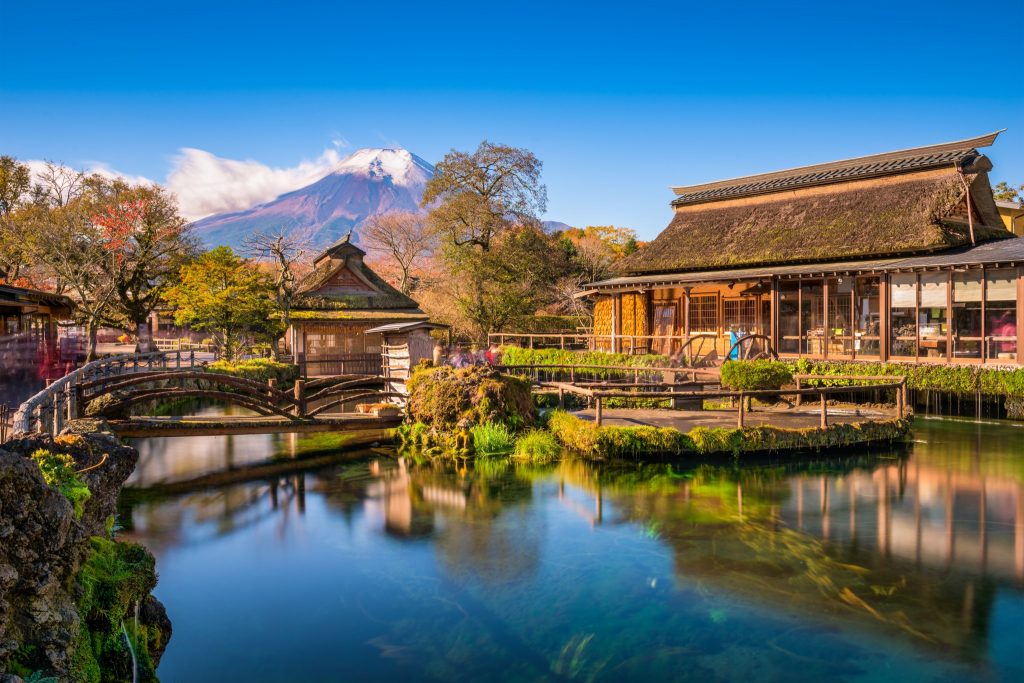
Osaka: 2 Days
- Highlights: Japan’s second biggest city is a microcosm of everything that magnetizes visitors to the country. Gaze in awe at giant plastic sea creatures and effusive street vendors in Dōtonbori , wander among the tuna merchants at the fish market, and connect with history at the 16th century Osaka Castle .Get to know Osaka like a local with a highly-rated walking tour .
- Where to stay: Try AirBNB or TripAdvisor and trust the train network if you find a good option a little outside of town.
- What to eat : The same budget chains in Tokyo will serve you well here (I practically moved in to my nearest Sushiro!) but you really must try the street food on Dōtonbori .
- Where to stay: Downtown Kyoto is the most convenient spot for sightseeing and will allow you to cover much of the historic town on foot. Try Airbnb or compare hotels and hostels across booking sites with TripAdvisor .

- Where to stay. While it’s possible to day trip from Osaka, the town is well worth staying overnight – guest houses are abundant and there are even hotels in the historical park! You can compare all your options and find the best price using TripAdvisor .
- Where to stay : Hiroshima is drenched in hotels. Stay near the train station for convenient access to the city center and surrounding attractions. Check both Airbnb and TripAdvisor for the best prices.
With the abundance of incredible places to visit in Japan, the only trouble you'll have with planning a trip here is which itinerary to follow. Tell us, what are your must-visit's on a trip to Japan?

Plan a Trip to Japan: Your Ultimate Guide
Plan a trip to japan: everything you need to know.
Are you planning a trip to Japan? From traditional tea ceremonies to neon-lit streets, Japan offers a unique blend of modern and ancient culture. With so much to explore, it’s important to be well-prepared. In this post, we’ll guide you through all the essential things you need to know before you embark on your Japanese adventure. We’ll cover everything from the best time to visit Japan and how long to spend in different cities, to the must-have items in your packing list and travel etiquette that will help you navigate the country like a pro.
By the end of this post, you’ll be ready to pack your bags and explore some of the most beautiful destinations in Japan.
How To Plan a Trip To Japan
1. Research and decide on your itinerary: Start by researching the different cities and attractions in Japan that you would like to visit. Consider how long you have for your trip and prioritize the places you want to see.
2. Determine the best time to visit: Japan has distinct seasons, each offering its own unique experiences. Consider factors such as weather, festivals, and crowd levels when deciding the best time to visit.
3. Book your flights: Look for affordable flights to Japan and compare prices from different airlines. Remember to book early to secure the best deals.
4. Arrange accommodations: Research and book using sites like booking.com and airbnb
What To Pack For Japan
When traveling to Japan, there are some essential items that you shouldn’t forget to pack. One of the most important things to bring is a universal travel adapter. This will ensure that you can charge your devices no matter where you are in the country. Additionally, it’s a good idea to pack an umbrella, as you can buy one from almost every corner store in Japan. The weather can be unpredictable, so having an umbrella on hand will come in handy.
To navigate the language barriers in Japan, make sure to download translation apps like Google Translate. These apps can help you communicate with locals and understand signs and menus. Another item to pack is a comfortable and secure backpack. This will be useful for carrying your belongings during day trips and exploring different cities.
Lastly, don’t forget to bring a hand towel. In Japan, it’s common for public restrooms not to provide paper towels or hand dryers. Having a hand towel will come in handy for drying your hands after visiting the restroom or for hot and humid days.
By packing these essential items, you’ll be well-prepared for your trip to Japan and have a great time exploring the unique experiences this country has to offer.
How Long to Spend in Japan
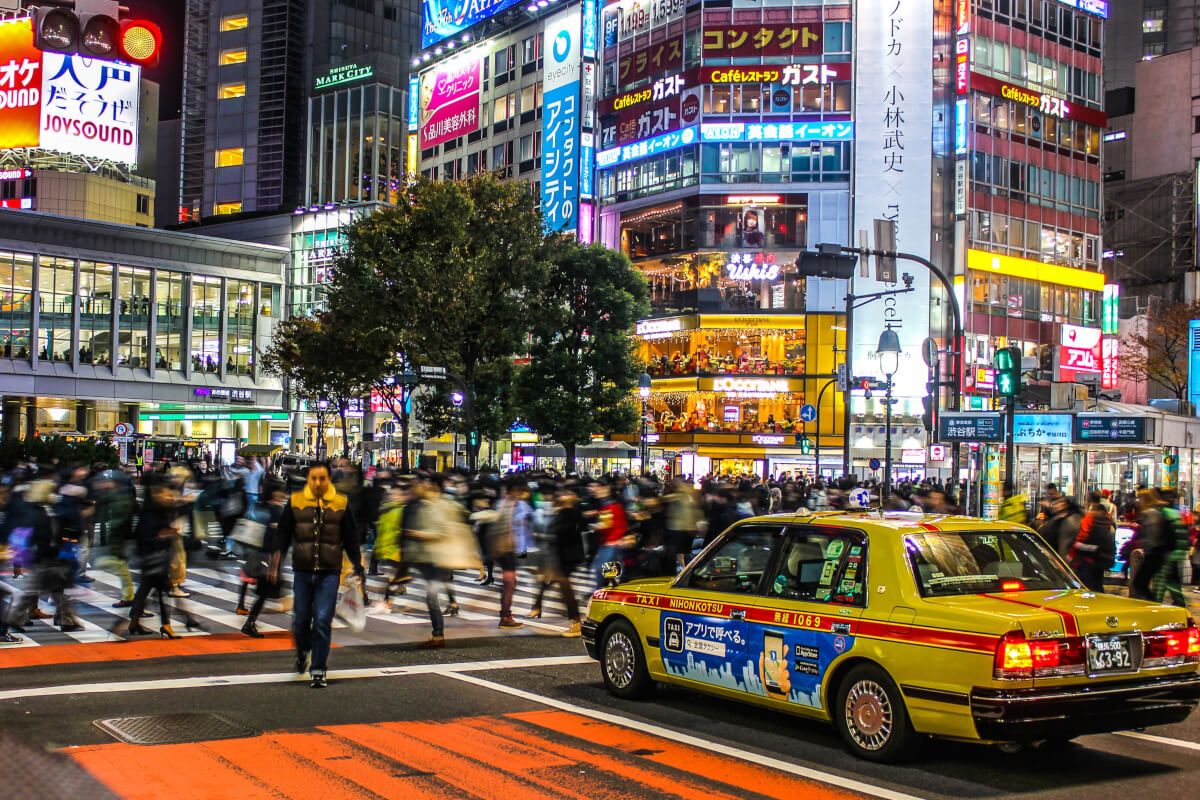
The duration of your trip to Japan depends on your interests and the places you want to explore. To get a good overview of major cities like Tokyo , Osaka, and Kyoto, it is recommended to spend a minimum of 10 days. This will give you enough time to immerse yourself in the vibrant culture and visit famous landmarks such as the Tokyo Skytree, Osaka Castle, and the Fushimi Inari Shrine.
If you want to venture beyond the cities and explore more regions or rural areas, consider planning for 2-3 weeks or even longer. This will allow you to experience the unique charm of places like Nara, known for its friendly deer, or Hiroshima, where you can pay your respects at the Peace Memorial Park.
Keep in mind that travel time between cities should also be factored into your itinerary. Japan’s efficient transportation system, including the famous Shinkansen (bullet train) and the convenience of a JR Pass, makes it easy to get around. However, it’s still important to allocate time for getting from one place to another.
No matter how long you decide to stay in Japan, make sure to account for any additional time you may want to spend on day trips or exploring hidden gems along the way. And don’t forget to check the weather and plan accordingly, especially if you’re visiting during the winter months or hoping to catch a glimpse of the beautiful cherry blossoms (sakura) in the spring.
When to Visit Japan
When planning a trip to Japan, it’s important to consider the best time to visit. One of the most popular times to visit is during cherry blossom season in April. You can witness the iconic pink blooms all over the country, creating a breathtaking sight. If you’re a fan of vibrant autumn foliage, November is the perfect time to visit. The leaves turn shades of red, orange, and gold, creating a picturesque backdrop for your trip.
However, it’s also crucial to avoid certain times of the year. One of these is Golden Week, which takes place in late April to early May. During this time, many Japanese people take time off, leading to crowded tourist spots. Additionally, it’s best to avoid traveling to Japan during the summer months as they can be extremely hot and humid.
On the other hand, if you’re a winter sports enthusiast, plan your trip between December and February. This is the prime time for skiing and snowboarding in Hokkaido, known for its pristine slopes.
For a more relaxed experience, consider visiting during less crowded months like October or February. This will allow you to explore Japan at your own pace and avoid the masses of tourists.
Overall, choosing the right time to visit Japan ensures that you make the most of your trip and have a memorable experience. Whether you want to see cherry blossoms, experience autumn foliage, or hit the slopes, planning accordingly will ensure a great time in this unique country. Good idea to plan your Japan trip during the winter months, you will get to see beautiful cherry trees covered in snow.
What Is The Best Season To Visit?
Japan is a country that captivates visitors with its beauty throughout the year. Each season offers a unique and enchanting experience. In spring, you can witness the breathtaking beauty of cherry blossoms in full bloom. The delicate pink and white petals adorn trees, parks, and streets, creating a picturesque landscape. It’s a sight that truly embodies the essence of Japan.
As the seasons change and autumn arrives, Japan transforms into a kaleidoscope of colors. The leaves on trees turn vibrant shades of red, orange, and gold, painting the landscape with stunning natural beauty. It’s the perfect time to take leisurely walks through parks and gardens, soaking in the splendor of the autumn foliage.
Summer in Japan brings with it traditional festivals like Obon and Tanabata. These festivals showcase the lively and vibrant culture of the country, with colorful parades, fireworks, and delicious street food. It’s a fantastic opportunity to immerse yourself in Japanese traditions and have a great time.
Winter months in Japan offer a different kind of charm. You can relax in hot spring baths , known as onsen, and enjoy the serene atmosphere they provide. The country also hosts snow festivals, where you can marvel at intricate ice sculptures and partake in winter sports activities. The world-famous Mount Fuji provides a breathtaking backdrop for these winter adventures.
With every season offering a unique and captivating experience, planning a trip to Japan is a great idea. Whether it’s witnessing cherry blossoms in spring, admiring autumn foliage, experiencing summer festivals, or enjoying winter activities, there’s always something special to explore. Japan truly is a destination that offers a wealth of experiences year-round.
How To Get Internet In Japan
Stay connected throughout your Japan trip by easily getting internet access. To ensure you have a seamless online experience, you have two primary options to choose from – pocket WiFi devices or SIM cards. Both options provide you with the convenience of staying connected on the go.
You can easily find rental options for pocket WiFi devices or SIM cards at airports, major train stations, and online platforms. This means you can pick up your preferred choice as soon as you arrive in Japan, making it hassle-free. With internet access, navigating your way around the country becomes much easier. You can use GPS apps, access maps, and get real-time updates on train schedules and routes.
Take a look at our article on The Best Pocket Wifi For Japan
Not only will having internet access make navigation a breeze, but it will also enhance your communication capabilities. You can easily stay in touch with your loved ones back home through messaging apps, make calls, and even video chat without any issues. Additionally, accessing travel information, such as finding the best places to visit or discovering local recommendations, becomes a lot easier with internet access.
Whether you’re a first-time traveler or a seasoned globetrotter, getting internet access in Japan is a good idea. It ensures you have a smooth and convenient experience throughout your trip. So, consider opting for a pocket WiFi device or a SIM card to stay connected and make the most out of your time in Japan.
Should You Get A JR Rail Pass? (Japan Rail Pass)
Consider getting a JR Rail Pass for unlimited travel on JR trains, including bullet trains, during your stay in Japan. It can save you money if you plan to explore various regions. Calculate ticket costs for your intended journeys to determine if it’s worth it.
Travel Insurance
Protect yourself against unexpected events during your Japan trip by purchasing travel insurance. It’s crucial to have adequate coverage for medical expenses, trip cancellation, lost luggage, and emergency evacuation. Before finalizing your policy, make sure to read the fine print to understand any exclusions or limitations. Comparing different insurance providers can help you find the best coverage at an affordable price.
When purchasing travel insurance, it’s a good idea to carry a copy of your insurance policy and contact information with you at all times. This way, you’ll have easy access to important details in case of emergencies. Remember, accidents can happen anywhere, so it’s essential to be prepared.
In Japan, you might encounter unique experiences like exploring Mount Fuji, relaxing in an onsen, or riding the Shinkansen. However, unexpected events such as natural disasters like typhoons or medical emergencies can disrupt your plans. Having travel insurance will give you peace of mind, knowing that you’re protected financially and can receive assistance when needed.
To ensure a great time in Japan, consider purchasing travel insurance before your trip. It’s a small additional cost that can save you from significant expenses and provide support in challenging situations. Don’t leave anything to chance when it comes to your well-being and enjoy your Japan trip with confidence.
Airbnb or Hotel for Accommodation
Choosing between Airbnb and a hotel in Japan depends on your preferences and budget. While Airbnb offers a unique and local experience, hotels provide amenities like room service and concierge assistance. Consider the location and accessibility before making a decision. Research reviews and ratings of both options for the best experience.
Book Tours and Activities
Enhance your Japan trip by booking tours and activities in advance. When planning your trip to Japan, it’s important to consider the various options available to make your experience truly unforgettable. From guided city tours to cultural workshops and food tasting experiences, there is something for everyone to enjoy. Researching reputable tour operators and reading reviews will help you make informed decisions and ensure that you have a seamless experience.
For a more personalized touch, consider joining small-group tours, which allow for a closer connection with the guide and fellow travelers. By booking in advance, you guarantee availability and save time during your trip, as popular tours and activities can get booked up quickly.
Whether you’re interested in exploring the bustling streets of Tokyo, visiting historic temples in Kyoto, or witnessing the beauty of Mount Fuji, booking tours and activities in advance is a great way to make the most of your time in Japan. Don’t miss out on the opportunity to discover hidden gems and immerse yourself in the rich culture and traditions of this fascinating country.
Remember to make the most of your Japan trip planning by considering your interests and preferences, as well as the best places to visit. Whether it’s your first time or you’re a seasoned traveler, incorporating tours and activities into your itinerary is a great idea to enhance your overall experience. Book in advance, and you’ll be sure to have a wonderful time exploring all that Japan has to offer.
How To Pay In Japan
When it comes to paying for your expenses in Japan, there are a few things to keep in mind. Cash is widely accepted, especially in smaller establishments. However, credit cards are becoming more popular and are increasingly accepted in larger businesses and tourist areas. It’s a good idea to carry some yen with you for places that don’t accept cards. Additionally, mobile payment apps like Apple Pay and Google Pay are also gaining popularity in Japan.
When using your credit card, be aware that some places may have a minimum spending requirement for credit card transactions. This means you may need to spend a certain amount before the establishment accepts your card as payment. So, it’s a good idea to have some cash handy just in case.
Overall, it’s important to have multiple payment options available during your trip to Japan. Whether it’s cash, credit cards, or mobile payment apps, having options will ensure that you can easily pay for your expenses without any hassle. Just remember to plan accordingly and be prepared for different payment methods depending on where you go.
How Much Yen Should I Bring To Japan?
When planning your trip to Japan, it’s important to consider how much Japanese yen you should carry. Make sure to have enough yen to cover your immediate expenses upon arrival. You can exchange currency at the airport or withdraw cash from ATMs. Having a mix of small and large bills is convenient for different purchases. If you’re traveling to remote areas with limited ATMs, it’s better to carry more yen. Also, check the current exchange rates and keep track of your expenses during your trip.
How To Use Japanese ATMS
When traveling in Japan, it’s important to know how to navigate the local ATMs. To access cash, look for ATMs at post offices, convenience stores, and banks throughout the country. However, before using an ATM, ensure that your card is compatible with international ATM networks. Some ATMs even offer language options for English-speaking users, making it easier to complete transactions.
While using ATMs in Japan, keep in mind any additional fees or foreign transaction charges that may be levied by your bank. To minimize these costs, plan ahead and withdraw enough cash to last you for the duration of your trip. By avoiding multiple ATM visits, you can save on potential fees.
Using Japanese ATMs is an essential part of your travel experience, as many places still rely heavily on cash for payments. Taking the time to familiarize yourself with the process will ensure a smooth financial journey throughout your adventure in Japan. So remember, locate the nearest ATM, check for compatibility, be mindful of fees, and plan ahead to avoid unnecessary hassle.
The best ATM I have found when traveling is the 711 ATMS – they fully support English, are open 24 hours and have very low fees.
Purchasing Tickets in Advance
When it comes to planning your trip to Japan, there are several advantages to purchasing tickets in advance for popular activities. One major advantage is the ability to skip the long queues that often form at attractions like Tokyo Disneyland. By booking your tickets ahead of time, you can save valuable time and avoid the frustration of waiting in line.
Another advantage is the opportunity to secure your spot for traditional Japanese tea ceremonies. These ceremonies are in high demand, and booking in advance guarantees that you won’t miss out on this unique cultural experience. Additionally, pre-purchasing tickets allows you to guarantee entry to limited-capacity events and exhibitions. Popular exhibits often sell out quickly, so by buying your tickets early, you can ensure that you don’t miss out on any must-see shows or displays.
Booking guided tours or activities in advance can also save you time and money. Many tour operators offer discounts for booking online, and having a pre-planned itinerary means you can make the most of your time in Japan without wasting valuable hours trying to organize activities on the spot. Finally, by purchasing tickets in advance, you can ensure availability for popular seasonal activities, such as cherry blossom viewing tours. These tours are in high demand during the spring, so securing your spot early is a good idea.
Overall, booking your tickets in advance for popular activities in Japan is a great way to save time and ensure a seamless travel experience. By skipping the queues, securing your spot, and avoiding disappointment, you can make the most of your trip and have a truly unforgettable time exploring all that Japan has to offer.
Must-Visit Destinations Requiring Advance Booking
Plan Ahead for Key Experiences in Japan:
Ghibli Museum:
- Immerse in the world of Studio Ghibli.
- Recommended to reserve tickets in advance.
Tsukiji Fish Market Tuna Auction:
- Witness a unique and lively auction.
- Book in advance due to limited spots.
Hiroshima Peace Memorial Museum:
- Gain insight into Japan’s history.
- Reserve entry ahead of time.
Ryokan in Hakone:
- Experience traditional Japanese hospitality.
- Book to stay and enjoy features like onsen (hot spring baths).
Robot Restaurant in Tokyo:
- Unforgettable entertainment with futuristic performances.
- Ensure a seat by booking in advance.
By planning and securing spots at these key destinations, you can optimize your Japan trip experience.
Travel Etiquette in Japan
When traveling to Japan, it is essential to respect the local culture and customs. Familiarize yourself with the concept of “omotenashi,” which emphasizes hospitality and respect. This cultural principle encourages visitors to show appreciation for the kindness and warm reception they receive. When visiting shrines and temples, it is customary to wash your hands before entering as a sign of purification. This small gesture demonstrates respect for the sacredness of these places.
Learning basic Japanese phrases such as “arigatou gozaimasu” (thank you) and “sumimasen” (excuse me) can go a long way in showing respect to the locals. Greeting shopkeepers or restaurant staff in their native language is greatly appreciated. Additionally, it is customary to remove your shoes when entering someone’s home or traditional establishments, so be mindful of this custom.
Respecting the peace and tranquility of public spaces is also important. Talking quietly and being aware of noise levels is highly valued in Japanese culture. Avoid causing disturbances or talking loudly, especially in quiet areas such as temples or on trains.
By following these travel etiquette tips, you can show your respect for Japanese culture and enhance your overall experience in the country.
Common Cultural Missteps to Avoid in Japan
When traveling to Japan, it’s essential to be aware of and respect the country’s cultural norms. To ensure a smooth and enjoyable trip, here are some common cultural missteps to avoid:
- Eating and Drinking :
- Avoid eating or drinking while walking.
- It’s impolite to consume food/beverages on the go in Japan.
- Use designated areas like parks or restaurants for meals.
- Entering Buildings/Tatami Rooms :
- Avoid wearing shoes with excessive dirt or mud.
- Remove shoes or wear provided slippers at entrances.
- High standard of cleanliness is upheld in Japanese homes and establishments.
- Do not tip in Japan.
- Tipping isn’t customary and can cause confusion or embarrassment.
- Service charge is already in the bill.
- Blowing Nose :
- Blowing your nose in public is considered rude.
- Do so discreetly in private, like in restrooms or using a handkerchief.
- Personal Space and Physical Contact :
- Be mindful of personal space.
- Avoid hugging and excessive touching.
- Maintain a respectful distance during interactions.
By familiarizing yourself with these cultural guidelines, you’ll show respect and appreciation for Japanese customs, enhancing your overall experience in this fascinating country. Remember, traveling is not just about the sights but also about immersing yourself in the local culture.
Is There a Language Barrier in Japan?
While English may not be widely spoken in Japan, most tourist areas have English signs and menus. Overcoming the language barrier is possible by learning basic Japanese phrases, using translation apps or pocket dictionaries, and hiring local guides who can help with language and cultural nuances. Japanese people are generally helpful and willing to assist tourists.
What Souvenirs Should You Bring Back from Japan?
Consider bringing back a taste of Japanese culture with traditional tea sets or matcha tea powder. Indulge in unique snacks like regional Kit Kats or explore handcrafted ceramics and wooden crafts. Don’t forget stylish stationery or even a beautiful kimono or yukata for a memorable souvenir.
Unique Japanese Products to Look Out For
When exploring Japan, there are plenty of unique products that you should look out for. In the world of skincare, Japanese products are renowned for their quality and effectiveness. Take the opportunity to try popular items like sheet masks and cleansing oils, which can leave your skin feeling rejuvenated and refreshed.
Japan is also known for its innovative and quirky gadgets. From heated toilet seats to self-warming coffee mugs, these gadgets offer a glimpse into the country’s advanced technology and love for convenience. Trying out these gadgets can be a fun and unique experience during your trip.
Another aspect of Japanese culture that you must explore is their tea. Japan is famous for its green tea, particularly varieties like matcha and sencha. Not only do they taste great, but they also come with numerous health benefits. Don’t miss the chance to savor the different flavors of Japanese green tea during your visit.
If you’re interested in traditional textiles, Japan has a lot to offer. Look out for kimono fabric or tenugui towels with intricate designs. These textiles showcase the rich cultural heritage of Japan and make for unique souvenirs or décor items.
Lastly, consider purchasing a traditional Japanese knife. Known for their exceptional craftsmanship and sharpness, these knives are sought after by chefs around the world. Owning one can be a great way to bring a piece of Japan’s culinary tradition back home with you.
Planning a trip to Japan? Keep an eye out for these unique Japanese products that will make your experience even more memorable.
Planning Your Itinerary
When planning your itinerary for a trip to Japan, it’s essential to strike a balance between experiencing the country’s rich traditional heritage and its modern attractions. Japan offers a unique blend of historical landmarks, vibrant cityscapes, and futuristic technology, ensuring that you have a diverse and fulfilling travel experience.
Start by exploring the historical side of Japan, visiting iconic destinations like Tokyo and Kyoto. Tokyo, the capital city, is known for its bustling streets, skyscrapers, and vibrant neighborhoods. Kyoto, on the other hand, offers a glimpse into the country’s past with its beautiful shrines and temples. Don’t forget to include lesser-known gems like Kanazawa and Takayama, which provide a more intimate and authentic experience of traditional Japan.
To immerse yourself in Japanese culture, consider participating in a traditional tea ceremony or staying in a ryokan, a traditional Japanese inn. These experiences allow you to appreciate the country’s customs and traditions firsthand. And when it comes to getting around, using an IC card will make traveling on public transportation more convenient and hassle-free.
In addition to the traditional attractions, Japan also boasts a thriving modern side. From technological marvels like the shinkansen (bullet train) to futuristic cityscapes, there’s plenty to explore. Whether you’re fascinated by the latest gadgets or want to experience the fast-paced energy of cities like Tokyo and Osaka, modern Japan has something for everyone.
By planning your itinerary to include both traditional and modern attractions, you’ll have a well-rounded experience of all that Japan has to offer. So go ahead and create an itinerary that allows you to soak in the history, culture, and innovation of this incredible country.
Frequently Asked Questions
How much does an average japan trip cost.
The cost of a trip to Japan can vary depending on factors like duration, accommodation, transportation, and activities. On average, a 10-day trip for one person can cost around $1,500-$2,500 (excluding flights). Budget travelers can save by staying in hostels and using public transport. High-end travelers may opt for luxury accommodations and private tours .
How Much Should I Spend On A Trip To Japan?
The cost of a trip to Japan varies depending on factors such as duration, accommodation, activities, and food. A budget trip can cost around $50-70 per day, while a mid-range trip can cost around $100-150 per day. Luxury trips can cost upwards of $300 per day. Plan ahead and budget accordingly for a stress-free trip.
Is $5000 Enough For A Two Week Trip To Japan?
$5000 can be sufficient for a 14-day journey to Japan, based on your travel style and itinerary. Budget wisely for accommodation, transportation, food, and activities, considering your preferences and priorities. Utilize public transportation passes and opt for budget accommodations to save money. Plan ahead to maximize your budget and time in Japan.
Is Japan Expensive For Vacation?
Japan offers a range of expenses for vacation, depending on your travel style and budget. While accommodation, transportation, and food costs can add up quickly, there are ways to save money by opting for hostels or local street vendors. Research and planning ahead can help you make the most of your trip to Japan.
Do You Need A Visa To Visit Japan?
Depending on your nationality and the length of your stay, you may or may not need a visa to visit Japan. Some countries allow their citizens to enter Japan without a visa for a short-term stay, while others require a tourist visa. Check with the Japanese embassy or consulate in your country for visa requirements.
Should I Learn Japanese Before Visiting Japan?
While it’s not necessary, learning some basic Japanese phrases can enhance your experience in Japan. While English is widely spoken in major tourist areas, outside of those areas, communication can be challenging. Knowing Japanese can make interactions with locals more enjoyable. Many resources like language apps and classes are available for learning Japanese.
How Much Does The Shinkansen Cost?
The cost of the Shinkansen, or bullet train, depends on the distance traveled and the type of ticket you choose. Prices can range from around 3,000 to 15,000 yen per journey. Consider purchasing a Japan Rail Pass for unlimited travel on Shinkansen and other JR trains within a designated period.
When Is Autumn In Japan?
Autumn in Japan typically begins in late September and lasts until early December. The exact timing varies depending on the region, so it’s best to check specific locations for accurate information. Autumn is a popular time to visit Japan, as the foliage turns vibrant shades of red and orange, creating stunning landscapes.
When Is Typhoon Season?
Typhoon season in Japan typically ranges from May to October, with the peak occurring in August and September. It is advised to stay updated on weather forecasts and follow any advisories or warnings issued by the authorities during this time.
Published on
Lyn Dickinson
thanks for the information, very helpful and interesting
Leave your comment (Cancel Reply)
How to teach english in japan, restaurants in japan, japanese toilets: dive into the world of japanese bidets.


- PLAN MY TRIP
- All Destinations
- Discover Hokkaido
- Discover Honshu
- Discover Kyushu
- Discover Shikoku
- THINGS TO DO
- Japan Travel Deals
How To Plan Trips To Japan
4 comments

When it comes to travel planning, they do kind of have a point.
When you start out, there can be dozens of questions that need answering when trip planning...
- How long should we travel for?
- Where will we go?
- How much do we need to budget?
- What type of accommodation should we focus on?
- What are the essential things to do?
- Can we do it all by ourselves, or should we book some guided trips?
...and so on, and so on.
In this post I’ll share with you the 5 stages of travel and how to get the most out of each of them by planning ahead. Along the way, I'll share how I approach each of them, and how you can create your own ‘travel planning formula’ to make your trip planning easier and your travel more fulfilling.
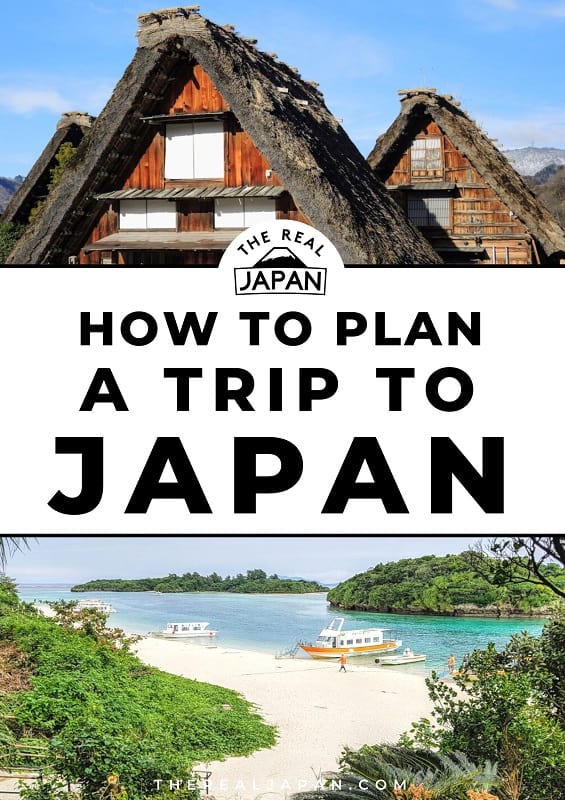
How to Plan a Trip to Japan
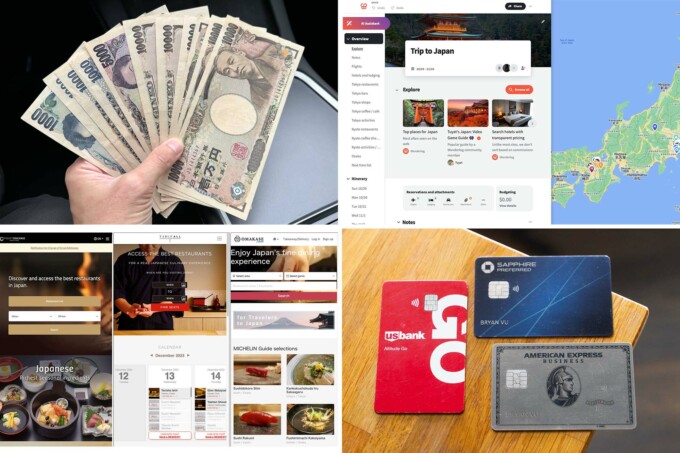
Japan is one of my favorite places to visit, but planning our trip to Japan can be quite a massive undertaking. From picking the right time of the year to visit to booking restaurants and buying train tickets, I’ve written down the best way on how to plan a Japan trip below including all the things we wish we knew before planning or visiting Japan.
All of this planning was necessary to dine the places we did. See our post on the best restaurants in Tokyo , the best things to do in Tokyo , as well as the best things to do in Kyoto . All of this would have been much harder or impossible to schedule and experience without proper planning!
Plan at least 6 months ahead
I would highly recommend booking your trip at least 6 months in advance (if not more). If you can’t buy tickets this early, I would still begin planning ahead of time because many restaurants, experiences, and activities will have specific release dates that may be as early as 6 months in advance.
- Flights : usually available 6-12 months ahead. ZipAir runs out of full-flat seats 2-3 months ahead.
- Restaurants : if you like fine dining restaurants, the most popular ones book up 3-6 months in advance.
- Hotels: I recommend at least 3-6 months ahead (earlier if you want to use a hotel concierge to your advantage to book restaurants). We booked 3 months in advance, and rooms didn’t run out, but options definitely were noticeably starting to thin out.
Trip planning tools
Use these planning tools to ease the stress of planning a trip to Japan.
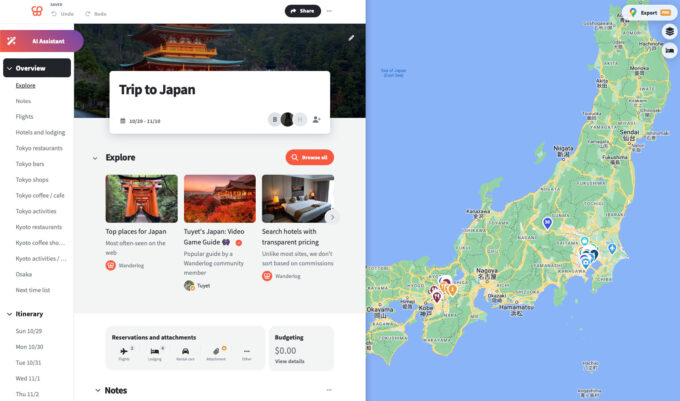
- Premade guides – gives you suggestions on popular tourist spots and restaurants
- Detailed organizer – it keeps detailed notes of all your information, like everyone’s flights, hotel stays, budget and costs, itinerary, and more.
- Visual mapping – it also has a handy map to help you visualize your itinerary or other places you’ve saved.
- Mobile app – there’s also a mobile app that comes in handy during your trip.
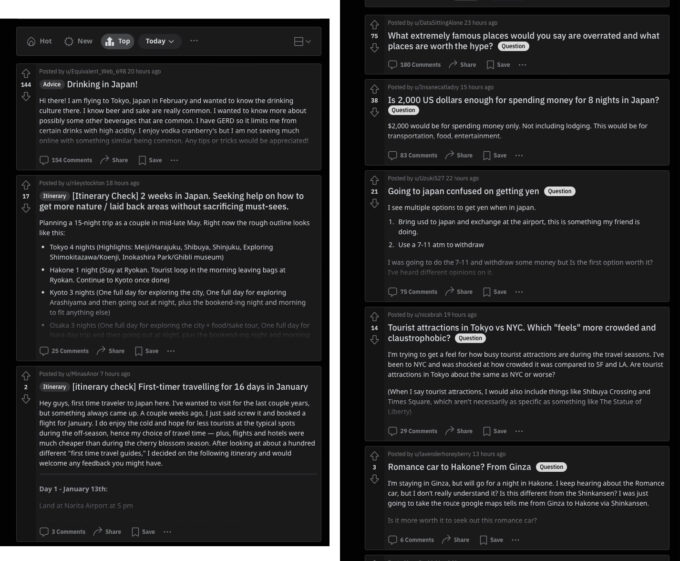
- r/JapanTravel – people help critique your itinerary and add suggestions. It also has an extensive guide under the community info for almost every situation you’ll encounter.
- r/JapanTravelTips – gives basic tips and suggestions on making the best out of your trip
- Hole-in-the-wall spots – search your destination, “Japan,” “Tokyo hotels,” “Kyoto food,” etc, to find new spots to eat or cool experiences like finding a matcha farm tour
- Souvenir tips – helps you start a list of things to buy as souvenirs, whether that’s Japanese skincare or specialty snacks to bring home.
Best time of year to visit Japan
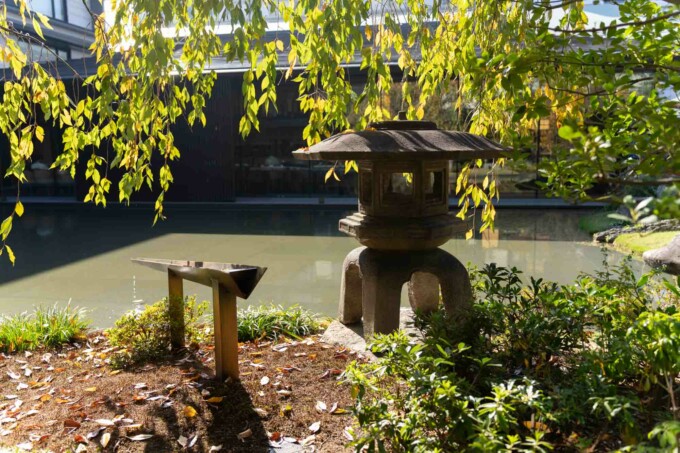
The best times to visit Japan throughout the year is during the
- Spring (March to May) – to see the cherry blossoms
- Fall (October to November) – to see the autumn leaves. There are sites that track the weather and leaves throughout the year, like the Japanese Meterological Corporation , so you know when to visit. Note that weather can be finicky, and this year, the foliage came over two weeks later than usual.
- Summer (June-August) – this is during the off-season so there are fewer tourists. Also great if you can only travel during the summer due to family schedules, but avoid it if you are heat-sensitive
- Winter (December-February) – also the off-season and good timing if you like winter sports like skiing or snowboarding, but note that the weather can be harsh and cold.
Make sure to look up Japanese holidays while planning your trip because this can cause more local tourists or restaurants and shops to be closed down. For example, we visited Kyoto during Culture Day, on a 3-day weekend, and the streets were absolutely packed with restaurant reservations being incredibly difficult to get.
Decide on your trip length
Many people are restricted by the number of vacation days they have for a Japan trip. Ideally if you are visiting Japan for the first time, at least two weeks is recommended because there is an endless list of places to visit, things to do, and eat. If you’re visiting from the US, like us, plan for at least one full day of travel to Japan and one full day to fly home.
- 5-7 days: For my first trip to Japan, I only had one week to explore one large city, Tokyo. I didn’t have enough time to venture out into other prefectures or towns.
- 10-14 days: On my second trip, I allotted almost two weeks and split my time between Tokyo and Kyoto (much smaller than Tokyo). This was enough time to visit without running out of things to do. It allowed me to explore more casually. We planned one main activity to do daily in order not to burn out during our trip.
I liked using the r/JapanTravelTips and r/JapanTravel subreddits, where you can submit your itinerary, and people can help you flesh out your plans fully. This also gives you more ideas on places to eat and visit.
Deciding which cities to visit
Different cities provide different activities, cultures, food, and overall experiences. Here’s a quick guideline of the most popular cities in Japan.
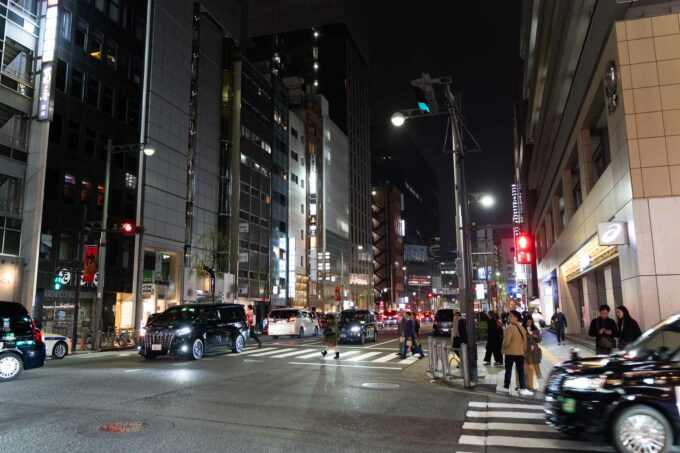
- Tokyo (at least 5 days): If it’s your first time visiting, I would try to spend the most time in Tokyo because it’s the largest metropolitan area. There are several cities throughout Tokyo that offer different experiences, like Shibuya is the center of young fashion and shopping; Ginza is for luxury goods and fine dining; Kappabashi is for kitchen and restaurant shopping; or Akihabara, which is the anime district. We ate non-stop in Tokyo , and there were so many more restaurants we didn’t get to visit!
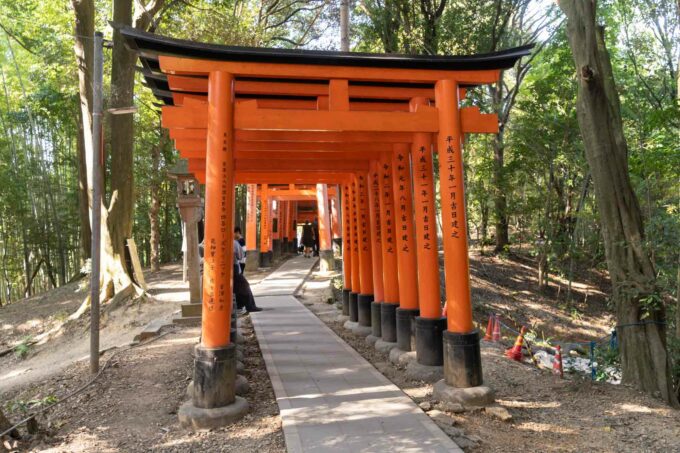
- Kyoto (3-4 days): This city, which was once the capital, is very different from Tokyo. You’ll find several shrines and temples throughout Kyoto, as well as many tourists. While it’s a lot slower-paced in Kyoto, don’t let this vibe fool you because there are equally as many fun and interesting things to do in Kyoto than other cities. We spent only four days here but could’ve spent a couple more to explore the region. You can also take day trips to nearby areas. Kyoto is also near the Uji and Wazuka, the matcha capitals of the world. We traveled to d:Matcha in Wazuka to learn about growing and producing matcha–this was one of the coolest tours we’ve taken. Nara is another day-trip spot near Kyoto where people love to feed the bowing deer and watch traditional mochi pounding.
- Osaka (2-3 days): If you like a fast-paced lifestyle, you might want to check out Osaka–an hour train ride from Kyoto. Some popular spots in Osaka are the lively nightlife of Dotonburi and touristy Kuromon fish market. We missed Osaka on this trip and asked a bunch of locals if we made a mistake. Surprisingly many of them said it’s ok to miss since Osaka feels like a mini Tokyo and we were already spending a good amount of time in Tokyo!
Note, if you plan on moving between cities, I would recommend using a luggage transfer service so you don’t have to painfully move luggage in a train station. We used the luggage transfer service through our hotel. Make sure to ask how long the transport will take because it can typically take between 1-3 days, depending on where you’re traveling and the weather.
We moved luggage from Kyoto to Tokyo, which took one day of travel. When we checked into our hotel in Tokyo, our luggage was already in our hotel room. I believe the cost was under $20 per luggage, but it was well worth it. On our first hotel transfer we didn’t use it, and had to roll luggage into train stations, up and down escalators, and when we couldn’t find the elevators we had to carry them by hand up and down, which may be impossible depending on your luggage’s weight.
Reserve restaurants 6-12 months ahead
Eating was one of our top goals in Japan because we love Japanese food, especially sushi. We found it extremely difficult to book highly rated restaurants (above 4 points on Tabelog or Michelin-rated), and some restaurants had a 6 month lead time. Check out the best restaurants in Tokyo from our trip .
Luckily, almost every restaurant we saw lets you cancel or make changes to your reservation if plans change. These vary by restaurant, typically, you’ll need to notify at least 24 hours before your reservation time. Some restaurants charge a fee of around 10% of your meal cost to cancel or make changes within 1-7 days of the reservation.
Finding restaurants. We used TikTok and Tabelog to find the best restaurants to reserve. Tabelog is Japan’s Yelp, but more discerning. Remember, Japan has higher standards for reviews, so their 4 out of 5 stars is more like 4.5 by American standards. We also used Google reviews to find restaurants while we were in Japan.
Making reservations. Most restaurants in Japan require you to book on third-party sites and without a direct booking option:
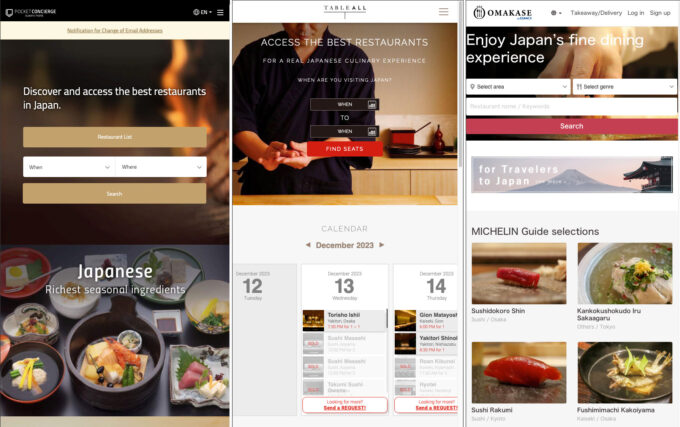
- Pocket Concierge
Booking fees. Many of these websites add handling fees (¥300-5,000 or $2-33 USD), so be aware of this addition. You may also be asked to pay the full cost of the tasting menu ahead of time to reserve your seat. Many of these reservations have strict cancellation fees, so make sure to read up on each restaurant before reserving.
A powerful hotel concierge will be helpful, especially for places that are call-in only. Some hotels have a list of restaurants they have good relationships with and can help you. Note that some hotels will not make same-day reservations because they want to keep a good rapport. After booking your hotel, you can contact the concierge via email and have them set up reservations ahead of time. You need to give them your credit card details, and they will book it through a phone call or website.
Don’t want the headache of booking reservations or planning a trip at all? Consider doing a premium tour for access to restaurants that are more difficult for tourists to book. There are tour groups specific to eating in Japan, like IFoodStory or Hungry Tourist . Some of these tours still book at least 6 months in advance, so be sure to check the websites for availability.
Public Transportation
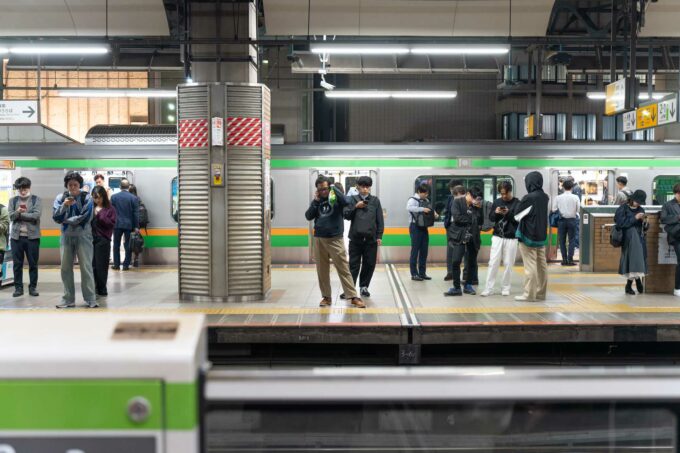
You’ll need a Metro pass to get around Japan. For traveling between cities farther apart, you must buy JR (Japan Railway) tickets for bullet trains (or shinkansen) from the station. JR trains are different from Metro tickets because they are owned by different companies. Some more remote destinations require using a taxi or taxi in addition to the railway.
Japan is known as one of the most complicated subway and Metro systems in the world. Even after using the New York City subway, Chicago’s Metro, and Washington D.C.’s Metro, Japan’s Metro is a whole new beast. However, there are some tips and tricks I can offer that make learning this public transportation easier on your brain when planning.
You will need a Metro card to use the public transportation system (trains, buses, and shuttles) in Japan, and a few of the most popular cards are Pasmo, Suica, and IC. In late 2023, there was a shortage of chips available, resulting in a halt in the sale of physical Metro cards.
Here are Metro pass options for tourists:
- Physical cards: “ tourist only” Welcome Suica or Welcome Pasmo card upon arrival at Haneda, Narita, or Osaka airports. To reload Welcome Metro cards, you must use the kiosks at the train stations and pay in cash.
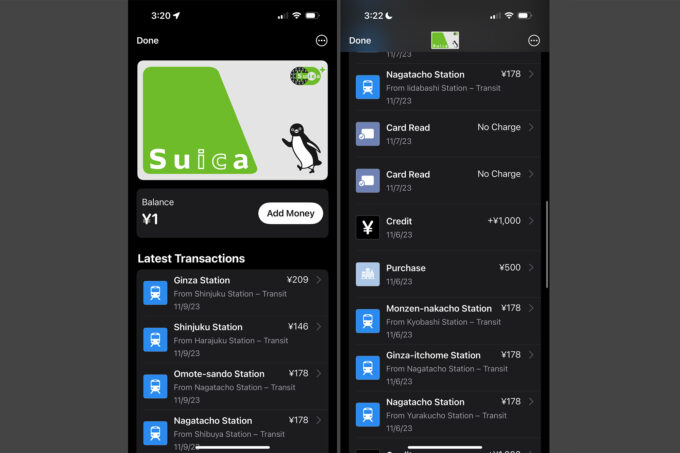
- Digital cards: Use an iPhone (Android does not work) to add a digital IC/Pasmo/Suica card. We used this option. Reloading digital cards is easy, and you can do so on your phone.
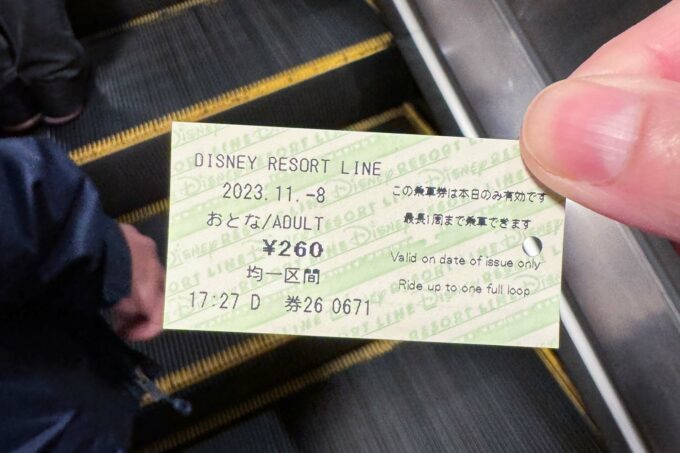
- Individual tickets: buying individual train tickets with cash or coins at the station every time you want to use the train
Using passes at Metro stations
To use a digital card , just tap your phone on the right-hand side of the gate before entering the station. You will also need to tap out at your destination station when exiting–make sure it registers because we forgot to tap out once and exited, and the card declined entry at our next location. We had to fix this issue with a staff worker at the info desk at a station.
You can also use both digital and physical cards at various stores like konbini, and many fast-food restaurants to buy items.
To use a physical individual ticket , you insert it into the turnstile and then collect it after passing. Then, at your destination station, you again insert it into a turnstile, and the machine keeps it.
Taking the Metro is significantly cheaper than using taxis or Uber (which is essentially the same thing in Japan). Where a Metro ride would cost $1, the taxi ride would be around $10-$20 for the same distance. However, you will need to walk to and from the train station, so you will be walking a lot more.
Google Maps was a lifesaver. Use Google Maps to help navigate the train stations and times. It tells you everything: the train and station names, the platform to board (including which car is the fastest to board with fewer people), what time to board (and sequential next trains), how many stops it will take, and the exit direction to leave the station.
JR Rail Pass
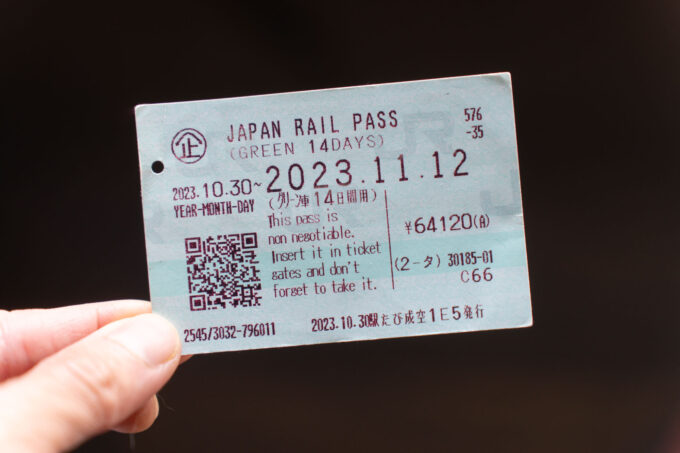
If you’ll be going to various cities across Japan throughout your trip, you might want to purchase a JR Pass. It’s made specifically for tourists, and you can use them for seats on bullet trains (or shinkansen) and JR trains. We purchased our JR Pass through Klook and were sent physical papers in the mail. We activated them on the day we arrived at Narita airport. There are also regional passes that cover part of Japan depending on the pass. JR trains also run throughout Tokyo central, and you will know it’s a JR train because there will be a J before the train line.
In October 2023, the price of an individual JR Pass rose from ¥ 29,650 to 50,000 (from $200 to $337 USD). Many people now choose to buy individual shinkansen tickets because they are more cost-effective. To determine if you need to buy a rail pass, use JR calculators online, like Japan Guide calculator . These calculators will figure out how much money each train will cost, and you can compare these prices to the price of the JR Pass. From our experience, if you are only going from Tokyo to Kyoto or Osaka, the JR Pass will not be worth the price. JR Pass also includes rides to and from both major airports on Tokyo Monorail for Haneda Airport and Narita Express for Narita Airport.
There are also two class levels on the Shinkansen: economy and first class (green car). The green car requires reservations ahead of time, even with the JR Pass, and you can also reserve oversized luggage. Green car seats are also larger and recline further for a comfier trip. Also note that the faster Shinkansen trains (Nozumi and Mizuho) are not included in the JR Pass.
Book flights early–for lay flats, lower prices
Figure out what kind of flights you want for this trip, which could be based on your budget and comfort level. We’ve tried several types of seats, from Economy to full lay-flat seats. Also, determine where you would like to fly based on your first city. If you are flying into Tokyo, there is Haneda Airport (HND), which is 20-30 minutes from Tokyo Station, and Narita Airport (NRT), which is almost 2 hours from Tokyo Station. If you’re flying into Osaka, there is Kansai Airport (KIX).
Try to book flights early to get good seats or prices. I used Google Flights to track prices and also frequently learned when airlines would release flights for the future. For example, ZipAir sometimes releases seats 11 months in advance.
Full-Flat Seats
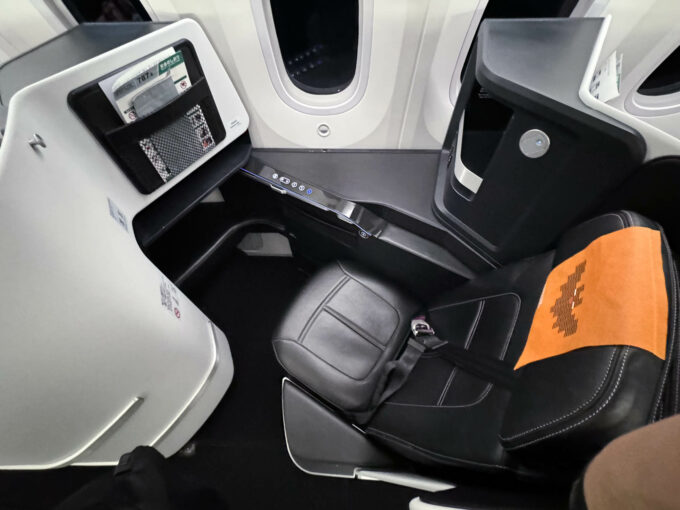
If you want full-flat seats for a more affordable price, I would recommend ZipAir full-flat seats, which is owned by Japan Airlines. There are only 18 seats per flight, which is perfectly roomy and comfortable. Just be warned that ZipAir only has one class level. That means everyone boards simultaneously, and there is no priority line for check-in.
ZipAir is also a budget airline, so that means your flight will be barebones. When purchasing your ticket, you can order value sets to add-on items like a meal, an amenity kit (blanket, pillow, socks), and check-in baggage. Some of these items may be available for purchase on the plane trip but may run out. On board, there is free Wi-Fi, and you can buy snacks too. We opted to bring our own travel pillows, blankets, and snacks, as well as order a meal for the flight. This was more than comfortable for us for the 10-hour plane ride. A one-way full flat seat from LAX to NRT (Narita) costs us $1,400; however, if you book early enough at the right time of the year, you can find full flat seats as low as $900 one way. Note that if you choose to ride ZipAir to Japan, it will only fly into Narita airport, which means it will take longer to get into Tokyo central.
Premium Economy
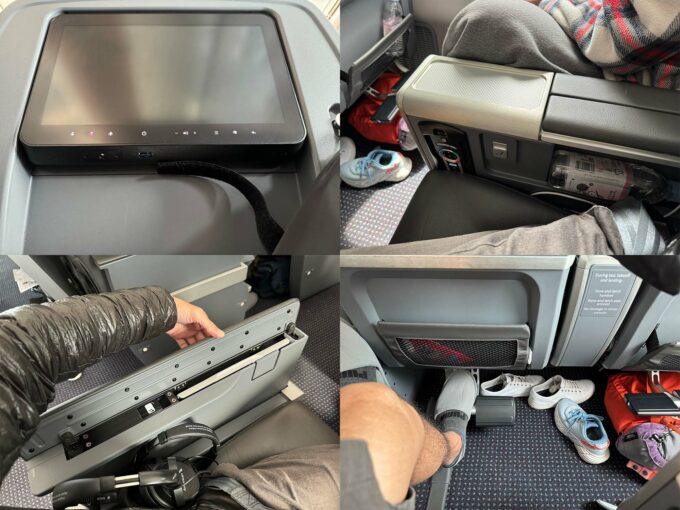
For our return flight, we booked a premium economy seat on American Airlines from HND (Haneda) to LAX for $$$$. With this upgrade, we could check in at the priority line and receive our bags first when we landed (a treat if you’ve ever landed at LAX). The seats were spacious and reclined more than basic economy. Since we prebooked our meals, we received just what we wanted since some dishes were sold out. We also were served our meals first. With an eight-hour flight, I could comfortably sleep on the plane even though it wasn’t full flat.
It’s been a long time since I flew to Japan for the first time, which was an economy seat. From our Premium Economy seats this time, we were seated just one row in front of Economy, though, so we were really able to see what it was like there.
The seat sizes were smaller, similar to the size of our domestic flight seats in the US. Instead of only 2-3 people per row, they were more crowded, 4-5 people per row, meaning you may have to step over many people if heading to the bathroom. Food and beverage service comes to the economy section after all the other seats are served. Strangely, we noticed that the food packaging and plates were plastic in economy (compared to our ceramic) with plastic utensils (instead of metal).
Apps & trip-planning tools
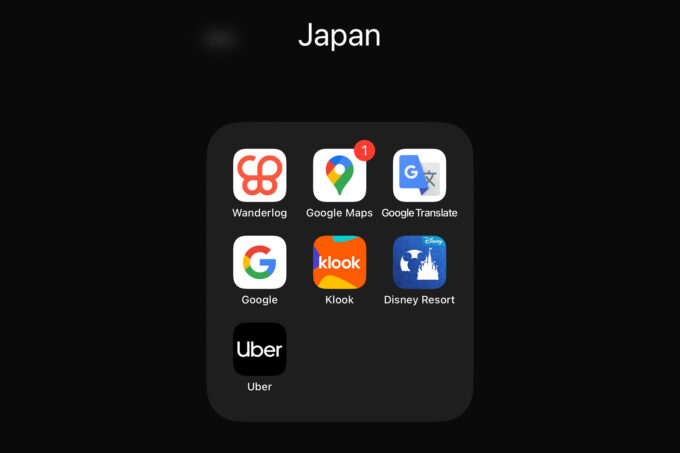
Here are my top used apps that helped plan our Japan trip and made traveling throughout Japan so easy. Many of these have both web-based versions as well as an app:
- Wanderlog : to help plan your itinerary and use it during the trip
- Google Maps : to get Metro directions and find restaurants with ratings
- JapanTravel : official Metro and shinkansen route guide
- Google Translate : to help translate signs, menus, and communicate with locals
- Google app : also helps you translate photos with Google Lens
- Klook : to purchase activities and tickets like JR Pass and Disney Tokyo tickets
- Disney Resort Tokyo : necessary for Disney visits because they only scan digital tickets.
- Uber : helps you order taxis during your trip. Make sure you’re signed up and logged in ahead of time since the SMS verification can be a pain.
Cellular service
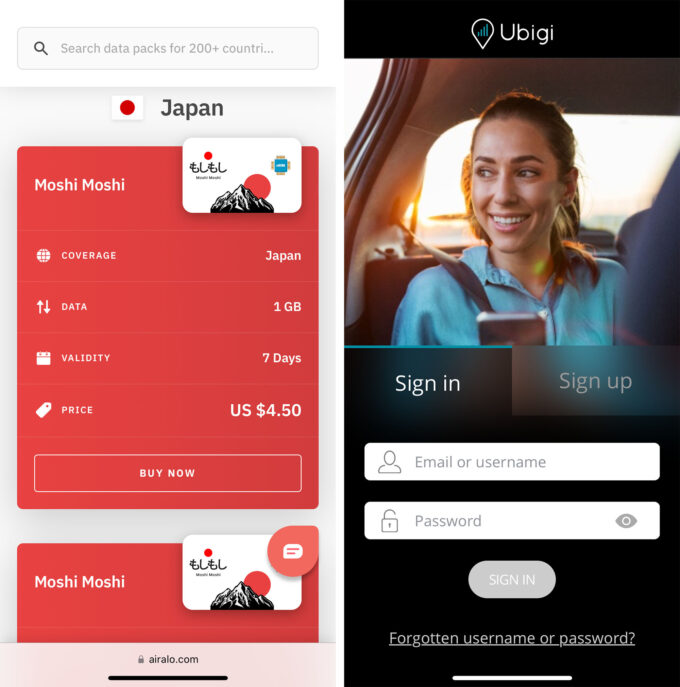
Figure this out ahead of time, because even in the comfort of our own home, the service we use had a few speedbumps to setup. You don’t want to be figuring this out after landing, or comparing pricing, etc. on a time crunch.
To get Internet access in Japan, use an eSIM. There are different brands to use, like Airalo and Ubigi . With an eSIM, you don’t need to carry around a pocket wifi device the entire trip or pick it up at the airport.
We downloaded the Ubigi app the day before traveling and purchased a 10 GB plan for our entire 10-day trip. One con of using Ubigi is the complicated set-up process, and it is not a process I’d like to repeat. However, I did like activating it once we landed with just a quick toggle on our phone settings, and we were ready to use data. If you do run out of data, you can easily purchase another plan on the app and use the data immediately if necessary.
Note that we didn’t choose the plan that included calling minutes, only data.
What to pack
Make sure you pack these useful things in your luggage to make traveling in Japan easier:
- Handkerchief to wipe your hands or sweat
- Light rain jacket for the Fall
- Sanitizer
- Airtag to help keep track of your luggage
- Hydro bandaids for potential blisters
- Small coin purse
- Mini Theragun for your tired legs
- Headphones for the train and shinkansen
Power outlets in Japan
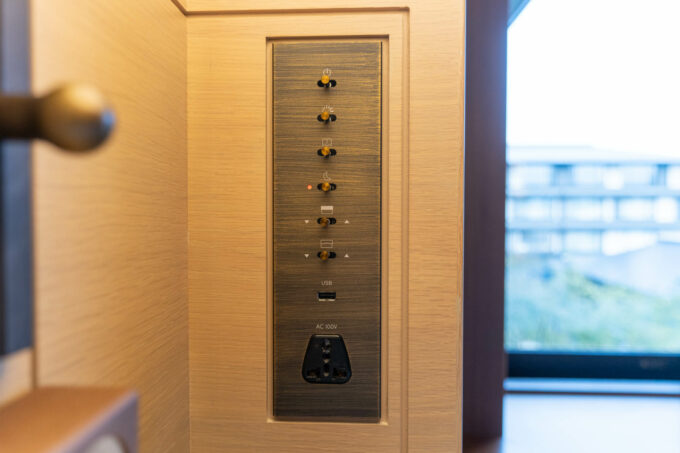
When packing hair appliances or chargers, make sure they fit the power outlets in Japan. The power outlets in Japan are 100V and a Type-A plug (two-prong). Any appliance from North American with the same two-prong, Type-A plug 100-120 V will work in Japan. Often times the hotel outlets would have outlets that already had plug adapters built in to accommodate many other plug types.
Additionally, voltage conversion was never an issue with our North American electronics. We easily used hair styling tools, like the Dyson Airwrap, phone chargers, camera chargers, laptop chargers, and Apple chargers easily, and I never needed to use an adapter in any hotel.
How much cash to bring
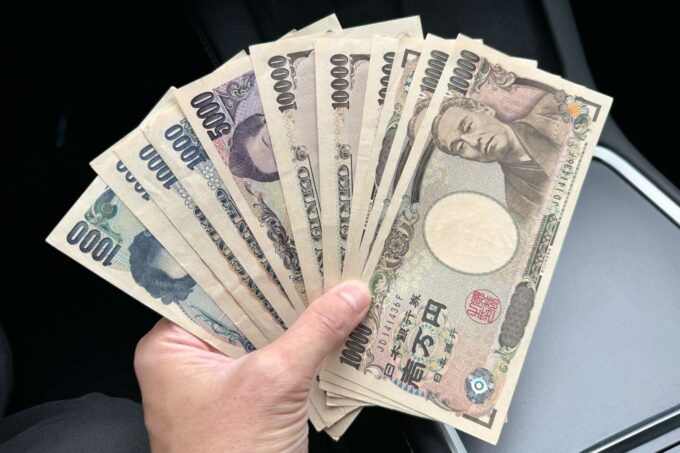
Some people say that Japan is more cash-based, but I would counter that–we spent about 80% on credit cards and 20% cash in all of our transactions for 10 days. We probably could have spent under 5% in cash for the trip, but we wanted to just spend what we brought instead of having to convert it later.
To make traveling easier, we exchanged yen at our local bank before we left. We brought ¥ 74,000 (or $500) for two people, but we didn’t need more than $150. All fine-dining places accepted credit, and we charged the majority of prix fixe payments online when we booked the reservation. Based on our experience, a very select few shops took cash-only. To see how much a Japan trip cost , see our breakdown in our detailed post .
Credit cards
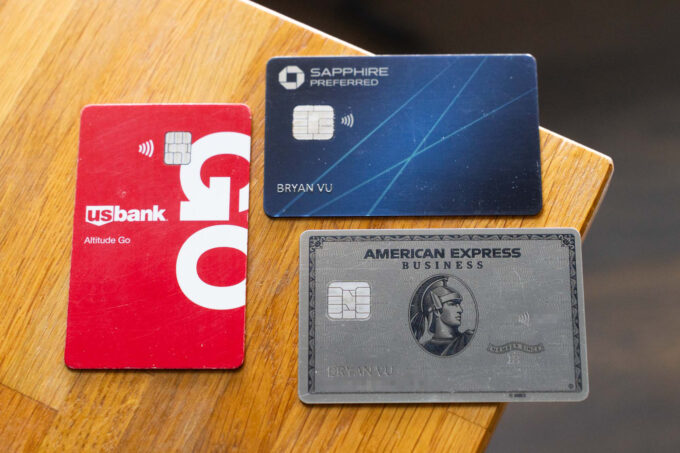
Definitely bring a credit card for purchases in Japan. Make sure your cards don’t have foreign transaction fees. The main ones we used that do not have foreign fees were:
- Chase Sapphire Preferred
- US Bank Altitude Go
- American Express Platinum
We were also warned that there might be problems with foreign Visa credit cards, and we did run into this a few times using the Chase Sapphire, and we had to switch to charging the Amex.
Here are some last-minute travel tips for Japan:
- Learn a few phrases in Japanese, like “arigatō gozaimasu” (thank you very much), “sumimasen” (excuse me), and “konnichiwa” (hello)
- Figure out what souvenirs you may want, this makes it easier to pick things up on the go because you may not return to that store or place again
- Fill out the forms on Visit Japan Web to make immigration easier when you land. You will get QR codes to scan at the entrance and get through the lines faster. However, don’t add two-factor authentication if you cannot receive SMS text messages in another country because you may get locked out–this happened to us. Once you pass through immigration, submit another form on the website to get the QR code for tax-free purchases. This helped a lot when we didn’t carry around our passports during shopping.
Like this recipe? Subscribe to my newsletter!
HOTEL THE MITSUI KYOTO Review [Japan]
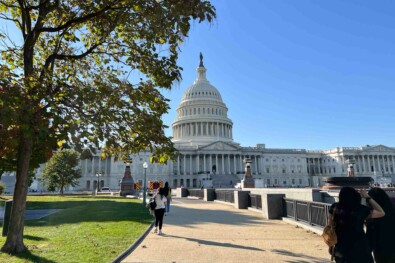
The 10 Best Restaurants To Try In Washington, D.C.
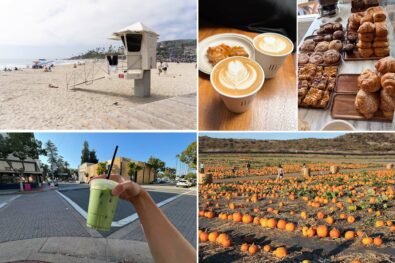
30 Best Things To Do in Orange County, CA (From A Local!)
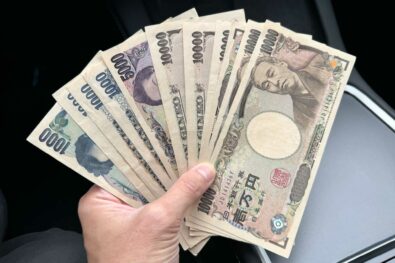
Japan Trip Cost: Our Actual 12-Day Trip Expenses
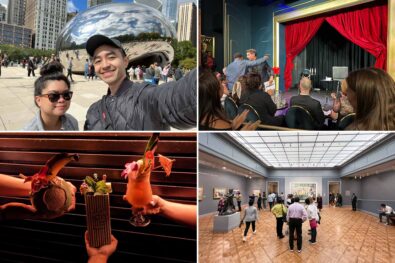
The 16 Best Things To Do in Chicago
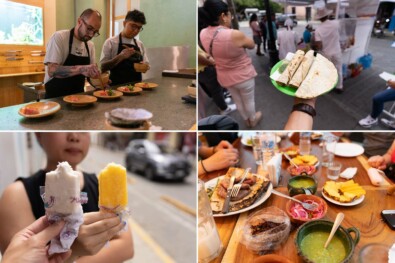
The 15 Best Restaurants in Oaxaca, Mexico
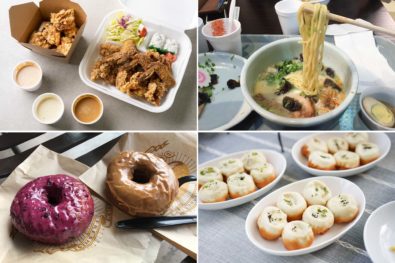
Protected: The 17 Best Restaurants in Costa Mesa, CA (From A Local!)
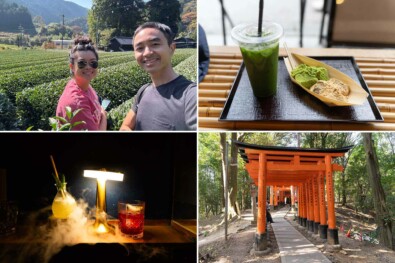
The 17 Best Things To Do in Kyoto, Japan
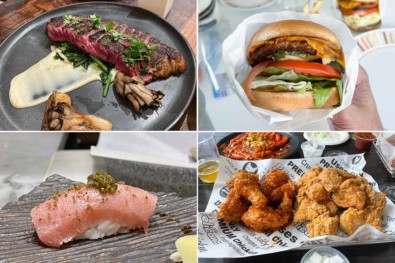
34 Best Restaurants in Orange County, CA (From a Local!)
Leave a Reply Cancel reply
Your email address will not be published. Required fields are marked *
Yes, I'd like to get updates by e-mail from Hungry Huy!
Get weekly recipe updates sent to your inbox!

Traveling to Japan for the First Time: Planning a 1-2 Week Trip Making your first trip to Japan an awesome one
May 8, 2012 • words written by Koichi • Art by Aya Francisco
Traveling to Japan for the first time can be overwhelming. I understand! There's a lot to see and do. That's why I put together a "first-timers" Japan travel itinerary, built on my 20+ years of traveling to and from Japan.
This sample trip is for people heading to Japan for 1 to 2 weeks (which seems like the standard visit time for most people). Of course, there are so many things to see in Japan besides those featured on this trip itinerary. That's why I broke the travel plan into a 2 week stint so you can customize your vacation, removing and adding things as necessary.
That said, I hope this is helpful to those of you visiting Japan for the first time.
Things To Know
There are a few important things to know that have nothing to do with the actual places. They are:
Whether you travel to Japan for one week or one-point-five weeks or two weeks, the general route stays the same. You'll do Tokyo area, then Kyoto, then Nara, then Koya, and then back to Tokyo. Throughout the route, I'll mark things as "optional" as well. If you're only staying a week, I'd recommend cutting out these things (unless you really want to go to them, then cut something else out). If you're staying for two weeks, you should be able to go to all of these places, and maybe even diverge off to other places. In fact, I highly encourage this! Go where you want – this route is merely a suggestion.
Also keep in mind that I'm just going to be providing locations. You'll have to do your own research as to how to get to them. Google and Google Maps helps a lot with this. I believe in you.
Whether you stay a week or two weeks, I'd recommend getting the JR Pass . This is like a magical golden ticket that gives you unlimited JR train rides (bullet train too) to anywhere around Japan. Not all things are free (for example, non JR trains as well as most subways), but if you take three rides on the Shinkansen that will usually make it worthwhile. You can get a JR Pass at jrpass.com (where I got my last one). Just be sure to take into account the time change when you schedule your ticket dates. Going to Japan involves traveling through both space and time.
Finding Places To Stay
I don't really cover places to stay in this article, just the places to go to. Finding someplace to stay is up to you, though there are plenty of resources out there that will help you. I recommend hostels for adventurers / students / people with no money (they're fun, cheap, and way less sketchy than other hostels I've been to). Guest houses are also great if you can find them. They tend to be a little cheaper than hotels, but the food / environments are a lot more interesting. And interesting is what you want when you travel to Japan.
Since this is a pretty standard trip, most of the places are going to be pretty bag friendly. I wouldn't bring a ton (lots of hotels have washing machines too), and would definitely recommend a backpack or something with wheels. Don't make the mistake of bringing something you're not comfortable carrying up and down long flights of stairs. You will run into a lot of these getting on and off trains, so if your biceps are tiny, only pack whatever you can lift (preferably less). Also, bring a lightweight duffel bag (or you can buy one) for the optional shopping you can do at the end of your trip.
That being said, let's get started! You have some traveling to plan.
Day 1: Fly Into Tokyo
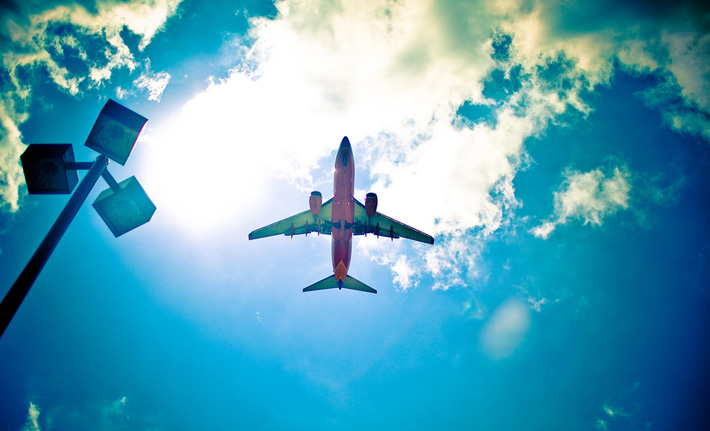
Flying into Tokyo isn't terrible, but it isn't great either. Depending on where you're coming from, you may also be terribly jet lagged. If that's you and you're on the 2-week schedule, you get an extra day to take it easy in Tokyo. Nice. If that's not you, you better be ready to go. No rest for the weary. After getting to the airport, you'll need to go pick up your JR Pass (should be included with your ticket). If your flight comes in too late (and the ticket place is closed) I'd recommend shelling out the $30 or so to go into Tokyo without the JR Pass and get it the next day in the city.
Optional: You can also pick up a 3g hotspot / internet dongle for your computer if you'd like. Finding free wifi in Japan is a huge pain, and getting one of these will pay for itself if you need to do a lot of work, or something.
Once you've gotten your ticket, hop on the JR Narita Express (NEX) to Tokyo. When you get to Tokyo, check into wherever you're staying and scope things out. It's probably evening by now anyways, so do your best to unjetlag yourself and go to bed so you can wake up early.
Day 2, 3, & 4: Tokyo
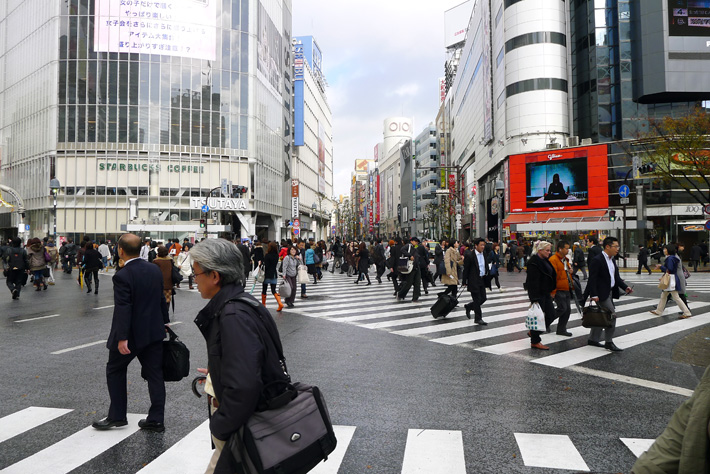
*If you're only staying for one week, cut out days 3 and 4 and then skip to Day 7. Alternatively, you could skip Day 2 as well and choose to do Day 5 or Day 6 (then your Tokyo time will be your shopping time on your way back). If you don't really care about big cities like Tokyo, skipping this section won't be too bad! :)
For the first few days, you'll be exploring Tokyo. So many people. So many things. Hopefully by the end of your Tokyo time you'll feel so tired of it you want to go somewhere nice and peaceful (don't worry, you will!). There are various areas of Tokyo worth visiting, and they're all quite easy to get to via the subway system. As long as you're not hitting it during rush hour, you'll probably have a great time scooting around. Since there are so many different tastes out there, I thought I'd list out the main places worth visiting in Tokyo, and then you can pick and choose what you like. I'll even sort them by areas.
Central Tokyo
Akihabara: This area should be on every nerd's Japan itinerary. It's famous for its electronic shops and otaku culture. So, if you're into either of these, this is a fun place to be. Make sure you look up, too. Lots of multi-story buildings filled with all kinds of weird things. You can spend a while walking around here.
Northern Tokyo:
Asakusa: Asakusa has the feeling of an "old" Tokyo, I think. You can visit the Sensoji (famous Buddhist Temple) and Asakusa Shrine or hit up some of the various shopping lanes.
Ueno Park: Ueno Park is probably one of Japan's most well known parks. Besides being parkish, it's full of museums, shrines, temples, as well as the Ueno Zoo. Definitely the kind of place you fancier folks will enjoy. You can spend a whole day here, if you're into this kind of thing.
Roppongi Hills: Want to see Tokyo from somewhere up high? Come to Roppongi Hills. You can go up into the Mori tower and look down on all those tiny people. Pro Tip: They don't like it when you try to throw pennies off the observation deck. Also worth noting is the Mori Art Museum.
Kappabashi: Do you know how a lot of Japanese food places have fake foods outside showing you what the food looks like? There's a chance they got it at Kappabashi, the kitchen capital of Tokyo. You can buy things for your restaurant, but the best part is the fake food, I think. It's surprisingly expensive, too.
Western Tokyo
Shibuya: Shibuya is just a ward of Tokyo, but it's particularly known for all its fashion and culture. Fashionistas should put it on their Japan itinerary. A lot of shopping can be found here, but there's also the Hachiko Dog Statue as well. Scope it out but come back in the "shopping days" at the end of your trip.
Love Hotel Hill: Technically this is part of Shibuya, but it's worth noting on its own. This is just an area with a lot of love hotels. Pro tip: They won't let three people in at a time, so if you want to check one out as a group, you'll have to break up into pairs or bring a body pillow.
Shinjuku: Shinjuku's kind of the party district, though that may be because of Kabukicho (northeast of Shinjuku Station) which is Tokyo's big red light district. If you're into nightclubs, bars, pachinko, neon, and other ahem things, this will be a place you'll enjoy.
Harajuku: Love crazy outfits? You'll fit in right here. Harajuku is home to Tokyo's teen fashion and cosplay (if you visit on a Sunday). There's also plenty of shopping and crepe stands as well (yum).
Meiji Shrine & Yoyogi Park: These two places are pretty close to each other, so I'm putting them together here too. It's also a good place to go from Harajuku, since you'll use the same train station. The Meiji Shrine is just one of many shrines in Japan, but it's particularly interesting if you're into modern Japanese history. Yoyogi Park, on the other hand, is just a really big park. Both are nice, though, if you're looking to get out of the cement jungle known as Tokyo.
Day 5: Monkey Park, Jigokudani

Have you heard of those Japanese monkeys that hang out in the hot springs? This is one of those places, though depending on the time of year, they may not be spending too much time in the hot springs. I like this place in Winter, but other times are good as well. Summer means baby monkeys, after all. To get here, you'll have to go North of Tokyo to Nagano (Shinkansen it!). From Nagano Station, take Nagano Dentetsu to Yudanaka. From there, you can take a bus to the Kanbayashi Onsen, which has the entrance to the Jigokudani Yaen-Koen. It'll be a 30+ minute walk (depending on how much you stop) to get to the actual monkey area, though you may start seeing monkeys before then if you're lucky. Check out the livecam , too!
If you're going to Jigokudani, I'd maybe recommend heading up here at the end of Day 4 and staying the night in Nagano. There's some interesting things up there too (that's where they did the Winter Olympics in 1998!), so feel free to head up a bit earlier and check things out. Then, the next morning (Day 5) you can head out bright and early to Jigokudani and take your time with the monkeys and possibly hit the onsen. It's a nice place. Then, you can head on back to Tokyo the same night.
Day 6: Toshogu Shrine, Nikko

Nikko is the mausoleum for Tokugawa Ieyasu. Basically, he and his relatives ruled over Japan as Shogun for 250 years (until the Meiji Restoration). That means he got a pretty sweet shrine. There are over a dozen Shinto and Buddhist buildings here, and it's in a very beautiful setting. Need some peace from Tokyo? You'll for sure get it here.
This can be a day trip (it's really close to Tokyo) with some extra time left over. I'd recommend coming here, then either checking out other things in this area or heading straight to Tokyo in the afternoon or evening. Just be sure to give yourself 3-4 hours to travel, so don't leave too late from here. Another option would be to leave the morning of Day 7 and get to Kyoto in the late morning or early afternoon. It's totally up to you.
Day 7 & 8: Kyoto
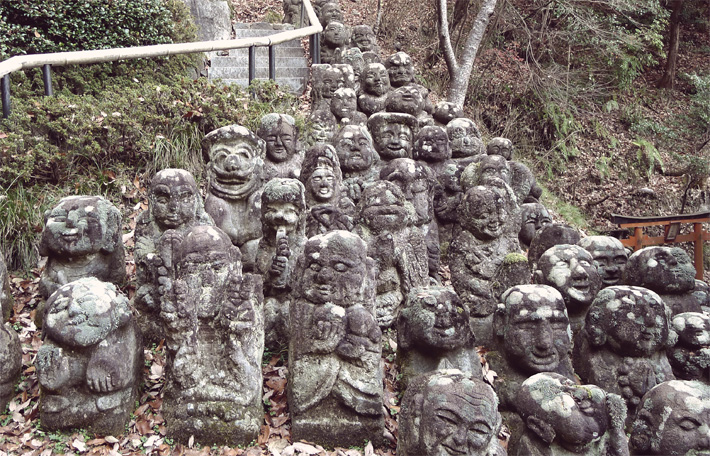
*If you're on the 1-week plan, skip day 8 and go to Nara instead.
Kyoto's going to be your shrine and temple time while visiting Japan. Since it was the place where the emperor lived for over a thousand years, it's full of cool, historical things. Take your pick and enjoy. Also be sure to just walk around at random. You'll run into so many temple, castles, and shrines just by accident. It doesn't hurt to explore, some. Oh, and bring your walking shoes. Things are about to get… walky.
Central Kyoto
Nijo Castle: This was where Tokugawa Ieyasu lived (remember his shrine, up above?). Later it switched to an imperial palace (after the Shogunate went down), and then later opened to the public. It is a UNESCO World Heritage Site, which is supposedly a big deal.
Kyoto Imperial Palace: When the Shogunate was in power, this is where the imperial family lived. You can even take tours in English, here.
Northern Kyoto
Kinkakuji: Also known as the golden pavilion, this is a building covered in gold .
Western Kyoto
Kokedera: Also known as Saihoji, this is another UNESCO World Heritage Site (way to go, Kyoto). This temple is mainly known for its moss, and apparently has over 120 different varieties.
Southern Kyoto
Fushimi Inari Shrine: This shrine is known for its thousand torii gates. They're bright orange and absolutely incredible to walk through. Highly recommended.
Eastern Kyoto

Kiyomizudera: One of the must sees, I think (and also a UNESCO World Heritage Site). This temple is high up on a hill and has a balcony that offers an awesome view.
Higashiyama District: You'll run into this on your way up to Kiyomizudera, actually. Think of this area as a "historic shopping district." Kind of touristy, but a lot of fun nonetheless. Grab something to take home!
Sanjusangendo: The building itself it's amazing, but the inside is pretty remarkable. There are 1001 statues of Kannon in here, which is… well… kinda remarkable.
Gion: Like Geisha? this is Kyoto's Geisha District. You will have to try pretty hard to get in to see a geiko, though, but good luck trying (hint: apparently some travel agencies will hook you up if you've got the yen).
Day 9: Nara
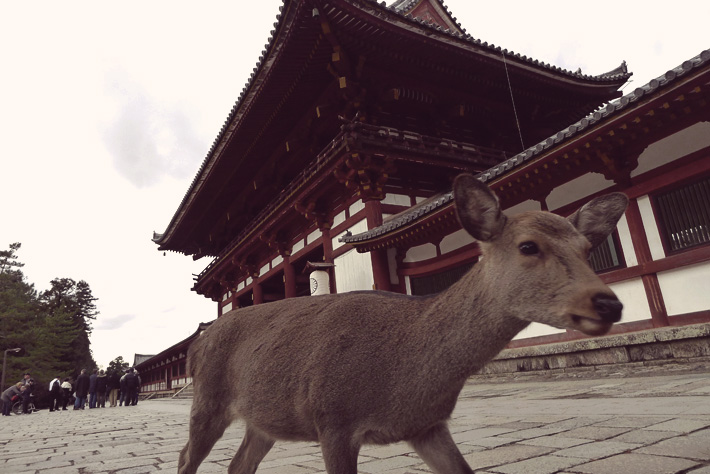
You can leave the morning of Day 9 or leave the evening of Day 10 and spend the night in Nara. Either is fine. You can even spend the night in Nara on Day 9 as well then move on early in the morning of Day 10. It all depends on how much you like temples and Deer.
While there's some neat temples, shrines, castles, and other similar things here in Nara, I'd say you're coming for deer. The deer here are pretty tame and will actually attack you if you have food (kinda fun to run from deer). Don't worry, they have their horns cut off, though (it's a religious thing), so you won't be stabbed through, most likely.
Places you'll want to go in Nara:
- Todaiji Temple: Largest wooden structure in the world with Japan's largest Buddha statues inside. Basically, think super sized. Definitely one of the best places to visit in Nara.
- Nara Park: Has a lot of deer. Go buy deer food, the deer will thank you.
- Kofukuji Temple: Basically a big temple. Very pretty, though.
- Nara National Museum: If you're interested in Japanese Buddhist Art, this will be a fun place for you. The building is also surrounded by ferocious, wild deer.
Consider this a day to walk around but not as much as when you were in Kyoto. Nara's a lot like Kyoto in a lot of ways, though, so I'd recommend mainly hitting up the deer and then hitting up Todaiji Temple. Depending on how worn out you are on temples, though, you can stay here longer or shorter, deciding where you stay this night based off of that.
Day 10: Mt. Koya aka Koyasan
You'll want to make sure you leave early this day, whether you're leaving from Kyoto or Nara. You have a ways to go to get to Koya-san, quite possibly one of the most beautiful places in Japan (just my opinion). This might be one of the best places you go in your Japan travels.
There are a hundred temples here, many of which you can stay the night at. When you spend the night, you get the best vegetarian meal you've ever had (guaranteed), a room to stay in, and even the option to wake up (really) early to go watch the monks do their morning rituals. It's so peaceful, a lot of fun, and one of my favorite places on earth. You'll want to go to the Koyasan website for more information on lodging.
I'd recommend getting here as early as you can on Day 10, dropping off your things at the place you're staying, then just walk around. You'll be able to fill a good amount of time just exploring. The best place to walk, though? Probably the giant cemetery, which also happens to be the largest in Japan. Although some may find a graveyard creepy, it really is quite peaceful.
This, I think, will be one of your best days in Japan, so don't skimp out on it if possible! Just be sure to get back to your temple in time for dinner.
Day 11: Travel Day / Osaka / Fuji

*If you're on the 1-week schedule, you'll need to get back to Tokyo. You're running out of days.
Day 11 is mostly travel. You'll want to leave Koya either late morning or early afternoon, depending on where you're going next. If you like shopping a lot, you'll want to get back to Tokyo on this day.
If you don't need the extra time, consider stopping in Osaka (it's on the way from Koyasan). You can visit the Glico Man, Osaka Tower, play some Pachinko, and eat some Takoyaki / Okonomiyaki (both famous in Osaka). It's a bit different than Tokyo, but it's still a big city. I'll leave this one up to you, though. Osaka's a lot of fun to just walk around and check out.
Alternatively, you could stop at Mt. Fuji on the way back too. I recommend the amusement park Fuji-Q Highland over climbing the mountain itself (it looks better from afar, you'll have to trust me on this one) if you do this. Definitely don't miss the horror house there, it's top notch.
Whatever you end up doing, you're reaching the end of your trip. Just make sure you're back in Tokyo in time to do your shopping before you get on the airplane to leave. Of course, if you don't shop, then you have more time to go to more places. If you do shop, get back to Tokyo.
Day 12 & 13: Shopping In Tokyo / Last Minute Visits
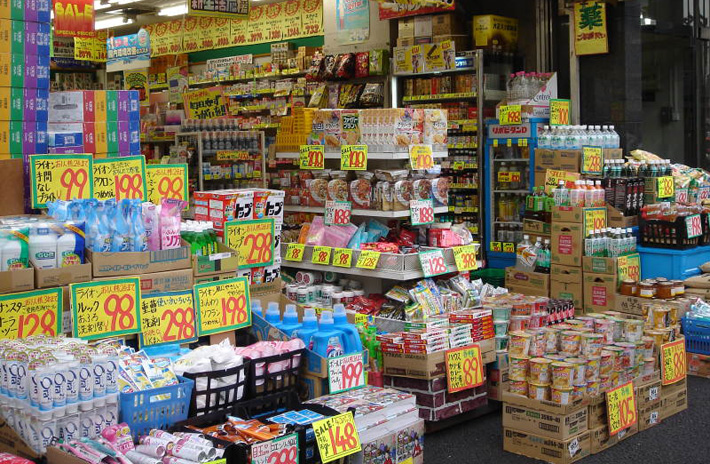
Hopefully you scoped out all the places you wanted to shop at, because this is your shopping time. Get the things you want for yourself and for your friends / relatives. Fill up that duffel bag you brought / bought and have fun. This is also a good time to just go around to the places you missed.
Either way, it's good to be back in Tokyo a day or two before your flight leaves, that way you won't miss your flight (unless you want to "accidentally" miss it, wink wink nudge nudge).
Day 14: Go Home
Hope you had traveling to Japan. This is only your first trip, though. Now that you've gotten all the normal / main stuff out of the way, your next trip can be filled with strange, exciting places. Be sure to check out TofuguTV for some of those, and keep reading Tofugu for more in the future. There are certainly many, many "off-the-beaten-track" locations worth visiting, but we'll save that for next time !
THE JOURNAL
Travel Inspiration
Planning a Trip to Japan: Your Full Guide

The Modern Travel Agency
Fora Travel
https://www.foratravel.com/the-journal/planning-a-trip-to-japan
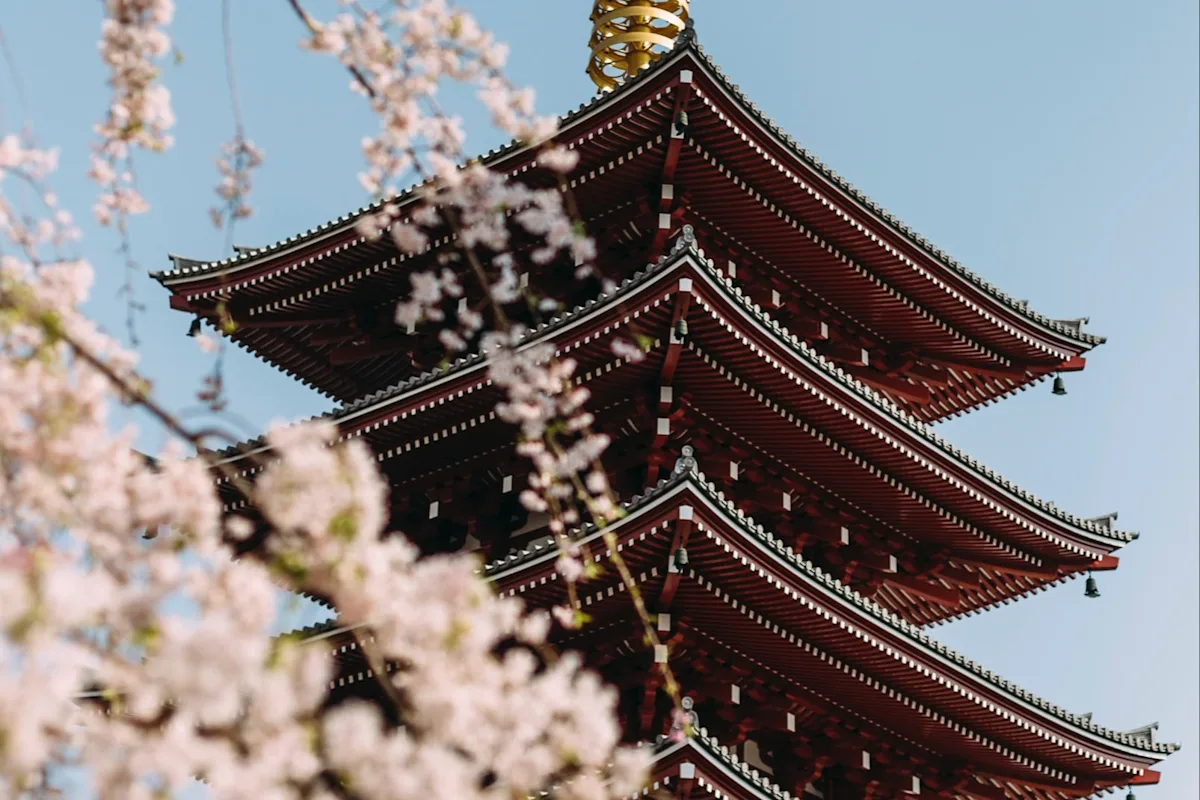
Planning a trip to Japan might feel intimidating, especially if you’re not used to international travel, but don’t let that stop you from experiencing one of the world’s most unique countries. Here, we’ll explain in detail how to plan your trip to Japan, from travel basics to advanced tips and FAQs.
Or, skip the reading and book your trip with Fora . From booking incredible accommodations in the best areas to providing elite travel tips — all while scoring you exciting travel perks — we'll make sure your trip is an amazing experience from start to finish.
Planning a trip to Japan: the travel basics

There are a few basic Japan travel FAQs you’ll want to have the answers to before planning a trip to Japan. Don’t worry; we’ve got you covered.
Do you need a visa to travel to Japan?
If you’re traveling to Japan from the United States, you don’t need a Japan tourist visa unless you plan on staying for more than 90 days. If you’re traveling from elsewhere, we can point you in the right direction.
In any case, you will need a valid passport to enter the country.
Does Japan have any entry requirements? Are COVID-19 rules still in effect?
COVID-19 policies for travelers vary by country of origin and are likely to change with new events.
Travelers may need to be vaccinated and / or have a negative COVID-19 test. Depending on where you’re coming from, tests are provided upon entry. American travelers can find up-to-date information on the US Embassy to Japan’s website .
Is getting around Japan easy?
Generally speaking, yes! Japan’s railway system is arguably the world’s most efficient, and intercity public transportation, even walking, is similarly seamless.
It should be noted that not all signs have English counterparts, especially in more rural areas. A translator app can be useful in these instances.
Do people speak English in Japan?
In major cities, it’s not too uncommon to run into people who speak basic English. However, you’re best off using a translator app and learning at least a few basic Japanese phrases.
Japanese people are delightfully friendly and polite, and are often happy to help travelers.
Ready to travel? Connect with Fora to plan and book your Japan trip today.
Planning a trip to Japan: advanced tips & FAQs
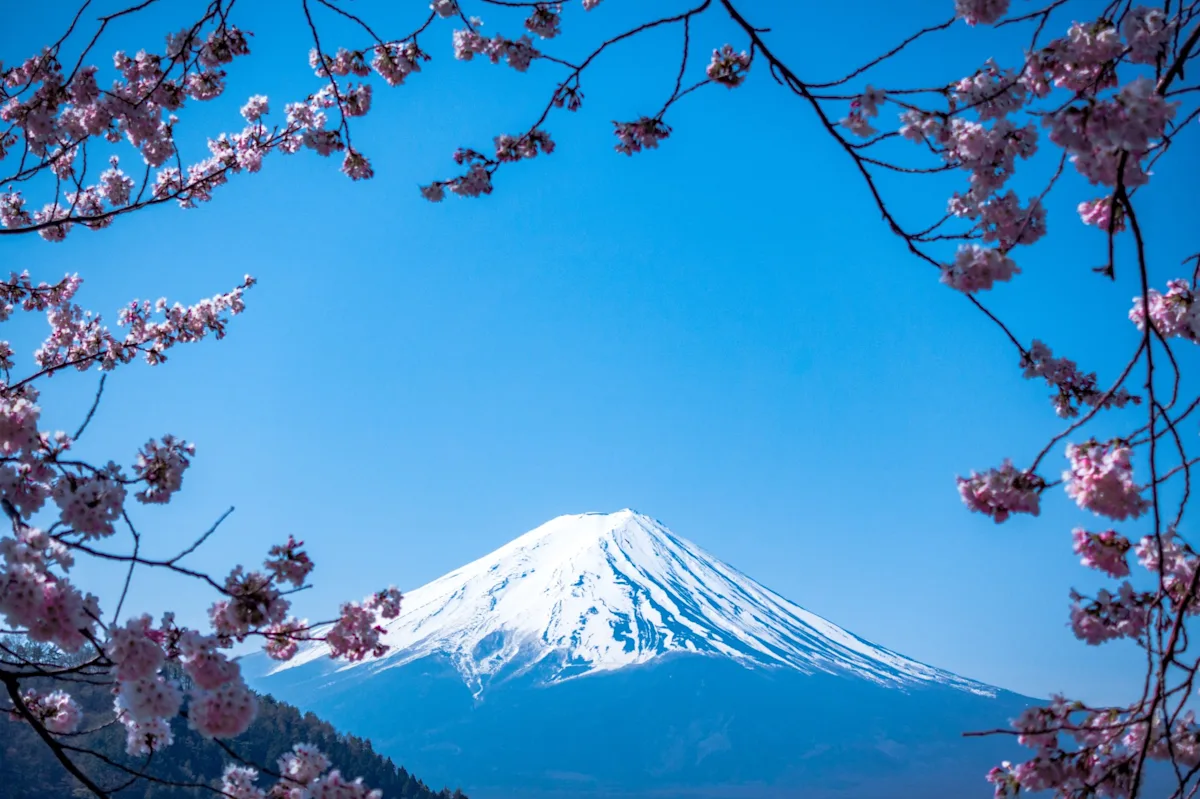
Once your more basic Japan travel questions are answered, you can start planning a trip to Japan in earnest.
How many days in Japan is enough? How long should my first trip be?
If you want to see everything , you’ll have to measure your trip in months or years. But we know that’s not exactly realistic.
We recommend spending at least one week in Japan , as this will give you enough time to explore one or two of the top destinations. That doesn’t mean a shorter trip isn’t possible, though. Connect with Fora for help planning the trip to Japan that’s right for you.
What’s the best time to go to Japan?
There’s no easy answer, but we offer a full explanation in our guide to the best months to visit Japan . It ultimately depends on what you’re visiting for.
For example, if you want to visit Osaka (check out our Osaka itinerary ), the best time to visit may be in late spring, when some of the crowds have quieted down, the weather’s temperate and the cherry blossoms are still in bloom.
How much does a trip to Japan cost?
A trip to Japan will likely cost a lot more than traveling domestically, but beyond that, it’s hard to say without specifics. Where you’re staying (check out some of the coolest hotels in Japan ), which places you visit, where you want to eat and many other factors all affect the final cost.
Don’t worry, though. When planning a trip to Japan with a Fora Advisor, you’ll get the best deals on hotels, along with expert recommendations to get the most value out of your vacation.
Is etiquette really that important in Japan?
Yes. Courtesy and respect are very important aspects of Japanese culture. For example, bowing is an important greeting, and don’t be surprised if you have to take your shoes off to enter certain buildings, especially homes.
But as we mentioned above, Japanese people are very friendly, and often eager to help tourists who respect local culture.
Learning basic Japanese can be very beneficial
While English speakers are somewhat common in the major cities, if you’re going to some of the more unique places to visit in Japan , knowing basic Japanese will make a difference.
Simple phrases — please and thank you, greetings, etc. — will show your willingness to work with locals, and they’ll likely return that eagerness in kind. And if you’re wondering how to plan a trip to Japan that will be unlike anything else, you’re going to want to interact with locals.
Planning a trip to Japan: where should you go for your first (or 20th) time?
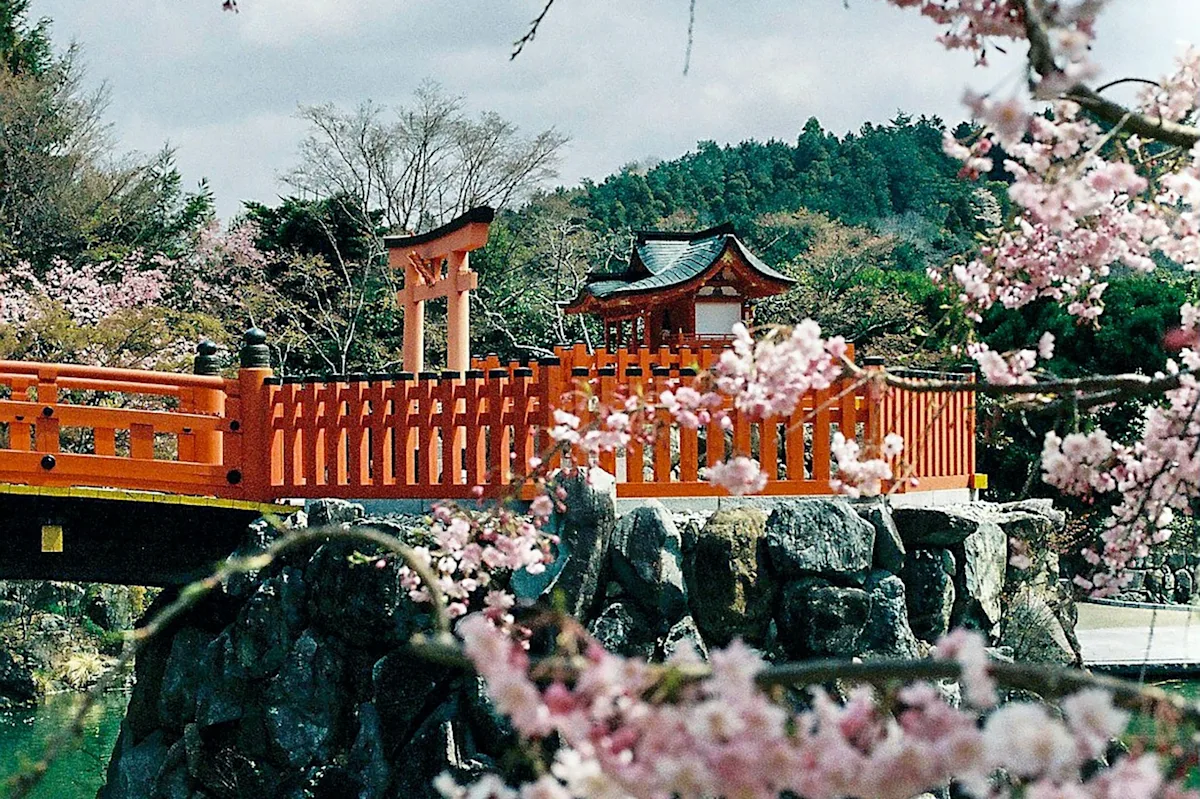
Arguably the most important part of planning a trip to Japan: deciding where to go!
Whether this is your first time in Japan (and if so, check out our first timer’s guide to Japan ) or your 20th, building an itinerary with Fora beforehand can help you maximize your time.
Tokyo, Kyoto & Osaka are Japan’s top destinations…
Traveling to Tokyo , Osaka or Kyoto is the most popular choice. These cities are world-class examples of urban locales that blend modern technology with traditional roots. Yet each has a distinct feel and form.
Whether you’re getting off the beaten path in Kyoto or enjoying your first time in Tokyo , we'll make sure your trip is unforgettable.
…But there’s much to see outside these destinations, too
As exciting as the three major cities are, exploring Japan’s smaller cities, countryside or mountainous northern region is just as grand. From New Year’s skiing in Niseko to enjoying the more traditional culture of Naoshima , there’s no shortage of things to do outside of Tokyo, Osaka and Kyoto.
How to plan a trip to Japan for the first time (or the 20th) and get amazing travel perks, too
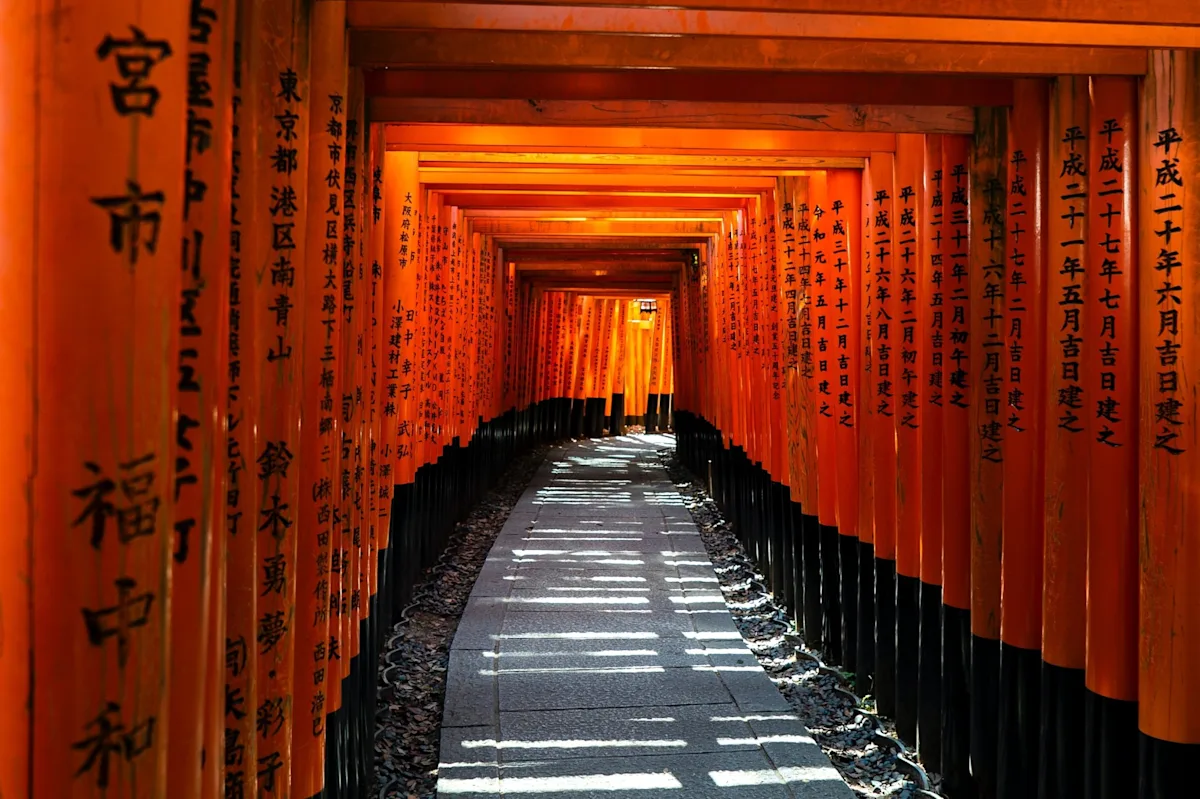
The best way to plan your trip to Japan is to book with Fora . We’ll go over the best places to stay in Japan , like where to stay in Tokyo — the coolest hotels in Tokyo are among the best in the world, by the way— where to stay in Kyoto and more.
And you’ll get access to exclusive hotel perks and upgrades . This can include property credits, room upgrades, or even complimentary meals and nights. Even better, these perks come at no extra cost to you.
The help doesn’t stop at hotels. We can also recommend the best restaurants and things to do in Japan , as well. Maybe you’re looking for the best food in Japan ? We have the connections, if not the personal experience, to land you at the top restaurants and bars around, so you don’t have to waste time researching by yourself.
Book with Fora
Tell us more about yourself to get matched with a Fora Advisor and start planning your dream trip today.

Unforgettable 7 Day Japan Itinerary (2024)
R eady to dive into a whirlwind 7 day Japan itinerary that promises a blend of tradition, modernity, and breathtaking landscapes? From the electrifying streets of Tokyo to the serene temples of Kyoto and the gastronomic delights of Osaka, I have crafted a journey based on my personal experience that packs the essence of Japan into one unforgettable week.
*Disclosure: This post may contain affiliate links, which means we may receive a commission if you click a link and purchase something we have recommended. Please check out our disclosure policy for more details. Thank you for your support!
Your 7 Day Japan Itinerary
This itinerary isn’t just about ticking off the sights. It’s about immersing yourself in the rhythm of Japanese life. From samurai stories to the future of technology, and yes, lots of sushi, get ready for a truly unique adventure.
Day 1: Tokyo – Urban Exploration and Neon Lights
How to travel to tokyo.
Your 7 day Japan itinerary will likely start at Narita International Airport. From the airport, the quickest way to central Tokyo is the Narita Express train (N’EX), which takes about an hour. Just ask anyone at the airport train station for directions.
Another easy option is the Limousine Bus service that runs both to and from Narita and Haneda airports.
Best places to stay in Tokyo
Choosing where to stay in Tokyo offers a glimpse into the city’s diverse character. Shibuya and Shinjuku offer vibrant nightlife and bustling streets, making them perfect for those looking to dive into Tokyo’s dynamic energy.
For a more serene atmosphere with a touch of traditional charm, Asakusa hosts cozy stays near historical sites. Alternatively, Roppongi stands out for art lovers and night owls, offering upscale accommodations and a lively scene. Here are some of our favorite Tokyo hotels for families .
Things to do in Tokyo on Day 1
- Visit Senso-ji Temple in Asakusa: Start your exploration in the tranquil surroundings of Tokyo’s oldest temple, Senso-ji. Walking through the iconic Kaminarimon Gate and browsing the stalls of Nakamise Street is a wonderful introduction to Japanese culture.
- Cross Shibuya Crossing: Witness the organized chaos of Shibuya Crossing, one of the most photographed spots in Tokyo. The nearby statue of Hachiko, the loyal dog, adds a bit of nostalgia to this bustling area.
- Explore Harajuku: Dive into the heart of Tokyo’s youth and fashion culture in Harajuku. Takeshita Street is a kaleidoscope of trendy shops, cafes, and colorful street food. It reflects the vibrant and eccentric styles that define the area.
- Enjoy the Views from the Tokyo Metropolitan Government Building: Head to Shinjuku to visit the Tokyo Metropolitan Government Building. Its observation decks offer stunning panoramic views of the city. This is a perfect spot to watch the sunset over Tokyo. (This is a great option if you don’t want to pay for Shibuya Sky , Tokyo Tower, or Tokyo Skytree ).
- Dine in Omoide Yokocho: Conclude your day in the nostalgic alleys of Omoide Yokocho. This cozy corner of Shinjuku is famous for its tiny yakitori stalls and izakayas. These offer a taste of Tokyo’s culinary traditions in an intimate setting.
Day 2: Tokyo – Cultural Dive and Tech Wonders
On Day 2, we delve deeper into Tokyo’s fascinating blend of tradition and futuristic innovation. This day is about experiencing the culture and technology that defines this city.
Things to do in Tokyo on Day 2
- Meiji Shrine Morning Visit: Start with a peaceful visit to the Meiji Shrine, nestled in a lush forest. This shrine offers a tranquil contrast to Tokyo’s urban energy, perfect for a reflective morning.
- Harajuku’s Takeshita Street: After the shrine, head back to Harajuku to explore Takeshita Street more leisurely. This street buzzes with youthful fashion, unique shops, and colorful treats, showcasing Tokyo’s vibrant pop culture.
- Imperial Palace East Gardens: Midday, visit the Imperial Palace East Gardens . These gardens offer a quiet retreat with well-kept lawns, scenic paths, and historical sites, in the city center.
- Akihabara’s Tech and Anime Hub: Spend your afternoon in Akihabara, Tokyo’s electric town. Here you can immerse yourself in its world of electronics, anime, and manga. This is one of the best things to do in Tokyo with kids . It’s a must-visit for tech lovers and fans of Japanese pop culture.
- Evening in Odaiba: Conclude your day in Odaiba, enjoying its futuristic vibe, entertainment options, and bay views. The island is a perfect spot for an evening stroll, dining, and enjoying panoramic views of Tokyo’s skyline.
Day 3: Hakone and Mount Fuji – Nature’s Majesty
How to get to hakone.
No 7 day Japan itinerary is complete without seeing Mt Fuji! While it is a popular day trip from Tokyo , we recommend making time for an overnight in the area. Your gateway to Hakone begins aboard the Odakyu Limited Express “Romancecar” from Shinjuku Station in Tokyo. This comfortable and direct route takes you to Hakone-Yumoto in approximately 85 minutes, offering picturesque views along the way.
Investing in the Hakone Free Pass is recommended for those planning extensive exploration. This pass not only covers your round trip between Tokyo and Hakone but also grants unlimited access to various forms of transportation within Hakone. It includes buses, ropeways, and boats, making your travels within this scenic area both easy and cost-effective.
Best places to stay in Hakone
Choosing to stay in Hakone will allow you more time to explore this enchanting region. Hakone Yumoto, serving as the gateway to the area, is renowned for its welcoming hot spring hotels and ease of access. This makes it a popular choice for many visitors.
For a touch of luxury nestled in nature, Gora offers upscale ryokan with private onsen and breathtaking mountain vistas.
Alternatively, the area around Lake Ashi is a peaceful getaway. Some accommodations boast views of Mount Fuji, making for a picturesque retreat.
Things to do in Hakone and Mount Fuji
- Visit Owakudani Valley to see its active sulfur vents and enjoy the unique experience of eating eggs boiled in its naturally hot waters, said to extend one’s life.
- Take the Hakone Ropeway for stunning panoramic views of the surrounding mountains and a chance to see Mount Fuji on clear days.
- Enjoy a Lake Ashi Cruise aboard a pirate ship, offering a unique perspective of Hakone’s natural beauty and, weather permitting, views of Mount Fuji.
- Explore the Hakone Shrine, nestled on the shores of Lake Ashi. Its iconic torii gate offers one of Hakone’s most picturesque scenes, seemingly floating on the water.
- If time allows, visit the Hakone Open Air Museum, where art and nature merge beautifully, featuring impressive sculptures and artwork in an outdoor setting that highlights the area’s scenic landscapes.
Our Favorite
Mt fuji and hakone tours.
- Full Day Trip to Hakone with Lake Ashi Cruise via Context Travel
- Mt Fuji, Hakone, and Lake Ashi Private Day Tour via Viator
- Private Mt Fuji Charter with Driver via GetYourGuide
- Mt Fuji and Hakone Private Day Tour via Tours By Locals
Day 4: Kyoto – Time Travel to Ancient Japan
How to get to kyoto.
The journey from Hakone to Kyoto can be seamlessly made by Shinkansen (bullet train). First, take a train from Hakone-Yumoto to Odawara Station, and from there, board the Shinkansen to Kyoto.
The total travel time is approximately 2 to 3 hours, allowing you to transition smoothly from the natural landscapes of Hakone to the historic ambiance of Kyoto.
Best Places To Stay in Kyoto
Gion, the city’s geisha district, offers a stay right in the heart of traditional Japan, where the evening streets are lit by paper lanterns and wooden machiya houses.
For those who prefer the hustle and bustle of the city with a modern twist, the Downtown Kyoto area around Shijo-Kawaramachi is perfect, with its convenient access to shops, restaurants, and major sightseeing spots.
Alternatively, Arashiyama in the western part of the city is a haven for nature lovers. This area offers a more secluded stay close to the famous Bamboo Grove and other natural sites.
Things To Do in Kyoto on the First Day
- Visit Fushimi Inari Shrine, famous for its thousands of vermilion torii gates that trail through the mountain, creating a mesmerizing path that’s both spiritual and photogenic.
- Explore Kinkaku-ji (Golden Pavilion), a Zen Buddhist temple that is one of Kyoto’s most iconic sights, with its top two floors covered in gold leaf shining over a reflecting pond.
- Stroll through the Arashiyama Bamboo Grove, an otherworldly forest that offers a tranquil and awe-inspiring walking experience. (Arashiyama was one of our favorite places to visit in Kyoto with teens ).
- Experience the tranquility of Ryoan-ji, known for its karesansui (dry landscape) rock garden, which embodies the essence of Zen Buddhism.
- Wander around Gion, Kyoto’s famous geisha district, in the evening. The area’s traditional wooden machiya houses and exclusive ochaya (teahouses) provide a glimpse into the old Kyoto lifestyle.
Day 5: Kyoto – The Heart of Tradition
Things to do in kyoto on your second day.
- Kiyomizu-dera Temple: Start your day with a visit to this historic temple, famous for its wooden stage that offers stunning views of the cherry and maple trees below, as well as the city of Kyoto.
- Nijo Castle: Explore the opulent Nijo Castle, renowned for its beautiful architecture, intricate interiors, and the Nightingale Floors designed to sing at the slightest touch to warn of intruders.
- Philosopher’s Path: Take a stroll along the Philosopher’s Path, a cherry tree-lined canal that provides a peaceful setting for reflection and is especially beautiful during the cherry blossom season.
- Ginkaku-ji (Silver Pavilion): Visit Ginkaku-ji, a Zen temple that, despite its name, is not adorned in silver but is renowned for its beautiful sand gardens and moss-covered grounds.
- Pontocho Alley: Conclude your day with an evening wander through Pontocho Alley, one of Kyoto’s most atmospheric dining areas. This narrow lane is filled with traditional tea houses, restaurants, and bars offering a glimpse into Kyoto’s vibrant nightlife. A must do for any 7 day Japan itinerary.
Day 6: Nara – Amongst Deer and Temples
How to get to nara.
You can take the JR Nara Line from Kyoto Station directly to Nara Station, with the journey taking about 45 minutes to an hour.
Alternatively, the Kintetsu Kyoto Line offers a slightly faster route from Kyoto to Kintetsu Nara Station, taking about 35 to 50 minutes. Both options drop you near Nara’s main attractions.
Best Places To Stay in Nara
Nara’s accommodations provide traditional and modern options, primarily located around Nara Station and Naramachi, the old merchant district.
Staying near Nara Park offers easy access to many of the city’s historical sites and the chance to wake up close to the serene natural beauty and the deer that call it home.
Things To Do in Nara
- Todai-ji Temple: Visit this iconic temple, home to the Great Buddha (Daibutsu), one of the largest bronze statues in the world. The temple complex and its massive gate are impressive sights that showcase the grandeur of ancient Nara.
- Nara Park: Wander through Nara Park, famous for its hundreds of freely roaming deer. Considered messengers of the gods in Shinto religion, these deer have become a symbol of the city and a must-see for visitors.
- Kasuga-taisha Shrine: Explore the serene Kasuga-taisha Shrine, known for its thousands of stone lanterns that line the path to the shrine, as well as the hundreds of bronze lanterns within. The shrine is a beautiful example of Shinto architecture and tradition.
- Naramachi: Stroll through the historic Naramachi district, where you can explore traditional merchant houses, quaint shops, and cafes. This area provides a glimpse into old Nara’s daily life and culture.
- Isuien Garden: End your day with a visit to Isuien Garden, a beautiful example of Japanese landscape gardening. With its carefully designed ponds, bridges, and tea houses, Isuien offers a peaceful retreat and a perfect spot for contemplation and relaxation.
Day 7: Osaka – Culinary Adventure and Urban Excitement
How to get to osaka.
From Nara, you can take the JR Yamatoji Line directly from JR Nara Station to JR Osaka Station, with the journey taking about 50 minutes to an hour.
Alternatively, the Kintetsu Nara Line offers service from Kintetsu Nara Station to Osaka’s Namba Station, a trip that also takes around 40 minutes. Both routes provide a seamless transition to the lively atmosphere of Osaka.
Best Places To Stay in Osaka
- Namba/Dotonbori: For those looking to dive straight into the heart of Osaka’s renowned food scene and nightlife, staying in the Namba or Dotonbori area is ideal. This district is bustling with energy, offering easy access to street food, restaurants, and entertainment options.
- Umeda: Situated around Osaka Station, Umeda is another great area to stay, known for its shopping, dining, and modern architecture. It’s conveniently located for exploring the city and offers a range of accommodation options.
- Shin-Osaka: For travelers needing quick access to the Shinkansen for day trips or onward travel, Shin-Osaka is practical. It provides efficient connections without sacrificing the convenience of city amenities.
Things To Do in Osaka
- Osaka Castle: Start your day with a visit to Osaka Castle, one of Japan’s most famous landmarks. The castle park is especially beautiful during cherry blossom season, and it is sure to be a hit if you’re visiting Osaka with kids . The museum inside offers a deep dive into Osaka’s history.
- Dotonbori: This vibrant area is famous for its neon lights, extravagant signage, and diverse street food options, including takoyaki (octopus balls) and okonomiyaki (savory pancakes).
- Shinsaibashi Shopping Arcade: Explore the Shinsaibashi Shopping Arcade, a covered shopping street that stretches for several blocks and offers everything from high-end fashion to unique souvenirs.
- Umeda Sky Building: For panoramic views of Osaka, visit the Umeda Sky Building. The floating garden observatory on the 39th floor offers a 360-degree view of the city, making it a perfect spot for photography enthusiasts.
- Kuromon Ichiba Market: End your day at the Kuromon Ichiba Market, where you can sample fresh seafood, street food, and local specialties. It’s an ideal place to enjoy the flavors of Osaka and pick up some last-minute gifts or souvenirs.
The Quickest And Cheapest Way To Travel In Japan: The Bullet Train
Japan’s Shinkansen, or bullet train, is the epitome of fast and efficient travel, offering an unmatched combination of speed, economy, and comfort. It is even faster and more cost-effective than flying. The network stretches across the country, linking major cities and tourist destinations with speed.
With trains departing frequently and stations centrally located, the Shinkansen is an ideal choice for transportation during your 7 day Japan itinerary.
The JR Pass
The Japan Rail (JR) Pass is a powerful tool for tourists, offering unlimited travel on most Shinkansen trains and other JR services for a fixed period (7, 14, or 21 days). This pass not only simplifies travel across Japan but also significantly reduces costs for those looking to explore multiple regions.
Purchasable exclusively by foreign tourists BEFORE arriving in Japan, the JR Pass is an investment that pays dividends in both convenience and savings.
Its benefits extend beyond the Shinkansen, covering local trains, buses, and even some ferries, ensuring a comprehensive travel solution across Japan’s diverse landscapes.
Best Time Book Your 7 Day Japan Itinerary
The ideal times to embark on your 7 day Japan adventure are during the spring (March to May) for the cherry blossoms and autumn (September to November) for the vibrant fall colors. These seasons offer stunning natural backdrops and pleasant weather, enhancing your travel experience.
- Spring is famous for its cherry blossoms, creating picturesque scenes across cities like Tokyo and Kyoto. Due to its popularity, it’s wise to book accommodations and travel arrangements well in advance.
- Autumn impresses with its cool weather and colorful foliage, perfect for outdoor activities and temple visits.
For fewer crowds and potential savings, consider late spring or early autumn. Planning your trip 3-6 months ahead can secure better deals and ensure a smoother experience, regardless of the season you choose.
Tips For Traveling In Japan
- Public Transportation Mastery: Japan’s public transport system is world-class, punctual, and extensive. Familiarize yourself with local train and bus schedules, and consider purchasing a PASMO or SUICA card for convenient tap-and-go travel in major cities. You can find more information about this in our Japan travel tips .
- Respect Local Customs: Japanese culture values etiquette highly. Simple gestures like removing your shoes before entering someone’s home or a temple, bowing as a greeting, and being mindful of noise levels on trains can go a long way in showing respect.
- Language Barrier: While major cities often have English signs and speakers, venturing off the beaten path might present language challenges. Learning a few basic Japanese phrases or having a translation app can enhance your experience and interactions.
- Connectivity: Stay connected with a portable Wi-Fi router or a Japanese SIM card , especially useful for navigating, translating, and accessing timetables on the go.
- Mind the Seasons: Weather can significantly impact your travel experience. From the humid summers to the snowy winters, pack accordingly. Be aware of seasonal variations that might affect your plans, such as typhoon season in late summer and early autumn.
- Exploration Beyond the Cities: While cities like Tokyo, Kyoto, and Osaka are must-visits, Japan’s charm also lies in its rural landscapes, onsen towns, and mountain retreats. Allow time to explore beyond the urban environments.
- Cash is King: Despite its high-tech reputation, many places in Japan still prefer cash transactions. This is especially common in rural areas, smaller establishments, and temples. Always carry a sufficient amount of yen to cover your expenses.
Budget For Your 7 Day Japan Itinerary
Planning your budget for a 7-day trip to Japan will involve considering various expenses to ensure an enjoyable yet affordable experience. Here’s a brief overview:
Accommodation: Choose from a range of budget-friendly options, including hostels, guesthouses, and capsule hotels. Prices typically range from ¥3,000 to ¥8,000 per night.
Transportation: Consider investing in a Japan Rail Pass (JR Pass) for unlimited travel between cities. A JR Pass will cost about ¥50,000 for 7 days of unlimited travel.
Food: Enjoy affordable meals at local eateries like izakayas and noodle shops. We recommend budgeting around ¥3,000 to ¥6,000 per day for food.
Activities: Budget for additional expenses such as entrance fees to attractions and cultural experiences based on your interests.
Miscellaneous: Allocate funds for souvenirs, snacks, and unforeseen expenses to ensure a stress-free journey.
Total Spend:
Depending on your preferences and travel style, budgeting approximately ¥90,000 to ¥150,000 per person for the entire 7-day itinerary should cover accommodation, transportation, food, activities, and miscellaneous expenses. Adjustments may be needed based on individual preferences and priorities.
FAQs: 7 Day Japan Itinerary
Is 7 days enough for japan.
While 7 days may seem short, it’s sufficient to experience the highlights of Japan, especially if you focus on specific regions or cities. Consider prioritizing your must-see attractions to make the most of your time.
What is better, Osaka or Kyoto?
Both Osaka and Kyoto offer unique experiences. Osaka is known for its lively food scene, modern architecture, and vibrant nightlife. Kyoto is renowned for its historical temples, traditional tea houses, and serene gardens. Consider visiting both cities to enjoy the contrast between modernity and tradition.
Can I get around without speaking Japanese?
It is possible to navigate Japan without speaking Japanese, especially in major tourist areas and transportation hubs. Here you will find English signage and English-speaking staff are common.
Learning a few basic Japanese phrases such as greetings and polite expressions can enhance your travel experience and interactions with locals.
Is Japan very expensive to visit?
Japan can be relatively expensive, especially in major cities like Tokyo and Kyoto. However, there are plenty of budget-friendly options available, including affordable accommodations, inexpensive dining options like ramen shops and convenience stores, and economical transportation passes such as the Japan Rail Pass. With careful planning and budgeting, you can enjoy Japan without breaking the bank.
Do I need a visa to enter Japan?
Citizens of many countries can enter Japan for tourism purposes without a visa for short stays (usually up to 90 days). However, visa requirements vary depending on your nationality and the purpose of your visit.
Check the visa requirements for your country on the official website of the Ministry of Foreign Affairs of Japan before traveling to Japan.
What are the best seasons to visit Japan?
The best seasons to visit Japan are spring (March to May) and autumn (September to November). Spring offers cherry blossoms (sakura) in full bloom, mild temperatures, and vibrant festivals such as hanami (flower viewing) celebrations.
Autumn boasts stunning fall foliage (koyo), pleasant temperatures, and fewer crowds, making it ideal for outdoor activities and scenic hikes.
What are the top 5 things to do in Japan?
- Explore the historic temples, shrines, and gardens of Kyoto, including Kinkaku-ji (Golden Pavilion) and Fushimi Inari Taisha.
- Experience the bustling streets and lively markets of Tokyo, including Shibuya Crossing, Tsukiji Outer Market, and Senso-ji Temple in Asakusa.
- Visit Hiroshima’s Peace Memorial Park and Museum to learn about the city’s tragic history and promote peace and reconciliation.
- Discover the natural beauty of Hakone and soak in an onsen (hot spring) while enjoying views of Mount Fuji.
- Indulge in Osaka’s culinary delights, including okonomiyaki (Japanese savory pancake), takoyaki (octopus balls), and street food in Dotonbori.
Conclusion: 7 Day Japan Itinerary
Crafting this 7 day Japan itinerary reminded me of how amazing it was to experience the country’s rich culture, history, and natural beauty. Whether we were exploring Tokyo’s streets, immersing in Kyoto’s ancient traditions, or savoring Osaka’s culinary delights, each day brought new unbelievable adventures.
Embrace the serene moments in temples, marvel at Mount Fuji’s beauty, and indulge in urban energy. With 7 days, create lasting memories amid cherry blossoms in spring, fiery autumn foliage, or unique festivals.
As you bid farewell, carry Japan’s warmth, traditions, and unforgettable experiences with you. You will find yourself planning your second trip to Japan not long after, just like we did!
More Posts You Might Like from this author
17 Interesting F acts About Nicaragua
9 Best National Parks in Nicaragua
Cost of Living in Nicaragua
About the author: Warren Morelli is a seasoned traveler, digital nomad, and the creative mind behind The Nomad Hive . Together with his partner Natasha, they have been exploring the world for over 8 years, documenting their adventures and sharing valuable insights with their audience. With a passion for discovering hidden gems and off-the-beaten-path destinations, Warren and Natasha offer practical tips, honest advice, and captivating stories to inspire fellow travelers to embark on their own journeys.
The post Unforgettable 7 Day Japan Itinerary (2024) appeared first on Kids Are A Trip™ .

Taking the train in Japan - all you need to know

Mar 28, 2024 • 11 min read
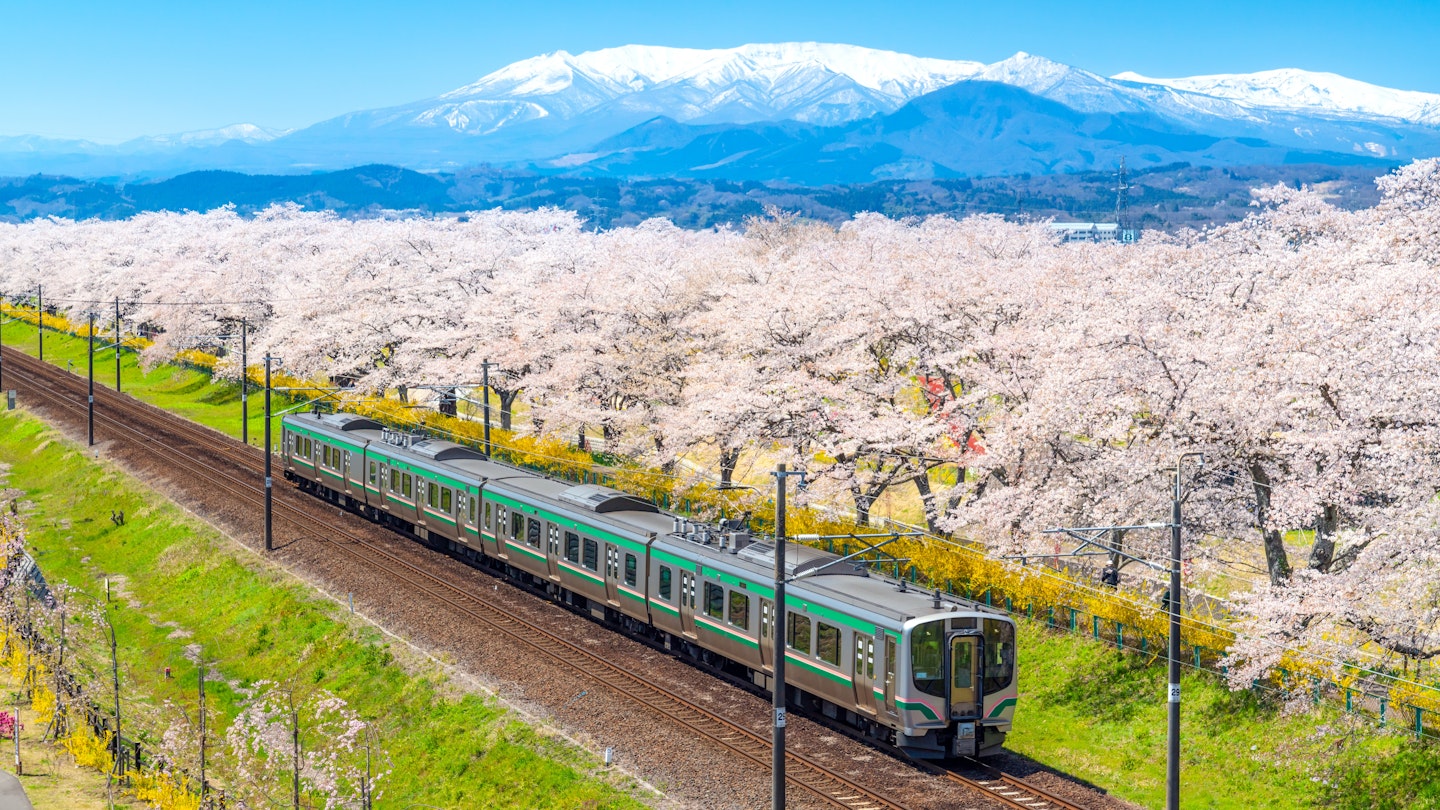
Find your way in Japan with our ultimate guide to rail travel © Chay_Tee / Shutterstock
You will fall passionately in love with trains in Japan .
Japanese people didn’t invent rail travel, but they arguably perfected it. Whether you’re on the newest shinkansen (bullet train) zooming across the country at 320km/h (199mph) or an elderly regional railcar, you can count on your train being scrupulously clean, safely operated, highly reliable, famously punctual and generally a joy to ride.
You can see almost the entire country by train, and with a wide variety of rail passes — including the iconic Japan Rail Pass — you can travel across Japan for less than US$50 per day, including the shinkansen.
Signs are in English even at the smallest stations, translation apps and devices are widely used for complicated questions, and staff are genuinely happy to help travelers.
Japan has an enormous number of train lines and kinds of train, but don’t be put off by the sheer volume: it’s surprisingly easy to navigate , even on your first trip, with your phone’s maps app and a sense of adventure.
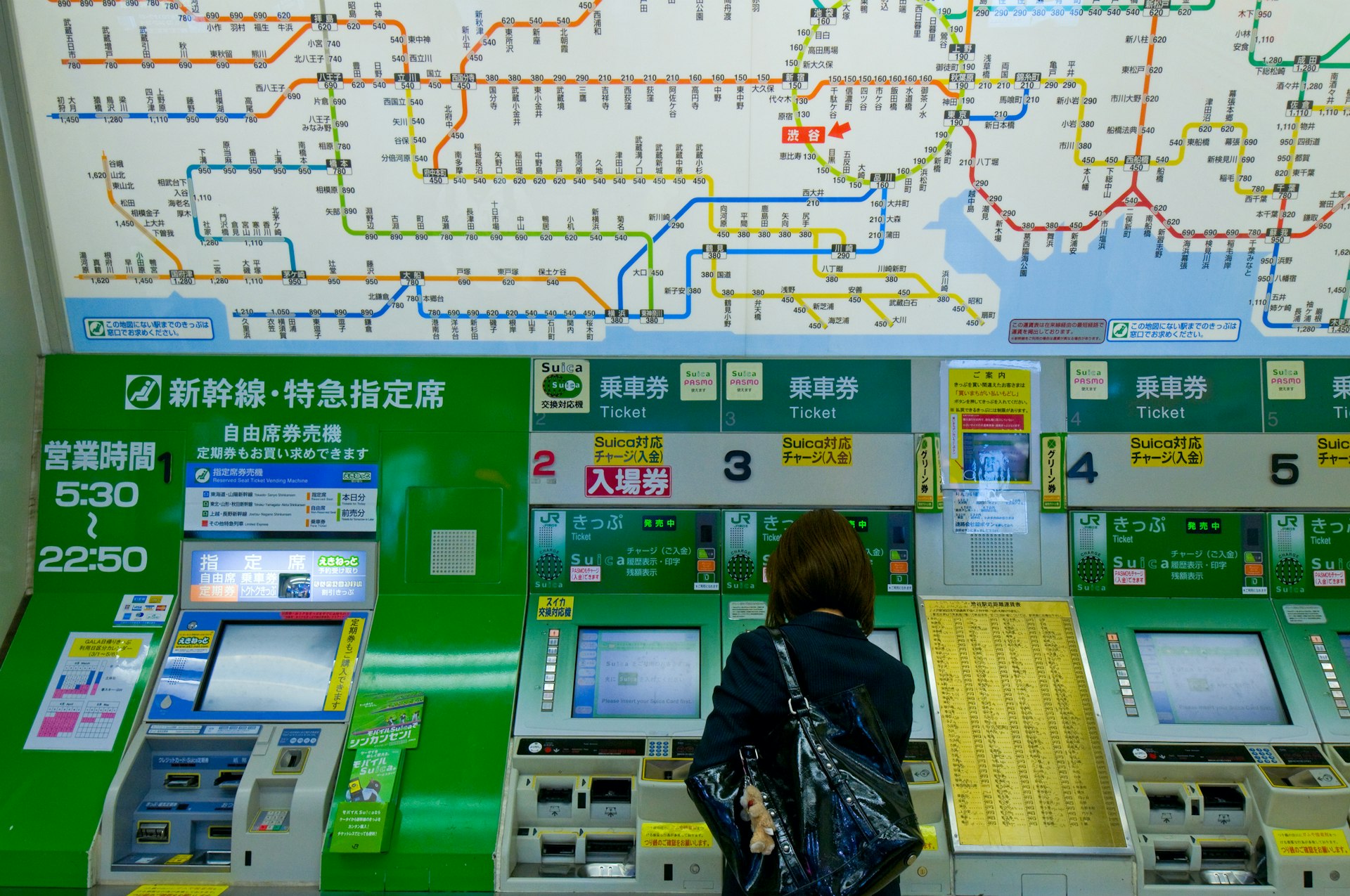
There are different services on the Japanese train network
Trains run almost everywhere in Japan. The main backbone of the network, and the fastest, is the shinkansen. These bullet trains run from Hokkaidō in the far north all the way to Tokyo Station , where you have to change for the shinkansen going to Nagoya , Kyoto , Osaka , Hiroshima and on to Kyushu. For travelers visiting Japan’s main sights , this will be the kind of train you take the most.
The next fastest are Limited Expess trains — “limited” as in “limited stops” — that run between cities and to rural areas on pre-shinkansen conventional lines (the non-high-speed ones). Many run through beautiful parts of Japan, so don’t count them out.
Local trains are the slowest and may even be as small as one single car. “Rapid” trains are fairly rare, and are essentially local trains that skip a few of the smaller stops.
Urban rail, commuter trains and subway lines are widespread in cities. These usually work very similarly to what you might be used to in your home country, although do watch out for limited-stop semi-expresses. The big picture transit maps can look a little intimidating, but most major cities now have a system of colors and station codes in place to help you navigate, and your phone's maps app is great for a quick idea of how to get from A to B.
Confident visitors outside major cities will love Joyful Trains, which are special tourist trains operated largely on weekends and holidays in rural areas. These might be renovated steam trains, or specially themed — JR East’s Koshino Shu’Kura is all about sake, including tastings, while the JR Kyushu A Train is jazz-themed.
Japan’s train stations are destinations by themselves, with larger and newer stations offering a huge range of restaurants for every appetite and budget, and shops ranging from high-quality handmade artisanal local goods to Japanese malls to 100-yen stores. Convenience stores and pharmacies are also often on hand.
Do look out for special local snacks in the omiyage souvenir shops (these are intended for Japanese travelers to take back to friends and colleagues as presents) and for ekiben, local specialty boxed bentō lunches.
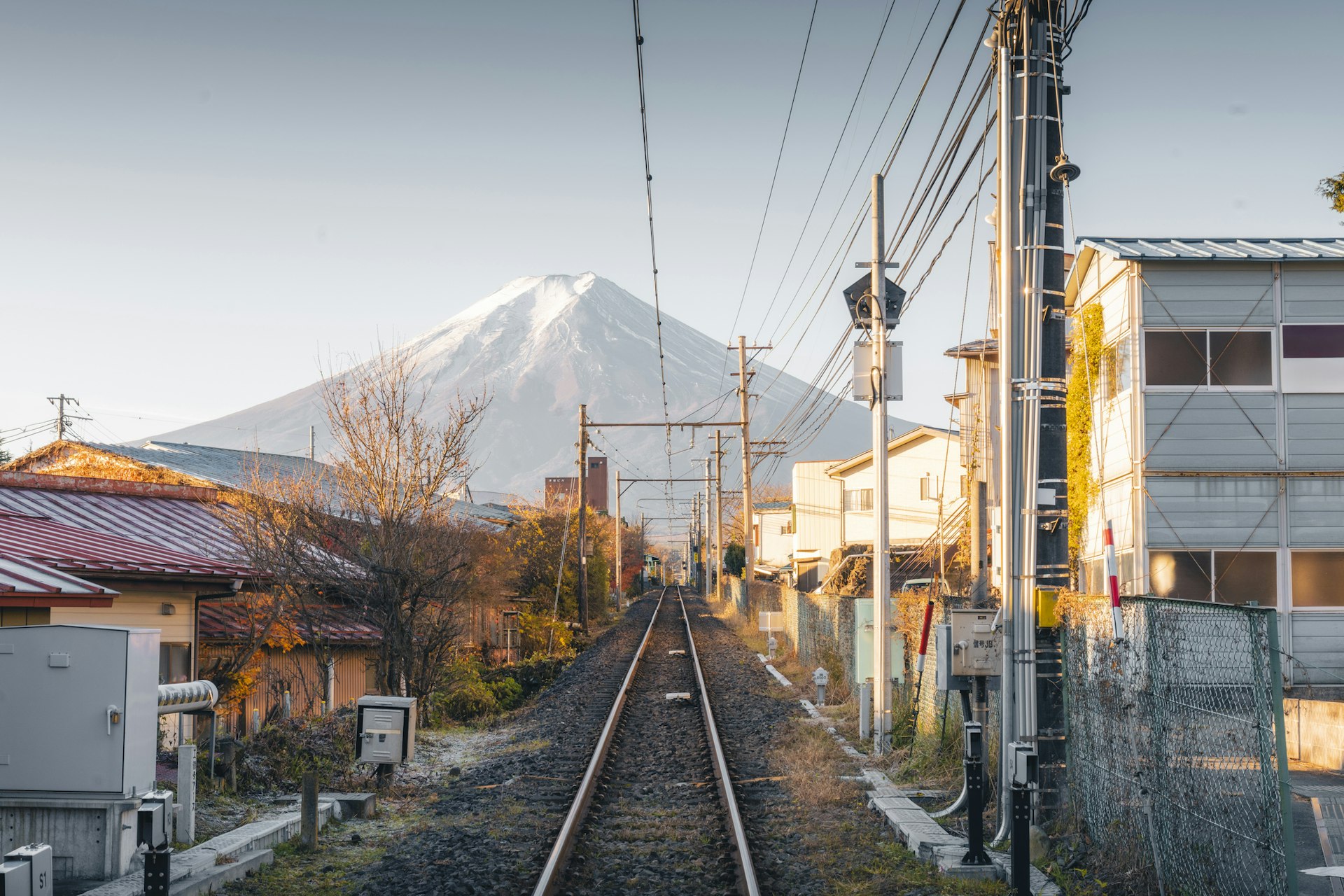
Travel short distances with a prepaid travel card
Coming from overseas, traveling short distances on Japanese railways often feels very inexpensive, while traveling longer distances without a rail pass can feel more costly. Let’s start with shorter distances.
Taking subways and urban rail is simple if you get an IC card – one of the many prepaid stored-value contactless cards – that works in a similar way to Oyster in London or Clipper in San Francisco: just tap on and tap off. Most rail operators across Japan will sell you their version, which are almost all interchangeable when it comes to loading and spending them — you can use an ICOCA card from the Osaka region in Tokyo , or a Pasmo from Tokyo in Sapporo . You can also use iPhones to get a virtual Suica card (JR East's version of a prepaid card) via the Wallet app and load it with money using Apple Pay. If you're using an international Visa card, be aware that JR East has had issues processing those payments in the past, so you may need to use a different credit card.
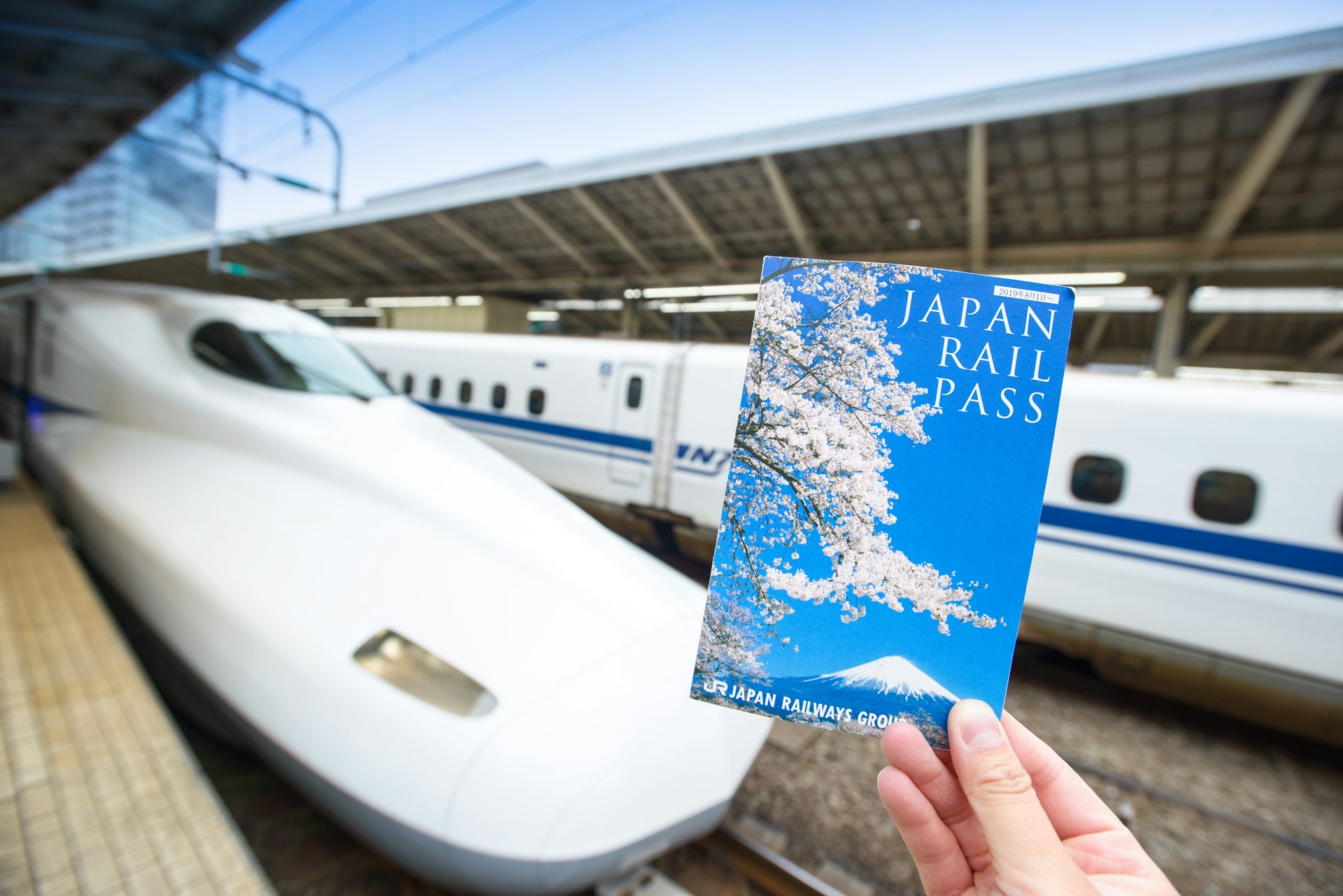
Travel long distances with the JR Pass
Over longer distances, the Japan Rail Pass (¥50,000 or about US$335 for seven days – less than US$50 a day!) is generally a good deal if you are planning anything more than simply Tokyo–Kyoto–Hiroshima–Tokyo, and the flexibility it gives you to take an earlier or later train is an added bonus.
You can either buy the ticket online or from an overseas travel agent. Note that you don’t actually buy the pass itself from overseas — you buy a voucher called an Exchange Order, which you then exchange at a major station (including all international airports) for the pass itself.
If you don’t have a pass, tickets cost the same no matter what time of day you travel, where you book, or how busy it will be — it’s not like airline tickets where that can change wildly. Most overseas travelers still use paper tickets for everything outside urban travel.
Long-distance travel fares are based on two elements:
- Ticket price, essentially the distance you travel
- Whether you want to reserve a seat or not, and in which class, if that’s available: Limited Express and Shinkansen trains will offer non-reserved seat tickets, a reserved seat in standard class, a reserved seat in the Green Car business class, or in some regions a reserved seat in Gran Class (first class).
Tickets can be bought at stations or at JR Travel Service Centers
Use Google Maps or the Japan Transit Planner from Jorudan to find fares, or for JR trains visit your local JR station (look for the “green window” ticket booking office or a JR Travel Service Center), where you can also reserve a seat. At major airports and in Tokyo, you can expect some basic train-related English to be spoken by "green window" ticket agents. JR Travel Service Center staff tend to be more multilingual. Elsewhere, if you speak no Japanese you may well get lucky with someone who speaks English, and you can always lean on your phone's translation apps. Write down (on a printout or even just on your phone's notes app) the dates, times, destinations and details of the train you want, for example: "12 April, Tokyo–Osaka, 12:00, window seat, Mt Fuji side please."
Unless you’re visiting during a major Japanese holiday or want to take a specific Joyful Train, there’s little need to book before arriving in Japan. You can in some cases book online, but it’s pretty complicated and I wouldn’t recommend it to first-time visitors. If you’re confused and want English-speaking advice, head to one of the stations that specializes in Japan Rail Passes . Only a few trains outside the JR network allow prebooking.

There are many rail passes to choose from
Japan has a wide variety of rail passes available to overseas visitors, from the JR Pass valid across the JR network (with a few exceptions like the very fastest trains west of Tokyo) to regional and commuter passes.
The most useful is the Japan Rail Pass in its six variants: 7/14/21 days and standard car or Green Car business-class versions. This is probably what you should get your first time in Japan if traveling outside Tokyo.
Adventurous travelers and long-term visitors, or anyone wanting to go deep in a particular region, could also consider:
- The various regional passes from JR East , including the very useful Hokuriku Arch Pass for traveling the slower way between Tokyo and Osaka via Kyoto and Kanazawa
- The many JR West Passes , including the All Area Pass for most of western Honshu
- The four JR Kyushu passes
- The three JR Hokkaido passes
- The JR Shikoku ALL SHIKOKU pass
You’ll usually need to be visiting with the “temporary visitor” stamp in your passport, and there may be a small discount (a couple of thousand yen or US$5–10) for buying it online or outside Japan. Otherwise, check out the details online or visit a large station, including those at airports: the bigger, the better, and the more likely to have English-speaking assistance.
Train etiquette means not disturbing fellow travelers
Japanese urban trains can be famously crowded during rush-hour, but by and large even Tokyo is no worse than any major global city.
Even if crowded, the etiquette on a Japanese train is to be as quiet as possible and disturb others as little as possible: headphones on quiet, very little chatting, backpack on your front, give up your seat to anyone who needs it more than you.
There is something of a stereotype of loutish tourists yapping away to their traveling companions on long-distance trains. Try not to contribute to it. Separate your trash according to the recycling bins, and always leave the seat as clean and tidy as you found it.
Eating and drinking is fine (even encouraged!) on longer distance trains. General rule: if the seats are subway-style along the sides of the car facing inwards then don’t, but feel free if the seats are airline-style facing forwards. If in doubt, follow the lead of the nearest senior Japanese person.
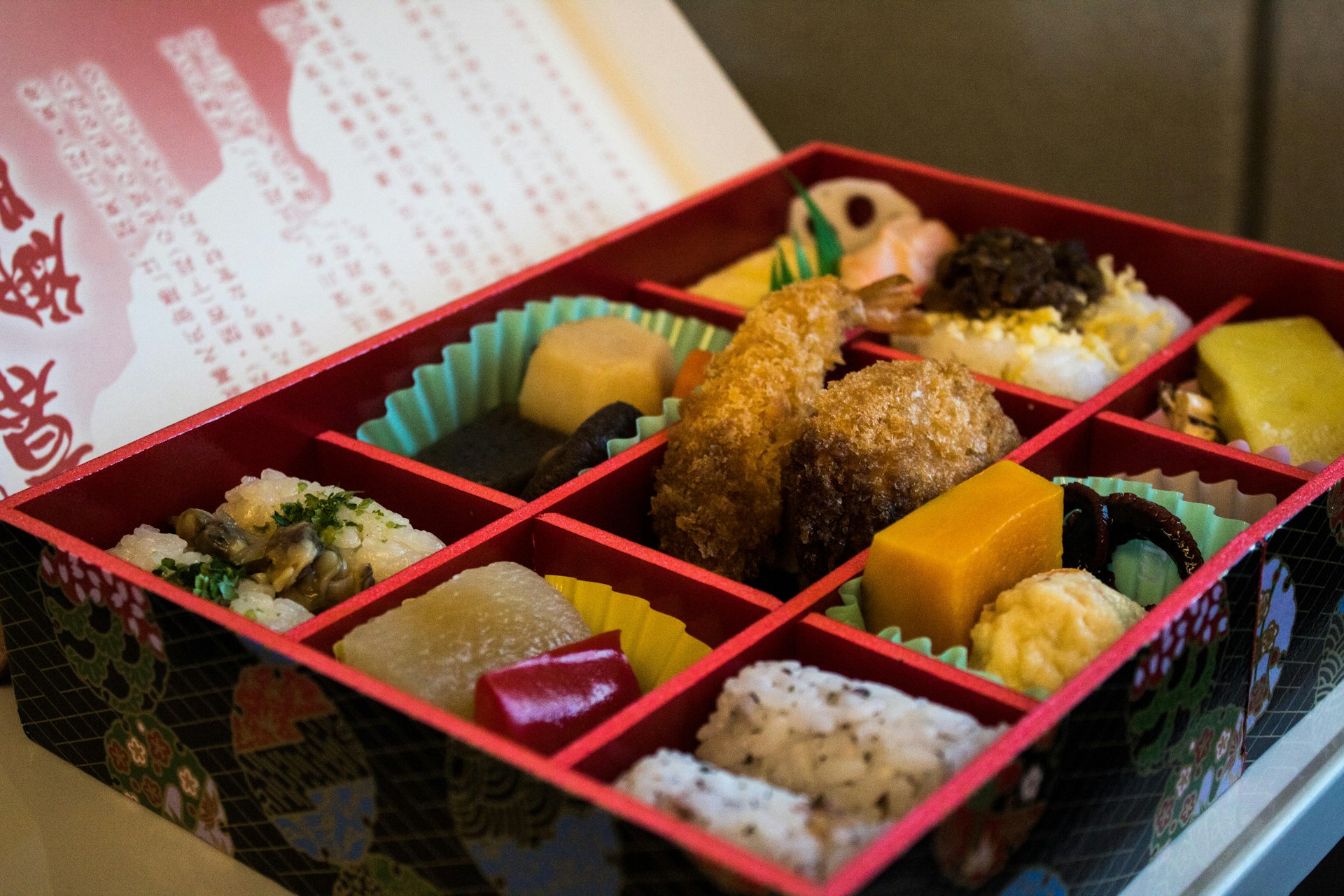
On-board facilities vary depending on the service
With the exception of the Joyful Train tourist excursion services, Japanese trains don’t have buffet cars any more, although you can see what they used to look like at several of Japan’s excellent railway museums. A shrinking number of trains still have a trolley service offering snacks, sometimes bentō and a variety of drinks.
Good news, though: any station smaller than the tiniest rural halt will have a convenience store inside or nearby, which will offer bentō , hot meals, snacks, drinks and essentials. Many larger stations have restaurant complexes, while some smaller ones will have delightful smaller options like a soba or ramen shop.
Long-distance trains will usually have toilet facilities, with newer ones (including all shinkansen and some Limited Expresses) having excellent facilities for disabled passengers, people with reduced mobility and often ostomy facilities too.
Shinkansen and newer Limited Expresses offer two-pin US-style 110V charging ports, while wi-fi is also increasingly available and easy to use.
Most Japanese trains are not set up for luggage bigger than a small carry-on — and “small” here does not include a US-sized rollaboard or anything like a bicycle. On some trains you have to pre-reserve anything bigger. Take advantage of the nationwide luggage shipping services like Yamato – known as Kuroneko Yamato for its black (kuro) cat (neko) logo – that ships larger bags for US$10–20.
These are the best seats for great views
Always take a window seat, whether you’re gazing out on Japan’s sprawling megalopolises from an urban train, watching the country fly by at 320km/h (199mph) from a shinkansen, or enjoying picturesque views from a slow rural train.
On the shinkansen, if you want the best mountain views — including the iconic Mt Fuji between Tokyo and Shizuoka — select a window E seat in standard class and a D seat in the Green Car.
Limited Expresses are wonderful for countryside views, with the Hida from Nagoya to Toyama through the Japanese Alps and the Inaho from Niigata to Akita just two great examples.
Ask for help when navigating busy city networks
Urban trains, commuter rail and subways may have a set of complicated and confusing names with different stopping patterns, especially during rush hour, but this is no worse than figuring out what a “Watford Semi-Fast” is on London’s Tube or how skip-stop works on the subway in New York. As a visitor, just ask station staff or, in a pinch, a fellow passenger — and be prepared to get on the wrong train with a confident smile and a sense of affable adventure.
The majority of trains are wheelchair accessible
A significant majority of intercity, urban rail and subway stations in most major cities (80–90% in Tokyo according to official numbers ) are accessible for wheelchair users, with elevators, stair-climber lifts, and ramps widespread.
Older stations, such as the main Tokyo Station, may be complex and accessible only from certain entrances. Tactile strips to assist blind people or those with reduced visual acuity are almost everywhere.
Accessible Japan is an excellent resource for information, while the very detailed For Safe and Convenient Accessibility website offers route and station search as well as contact details for further assistance. Station staff are keen to help wherever they can.
Many trains offer wheelchair positions, level boarding, with ramps available if you need them. Urban rail and subways have priority seating, and Japan developed the Help Mark badge system for people with invisible disabilities to easily signal their needs. The badge is free from a number of locations in Tokyo , under US$10 from Amazon Japan (consider having it delivered to your first night hotel), or you can DIY your own before leaving home.
Explore related stories
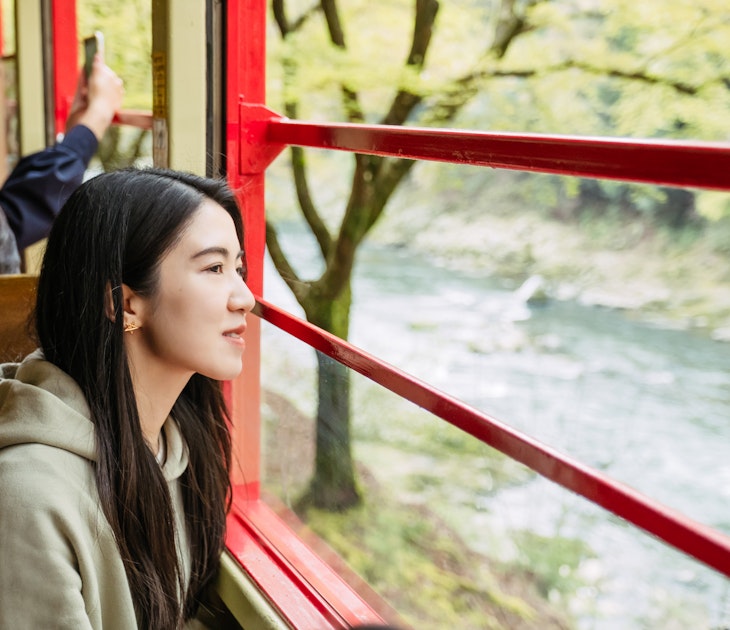
Destination Practicalities
Mar 25, 2024 • 9 min read
With its myriad islands, towering mountains and megacities, Japan can be a daunting destination to get around. We've got everything you need to know.
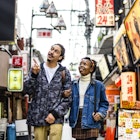
Mar 23, 2024 • 11 min read
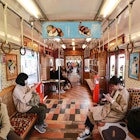
Feb 9, 2024 • 9 min read

Jan 2, 2024 • 11 min read

Dec 17, 2023 • 6 min read
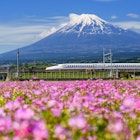
Oct 2, 2023 • 3 min read

Mar 4, 2023 • 8 min read

Mar 16, 2021 • 6 min read
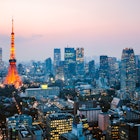
Feb 17, 2021 • 8 min read

Jul 7, 2020 • 2 min read
- Japan Tourism
- Japan Hotels
- Japan Bed and Breakfast
- Japan Vacation Rentals
- Flights to Japan
- Japan Restaurants
- Things to Do in Japan
- Japan Travel Forum
- Japan Photos
- All Japan Hotels
- Japan Hotel Deals
- Last Minute Hotels in Japan
- Things to Do
- Restaurants
- Vacation Rentals
- Travel Stories
- Rental Cars
- Add a Place
- Travel Forum
- Travelers' Choice
- Help Center
Culture Day 2024 - Japan Forum
- Asia
- Japan
Culture Day 2024
- United States Forums
- Europe Forums
- Canada Forums
- Asia Forums
- Central America Forums
- Africa Forums
- Caribbean Forums
- Mexico Forums
- South Pacific Forums
- South America Forums
- Middle East Forums
- Honeymoons and Romance
- Business Travel
- Train Travel
- Traveling With Disabilities
- Tripadvisor Support
- Solo Travel
- Bargain Travel
- Timeshares / Vacation Rentals
- Asia forums
- Japan forum

Am at the end stages of finalising itinerary and wanted some advice on day trips on the Culture Day weekend (2nd - 4th November).
I am planning to do day trips to Nikko and Hakone but have seen that the weekend and the Monday are public holidays.
Question is whether day trips to either Hakone or Nikko would be worthwhile on the Sat, Sun or Monday or whether the crowds would mean it would be difficult to get to the main attractions.
I did see that there are festivities in Hakone on the Monday and would be interested to see those, but if the crowds meant it would be too difficult to move around would happily move to another day. Likewise assume that Nikko will be busy regardless, although noting that that there is a limited express from Shinjuku to Nikko that is attractive (as staying at Century Southern Tower ) but that this only departs on weekends.
I guess ultimately the question is whether I should schedule the day trips for earlier in the week that I am in Tokyo and leave Tokyo for the weekend (on the basis that Hakone and Nikko may be too crowded on the holiday weekend)
TIA for any advice
- Alpine route - which direction is best? 5:12 pm
- Tokyo Prince Hotel 5:10 pm
- Best Grocery/Supermarket Stores 4:59 pm
- Disney Sea 3:29 pm
- Colorado from Vietnam - transit Tokyo Should I stop? 3:19 pm
- 9 days in tokyo, 1 night in kyoto 2:50 pm
- Tokyo crowds revel as cherry blossoms reach full bloom 2:50 pm
- Visit Japan Web 2:04 pm
- August Trip 24 1:59 pm
- takayama kamikochi 1:59 pm
- Why do airlines do this? 1:42 pm
- Day trips from Kyoto 1:29 pm
- Jr-West train reservation with a virtual card 1:06 pm
- 3 weeks in Japan in May 2024 1:03 pm
- 'semi double' rooms 5 replies
- Pocket WiFi Rental Experience? 315 replies
- kyoto-takayama JR or Lmtd express??? 6 replies
- Best Japan travel guide book? 29 replies
- Best/cheapest time of year to visit?? 3 replies
- Radiation danger in Tokyo? 37 replies
- Best Skiing in Japan? And When? 3 replies
- Japan in 10 days 3 replies
- How far is Nara from Kyoto 8 replies
- how to get to Hokkaido from Tokyo? confused..pls HELP. 5 replies
- 2024 public holiday chart in East Asian countries
- Where can I find more onsen in Japan?
- Driving Information
- Catholic mass in English and other languages
- How can we access tourist attraction from cruise port?
- Pocket WiFi Rental Experience?
- Halal Information
- Tokyo trip report here

해당 웹사이트는 사용자의 쾌적한 사이트 이용을 위해 쿠키를 사용합니다. 해당 사이트를 계속 탐색하시려면, 쿠키 사용을 수락하세요. 보기 쿠키 정책 자세한 내용.
- Meetings&Events
- 언어 선택 简体中文 繁體中文(香港) 繁體中文(臺灣) India (English) Bahasa Indonesia 한국어 ภาษาไทย Tiếng Việt Singapore (English) Philippines (English) Malaysia (English) Australia/New Zealand (English) Français Deutsch Italiano Español United Kingdom (English) Nordic countries(English) Canada (English) Canada (Français) United States (English) Mexico (español) Português العربية Japan(日本語) Global (English)
- India (English)
- Bahasa Indonesia
- Singapore (English)
- Philippines (English)
- Malaysia (English)
- Australia/New Zealand (English)
- United Kingdom (English)
- Nordic countries(English)
- Canada (English)
- Canada (Français)
- United States (English)
- Mexico (español)
- Global (English)
- 아사히카와 & 홋카이도 북부
- 하코다테 & 홋카이도 남부
- 구시로 & 홋카이도 동부
- 아오모리시와 그 주변
- 쓰루오카 & 사카타
- 사이타마 뉴 어번 센터
- 마에바시 & 아카기산
- 벳푸 & 유후인
- 니세코 스키장과 그 주변
- 고카 & 시가라키
- 도톤보리 & 신사이바시
- 긴자 & 니혼바시
- 기요사토 & 호쿠토
- 롯폰기 & 아카사카

- 아이즈와카마쓰 & 오제
- 하치만타이와 그 주변
- 시라카미 & 오다테
- 모험을 찾아 대자연 속으로
- 일본의 숨겨진 관광 자원
- 아름다운 풍경의 명소

- 전통공예 체험과 워크숍

- 일본 동부의 지역 음식
- 일본 서부의 현지 음식
- 일본의 유명한 길거리 음식과 알뜰 맛집들
- 일본의 지역별 에키벤 문화 체험하기
- 야키토리 - 닭꼬치 가이드
- 채식주의자를 위한 일본 가이드
- 일본의 스시 체험 가이드
- 사케 개론 - 일본의 사케에 대한 완벽한 가이드

- 일본의 건축 세계 탐험
- 일본 애니메이션과 만화

- 사무라이 & 닌자

- 일본에서의 웰빙 여행
- 일본에서의 별보기 가이드
- 일본 각지의 정원과 선(禪) 정원
- 일본의 삼림욕(신린요쿠)

- 새로운 일본을 심(心)다

- 코로나 19: 일본 여행을 위한 실용 정보
- 홋카이도의 광활한 대자연
- 토호쿠의 아름다운 세계유산
- 시코쿠의 자연과 전통

- 일본에서 기차와 버스로 여행하기
- 일본에서 경험하는 지속가능 관광
- 호텔 & 료칸 검색
- 장애인 여행객 편의 안내
- 공인 통역안내사 예약하기
- 자원봉사 가이드 목록
- JNTO 관광 안내소

- 일본식 예절과 에티켓 배우고 익히기
- 일본의 봄: 벚꽃 예보

- 여행자 보험으로 혹시 모를 위험한 상황에 대비해보세요
- Japan Safe Travel Information
- Safety Tips

My Favorites
${v.desc | trunc(25)}
Planning a Trip to Japan?
Share your travel photos with us by hashtagging your images with #visitjapanjp
일본 디지털노마드 6개월 비자 신설
Please Choose Your Language
Browse the JNTO site in one of multiple languages

IMAGES
VIDEO
COMMENTS
Two times of year I would avoid for a vacation to Japan are: Golden Week in early May - In 2024, Golden Week is from 27 April - 6 May. This is a series of national holidays so many Japanese travel domestically, trains and hotels book up, and popular spots will be extra crowded. New Year - Late December to early January.
Learn how to plan a trip to Japan on your own with this comprehensive guide. Find out the best time to visit, transport, accommodation, places to visit, cultural tips, budget and more.
Learn how to plan a trip to Japan, a country with a different culture, language, and megacities. Find out the best time to visit, where to stay, what to do, and more tips for first-timers.
This 2 weeks in Japan itinerary will cover: How to explore Japan on your own with confidence; Quick links to useful resources; Complete 2 Weeks in Japan itinerary, day-by day guide including costs, things to do, where to stay, where to eat & getting around for:. DAYS 1-5: Tokyo (including day trip to Mt Fuji) DAYS 6-10: Kyoto DAYS 10-12: Hiroshima (including day trip to Miyajima)
Find out the basics of traveling to Japan, such as language, timezone, currency, visa, weather and more. Get insider tips and practical advice from Japan National Tourism Organization (JNTO) to plan your trip with confidence.
This information-packed Japan trip planner has the answers to all your questions. Find out the best places to visit, which Japanese foods to try, and how to ride the bullet trains. All the research is done for you to assist in planning a trip to Japan. If you have been dreaming of traveling to Japan and want to get serious about planning your ...
To reserve a professional tour guide for your dream trip in Japan, you're suggested booking a Japan tour at least 6 months ahead of your departure date. Some Japan tour packages come with public transport (mainly subway) to save some cost. This is an option for travelers willing to walk 20,000+ steps per day.
The official site of Japan National Tourism Organization is your ultimate Japan guide with tourist information for Tokyo, Kyoto, Osaka, Hiroshima, Hokkaido and other top Japan holiday destinations. We offer travel information to make your Japan travel more comfortable and enjoyable.
Japan Itinerary: One Week. Day 1 & 2: Tokyo. Chances are you'll be starting your trip in Tokyo, since it's home to the country's biggest international airport. If your trip is seven days long, activate your JR Pass right away, so that you can take advantage of the free JR trains that run through the city.
From culturally rich history, to cutting-edge technology, to foodie-worthy cuisine; Japan truly has something for everyone. It should come as no surprise then that it is currently rated as one of the most visited countries in the world. Until the pandemic, the number of tourists coming to Japan has grown steadily year after year, with 29 million visitors in 2017.
Days 1-3: Tokyo. Day 4: day trip from Tokyo. Days 5-6: Kyoto. Day 7: Nara and Osaka. Day 8: Miyajima and Hiroshima. Day 9: morning in Kyoto → Tokyo. Day 10: Tokyo in morning/afternoon → airport. Japan is a decently large-sized island country located in Eastern Asia, being slightly smaller than California .
The Japan Rail Pass is a must-have for all visitors planning to travel around Japan. The JR Pass is multi-use, discounted ticket that allows unlimited access to trains operated by Japan Rail National, as well as JR bus services, ferry services, and airport transfers.
How To Plan A Trip To Japan In 4 Easy Steps. The Japan Rail Pass is fantastic value for anyone looking to explore Japan by rail. I highly recommend JRPass if you are looking to buy national or regional Japan Rail Passes. Order before 1st October to beat 70% price increase.
Here are the 5 best things to do in Japan for your next trip 🇯🇵🩷. 1 - Sensoji Temple. To really tap into the culture of Tokyo, visit Senso-Ji Temple, Tokyo's oldest temple, dating back to the 7th century. 2 - Mount Fuji.
With the Japan itinerary planner by Triptile™. Embark on a journey to Japan, where the seamless integration of nature and ancient traditions creates an unparalleled experience for every traveler. From the moment you set foot in this captivating corner of Asia, you'll be entranced by its allure, finding it difficult to leave.
Step 1: Figuring Out Your Trip's 'Why'. Let's begin by considering why you're interested in visiting Japan. With its diverse range of attractions and experiences, planning a trip to Japan can feel a bit overwhelming at first. But understanding your motivations for visiting can make the process much smoother.
Don't plan a trip to Japan without watching this! EVERYTHING you need to plan a trip to Japan is RIGHT HERE! This page is your one-stop-shop Japan travel planning guide to plan out your trip itinerary, set your budget, find accommodations, understand the Japan train system, what to understand about the local culture AND which aps to download.
Some destinations reward spontaneity - in Europe, cheap flights and rail passes give you the freedom to wake up in the morning and choose your next destination on a whim. Japan, on the other hand, rewards forward planning. The country's abundance of both natural and manmade attractions, combined with its high standard of living and general efficiency, make it a fairly pricey destination.
The cost of a trip to Japan varies depending on factors such as duration, accommodation, activities, and food. A budget trip can cost around $50-70 per day, while a mid-range trip can cost around $100-150 per day. Luxury trips can cost upwards of $300 per day. Plan ahead and budget accordingly for a stress-free trip.
Planning A Trip To Japan. More Planning Resources. Planning Travel Hub. More Destination Ideas. Destinations Travel Hub. More Experience Ideas. Experiences Travel Hub. Suggested Further Reading. 5 Essential Things You Need BEFORE You Come To Japan. 38 Japan Travel Sites and Resources Every Traveller Should Know. Cheap Flights to Japan & Flying FAQs
There are also regional passes that cover part of Japan depending on the pass. JR trains also run throughout Tokyo central, and you will know it's a JR train because there will be a J before the train line. In October 2023, the price of an individual JR Pass rose from ¥ 29,650 to 50,000 (from $200 to $337 USD).
That's why I put together a "first-timers" Japan travel itinerary, built on my 20+ years of traveling to and from Japan. This sample trip is for people heading to Japan for 1 to 2 weeks (which seems like the standard visit time for most people). Of course, there are so many things to see in Japan besides those featured on this trip itinerary.
The best way to plan your trip to Japan is to book with Fora.We'll go over the best places to stay in Japan, like where to stay in Tokyo — the coolest hotels in Tokyo are among the best in the world, by the way— where to stay in Kyoto and more.. And you'll get access to exclusive hotel perks and upgrades . This can include property credits, room upgrades, or even complimentary meals ...
How to travel to Tokyo. Your 7 day Japan itinerary will likely start at Narita International Airport. From the airport, the quickest way to central Tokyo is the Narita Express train (N'EX ...
Tickets can be bought at stations or at JR Travel Service Centers. Use Google Maps or the Japan Transit Planner from Jorudan to find fares, or for JR trains visit your local JR station (look for the "green window" ticket booking office or a JR Travel Service Center), where you can also reserve a seat. At major airports and in Tokyo, you can ...
97 reviews. 27 helpful votes. Culture Day 2024. Apr 5, 2024, 1:45 AM. Save. Am at the end stages of finalising itinerary and wanted some advice on day trips on the Culture Day weekend (2nd - 4th November). I am in Tokyo from 30/10 to 5/11, departing on the 5/11 for one night in Lake Kawaguchiko. I am planning to do day trips to Nikko and Hakone ...
Planning a Trip to Japan? Share your travel photos with us by hashtagging your images with #visitjapanjp. 일본 디지털노마드 6개월 비자 신설. 2024년 4월 5일. JNTO - Japan National Tourism Organization.
During his April 8-14 trip to the U.S., Kishida will hold talks with Biden at the White House on Wednesday, followed by a trilateral summit with Philippine President Ferdinando Marcos Jr. the next ...